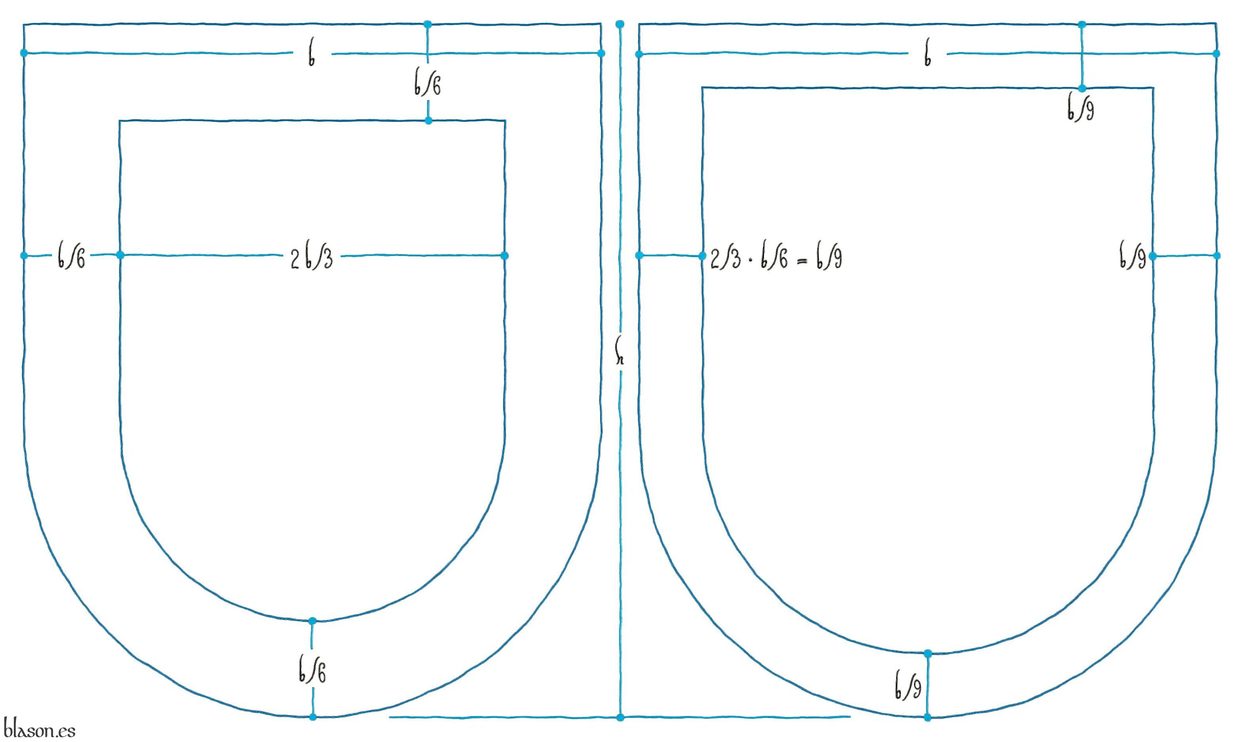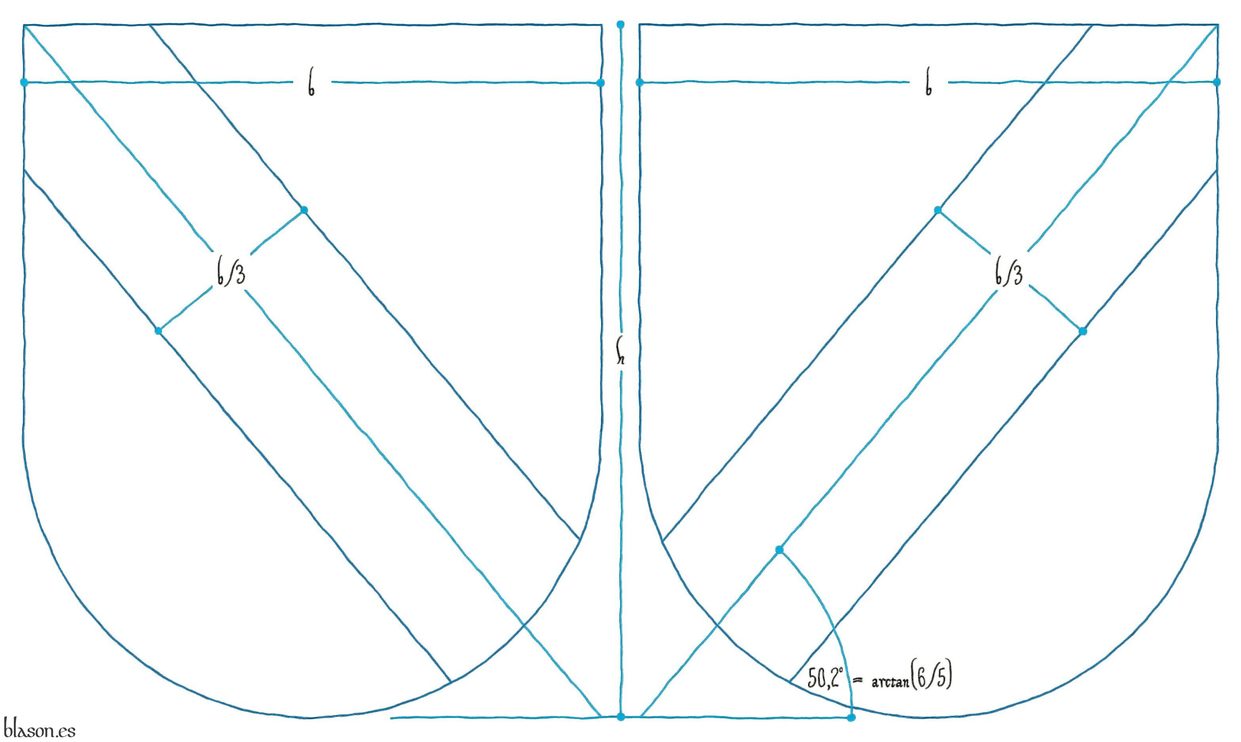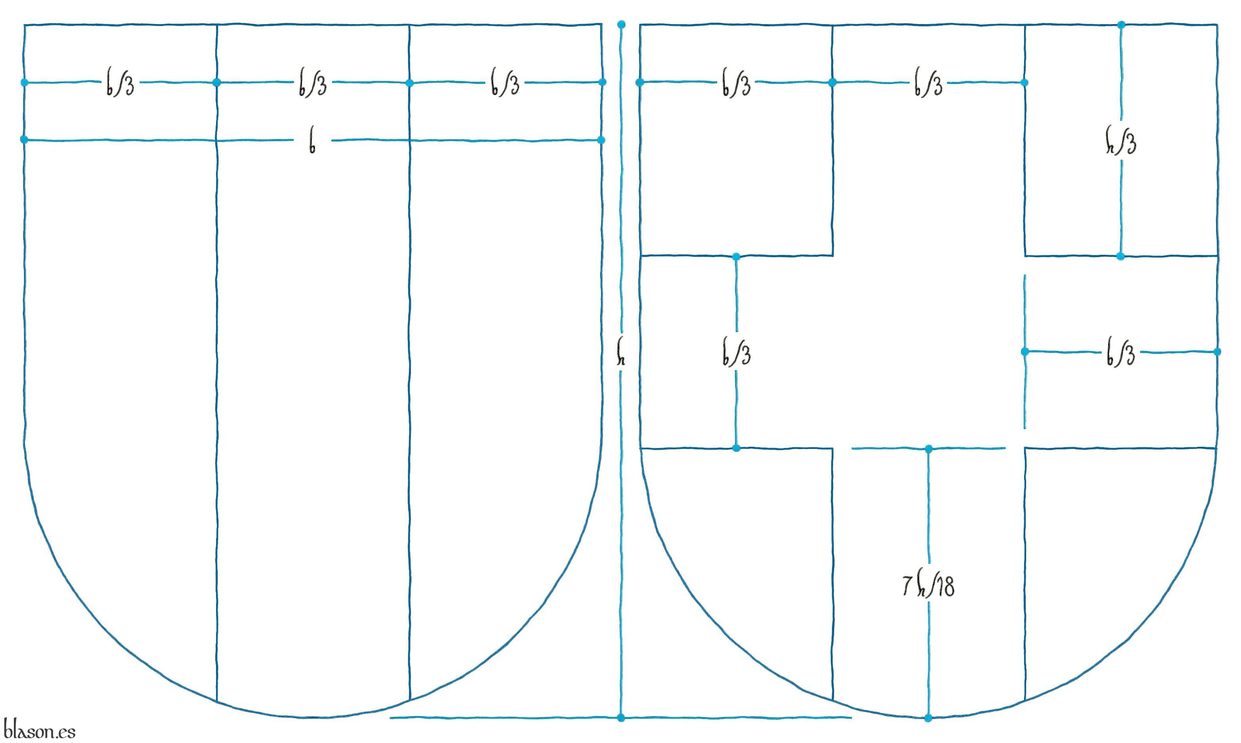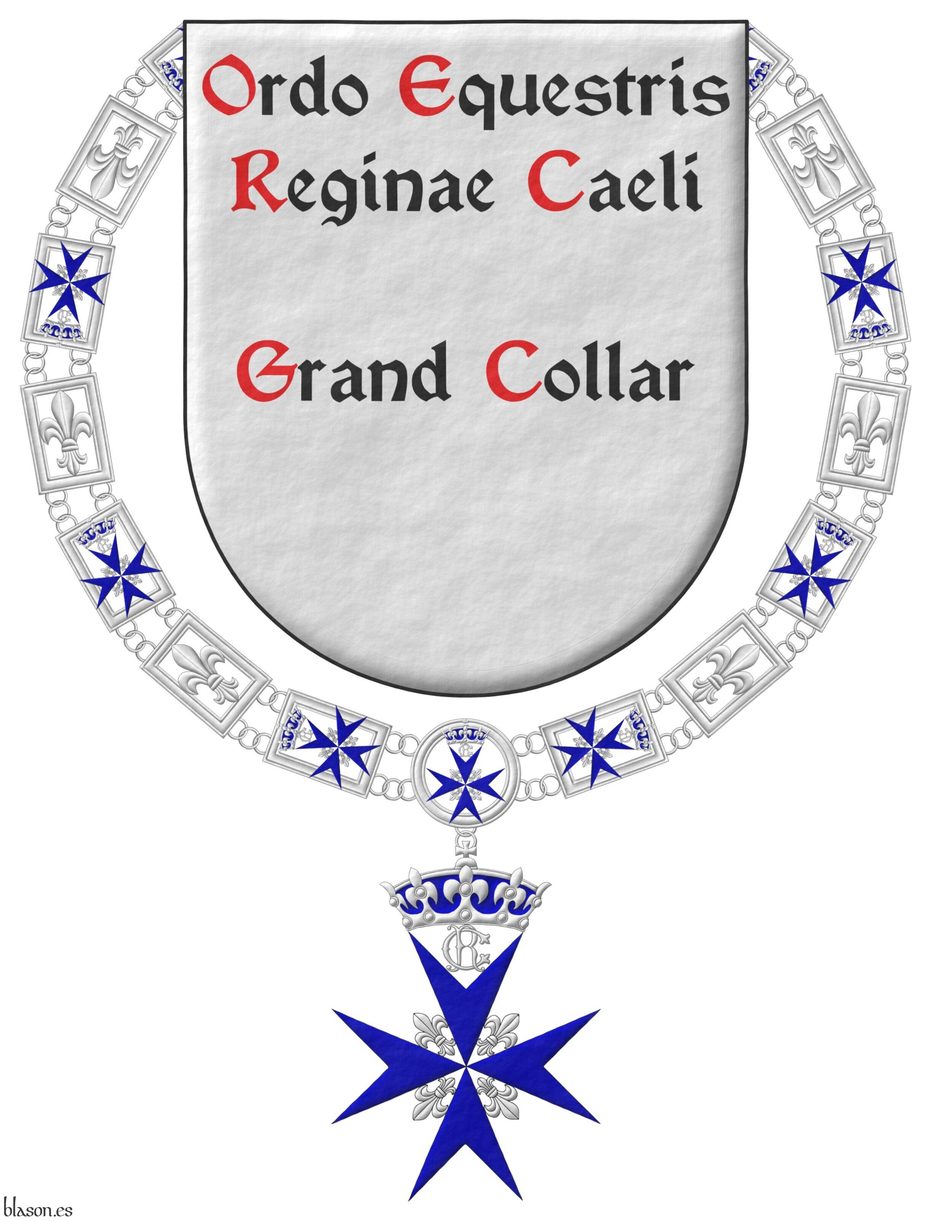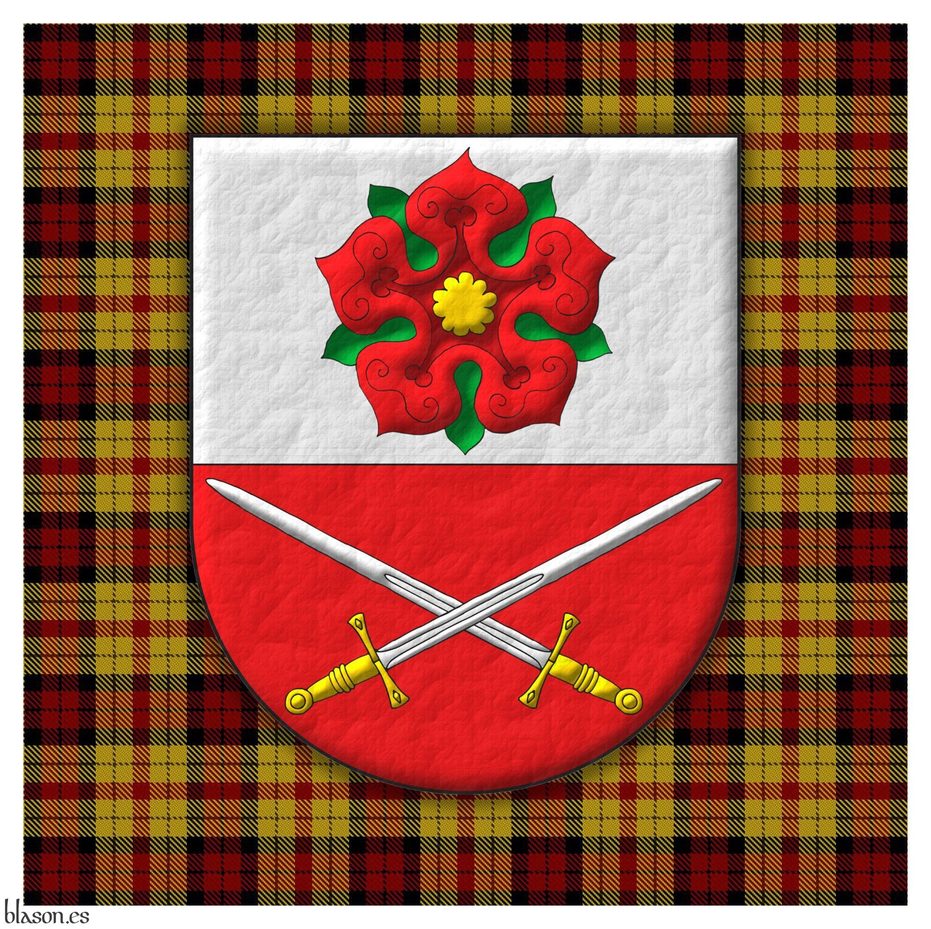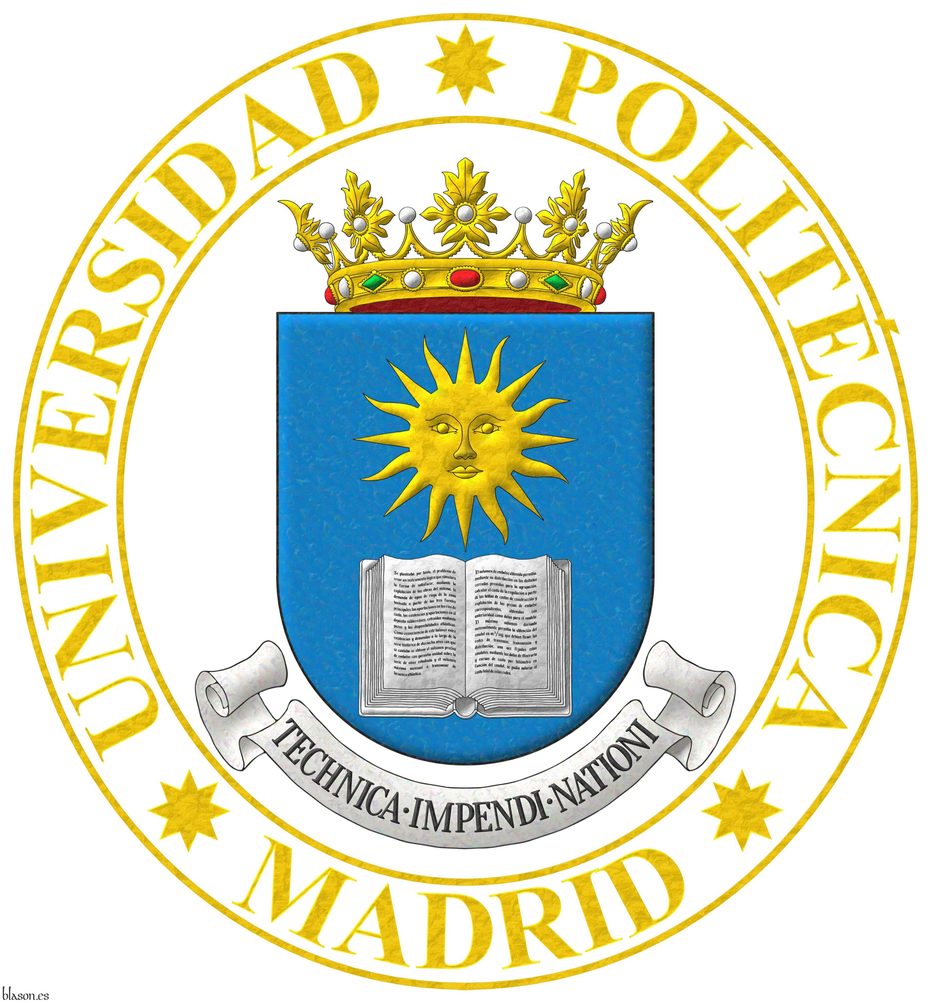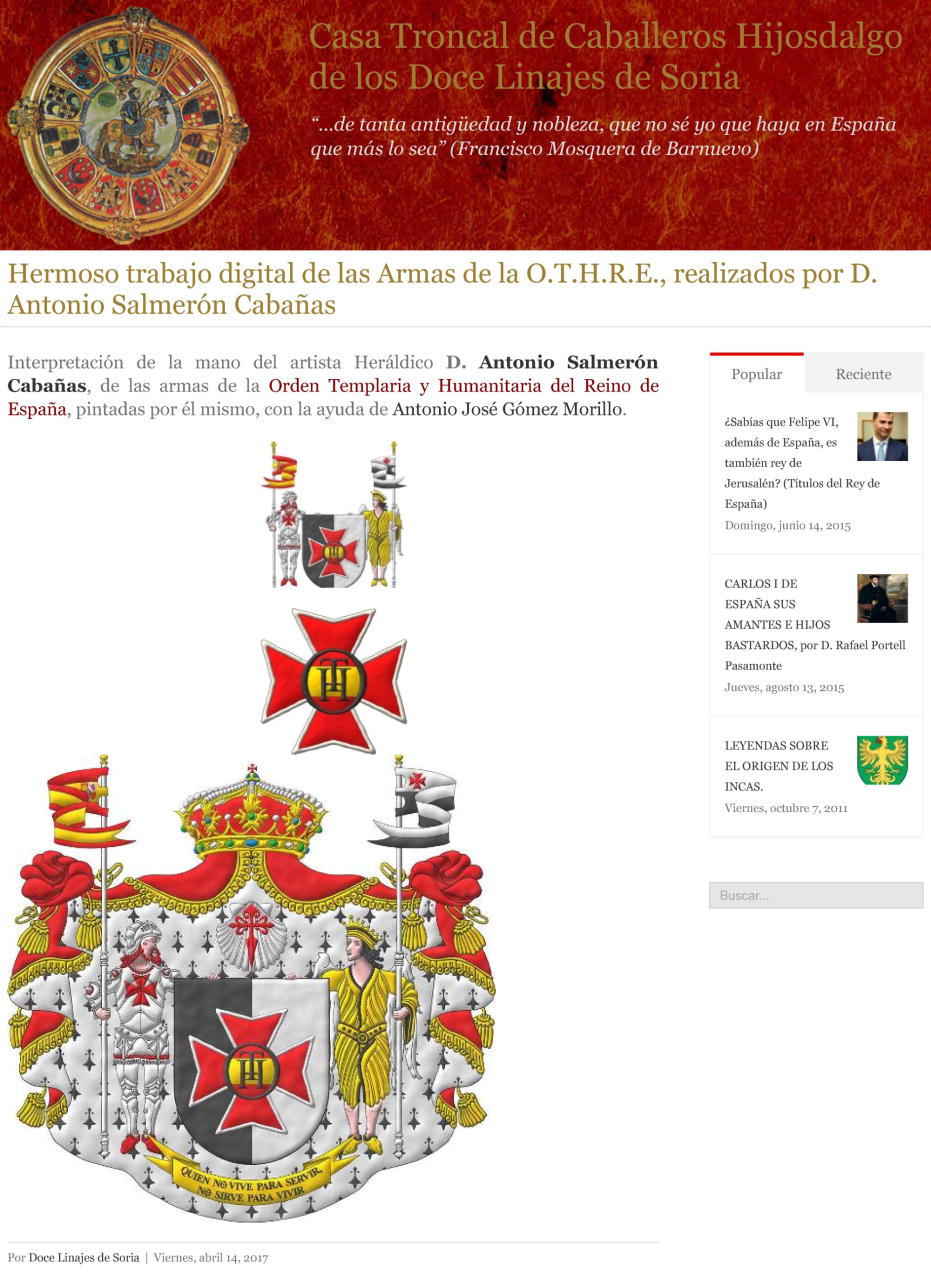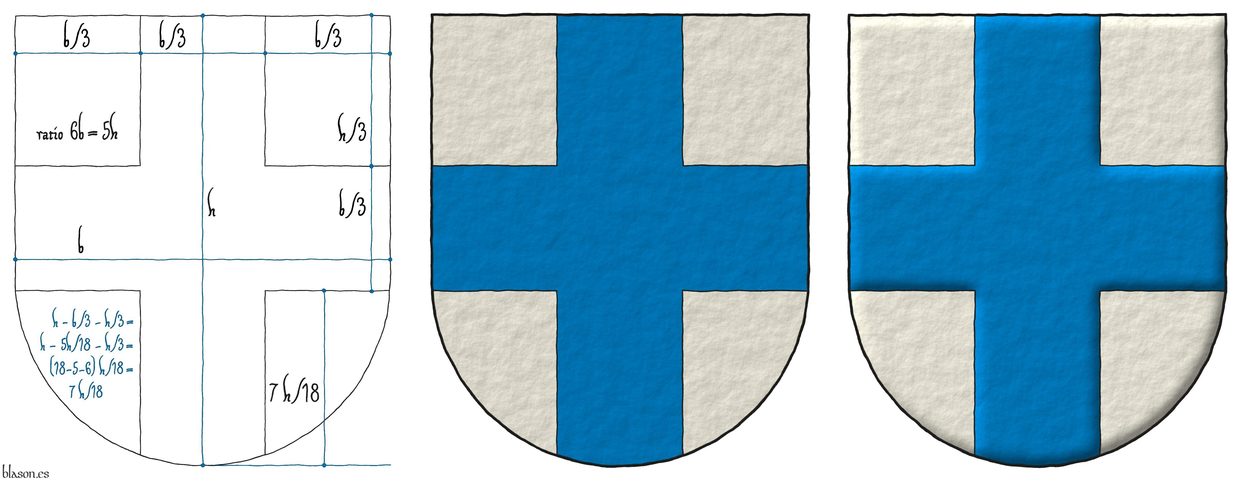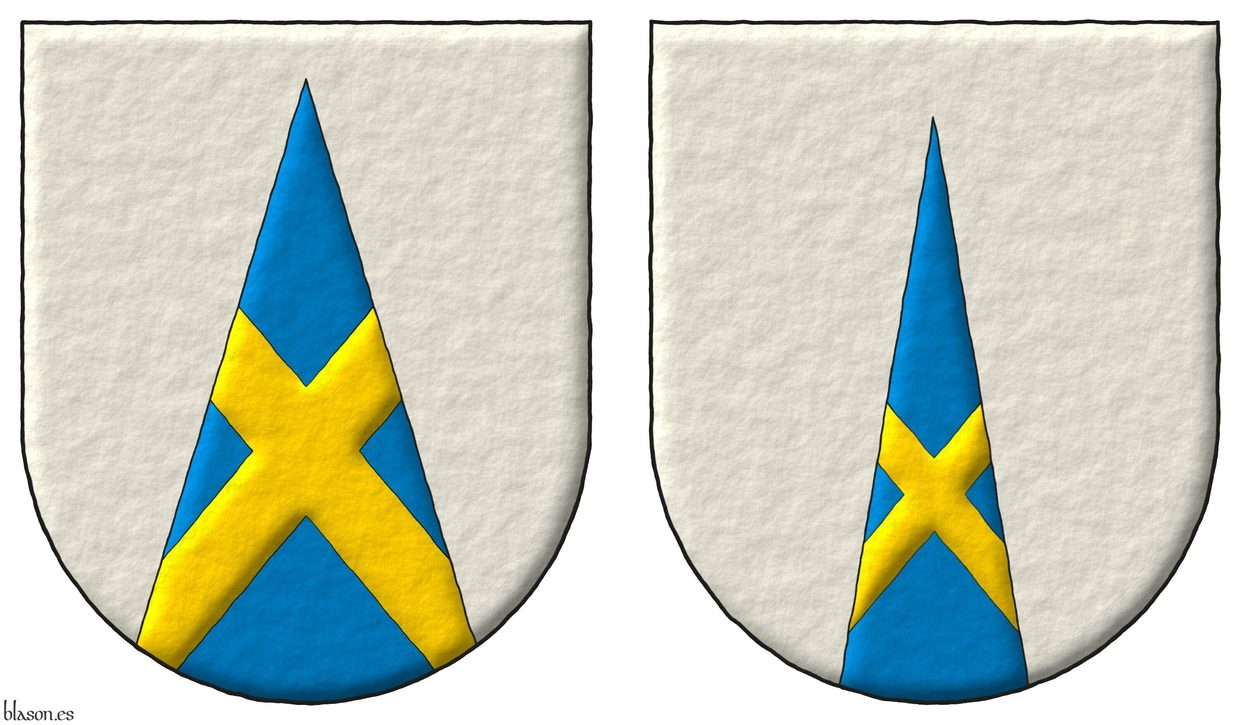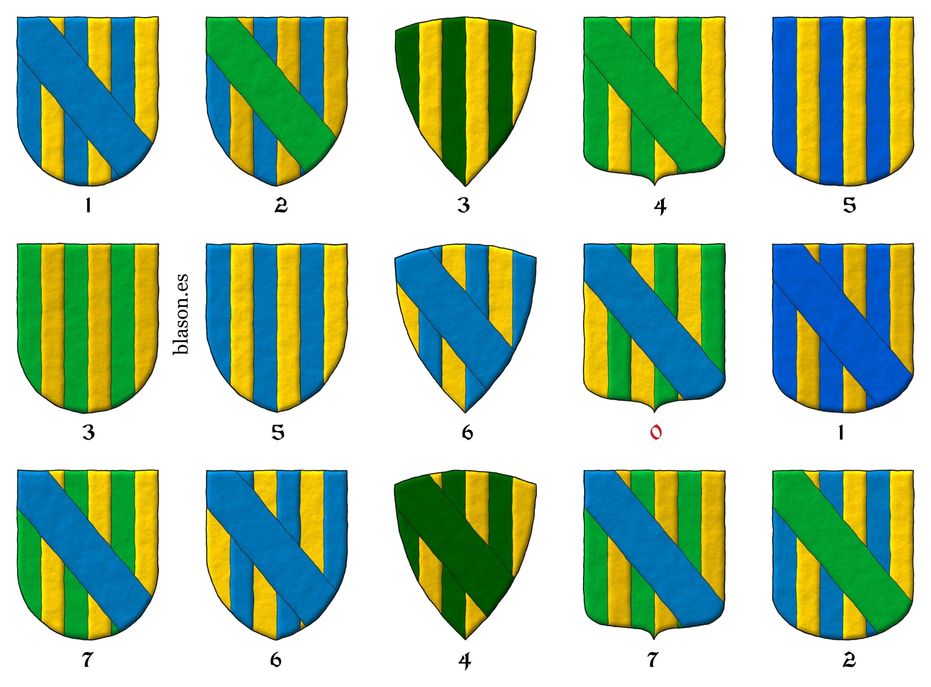Semi-circular shape


Adrian V
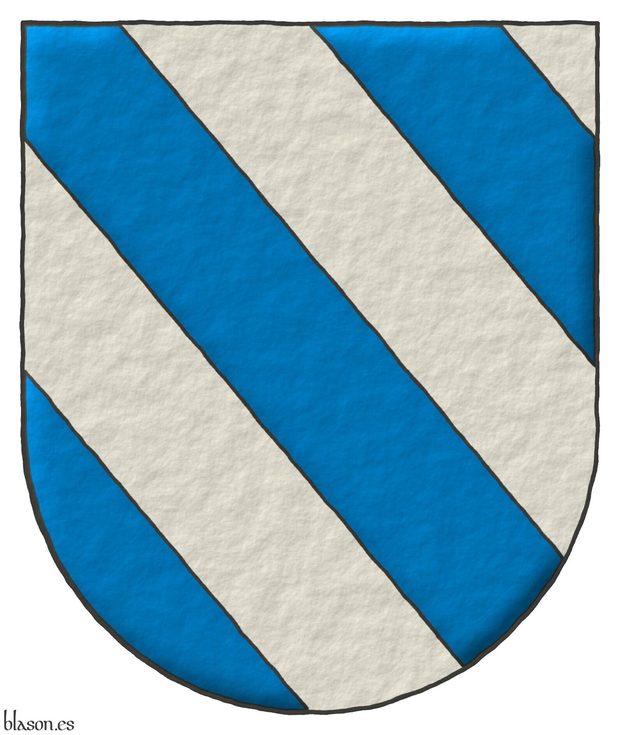
186th Pope of the Church, only 40 days in 1276. «Hadrianus V», born Ottobuono de Fieschi, was born in Genoa.
Bendy of six Azure and Argent.
Escudo bandado de seis piezas de azur y plata.
Papal coat of arms interpreted by me with: a shield with a rounded arch top; the field in plain tincture of Argent; the bands illuminated in Azure and outlined in Sable; and the whole in an elevated line style.
The blazon in French is «Bandé d'azur et d'argent de six pièces».
The banding is defined in [Avilés, J.; 1725a; page 40] and [Avilés, J.; 1780a; page 45] as the shields and also, the chiefs, fesses, pales, and figures, such as animals, etc., that are «covered and filled with bands in equal number, with as many of metal as of color».
Blazon keywords: Without divisions, Bendy, Six, Azure and Argent.
Style keywords: Semi-circular, Illuminated, Outlined in sable and Freehand.
Classification: Interpreted, Religious and Papal States.
Bearer: Adrian V.


Ajay Gopal Valecha, structured and parallel blazons
Coat of arms of Ajay Gopal Valecha granted by the College of Arms, and emblazoned by me, with the blazon written in English and Castilian in a structured way to observe the parallelism between both forms.
| Quarterly Or and Argent, overall a peacock in his splendour proper. | Escudo cuartelado de oro y plata, sobre el todo un pavo real ruante al natural. |
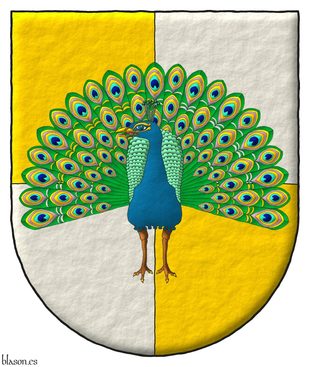 |
Blazon keywords: Argent, Or, One, Quarterly, Overall, Peacock, In his splendour and Proper.
Style keywords: Outlined in sable, Illuminated, Semi-circular and Freehand.
Classification: Personal, Interpreted, Structured and parallel blazons, Boa and Coat of arms.
Bearer: Valecha, Ajay Gopal.


Alarcon of Cantabria, lineage
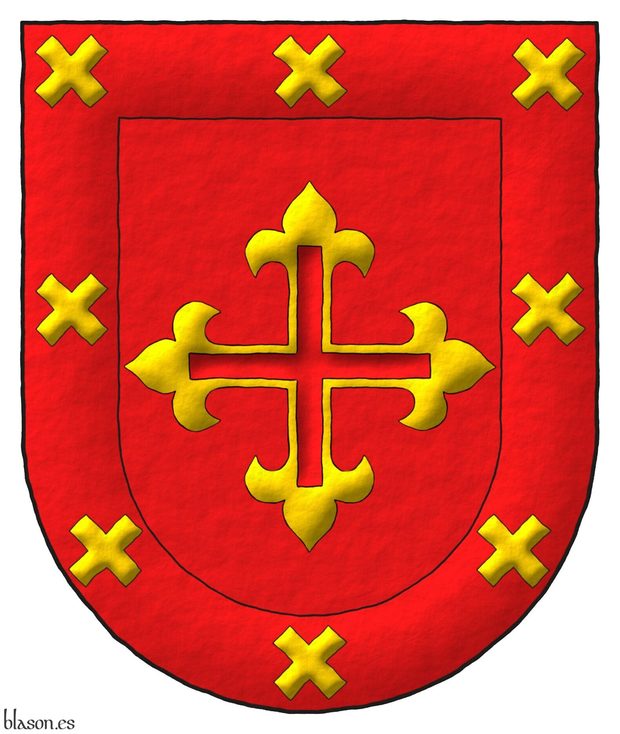
Gules, a cross flory voided Or; within a bordure Gules with eight saltires couped Or.
Escudo de gules, una cruz hueca flordelisada de oro; bordura de gules, ocho sotueres de oro.
Coat of arms painted by me, highlighted with lights and shadows, outlined in Sable, with a semi-circular external shape and with a freehand finishing.
Ancient arms of Alarcon of Cantabria emblazoned by me.
Blazon keywords: Argent, Sable, Or, Gules, Three, Cross, Flory, Voided, Bordure, Saltire and Couped.
Style keywords: Outlined in sable, Illuminated, Semi-circular and Freehand.
Classification: Personal, Interpreted, Boa and Coat of arms.
Bearer: Alarcon of Cantabria, lineage.


Albero, lineage of Aragon
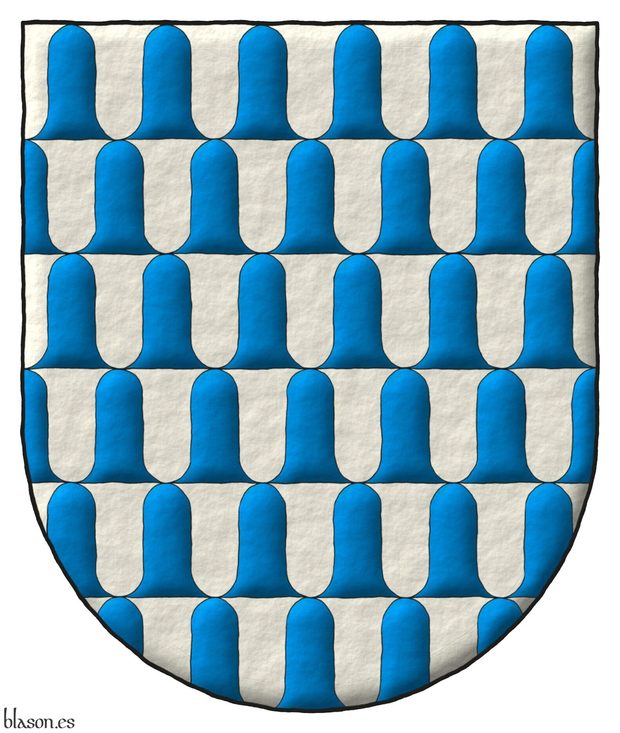
Blazon of the Albero lineage of Aragon.
Vair ancient.
Escudo de veros antiguos.
Illuminated and with a glass finish.
It can be consulted in [Cadenas y Vicent, V. de; 1987; page 62].
[Friar, S.; 1987; pages 157-158] says of the veros: «originates from the fur of a species of squirrel... which was popular in the Middle Ages as a lining for the garments of those not entitled to wear ermine. The animal was blue-grey on the back and white underneath. By sewing a number of these pelts together, with white and blue-grey alternating,... one which easily translated into the stylized armorial form of Vair and its variants».
Blazon keywords: Vair ancient.
Style keywords: Freehand, Outlined in sable, Illuminated and Semi-circular.
Classification: Interpreted, Lineage and Coat of arms.


Alcantara, Cavalry Regiment
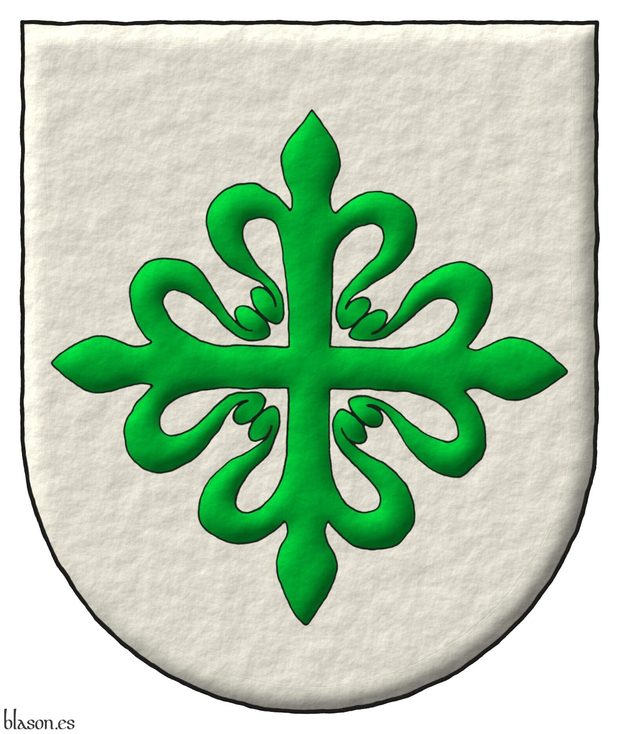
Coat of arms of the Armored Cavalry Regiment Alcantara No. 10, RCAC-10, in 2016.
Argent, a cross of Alcantara.
Escudo de plata, una cruz de Alcántara.
Coat of arms interpreted in the following manner: the shape of the shield is of a semicircular arch; the field is illuminated in the metal Argent; the cross of Alcantara is outlined in Sable and illuminated in Vert; and the whole has a raised stroke finish.
Blazon keywords: Without divisions, Argent, Cross of Alcantara, Cross couped and Cross.
Style keywords: Semi-circular, Illuminated, Outlined in sable and Freehand.
Classification: Interpreted, Military, Army and Navy and Coat of arms.
Bearer: Alcantara, Cavalry Regiment.


Aldam, lineage of England
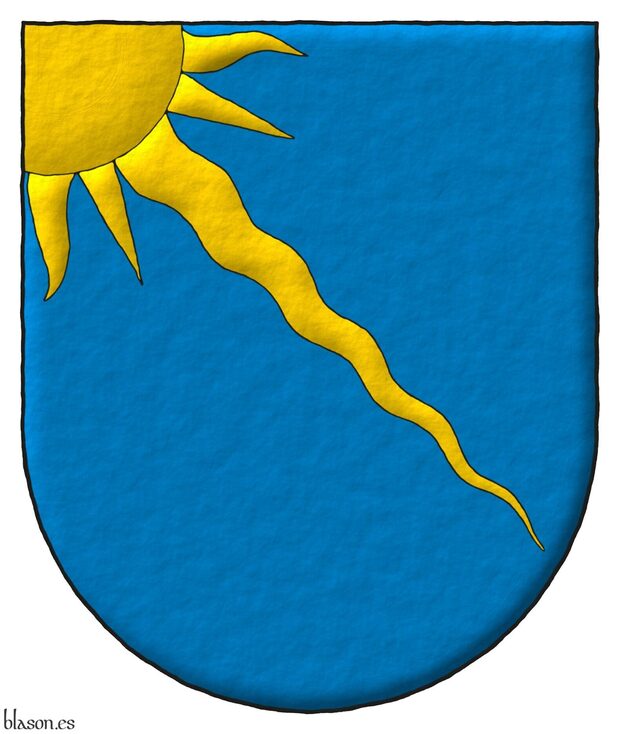
Blazon of the Aldam lineage of England.
Azure, a ray of the sun bendwise, issuant from the dexter chief Or.
Escudo de azur, un rayo de sol puesto en banda, naciente de la diestra del jefe de oro.
Illuminated with lights and shadows and with a freehand finish.
Described in [Burke, B.; 1989; page 9, column 1, entry 11].
Blazon keywords: Without divisions, Azure, One, Ray of the sun, Bendwise, Nascent, Dexter, Chief and Or.
Style keywords: Freehand, Outlined in sable, Illuminated and Semi-circular.
Classification: Interpreted, Lineage and Kingdom of England.


Alea Capital
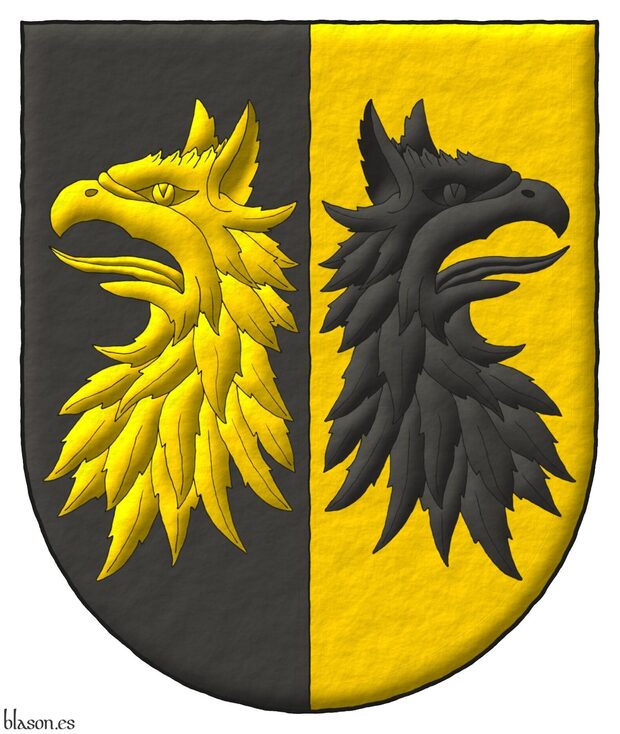
Party per pale Sable and Or, two griffins' heads eraticted, and addorsed counterchanged.
Escudo partido de sable y oro, dos cabezas de grifo arrancadas y adosadas del uno en el otro.
Coat of arms emblazoned by me with a semi-circular shape, illuminated, and with a freehand finishing.
Blazon keywords: Party per pale, Sable, Or, Two, Head, Griffin, Erased, Addorsed and Counterchanged (side-by-side).
Style keywords: Outlined in sable, Semi-circular, Illuminated and Freehand.
Classification: Socioeconomic, Created and Coat of arms.
Bearer: Alea Capital.


Alena Rehberger
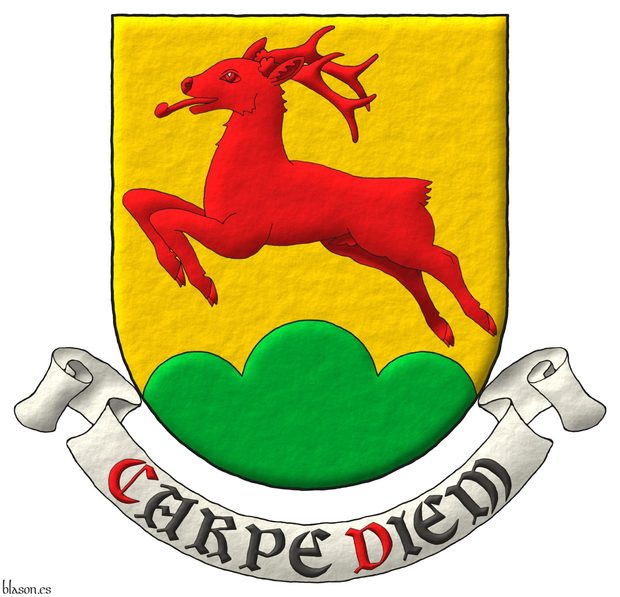
Or, a roe deer springing Gules, in base a triple mount Vert. Motto: «Carpe diem».
Escudo de oro, un corzo brincante de gules, en punta un monte de tres peñas de sinople. Lema: «Carpe diem».
Credits:
- Stephan Urs Breu is the designer of the coat of arms.
- Antonio Salmerón y Cabañas is the author of the heraldic art.
Blazon keywords: Or, One, Roe deer, Springing, Gules, In base, Trimount, Vert and Motto.
Style keywords: Outlined in sable, Semi-circular, Illuminated and Freehand.
Classification: Personal, Interpreted, Coat of arms and Latin language.
Bearer: Rehberger, Alena.


Alexander Nisbet, schema
Bordure engrailed and bordure invected.
Painting inspired in [Nisbet, A.; 1816; page 21, pictures 1 and 2], but with the 3 boar's heads of Alexander Nisbet within the 2nd bordure invected.
Blazon writen by the College of Arms for the coat of arms of Michael John Huxley-Evans «Per fess nebuly Sable and Ermine in chief a Rose Argent barbed and seeded proper within a wreath of Thorns Or in base three Boar's Heads erased Sable armed Or.», but to differentiate from the «armed» of the claws, I prefer «tusked» to «armed» for the defenses/tusks of the boar's heads.
Blazon keywords: Bordure, Invected, Engrailed, Head and Boar.
Style keywords: Semi-circular.
Classification: Schema.
Bearer: Nisbet, Alexander.


Alfonso IX of Leon
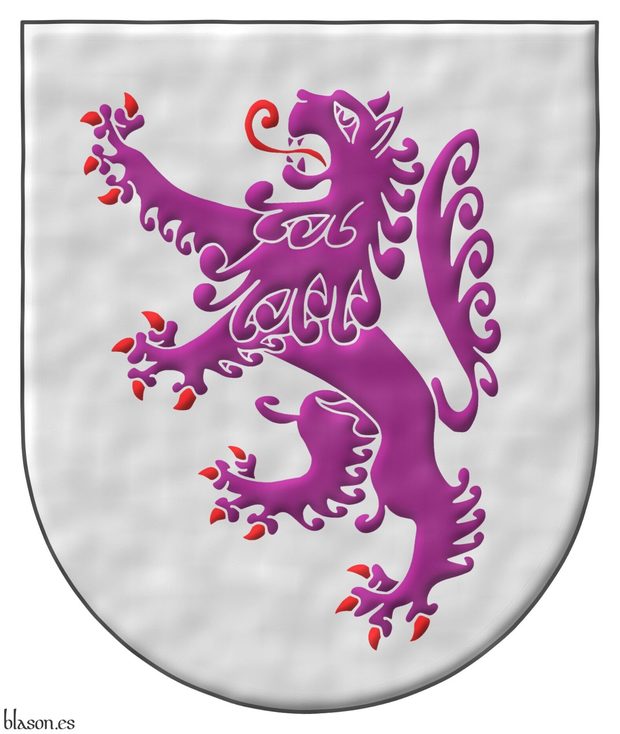
Born on August 15, 1171, in Zamora and died on September 24, 1230, in Sarria, Lugo.
Argent, a lion rampant Purpure, armed and langued Gules.
Escudo de plata, un león rampante de púrpura, armado y lampasado de gules.
Arms of the king of León interpreted by me as follows: the escutcheon is in a semi-circular arch; the field and the lion have been enameled and illuminated; and the ensemble has a watercolor finish.
This coat of arms of León can be seen, among many other places, for example, in [Argote de Molina, G.; 1588; chapter XLII].
Blazon keywords: Without divisions, Argent, Purpure, Gules, One, Lion, Rampant, Armed and Langued.
Style keywords: Semi-circular, Illuminated, Outlined in the field tincture and Watercolor.
Classification: Interpreted, Personal, Coat of arms and Kingdom of León.
Bearer: Alfonso IX of Leon.


Alfonso Sánchez de Perella, collage
Azure, a cross flory voided Argent; a bordure Gules charged with sixteen saltires couped Or.
Coat of arms emblazoned by me, highlighted with lights and shadows, contoured in Sable, with a semi-circular external shape and with a texturized finishing.
Alfonso Sánchez de Perella, first mayor of Burgos emblazoned by me. He appears as the [Cofradía de Santiago; Century XIV; 4th knight, 1st of the page 21 V], from this 14th century Book of the Brotherhood of Knights of Santiago de la Fuente. This was a brotherhood founded by the Burgos citizens at the time of King Alfonso XI of Castilla, 1311-1350. In the book, there are 14 saltires instead of 16, as it appears that one is missing on the sinister side of the base, and there are 4 in the chief instead of 5.
Blazon keywords: Azure, Argent, Gules, Or, One, Sixteen, Cross, Flory, Voided, Bordure, Saltire and Couped.
Style keywords: Outlined in sable, Illuminated and Semi-circular.
Classification: Personal, Interpreted, Boa and Coat of arms.
Bearer: Sánchez de Perella, Alfonso.


Almorrabides of Navarre
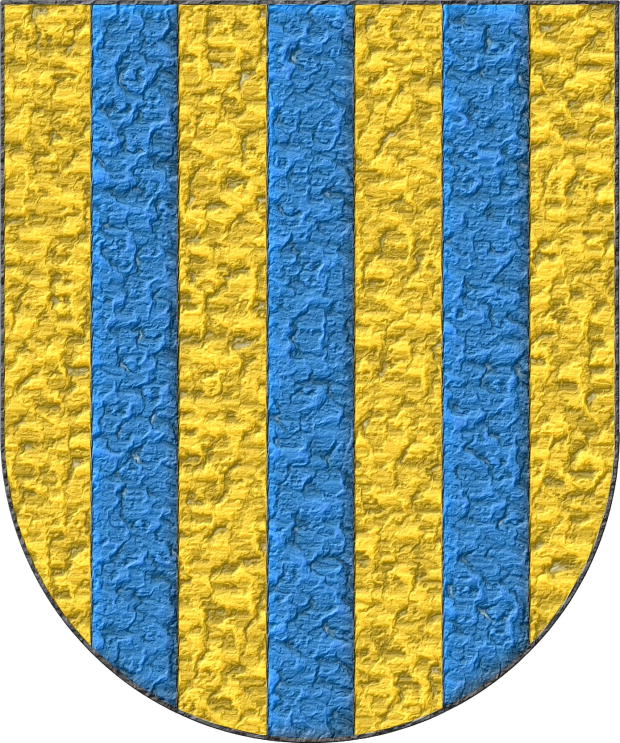
Of the twelve lineages of Noblemen, it is the first, and they bear as arms, on a golden field, three pales Azure.
Or, three Pallets Azure.
Escudo de oro, tres palos de azur.
Coat of arms interpreted with: a semicircular (round) base; the field in flat Or; the pales outlined in Sable and illuminated in Azure enamel; and finished in highly-hammered metal.
Based on the first coat of arms of the «ricoshombres» of Navarre in [Bosque, J. del; 1540; folio 1 of the numbering of 1613] and the text is from the transcription made in [Martinena Ruiz, J. J.; 1982; pages 122 and 123].
Under the title «Los Almorauides» it can also be consulted in [Vega, P. J. de; 1702; folio 1 of the manuscript].
Blazon keywords: Without divisions, Or, Three, Pale and Azure.
Style keywords: Semi-circular, Illuminated, Outlined in sable and Hard metal.
Classification: Interpreted, Personal and Kingdom of Navarre.
Bearer: Almorrabides of Navarre.


Amancier, lineage of Genevois
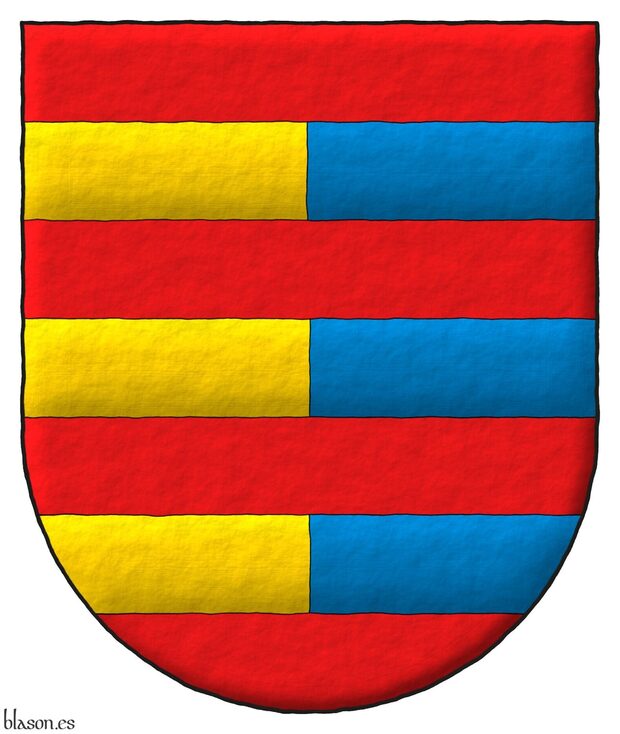
Blazon of the Amancier lineage of Genevois, Haute-Savoie, France.
Gules, three bars per pale Or and Azure.
Illuminated and a freehand finishing.
Its French blazon «de gueules, à trois fasces parties d'or et d'azur» can be found at [Rietstap, J. B.; 1861; page 40].
Any fess party per pale of metal and color or color and metal will always have a metal on metal or color on color conflict whether the field of the coat of arms is color or metal. There isn't conflict if the field of the coat of arms is also party per pale with metal under the color of the fess and with color under the metal of the fess or if the field is fur.
Blazon keywords: Without divisions, Gules, Three, Fess, Party per pale, Or and Azure.
Style keywords: Freehand, Outlined in sable, Illuminated and Semi-circular.
Classification: Interpreted, Lineage and Kingdom of France.


André, lineage of France
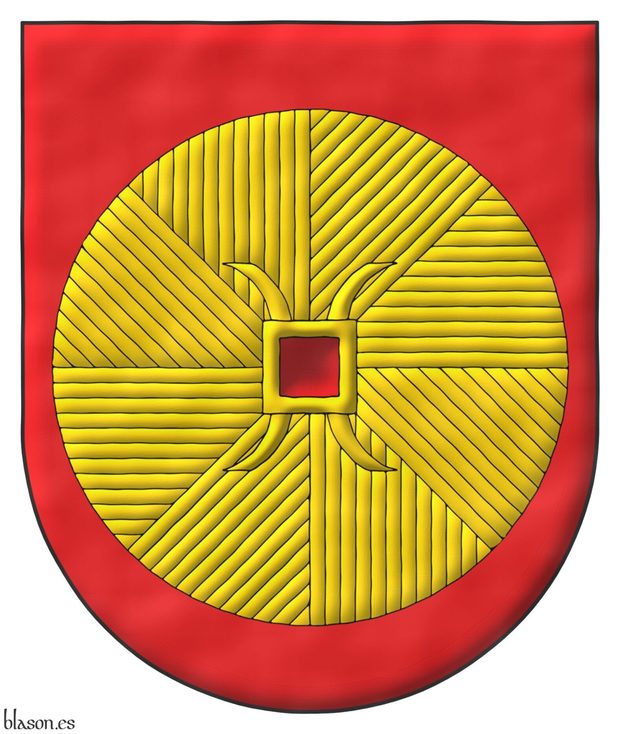
Blazon of the André lineage of France.
Gules, a millstone Or.
Escudo de gules, una piedra de molino de oro.
Illuminated and a watercolor finishing with shadow in the hole.
For its better identification, I have painted the millstone with the ring that fixes it to its axis. This ring is called a millrind, it is made of iron, and usually has 4 arms to better fix the millstone. Millrinds may appear on coats of arms independently of millstones. Another heraldic element related to the previous ones is the millwheel, which is a toothed gear that is part of the mill mechanism but should not be confused with the millstone that grinds the grain.
Blazon keywords: Without divisions, Gules, One, Millstone and Or.
Style keywords: Watercolor, Outlined in sable, Illuminated and Semi-circular.
Classification: Interpreted, Lineage and Kingdom of France.


Antonio José Gómez Morillo, design process
Coats of arms emblazoned by me with a shapes ended with semi-circular arches, illuminated, and with a leather finishing.
My designs with roses and a cross patty for the coat of arms of Antonio José Gómez Morillo, the design chosen to continue working was that of the 2nd row and 3rd column.
Blazon keywords: Argent, One, Cross patty, Cross couped, Gules, Charged, Double rose, Barbed, Seeded, Between and Four.
Style keywords: Semi-circular, Outlined in sable, Illuminated and Leather.
Classification: Personal, Created and Coat of arms.
Bearer: Gómez Morillo, Antonio José.


Antrobus, Thomas
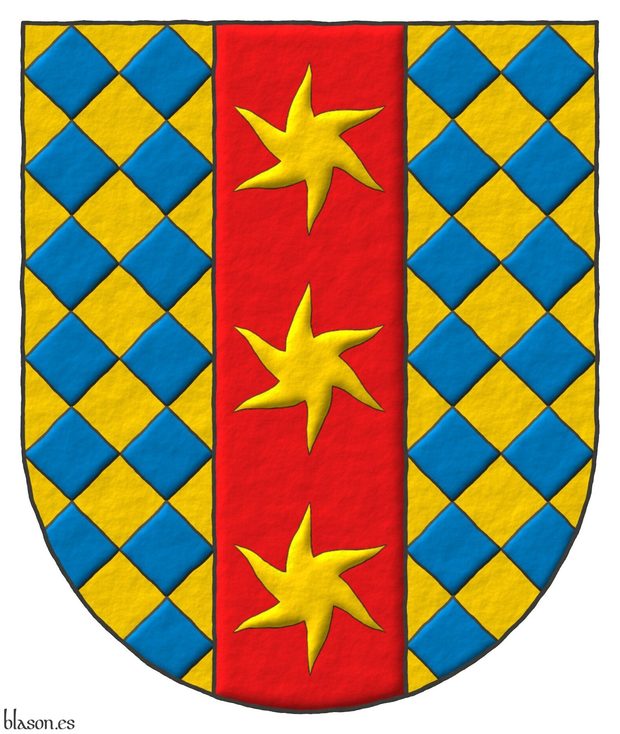
1525-1581.
Lozengy Or and Azure, on a pale Gules, three estoiles Or.
Escudo losanjado oro y azur, en un palo de gules, tres estrella ondadas de oro.
Coat of arms interpreted with: the semicircular base shape; the field of plain metal Or; the lozenges illuminated in Azure, outlined in Sable and with their 4 angles at 90o; the lozengy of proportion 5 x 6; the pale illuminated in Gules and outlined in Sable; the estoiles illuminated in Or and outlined in Sable; and the whole with a raised-stroke effect.
Blazon keywords: Lozengy, Or, Azure, Pale, Gules, Charged and Estoile.
Style keywords: Semi-circular, Illuminated, Outlined in sable and Freehand.
Classification: Interpreted and Personal.
Bearer: Antrobus, Thomas.


Araneta, lineage
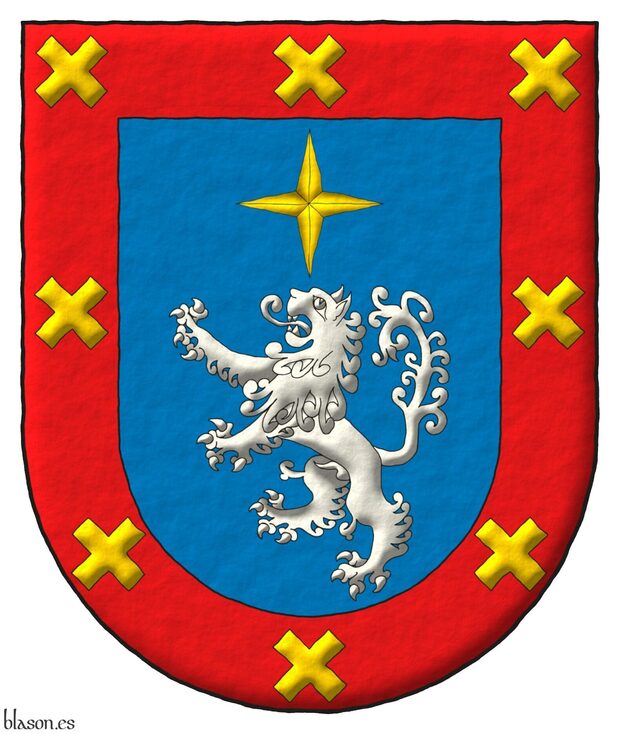
Azure, a lion rampant Argent, in chief a mullet of four points Or; a bordure Gules charged with eight saltires couped Or.
Escudo de azur, un león rampante de plata, surmontado de un lucero de oro; una bordura de gules cargada de ocho sotueres de oro.
Coat of arms emblazoned by me, highlighted with lights and shadows, contoured in Sable, with a semi-circular outer contour and with a freehand finishing.
These are the ancient arms of the lineage Araneta emblazoned by me. They are from the Basque Country and there is a branch in the Philippines. This star is known as mullet of four points.
Blazon keywords: Azure, Argent, Or, Gules, One, Eight, Lion, Rampant, Mullet of four points, Bordure, Saltire and Couped.
Style keywords: Outlined in sable, Illuminated, Semi-circular and Freehand.
Classification: Personal, Lineage, Interpreted, Boa and Coat of arms.
Bearer: Araneta, lineage.


Aras Quirce, Manuel Maria
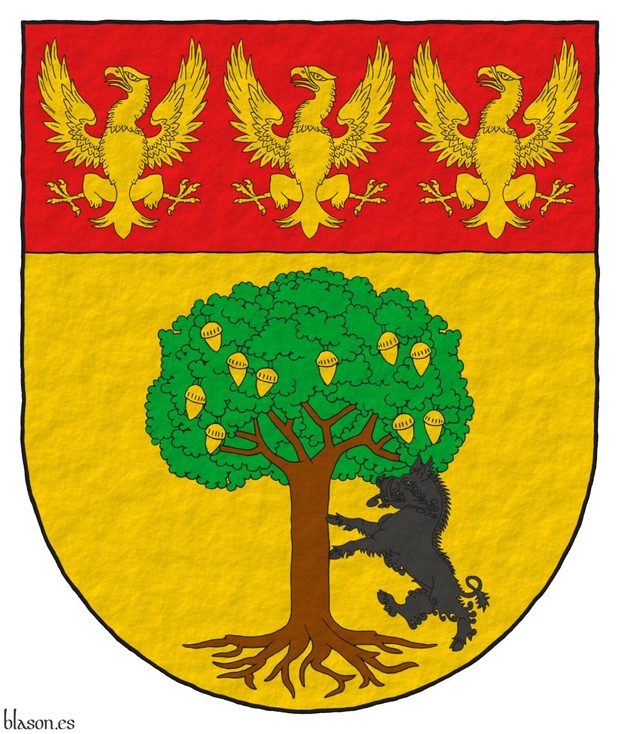
Or, an oak tree proper, fructed Or, with a boar supporting it Sable; on a chief Gules, three eagles displayed Or.
Escudo de oro, un roble al natural, frutado de oro, con un jabalí empinado de sable; en un jefe de gules, tres águilas de oro.
Escudo interpretado por mí, en tinturas planas, delineado de sable, con un contorno exterior medio punto y con un terminado texturizado.
Coat of arms of Manuel Maria Aras Quirce designed by Juan Lanzagorta Vallin and emblazoned by me.
Credits: Juan Lanzagorta Vallin is the designer of the coat of arms.
Blazon keywords: Or, One, Oak, Tree, Proper, Fructed, Boar, Supporting, Sable, Chief, Gules, Three and Eagle.
Style keywords: Outlined in sable, Plain tincture and Semi-circular.
Classification: Personal, Interpreted and Coat of arms.
Bearer: Aras Quirce, Manuel Maria.


Argudo of Guipuzcoa, lineage
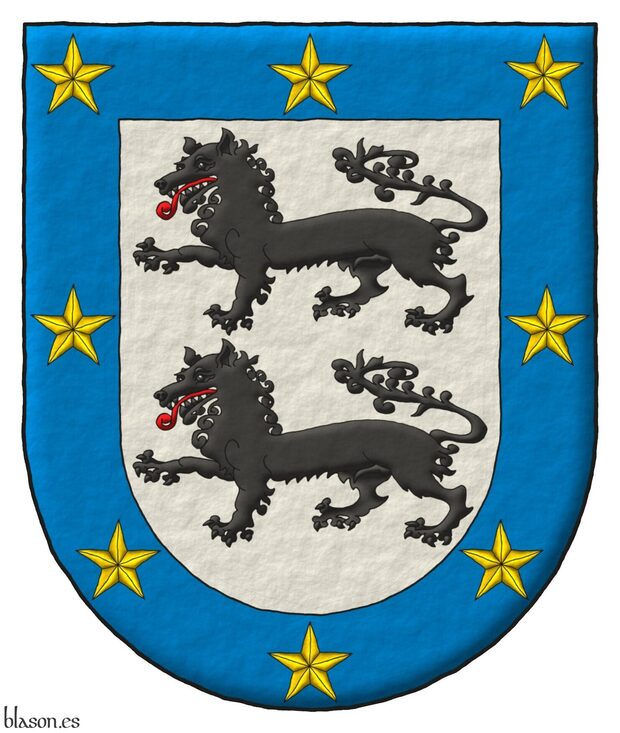
Argent, two wolves passant, in pale Sable, langued Gules; a bordure Azure charged with eight mullets Or.
Escudo de plata, dos lobos pasantes, en palo de sable, lampasados de gules; una bordura de azur cargada de ocho estrellas de oro.
Arms depicted by me, illuminated with lights and shadows, outlined in Sable, with a semi-circular outer contour and with a freehand finishing.
Ancient arms of the lineage Argudo of Guipuzcoa emblazoned by me. The lineage Ochoa of Vergara has a blazon equivalent to this one. Alternative blazon: «Argent, two wolves passant, in pale Sable, langued Gules; on a bordure Azure, eight mullets Or».
Blazon keywords: Argent, Sable, Gules, Azure, Or, One, Eight, Wolf, Passant, In pale, Bordure and Mullet.
Style keywords: Outlined in sable, Illuminated, Semi-circular and Freehand.
Classification: Personal, Lineage, Interpreted, Boa and Coat of arms.
Bearer: Argudo of Guipuzcoa, lineage.


Argüello of Extremadura, lineage
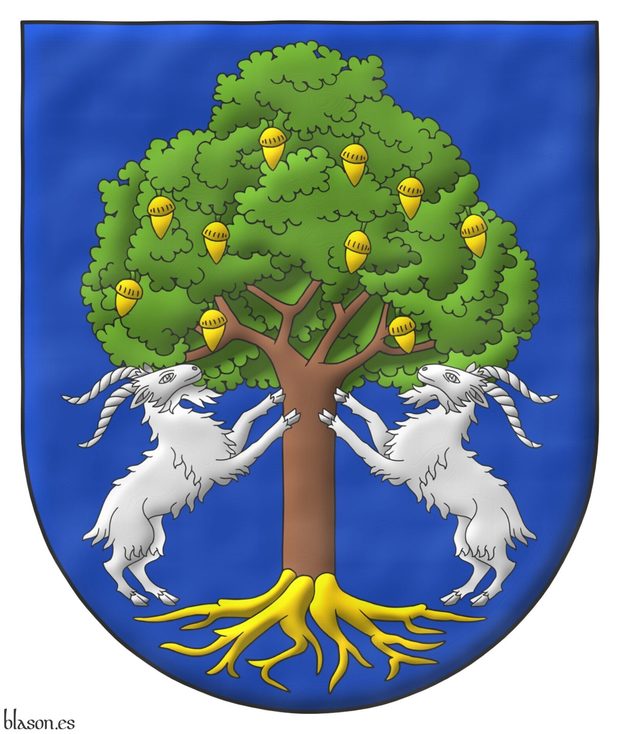
Azure, a holm oak proper, fructed and eradicated Or, between two goats Argent supporting it.
Escudo de azur, una encina al natural, frutada y arrancada de oro, con dos cabras de plata empinadas al tronco.
Coat of arms emblazoned by me, illuminated with lights and shadows, contoured in Sable, with a semi-circular outer contour and with a watercolor finishing.
Coat of arms of the lineage Argüello of Extremadura emblazoned by me. Its blazon may be found in the books [Atienza y Navajas, J. de; 1959; page 171] and [Cadenas y Vicent, V. de; 1987; page 167], where it is described as Vert with its acorns and roots Or. In this rendition, I have interpreted the holm oak as proper, but also fructed and eradicated Or.
Blazon keywords: Azure, Or, Argent, One, Two, Holm oak, Proper, Fructed, Eradicated, Goat and Supporting.
Style keywords: Outlined in sable, Illuminated, Semi-circular and Watercolor.
Classification: Personal, Lineage, Interpreted, Boa and Coat of arms.
Bearer: Argüello of Extremadura, lineage.


Arjona Berrocal, Rubén
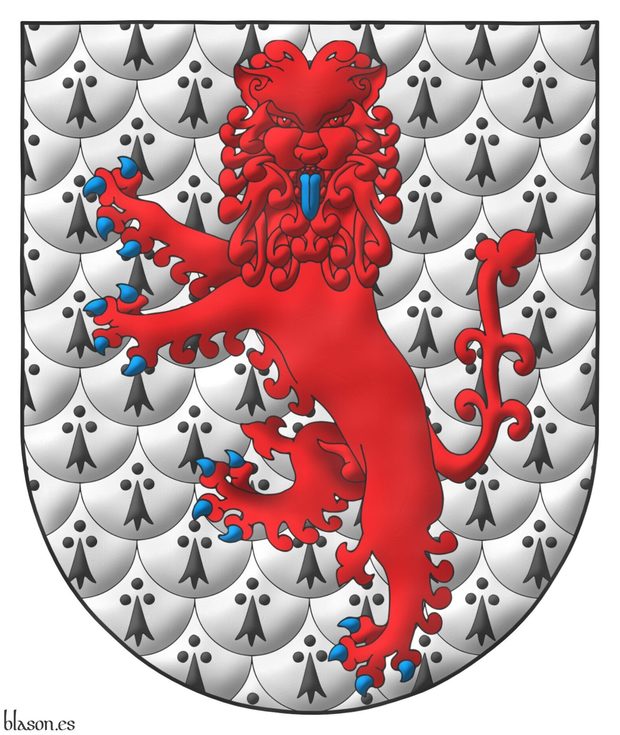
Ermine papelonny, a lion rampant guardant Gules, armed and langued Azure.
Escudo de armiños papelonado, un leopardo leonado de gules, armado y lampasado de azur.
Coat of arms emblazoned by me with a semi-circular ended shape, illuminated, and its finishing is that seems watercolor.
Credits:
- Felipe Trujillo Jiménez is the designer of the coat of arms.
- Antonio Salmerón y Cabañas is the author of the heraldic art.
Blazon keywords: Without divisions, Ermine, Papelonny, One, Lion rampant guardant, Gules, Armed, Langued and Azure.
Style keywords: Semi-circular, Outlined in sable, Illuminated and Watercolor.
Classification: Personal, Interpreted and Coat of arms.
Bearer: Arjona Berrocal, Rubén.


Arrano Beltza, plain tincture
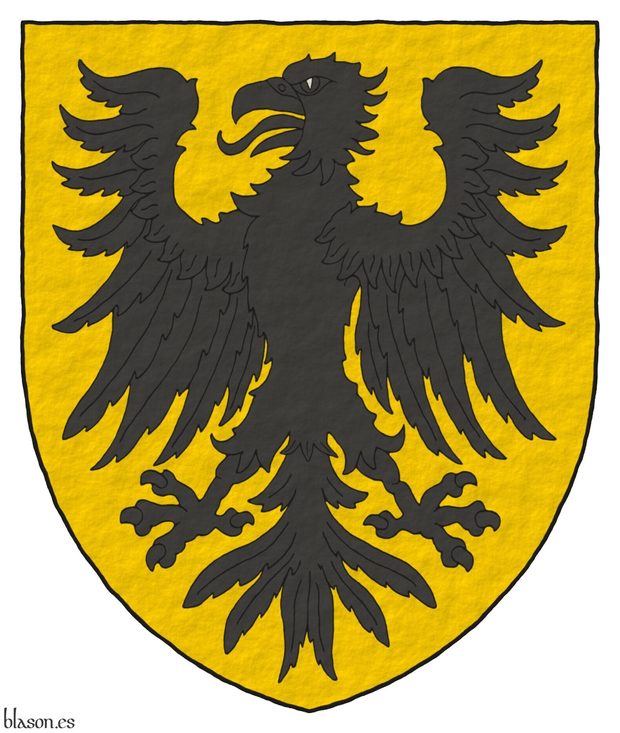
Or, a eagle displayed Sable.
Arms painted by me, in plain tinctures, contoured in Sable, with a semi-circular external shape and with a texturized finish.
Coat of arms of the Arrano Beltza, the black eagle, emblazoned by me. Historically, it is associated with the Kingdom of Navarre and its king, Sancho VII the Strong, 1154-1234, although there is no definitive documentary evidence that it was used as an official coat of arms.
Blazon keywords: Or, Sable, One, Eagle and Displayed.
Style keywords: Outlined in sable, Plain tincture and Semi-circular.
Classification: Civic, Interpreted, Boa and Coat of arms.
Bearer: Arrano Beltza.


Asuncion and de la Asuncion, lineages
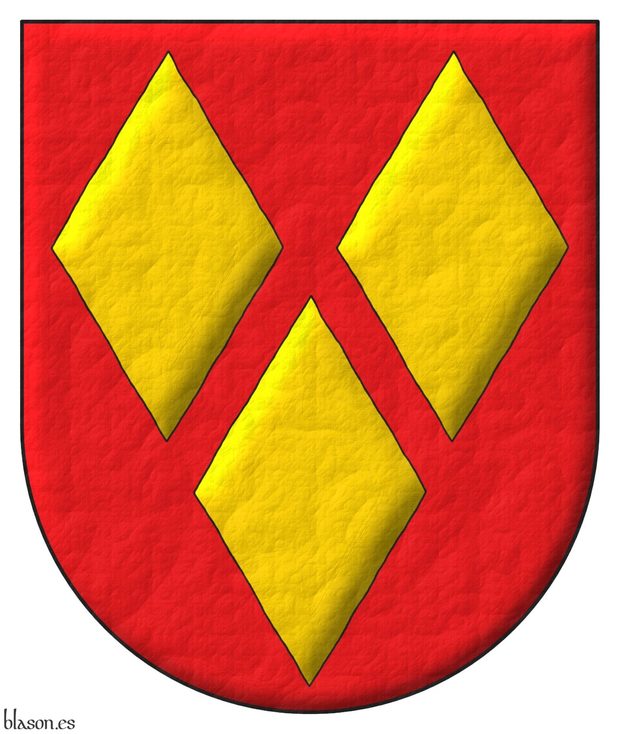
Gules, three lozenges Or.
Escudo de gules, tres losanjes de oro.
Arms painted by me, highlighted with lights and shadows, outlined in Sable, with a semi-circular external shape and with a leather finish.
Coat of arms of the lineages Asuncion and de la Asuncion emblazoned by me.
Blazon keywords: Gules, Or, Three and Lozenge.
Style keywords: Outlined in sable, Illuminated, Semi-circular and Leather.
Classification: Personal, Interpreted, Boa and Coat of arms.
Bearer: Asuncion and de la Asuncion, lineages.


Avelar, lineage of Portugal
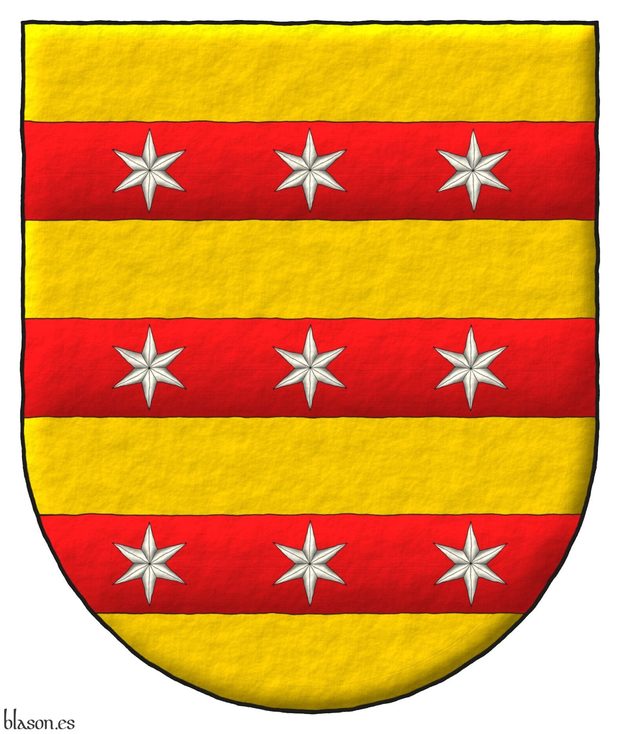
Blazon of the Avelar lineage of Portugal.
Or, three bars Gules charged each one with three mullets of six points Argent.
Illuminated and a freehand finishing.
It can be found at [Cró, J. do; 1509; page 127].
Blazon keywords: Without divisions, Or, Three, Fess, Gules, Charged, Mullet and Argent.
Style keywords: Freehand, Outlined in sable, Illuminated and Semi-circular.
Classification: Interpreted, Lineage and Kingdom of Portugal.


Aybar of Navarre
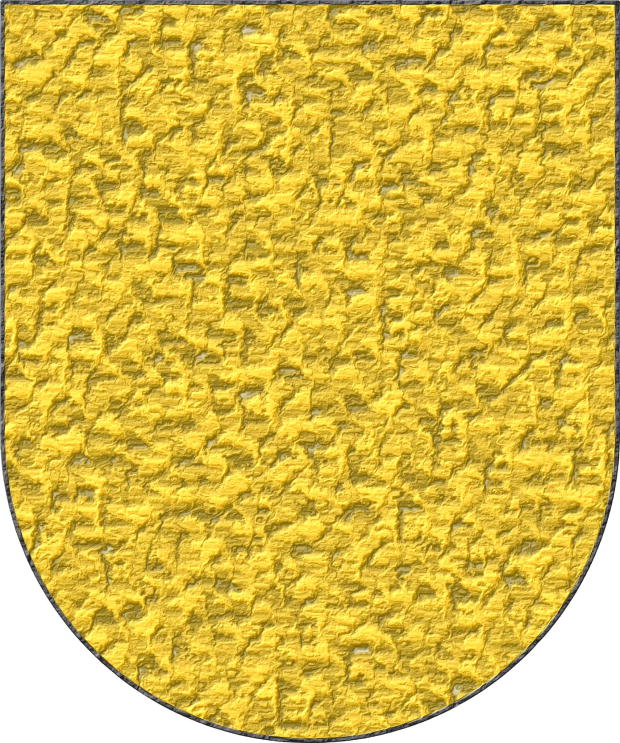
Of the twelve lineages of Noblemen, they are the third great and ancient barony, where the first King of Aragon had his mother; they make a shield of Or without any mixture of colour or device, but a field of gold as painted in this shield.
Or.
Escudo de oro.
A coat of arms that leaves little room for interpretation, which I have recreated with: a semicircular (round) base; the field in flat Or; and finished in highly-hammered metal.
Based on the third coat of arms of the «ricoshombres» of Navarre from [Bosque, J. del; 1540; folio 1 of the numbering of 1613] and the text is from the transcription made in [Martinena Ruiz, J. J.; 1982; pages 122 and 123].
Under the title «Surname of Aybar» it can also be consulted in [Vega, P. J. de; 1702; folio 3 of the manuscript].
Blazon keywords: Without divisions and Or.
Style keywords: Semi-circular, Illuminated, Outlined in sable and Hard metal.
Classification: Interpreted, Personal and Kingdom of Navarre.
Bearer: Aybar of Navarre.


Bailleul, commune of
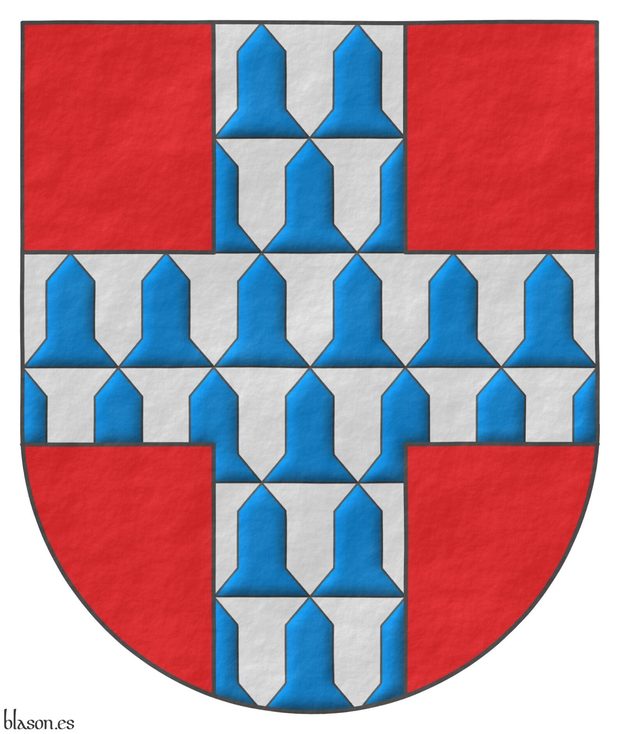
Gules, a cross vair.
Escudo de gules, una cruz de veros.
Coat of arms interpreted with: a semicircular (round) base; the field in flat tincture of Gules; the vair illuminated and outlined in Sable; and the whole with a roughened finish.
The commune of Bailleul is located in the district of Dunkirk, in the Nord department, in the Nord–Pas-de-Calais region of France.
The coat of arms of Bailleul, called «Belle» in Flemish, is similar to that of the heraldist Gonzalo Argote de Molina, differing in that the commune’s arms bear vair, while the heraldist’s arms bear rounded vair in the ancient style.
Blazon keywords: Without divisions, Gules, Argent, Azure, Cross and Vair.
Style keywords: Semi-circular, Illuminated, Outlined in sable and Rough.
Classification: Interpreted, Civic, Coat of arms and Kingdom of France.
Bearer: Bailleul, commune of.


Baldovino from Venecia, lineage
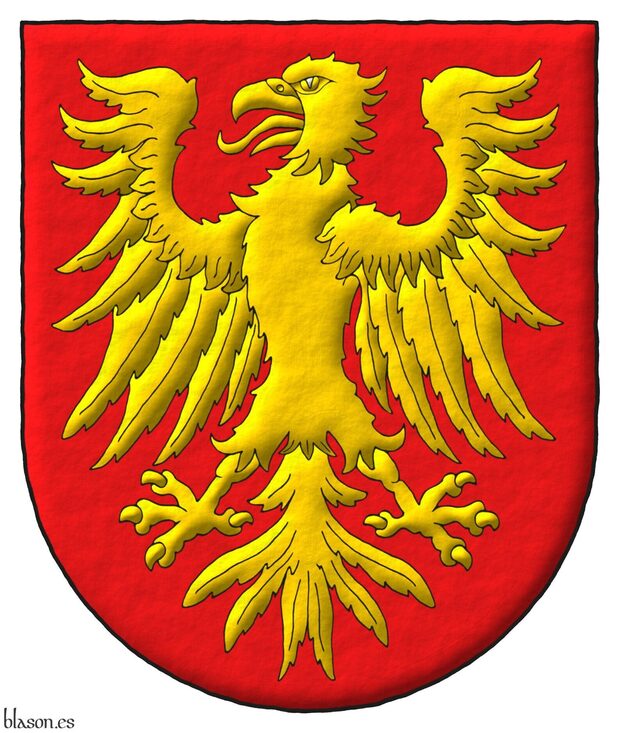
Gules, an eagle displayed Or.
Escudo de gules, un águila de oro.
Coat of arms interpreted by me, illuminated with lights and shadows, outlined in Sable, with a semi-circular outer contour and with a freehand finish.
Blazon keywords: Gules, Or, One, Eagle and Displayed.
Style keywords: Outlined in sable, Illuminated, Semi-circular and Freehand.
Classification: Personal, Lineage, Interpreted, Boa and Coat of arms.
Bearer: Baldovino from Venecia, lineage.


Barras, comparación de 2 métodos de delineación
Argent, three bendlets sinister Azure.
Escudo de plata, tres barras de azur.
Blazon keywords: Without divisions, Argent, Azure and Bend sinister.
Style keywords: Semi-circular, Ogee and Freehand.
Classification: Schema.
Bearer: Lauria, Roger de.


Bartolomé Quesada Valles
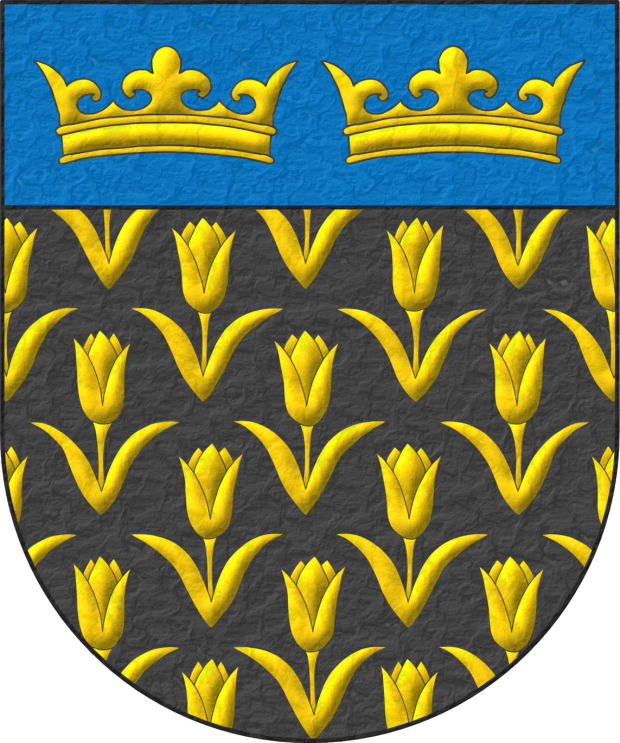
Sable, semé of Tulips Or; on a chief cousu Azure, two Crowns Or, in fess.
Escudo de sable, sembrado de tulipanes de oro; el jefe cosido de azur, dos coronas de oro, en faja.
Blazon keywords: Without divisions, Sable, Or, Azure, Chief, Two, Crown, In fess, Semé and Tulip.
Style keywords: Soft metal, Semi-circular, Illuminated, Outlined in the field tincture, Outlined in sable and Cousu.
Classification: Coat of arms, Created and Personal.
Bearer: Quesada Valles, Bartolomé.


Baudry in France
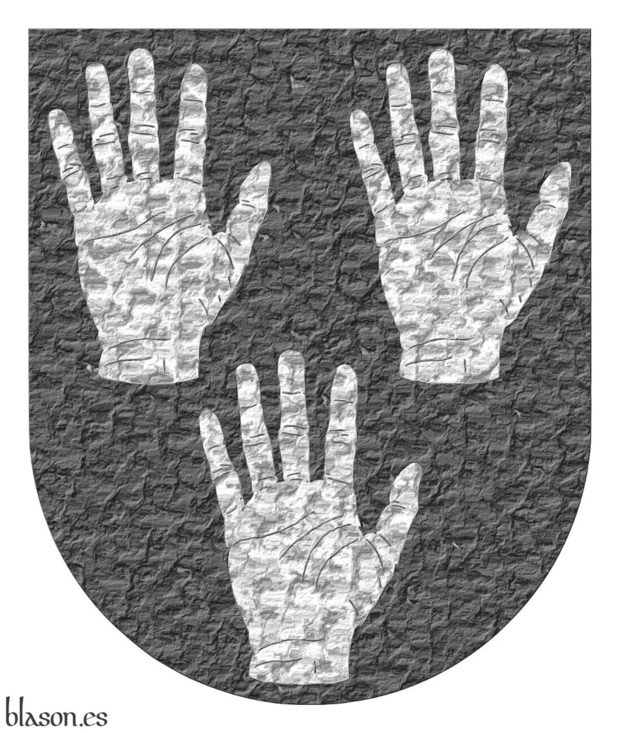
Sable, three dexter hands turned up, and appaumée Argent.
Escudo de sable, tres manos diestras levantadas y apalpadas de plata.
Coat of arms interpreted based on blazon and explanations of [Avilés, J.; 1725a; pages 34 y 35 y sheet 2 figure 38].
Blazon keywords: Without divisions, Sable, Three, Hand, Dexter, Argent, Turned up, Appaumée and Ordered.
Style keywords: Semi-circular, Plain tincture, Outlined in the field tincture and Soft metal.
Classification: Interpreted, Personal and Kingdom of France.
Bearer: Baudry en Francia.


Baztanes of Navarre
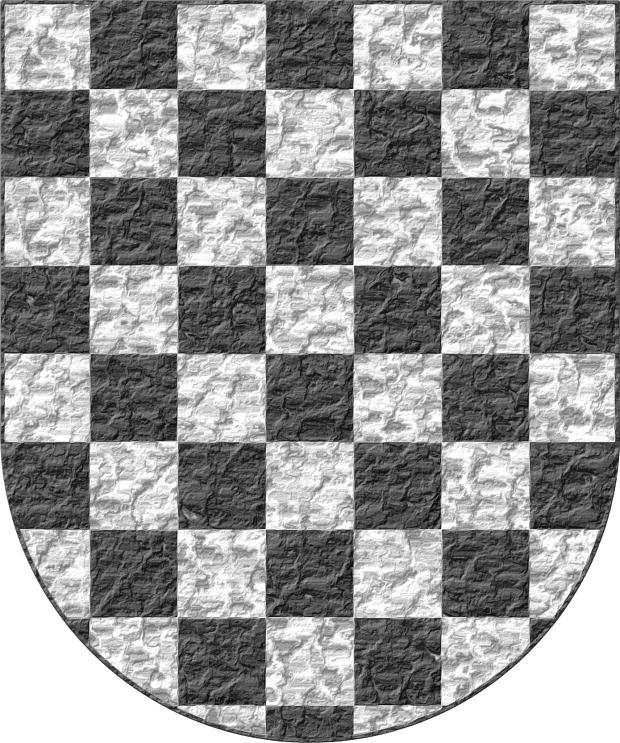
Of the twelve lineages of Noblemen, it is the fourth, and they bear as arms a chessboard, that is, a field chequy Argent and Sable, which is black, in the same form and design as this shield is now painted.
Chequey Argent and Sable.
Escudo ajedrezado de plata y sable.
Coat of arms recreated with: a semicircular (round) base; the field in flat Argent; the chequy or checky pattern illuminated in Sable; and finished in highly-hammered metal.
Coat of arms based on the fourth of the Navarrese «ricoshombres» from [Bosque, J. del; 1540; folio 1 of the numbering of 1613], but, unlike the original, adjusting the height of each square to its width so that they are perfect squares, since in Juan del Bosque’s version—actually in its copy, because the original was stolen—they appear somewhat narrow and elongated. The text heading this article is taken from the transcription made by [Martinena Ruiz, J. J.; 1982; pages 122 and 123].
Under the title «Surname of Baztan» it can also be consulted in [Vega, P. J. de; 1702; folio 4 of the manuscript], although in this case the numbering is not clearly legible; it is the folio following 3, preceding the one also numbered 4 but marked with a letter B, which in turn is followed by folio 6, the number 5 being missing — though not folio 5, which would be 4B.
Baztanes and the Valley of Baztan are mentioned in [Garaycoa Raffo, L.; 2011; pages 8, 29, 30, 33, 37, and 38].
The geometric construction of this coat of arms can be found in [Messía de la Cerda y Pita, L.; 1990; page 108].
Blazon keywords: Without divisions, Or, Chequey and Sable.
Style keywords: Semi-circular, Illuminated and Hard metal.
Classification: Interpreted, Personal and Kingdom of Navarre.
Bearer: Baztanes of Navarre.


Benedict XII
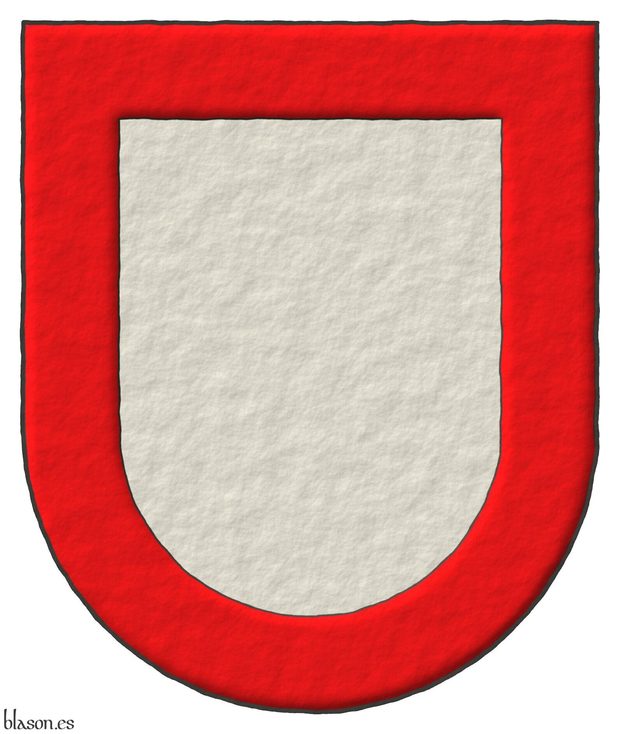
197th Pope of the Church, from 1334 to 1342. «Benedictus XII», born Jacques Fournier, was born in Saverdun, in the south of Occitania.
Argent, a bordure Gules.
Escudo de plata, una bordura de gules.
Papal coat of arms interpreted with: a round-topped shield; the field in plain Argent; the bordure outlined in Sable and illuminated in Gules; and the whole design in raised outline.
Blazon keywords: Without divisions, Argent, One, Bordure and Gules.
Style keywords: Semi-circular, Illuminated, Outlined in sable and Freehand.
Classification: Interpreted, Religious and Papal States.
Bearer: Benedict XII.


Benedict XIV
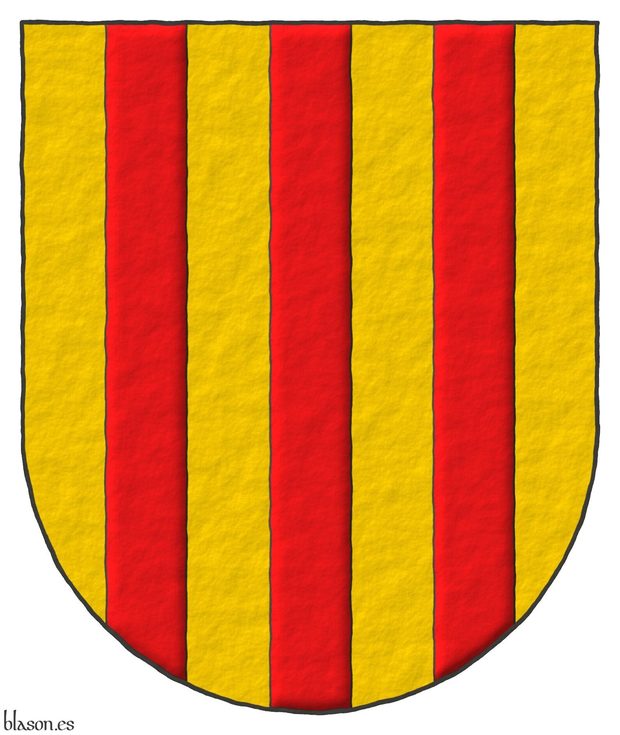
247th Pope of the Church, from 1740 to 1758. «Benedictus XIV», named Prospero Lorenzo Lambertini, born in Bologna.
Or, three pallets Gules.
Escudo de oro, tres palos de gules.
Papal coat of arms interpreted with: a rounded mouth; the field in flat tincture of Or; the pales outlined in Sable and illuminated in Gules enamel; and the whole with a raised stroke finish.
Blazon keywords: Without divisions, Or, Three, Pale and Gules.
Style keywords: Semi-circular, Illuminated, Outlined in sable and Freehand.
Classification: Interpreted, Religious and Papal States.
Bearer: Benedict XIV.


Berenguela of Castile
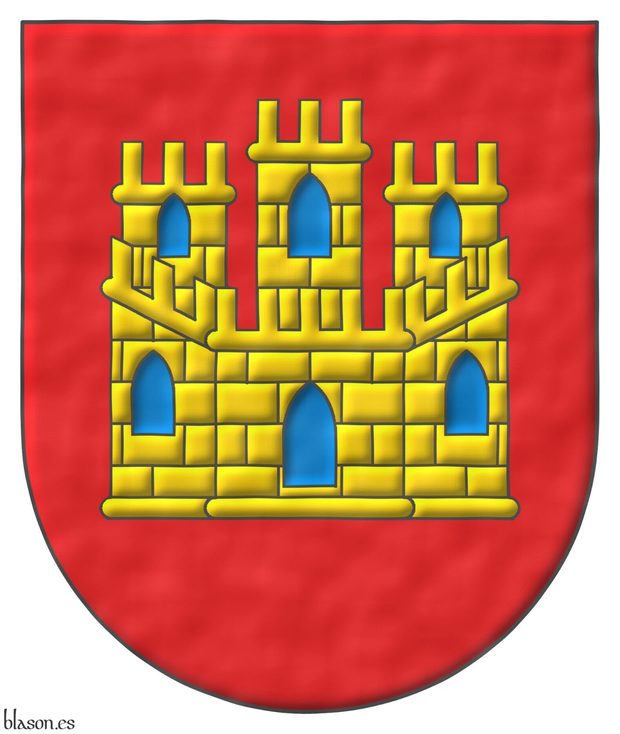
Born in 1179 in Segovia and died on November 8, 1246 in the Monastery of Las Huelgas in Burgos.
Gules, a castle triple towered Or, port and windows Azure, masoned Sable.
Escudo de gules, un castillo de oro, aclarado de azur, mazonado de sable.
Arms of the Queen of Castile, as interpreted by me: the shape of the shield is rounded; the field and the castle have been enamelled and illuminated; and the whole composition features a watercolor finish.
Blazon keywords: Without divisions, Gules, Or, Azure, Sable, One, Castle, Port and windows and Masoned.
Style keywords: Semi-circular, Illuminated, Outlined in sable and Watercolor.
Classification: Interpreted, Personal, Coat of arms and Kingdom of Castile.
Bearer: Berenguela of Castile.


Bernard de Tremelay
Or, a chief Gules. Behind the shield a cross patty Gules.
Blazon keywords: Or, Chief, Gules, Behind the shield, One, Cross patty and Cross couped.
Style keywords: Outlined in sable, Semi-circular, Illuminated and Freehand.
Classification: Religious, Military, Knights Templar, Interpreted and Coat of arms.
Bearer: Tremelay, Bernard de.


Bertrand de Blanchefort
Barry of four per pale counterchanged Or and Gules. Behind the shield a cross patty Gules.
The cross patty behind the shield has been diapered with Chinapieria.
Blazon keywords: Barry per pale counterchanged, Four, Or, Gules, Behind the shield, One, Cross patty and Cross couped.
Style keywords: Outlined in sable, Semi-circular, Illuminated, Freehand, Diapered and Chinapieria.
Classification: Religious, Military, Knights Templar, Interpreted and Coat of arms.
Bearer: Blanchefort, Bertrand de.


Boteler of Warrington
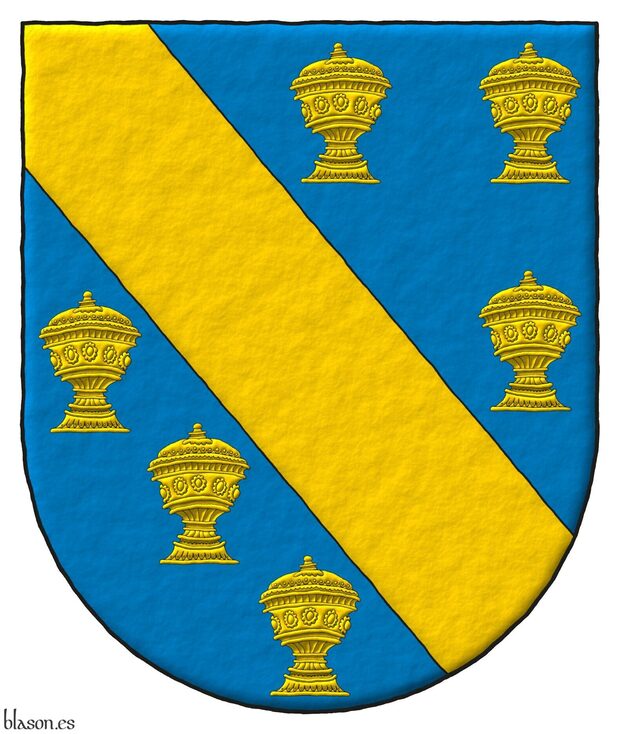
Azure, a bend between six covered cups Or.
Escudo de azur, una banda acompañada de seis copas todo de oro.
Illuminated with lights and shadows and with a freehand finish.
Around 1155, Beatrix de Villers married Richard le Boteler Pincerna, who became the 4th Baron of Warrington. The heir of Beatrix and Richard took the surname «le Boteler» and ruled the Warrington region, bearing arms Azure, a bend between six covered cups Or.
In Castilian, a «copa» has a lid and is referred to as a «covered cup» in English. When it doesn't have a lid, it's called a «cup» in English and a «cáliz» or «copón» in Castilian, the latter being a less preferred term for me. In English, the term «chalice» is also used, especially if it's adorned with gemstones, although that's more of an artistic license.
Naipes Heraclio Fournier is a renowned Spanish playing card manufacturer based in Villareal de Álava. The countless hours I have spent holding its cards in my hands are incalculable, whether playing with friends, opponents, or performing magic tricks. Its influence on my heraldic artwork is significant. For instance, in this covered cup.
The following image shows my covered cup and my two interpretations of his arms: 1) the most commonly viewed, and 2) my alternative layout.
Blazon keywords: Without divisions, Azure, One, Bend, Between, Six, Covered cup and Or.
Style keywords: Freehand, Outlined in sable, Illuminated and Semi-circular.
Classification: Interpreted and Kingdom of England.
Bearer: Boteler of Warrington.


Boyd of Scotland, lineage
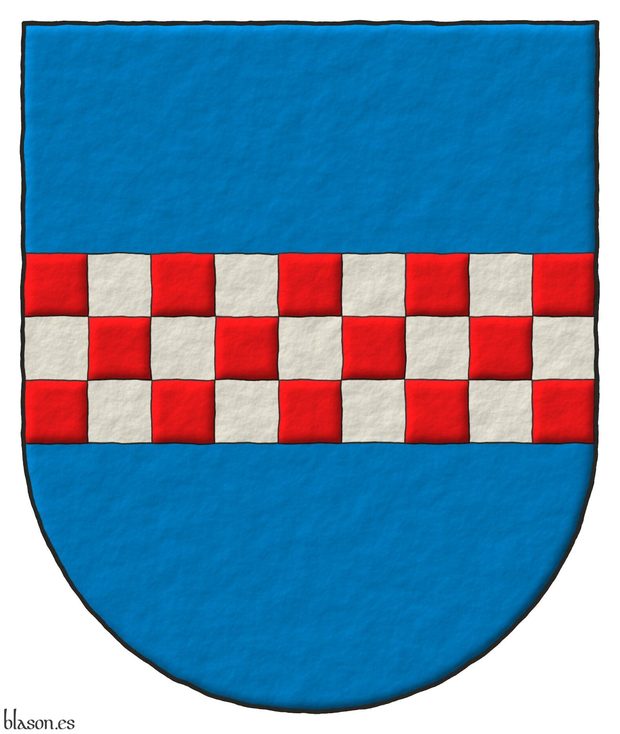
Azure, a fess chequey Gules and Argent.
Escudo de azur, una faja ajedrezada de gules y plata.
Coat of arms interpreted by me, highlighted with lights and shadows, contoured in Sable, with a semi-circular external shape and with a freehand finishing.
Coat of arms of the lineage Boyd of Scotland. I have emblazoned it with a fess chequy of 3 rows, symmetric and with 9 columns of squares, provided that its height is 1/3 of the width of the coat of arms.
Blazon keywords: Azure, Gules, Argent, One, Three, Nine, Fess and Chequey.
Style keywords: Outlined in sable, Illuminated, Semi-circular and Freehand.
Classification: Personal, Lineage, Interpreted, Boa and Coat of arms.
Bearer: Boyd of Scotland, lineage.


BPAC I
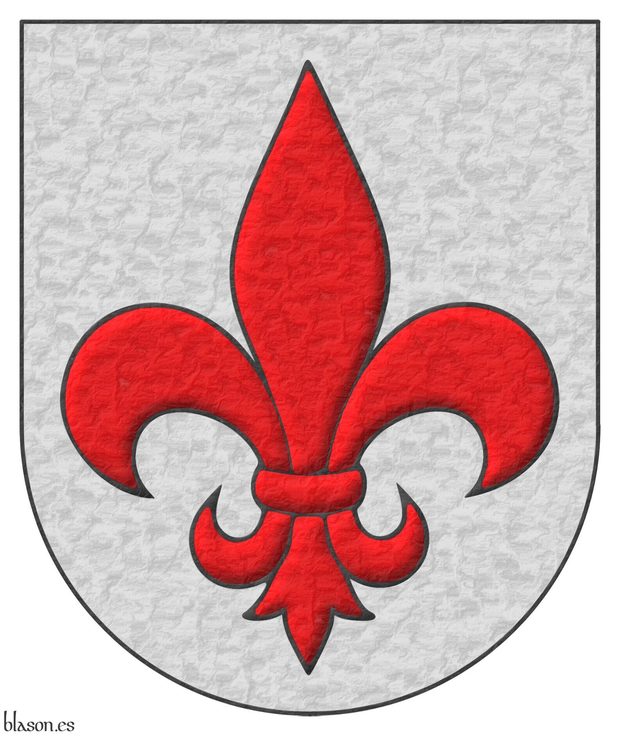
Flag «Roger de Flor», Paratroopers I, assigned to the «Almogávares» VI Paratrooper Brigade of the Spanish Army.
Argent, a fleur de lis Gules.
Escudo de plata, una flor de lis de gules.
Coat of arms interpreted with: a semicircular (round) base; a fleur de lis outlined in Sable and illuminated in Gules; and an overall lightly-hammered metal finish.
Blazon keywords: Without divisions, Argent, Gules and Fleur de lis.
Style keywords: Semi-circular, Illuminated, Outlined in sable and Soft metal.
Classification: Interpreted, Military, Army and Navy and Coat of arms.
Bearer: BPAC I.


BPAC II
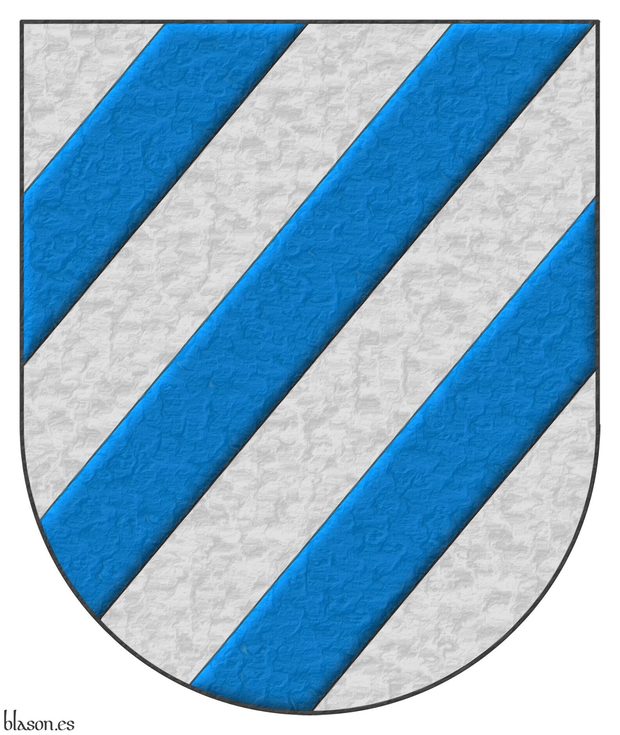
«Roger de Lauria»,' 2nd Paratrooper Battalion, part of the «Almogávares» VI Parachute Brigade of the Spanish Army.
Argent, three bendlets sinister Azure.
Escudo de plata, tres barras de azur.
For this interpretation, I have used: an exterior shape ending in a semicircular arch; my usual angle of 50.2o = arctan(6/5), as tangent = opposite side / adjacent side; a division similar to that used by the Spanish Army for this coat of arms, which relies on dividing the height of the shield into 4 segments; and for the whole, a finish of lightly hammered metal
Blazon keywords: Without divisions, Argent, Azure and Bend sinister.
Style keywords: Semi-circular, Illuminated, Outlined in sable and Soft metal.
Classification: Interpreted, Military and Army and Navy.
Bearer: BPAC II.


Burr, lineage
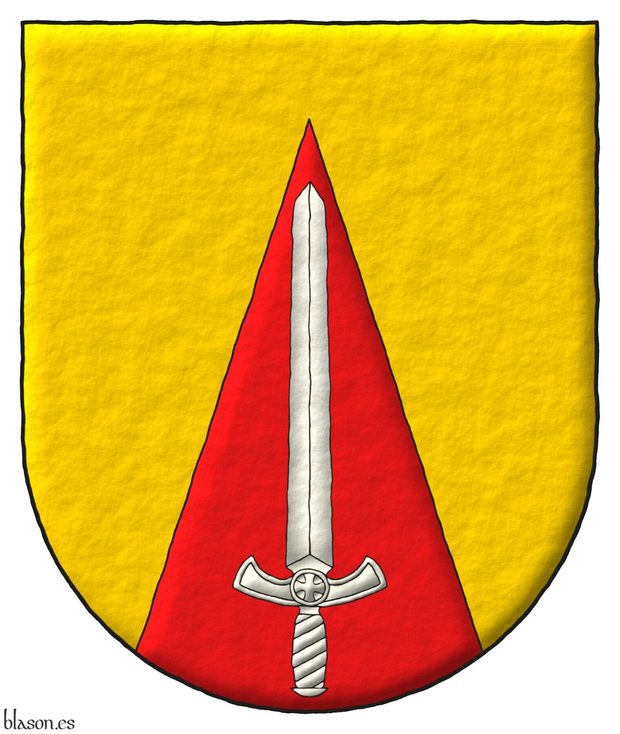
Or, on a pile issuant from the base Gules a sword point upwards Argent.
Escudo de oro, una pira de gules cargada de una espada alzada de plata.
Arms emblazoned by me, highlighted with lights and shadows, outlined in Sable, with a semi-circular outer contour and with a freehand finishing.
Coat of arms of the lineage Burr emblazoned by me based on the description by [Cadenas y Vicent, V. de; 1987; page 388].
Blazon keywords: Or, Gules, Argent, One, Pile issuant from base, Charged, Sword and Point upwards.
Style keywords: Outlined in sable, Illuminated, Semi-circular and Freehand.
Classification: Personal, Lineage, Interpreted, Boa and Coat of arms.
Bearer: Burr, lineage.


Carlos Vidriales, certification, pages 3 and 6
Arms of Carlos Vidriales García Bustamante painted by me in the Certification of the King of Arms of Castile and Leon Alfonso de Ceballos-Escalera and Gila, Marquess of La Floresta, Viscount of Ayala and grand of Spain. The image shows the pages 3 and 6 of this certification.
Credits: Alfonso de Ceballos-Escalera y Gila is the author of the certification of arms and Antonio Salmerón y Cabañas is the author of the heraldic art for the certified coat of arms.
Categories: Certification, Heraldic document, Coat of arms, Interpreted, Personal, Semi-circular, Illuminated, Outlined in sable, Party per pale, Argent, Cross, Sable, Bordure, Motto, Or, Thirteen, Hurt, Hurt, torteau, pellet, pomme and golpe, Azure, Three, In pale, Four, Five, Chief, Fleur de lis, Lineage, Conjoined in fess, Decoration, Suspended and Base (lower 1/3).
Root: Vidriales García y Bustamante, Carlos.


Castile and León
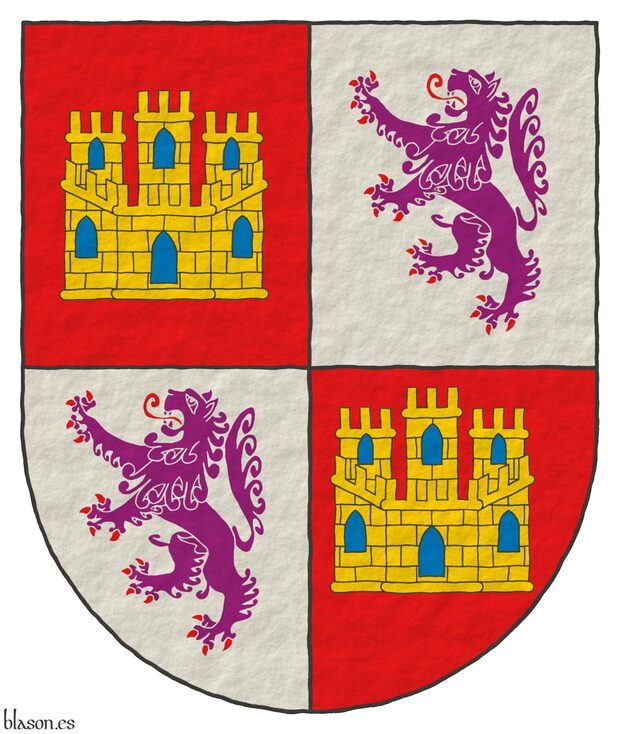
Quarterly: 1 and 4 Gules, a castle triple towered Or, port and windows Azure, masoned Sable; 2 and 3 Argent, a lion rampant Purpure, armed and langued Gules, crowned Or.
Escudo cuartelado: 1o y 4o de gules, un castillo de oro, aclarado de azur, mazonado de sable; 2o y 3o de plata, un león rampante de púrpura, armado y lampasado de gules, coronado de oro.
This coat of arms can be seen in [Bergshammars; 1440; page 2], in [Lutzelbourg, N. de; 1530; page 35] and in [Tewkesbury; 17th century; folio 25v].
Blazon keywords: Quarterly, Gules, Or, Azure, Sable, One, Castle, Port and windows, Masoned, Argent, Purpure, Lion, Rampant, Armed, Langued and Crowned.
Style keywords: Semi-circular and Plain tincture.
Classification: Interpreted, Civic, Coat of arms, Kingdom of Castile and Leon and Canting.
Bearer: Castile and León.


![Ver [Castilian heraldry] en criterios utilizados. Unicornio saltante sobre la divisa, criterio.](../css/Unicornio.Criterio.png)
Castilian heraldry
Key Characteristics in Castilian Heraldry
Some of the main characteristics of the heraldry of Castile are:
- the rounded shapes, with a semicircle at the base,
- the importance of bordures,
- the inclusion of words and also letters in the coat of arms,
- the 2nd most common animal, after the lion, is the wolf [Valero de Bernabé, L.; 2010], and, of course,
- our castle triple-towered Or, port and windows Azure, masoned Sable [Valero de Bernabé, L.; 2009a].
The following image shows 4 examples of coats of arms, each of which has some of these characteristics, including one Castilian castle.
Comparing Castilian and English Heraldry
In the United Kingdom, there are several heraldic traditions, one of them being English heraldry.
In the Kingdom of Spain, there are several heraldic traditions, for example, the Castilian tradition.
In my humble opinion, we should compare at the same level, English heraldry with, for example, Castilian heraldry, but not with all Spanish heraldry. We shouldn't do it for the same reason we don't mix Scottish heraldic tradition with English, as they are so different.
In the case of Castilian heraldry, the 8 main differences with English heraldry are:
- The rounded shapes, with a semicircle at the base.
- The importance of bordures and the existence of the diminished bordure, called in Castilian «filiera».
- The inclusion of words and also letters in the coats of arms.
- The wolf is the 2nd most common animal, after the lion.
- The castle, triple-towered, which is different from the English and French types of castles.
- We can inherit arms from our mother and/or father; for example, the castle in the 1st quarter of the coat of arms of Castile and the coat of arms of Spain comes from a mother, Queen Berenguela of Castile, mother of King Fernando III, the Saint.
- There are 3 kinds of supporters with their owns heraldic names: «tenantes», human forms; «soportes», animals; and «sostenes», plants and things.
- Our quarterings do not necessarily mean that the arms are marshalled by inheritance. [Williams, N.; 2017; page 135, paragraph 26.02] describing the arms of Éamon de Valera, 1882-1975, President of Ireland, writes «Those arms are Spanish in appearance. The quartering without functions as a means of marshalling, is distinctively Iberian».
Categories: Criterion, Semi-circular, Bordure, Letter, Lion, Wolf, Castle, Triple-towered, Port and windows, Masoned, Or, Azure, Sable, Diminished bordure, Quarterly, Supporter (human form), Supporter, Supporter (animal) and Supporter (thing).


Cavalry Regiment Montesa, royal crown
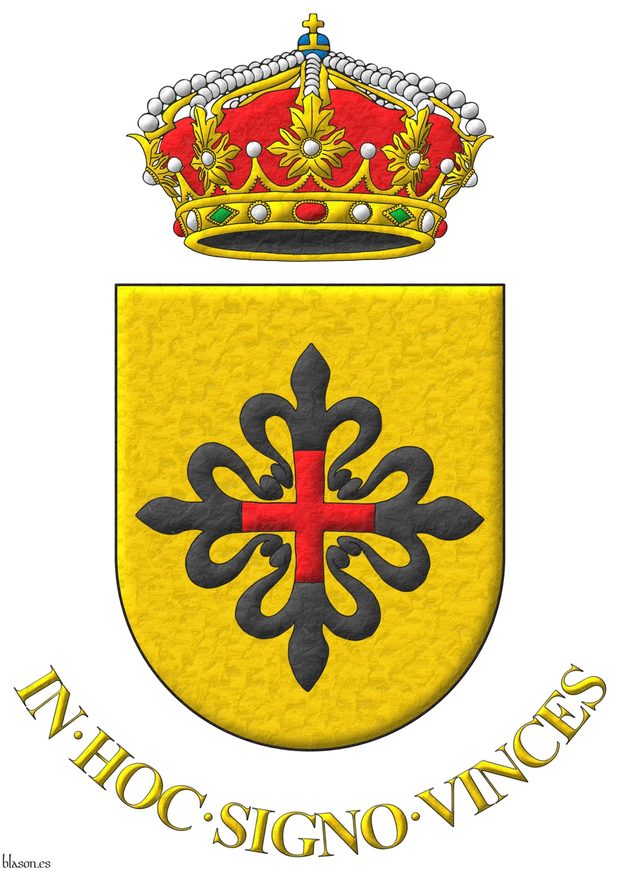
In this sign, you shall conquer.
Argent, a cross of Montesa. Crest: A closed royal crown Or, with eight arches, visible five. Motto: «In hoc signo vinces».
Escudo de oro, una cruz de Montesa. Timbrado de una corona real cerrada. Lema: «In hoc signo vinces».
Coat of arms interpreted as follows: the shape of the shield is a semi-circular arch; the field has been illuminated in metal Or; the cross of Montesa is outlined in Sable and illuminated in Sable and Gules; the royal crown is closed, outlined in Sable and illuminated the metal in Or, the pearls in Argent, the orb in Azure and Or, the gemstones in Gules and Vert, the inner cloth in Gules, and the visible hollow at its base in Sable; and the whole has a slightly beaten metal finish.
Regimental Motto
The Latin motto «In hoc signo vinces» is translated as «In this sign, you shall conquer».
Globus cruciger ~ Orb
It is called orb ~ «globus cruciger», the first in Spanish and the second in Latin, referring to the part of the royal crown, a jewel, or a jewel itself that recreates the shape of the globe topped with a cross.
Blazon keywords: Without divisions, Or, Cross of Montesa, Cross couped, Cross, Crest, Closed royal crown, Crown and Motto.
Style keywords: Semi-circular, Illuminated, Outlined in sable and Soft metal.
Classification: Interpreted, Military, Army and Navy and Coat of arms.
Bearer: Montesa, Cavalry Regiment.


Ceballos of Cantabria, lineage
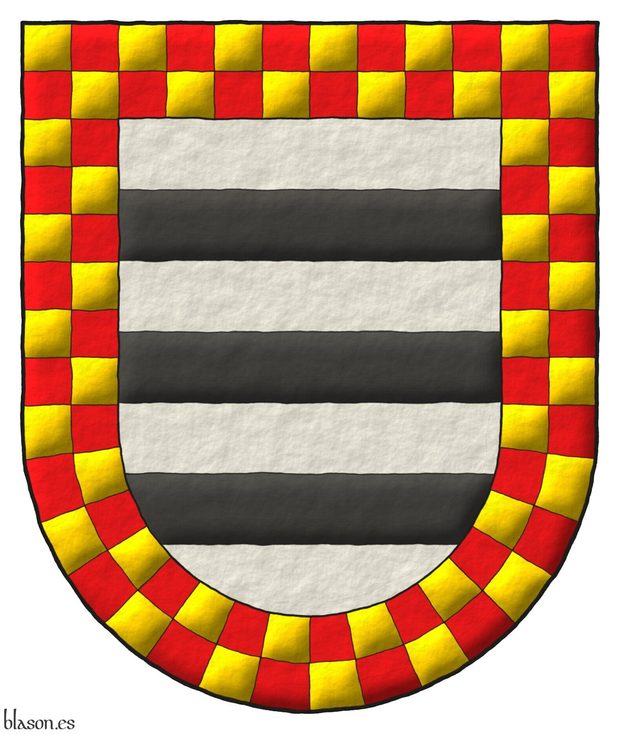
Argent, three bars Sable; within a bordure countercompony Or and Gules. 2 versions for the same blazon.
Escudo de plata, tres fajas de sable; bordura ajedrezada de oro y gules. 2 versiones para el mismo blasón.
Arms depicted by me, illuminated with lights and shadows, contoured in Sable, with a semi-circular external shape and with a freehand finishing.
Ancient arms of the lineage Ceballos of Cantabria emblazoned by me.
Blazon keywords: Argent, Sable, Or, Gules, Three, Bar, Bordure and Chequey.
Style keywords: Outlined in sable, Illuminated, Semi-circular and Freehand.
Classification: Personal, Interpreted, Boa and Coat of arms.
Bearer: Ceballos of Cantabria, lineage.


Central Military Region with motto
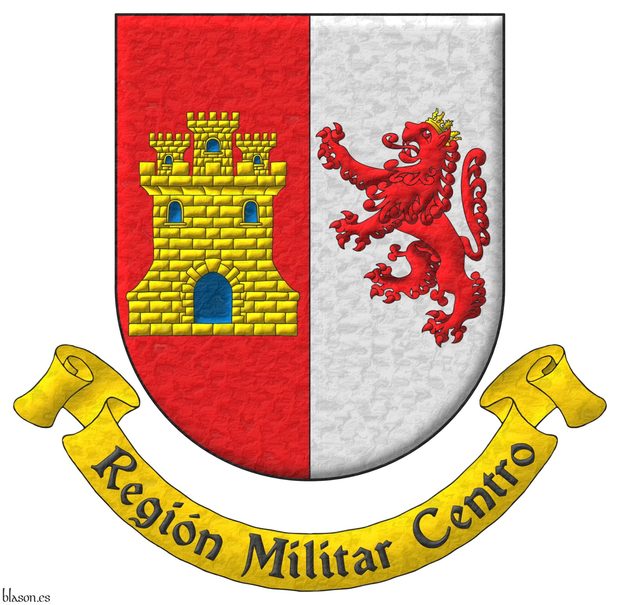
Party per pale: 1 Gules, a castle triple-towered Or, port and windows Azure, and masoned Sable; 2 Argent, a lion rampant Gules, crowned Or. Motto: «Región Militar Centro» over a scroll Or.
Coat of arms (1984-1997 and 1997-2002) of the former Central Military Region, also called 1st Military Region, where I serve. I interpreted and emblazoned now this coat of arms with a semi-circular ended shape.
Blazon keywords: Party per pale, Gules, One, Castle, Or, Port and windows, Azure, Masoned, Sable, Argent, Lion, Rampant, Crowned, Motto (identification) and Scroll.
Style keywords: Semi-circular, Illuminated, Outlined in sable and Metal beaten.
Classification: Interpreted, Military, Army and Navy, Coat of arms and Kingdom of Castile and Leon.
Bearer: Central Military Region.


Cerda, Carlos de la
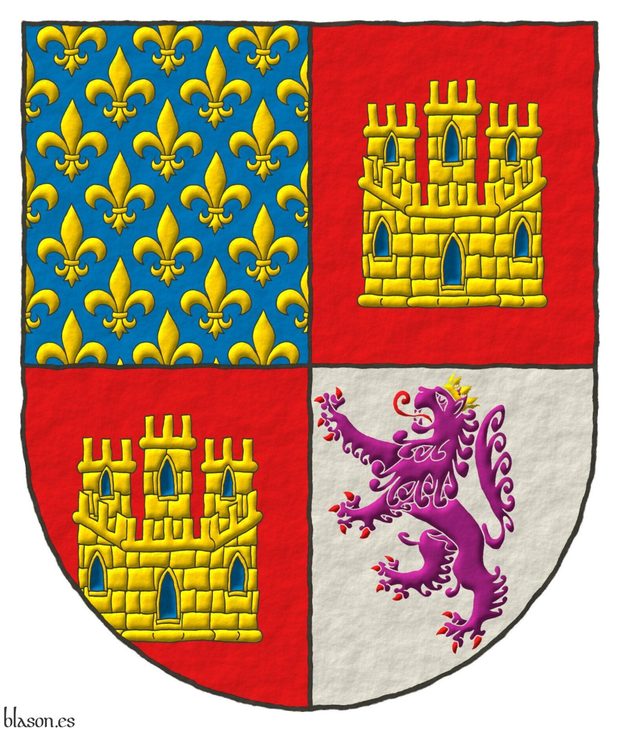
Known in England and France as Charles of Spain ~ Charles d'Espagne.
Quarterly: 1 Azure semé of fleurs de lis Or; 2 and 3 Gules, a castle triple towered Or, the port and windows Azure, masoned Sable; 4 Argent, a lion rampant Purpure, armed and langued Gules, crowned Or.
Coat of arms of Charles de la Cerda (1326-1354), this coat of arms also could be blazoned as «Quarterly: 1, Francia; 2 and 3, Castile; 4, Leon.».
Blazon keywords: Quarterly, Azure, Semé, Fleur de lis, Or, Gules, Castle, Port and windows, Masoned, Sable, Argent, Lion, Purpure, Rampant, Armed, Langued, Crown and Crowned.
Style keywords: Semi-circular, Illuminated, Outlined in sable and Freehand.
Classification: Interpreted, Personal, Army and Navy and Kingdom of France.
Bearer: Cerda, Carlos de la.


Charles Dunne, Chas
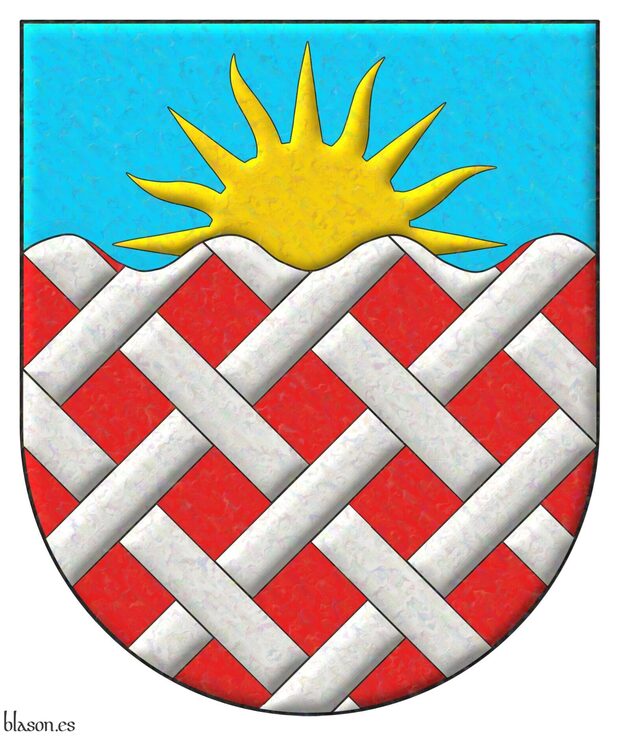
Motto: Stand and Be Counted
Gules fretty Argent; on a chief wavy Bleu celeste, a rising sun Or.
Escudo de gules fretado de plata; en un jefe ondado de celeste, un sol saliente de oro.
Coat of arms interpreted and emblazoned by me with with a semi-circular ended shape, illuminated, and with a iridescent finishing.
The sun used to be emblazoned with a human face, with its eyes, mouth, and nose, but in all the interpretations that I know of this blazon, the sun appears without a human face.
Schema for the fretty
Blazon keywords: Without divisions, Gules, Fretty, Argent, One, Chief, Wavy, Bleu celeste, Sun, Issuant and Or.
Style keywords: Iridescent, Outlined in sable, Illuminated and Semi-circular.
Classification: Interpreted.
Bearer: Charles Dunne, Chas.


Charles VII of France
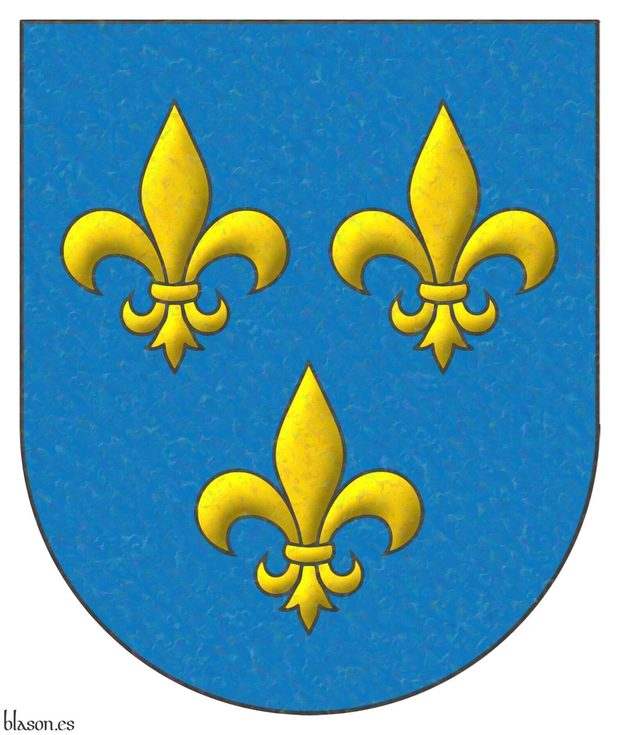
King of France from 1429 to 1461.
Azure, three fleurs de lis Or.
Escudo de azur, tres flores de lis de oro.
Coat of arms interpreted with: a semicircular (round) base; the field enamelled in flat Azure; the fleurs-de-lis illuminated in Or and outlined in Sable; and finished with a mother-of-pearl effect.
This coat of arms is based on the one appearing in the armorial [Ingeram, H.; 1459; page 34, 1st shield], under the inscription «küng von franckrich» (franckrich ~ Frankreich ~ France).
Blazon keywords: Without divisions, Azure, Or, Three, Fleur de lis and Ordered.
Style keywords: Semi-circular, Illuminated, Outlined in sable and Iridescent.
Classification: Interpreted, Personal, Coat of arms, Kingdom of France and House of Valois.
Bearer: Charles VII of France.


Ciudad de Ceuta
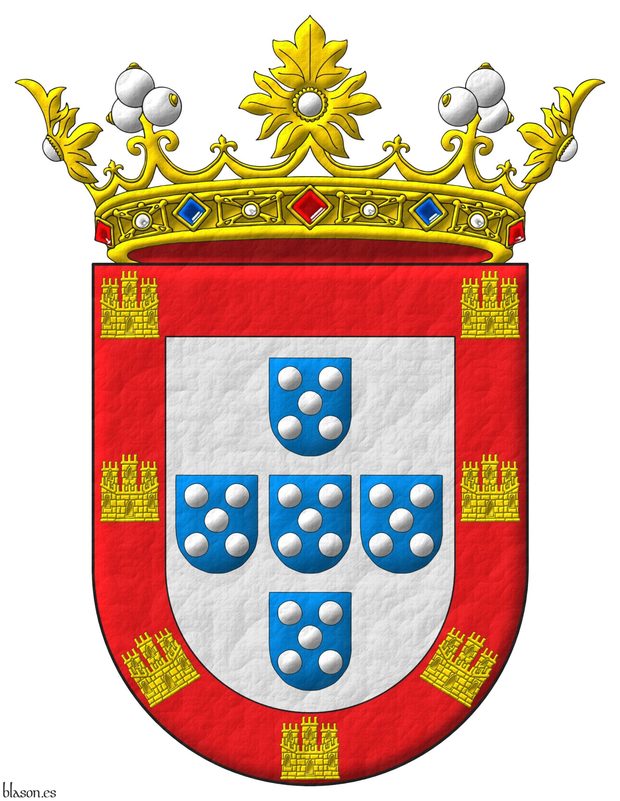
City of Ceuta, Spain, Africa, with a crown of Marquis
Argent, five escutcheons in cross Azure, each charged with five plates in saltire; a bordure Gules, charged with seven castles triple-towered Or, 2, 2, 2, and 1. Crest: A crown of Marquis.
Escudo de plata, cinco escudetes en cruz de azur, cada uno cargado de cinco bezantes en sotuer de plata; una bordura de gules, cargada de siete castillos de oro, dos en jefe, una en cada flanco y tres en punta. Timbrado de una corona de marqués
Illuminated and a leather finishing.
Coat of arms of Ceuta from the coat of arms of Portugal
The Portuguese conquered Ceuta in the year 1415. This event represents an important step in the development of the Portuguese Empire in Africa. Then Ceuta received its arms from those of Portugal but with the castles in another order. In the image, the 1st coat of arms of Portugal, and the 2nd coat of arms of Ceuta.
Blazon keywords: Without divisions, Argent, Five, Escutcheon, In cross, Azure, Charged, Bezant and plate, Plate, In saltire, Bordure, Gules, Seven, Castle, Or, Two, In chief, One, In each flank, Three, In base, Crown of Marquis and Crown.
Style keywords: Leather, Outlined in sable, Illuminated and Semi-circular.
Classification: Civic, Interpreted and Kingdom of Spain.
Bearer: Ceuta.


Classic chevron
Delineation, ratios and angles of a classic chevron.
Blazon keywords: Without divisions and Chevron.
Style keywords: Semi-circular.
Classification: Schema.
Bearer: Adan de Creeting.


Clement XII
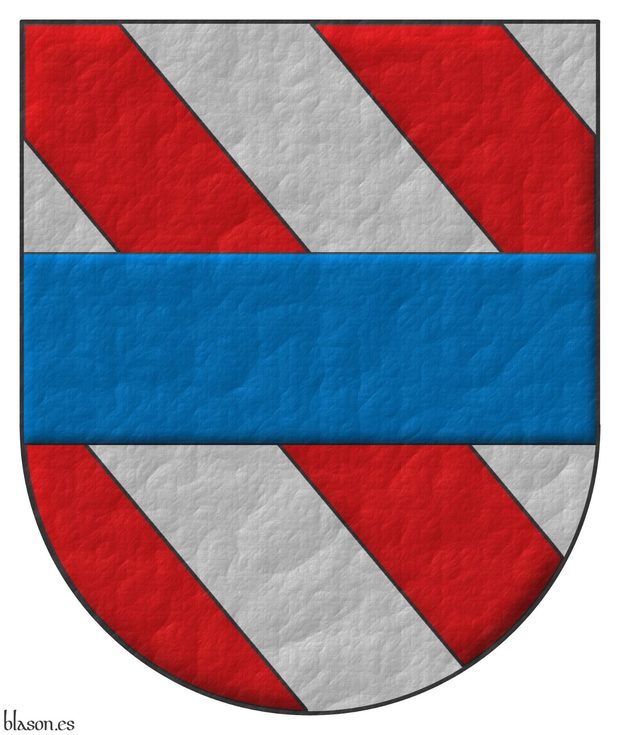
246th Pope of the Church, from 1730 to 1740. «Clemens XII», named Lorenzo Corsini, born in Florence and rests in St. John Lateran.
Bendy of six Gules and Argent; over all a fess Azure.
Escudo bandado de seis piezas de gules y plata; brochante sobre el todo una faja de azur.
Papal coat of arms interpreted with: a rounded mouth; the field in flat tincture of Argent; the fess and the bands outlined in Sable and illuminated in Gules and Azure; and the whole with a textured finish.
All are ordinaries, including the three bands and the fess, and since the blazon specifies that the fess is overall on the bands, therefore, it is not the Gules bands that are overall on the Azure fess, and they should be painted underneath.
Blazon keywords: Without divisions, Bendy, Six, Gules, Argent, Surmounted, Overall (deprecated), One, Fess and Azure.
Style keywords: Semi-circular, Illuminated, Outlined in sable and Freehand.
Classification: Interpreted, Religious and Papal States.
Bearer: Clement XII.


Clermont, Robert of
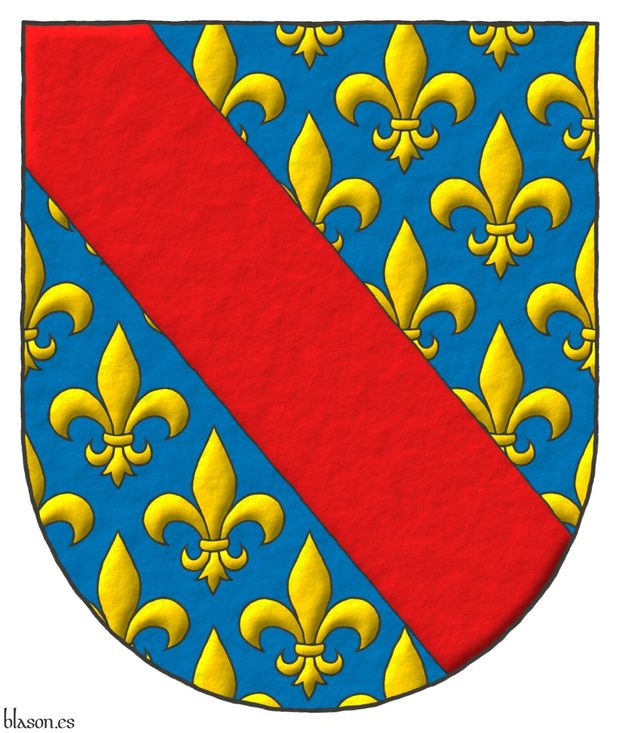
Grandson of Blanche of Castile, 6th son of Saint Louis IX, founder of the House of Bourbon, husband of Beatrice of Burgundy, Lady of Bourbon.
Azure semé of fleurs de lis Or, a bend Gules.
Escudo de Azur sembrado de flores de lis de oro, banda gules.
Coat of arms that I have interpreted with:: a semicircular (round) base; the field enamelled in flat Azure; the fleurs-de-lys illuminated in Or; the bend illuminated in Gules; the whole is outlined in Sable; and the freehand drawing.
Blazon keywords: Without divisions, Azure, Or, Semé, Fleur de lis, Bend and Gules.
Style keywords: Semi-circular, Illuminated, Outlined in sable and Freehand.
Classification: Interpreted, Personal, Coat of arms, Kingdom of France and House of Bourbon.
Bearer: Clermont, Robert of.


Coat of arms of Del Fabbro Universidad on the walls (190 × 160 cm)
Azure, flanched Argent: in chief, an open book Argent, garnished Or; in base, an oak eradicated Argent, fructed Or; in each flank, a torch Vert, enflamed proper. Motto above the arms: «Del Fabbro Universidad» Gules.
Coat of arms of Del Fabbro Universidad designed and emblazoned by me. It has now been faithfully executed and placed on the walls of its century-old building (190 × 160 cm), reproducing with precision the original design as I painted it.
Blazon keywords: Azure, Argent, Or, Vert, One, Two, Flanched, In chief, Open book, Book, Garnished, In base, Oak, Tree, Eradicated, Fructed, In each flank, Torch, Enflamed, Proper, Motto (identification) and Above the shield.
Style keywords: Outlined in sable, Illuminated and Semi-circular.
Classification: Socioeconomic, Created, Boa, Collage and Photographic.
Bearer: Del Fabbro Universidad.


Coat of arms of Elijah Reyes
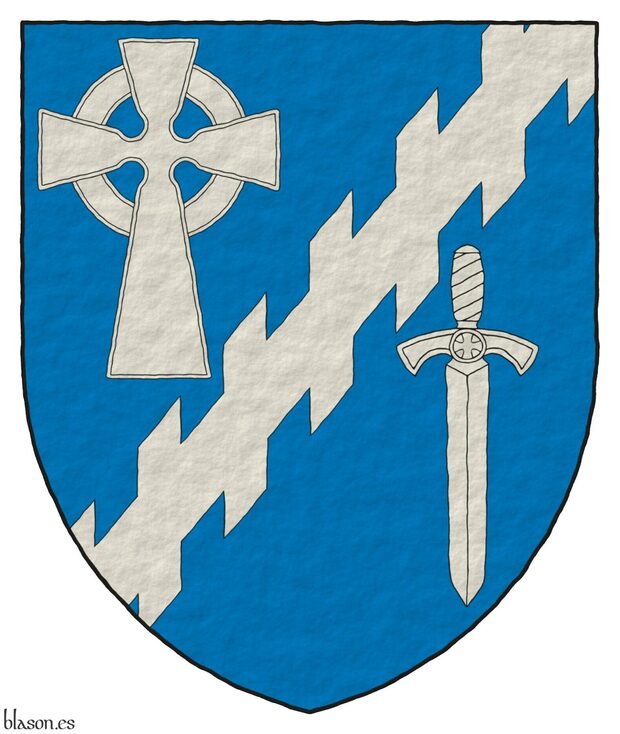
Azure, a bend sinister raguly between, in dexter chief, a Celtic cross, in sinister base, a sword point downwards Argent.
Escudo de azur, una barra ecotada acompañada, en la diestra del jefe, de una cruz celta y, en la siniestra de la punta, de una espada bajada todo de plata.
Blazon keywords: One, Bend sinister, Raguly, Between, Dexter, Chief, Celtic cross, Sinister, Base (lower 1/3), Sword, Point downwards and Argent.
Style keywords: Outlined in sable, Semi-circular and Plain tincture.
Classification: Personal, Interpreted and Coat of arms.
Bearer: Reyes, Elijah.


Coat of arms of Noelia Yñigo-Genio
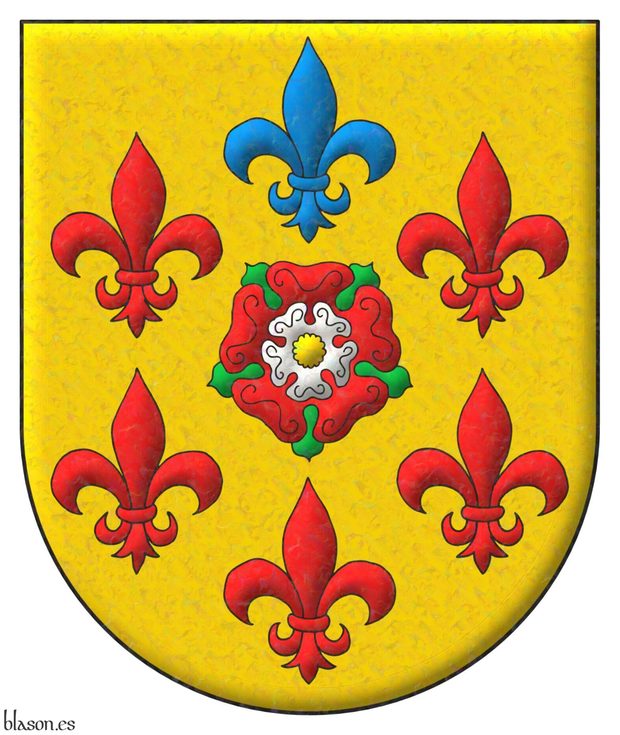
Or, a double rose Gules and Argent, barbed Vert, and seeded Or within six fleurs de lis in orle, five Gules and one in chief Azure.
Escudo de oro, una rosa doble de gules y plata, barbada de sinople y botonada de oro, rodeada de seis flores de lis en orla, cinco de gules y una de azur en jefe.
Credits: Rolando Yñigo-Genio is the designer of the coat of arms and Antonio Salmerón y Cabañas is the author of the heraldic art.
Blazon keywords: Or, Double rose, Gules, Argent, Barbed, Vert, Seeded, Six, Fleur de lis, Orle, Five, One, Azure and In chief.
Style keywords: Semi-circular, Iridescent, Outlined in sable and Illuminated.
Classification: Interpreted, Personal and Coat of arms.
Bearer: Yñigo-Genio, Noelia.


Coat of arms of Oratorio de San Felipe Neri
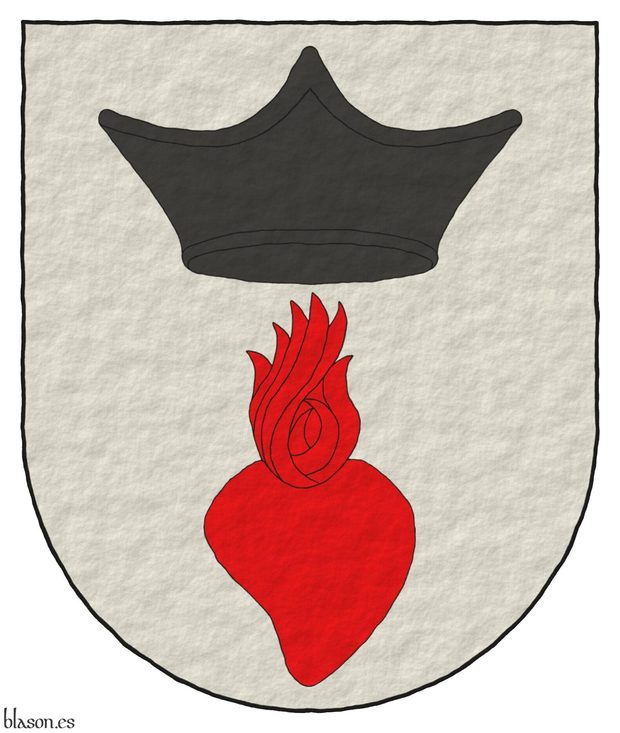
Argent, in chief an ecclesiastical cap Sable, in base a heart enflamed gules.
Escudo de plata, en jefe un bonete eclesiástico de sable, en punta un corazón llameante de gules.
Blazon keywords: Argent, In chief, One, Ecclesiastical cap, Sable, In base, Heart enflamed, Heart, Enflamed and Gules.
Style keywords: Outlined in sable, Semi-circular and Plain tincture.
Classification: Religious, Created and Coat of arms.
Bearer: Congregación del Oratorio de San Felipe Neri de Alcalá de Henares.


Craon, Robert de
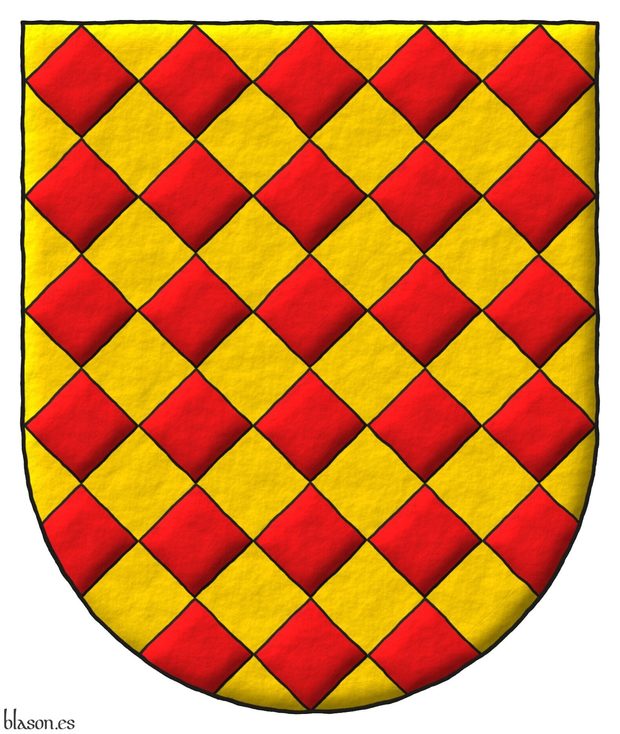
Lozengy Or and Gules.
Escudo losanjado oro y gules.
Coat of arms emblazoned by me with a semi-circular shape, illuminated, and with a freehand finishing.
Blazon keywords: Lozengy, Or and Gules.
Style keywords: Outlined in sable, Illuminated, Semi-circular and Freehand.
Classification: Religious, Military, Knights Templar, Interpreted and Coat of arms.
Bearer: Craon, Robert de.


Crest and mantling of the Ormazabal Lazaro family Ormazabal-Lazaro
Party per pale: 1 Sable, a tower with a turret Argent; 2 Argent, a wyvern erect Sable. Crest: Upon a helm with a wreath Argent and Sable, five ostrich feathers alternately Sable shafted Argent, and Argent shafted Sable. Mantling: Sable doubled Argent.
Arms devised by me, highlighted with lights and shadows, contoured in Sable, with a semi-circular external shape and with a leather finishing.
The crest, mantling and coat of arms of the Ormazabal Lazaro family, designed by them and me, and emblazoned by me.
Blazon keywords: Sable, Argent, One, Party per pale, Tower, With a turret, Wyvern, Erect, Crest and mantling, Crest, Upon (wreath), Helm, Wreath, Ostrich feathers, Alternately, Shafted and Mantling.
Style keywords: Outlined in sable, Illuminated, Semi-circular and Leather.
Classification: Personal, Created, Boa and Coat of arms.
Bearer: Ormazabal-Lazaro, family.


Crest of Antonio Ruiz Porras
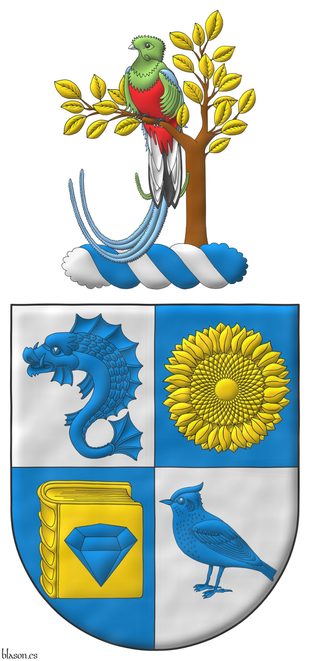
Quarterly: 1 Argent, a dolphin haurient Azure; 2 Azure, a sunflower Or; 3 Azure, on a closed book Or a diamond Azure; 4 Argent, a lark Azure. Crest: Upon a wreath Argent and Azure a quetzal perched in tree branch proper, leaved Or.
Coat of arms interpreted by me, illuminated with lights and shadows, contoured in Sable, with a semi-circular external shape and with a watercolor finishing.
Blazon keywords: Argent, Azure, Or, One, Quarterly, Dolphin, Haurient, Sunflower, Closed book, Book, Charged, Diamond, Lark, Crest, Upon (wreath), Wreath, Quetzal, Perched, Tree, Branch, Proper and Leaved.
Style keywords: Outlined in sable, Illuminated, Semi-circular and Watercolor.
Classification: Personal, Interpreted, Boa and Coat of arms.
Bearer: Ruiz Porras, Antonio.


Crest of Javier Francisco Javier Lasuncion Patus
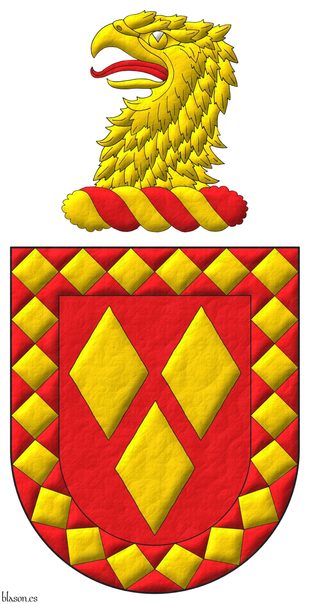
Gules, three lozenges Or; a bordure lozengy Gules and Or. Crest: Upon a wreath Or and Gules, an eagle’s head erased Or, langued Gules.
Arms devised by me, highlighted with lights and shadows, outlined in Sable, with a semi-circular external shape and with a leather finishing.
Blazon keywords: Gules, Or, One, Three, Lozenge, Lozengy, Bordure, Crest, Upon (wreath), Wreath, Eagle, Head, Erased and Langued.
Style keywords: Outlined in sable, Illuminated, Semi-circular and Leather.
Classification: Personal, Created, Boa and Coat of arms.
Bearer: Lasuncion Patus, Francisco Javier.


Crest, mantling and motto of Jesus Angueira Duro
Per pale Vert and Azure, overall a sword fesswise Argent, hilted Or, between in chief a Galician granary Or, and in base an escallop Argent between two oak leaves in pile Or. Crest: Upon a helm, with a wreath Or, Vert, and Azure a falcon rising Or, langued Gules. Mantling: dexter Azure doubled Or, sinister Vert doubled Or. Motto: «Nolite Conformari Huic Saeculo» Sable, with initial letters Gules, over a scroll Argent.
Arms designed by me, illuminated with lights and shadows, outlined in Sable, with a semi-circular external shape and with a leather finish.
Design rationale
Per pale Vert and Azure represents the fields of Galicia facing the sea, with its «horreo» ~ granary and the oak leaves as symbols of Galician nature and of the values of strength and nobility of the bearer. The escallop symbolises the Holy Catholic Faith and traditional and conservative values. The sword represents Justice and the bearer’s studies in Law, as well as strength and worth. The bearer’s motto, «Nolite conformari huic saeculo» ~ «Be not conformed to this world», taken from the Epistle of the Apostle Saint Paul to the Romans, chapter 12, verse 2, expresses his personal view of life. The falcon that surmounts the helm as a crest represents sharpness and vigilance.
Blazon keywords: Vert, Azure, Or, Argent, One, Two, Party per pale, Overall, Sword, Fesswise, Hilted, Between, In chief, Galician granary, In base, Escallop, Oak, Tree, Leaf, In pile, Crest and mantling, Crest, Upon (wreath), Helm, Wreath, Falcon, Rising, Langued, Mantling, Dexter, Doubled, Sinister, Motto and Scroll.
Style keywords: Outlined in sable, Illuminated, Semi-circular and Leather.
Classification: Personal, Created, Design rationale, Boa and Coat of arms.
Bearer: Angueira Duro, Jesus.


Crest, mantling and motto of Luis Gerardo Oyervides Ochoa
Sable, a kapok tree eradicated and fructed between in base two lozenges Argent. Crest: Upon a helm with a wreath Argent and Sable, a dove grasping in its beak a mullet Argent. Mantling: Sable doubled Argent. Motto: «Antequam Glorificetur Humiliatur» Sable, with initial letters Gules, over a scroll Argent.
Coat of arms devised by me, highlighted with lights and shadows, outlined in Sable, with a semi-circular outer contour and with a rough finish.
Blazon keywords: Sable, Argent, One, Two, Kapok tree, Tree, Eradicated, Fructed, Between, In base, Lozenge, Crest and mantling, Crest, Upon (wreath), Helm, Wreath, Dove, Grasping, Beak, Mullet, Mantling, Motto and Scroll.
Style keywords: Outlined in sable, Illuminated, Semi-circular and Rough.
Classification: Personal, Created, Boa and Coat of arms.
Bearer: Oyervides Ochoa, Luis Gerardo.


Crest, mantling and motto of Maximilian Silvestri
Argent, a demi-savage issuant from the base Carnation, crined, bearded and vested Tenné, wreathed of leaves Vert, holding in his dexter a close book, bookmarked Gules, garnished, on its cover a mortar with pestle Or, in his sinister an oak club Tenné, leaved and fructed Vert; a chief wavy Gules. Crest: Upon a helm lined Gules with a wreath Argent and Gules, an oak couped Tenné, leaved and fructed Vert, its trunk charged with a mullet Argent. Mantling: Gules doubled Argent. Motto: «Forza · Onore · Saggezza» Gules, over a scroll Argent doubled Gules.
Arms interpreted by me, illuminated with lights and shadows, outlined in Sable, with a semi-circular outer contour and with a leather finish.
The coat of arms of Maximilian Silvestri emblazoned by me. In Castilian, I prefer to use the term «almirez» instead of «mortero», as the latter can also refer to a weapon or even a type of cap in heraldic terminology. The word «almirez» has a unique meaning and comes from the Hispano-Arabic «almihrás» or «almihráz», which derives from Classical Arabic «mihras».
Blazon keywords: Argent, Or, Gules, One, Demi, Savage, Carnation, Issuant, Base, Crined, Bearded, Vested, Tenné, Wreathed, Leaf, Grasping, Dexter, Closed book, Book, Bookmark, Garnished, Mortar, Pestle, Club, Leaved, Fructed, Chief, Wavy, Crest, Upon (wreath), Helm, Lined, Wreath, Mantling, Doubled, Oak, Tree, Charged, Trunk, Mullet, Motto and Scroll.
Style keywords: Outlined in sable, Illuminated, Semi-circular and Leather.
Classification: Personal, Interpreted, Boa and Coat of arms.
Bearer: Silvestri, Maximilian.


Crest, mantling and motto of Reynaldo Romero
Azure, two arrows points upwards in saltire between, in chief a crescent Or, in base an open book Argent, garnished Or, the pages inscribed «Domus Virtus Felicitas» Sable. Crest: Upon a helm with a wreath Or and Azure, a bald eagle rising, wings addorsed and inverted proper. Mantling: Azure doubled Or. Motto: «Liberty Thru Industry».
Arms interpreted by me, highlighted with lights and shadows, contoured in Sable, with a semi-circular outer contour and with a leather finishing.
Blazon keywords: Azure, Or, Argent, Sable, One, Two, Arrow, Point upwards, In saltire, Between, In chief, Crescent, In base, Open book, Book, Page, Inscribed, Crest and mantling, Crest, Upon (wreath), Helm, Wreath, Bald eagle, Eagle, Rising, Wing, Addorsed, Proper, Mantling and Motto.
Style keywords: Outlined in sable, Illuminated, Semi-circular and Leather.
Classification: Personal, Interpreted, Boa and Coat of arms.
Bearer: Romero, Reynaldo.


Crest, mantling and motto of the family of Rui J. Vaz
Party per pale Azure and Gules, overall a lion rampant Argent, winged Or, grasping in his dexter forepaw a sword erect Or. Crest: Upon a helm lined Gules, its bevor charged with a Latin cross patty and pierced with a Latin cross, and with a wreath Argent and Gules, a dexter winged forepaw Or, grasping an escutcheon quarterly: 1 Azure, a god Garuda sejant Argent; 2 Gules, a castle triple-towered Or, masoned Sable; 3 Argent, six pallets Gules; 4 Azure, five plates. Mantling: Gules doubled Argent. Motto: «Audacia,Veritas et Libertas».
Arms interpreted by me, in plain tinctures, contoured in Sable, displayed as rotated shield, with a semi-circular outer contour and with a leather finish.
Blazon keywords: Azure, Gules, Argent, Or, One, Six, Five, Party per pale, Overall, Lion, Rampant, Winged, Grasping, Dexter, Forepaw, Sword, Erect, Crest and mantling, Crest, Upon (wreath), Helm, Lined, Bevor, Charged, Latin cross patty, Pierced, Latin cross, Wreath, Escutcheon, Quarterly, Garuda, Sejant, Castle, Triple-towered, Masoned, Pallet, Plate, Mantling, Doubled, Motto and Scroll.
Style keywords: Tilted shield, Outlined in sable, Plain tincture, Semi-circular and Leather.
Classification: Personal, Interpreted, Boa and Coat of arms.
Bearer: Vaz, Rui J..


Crown of Crepsi
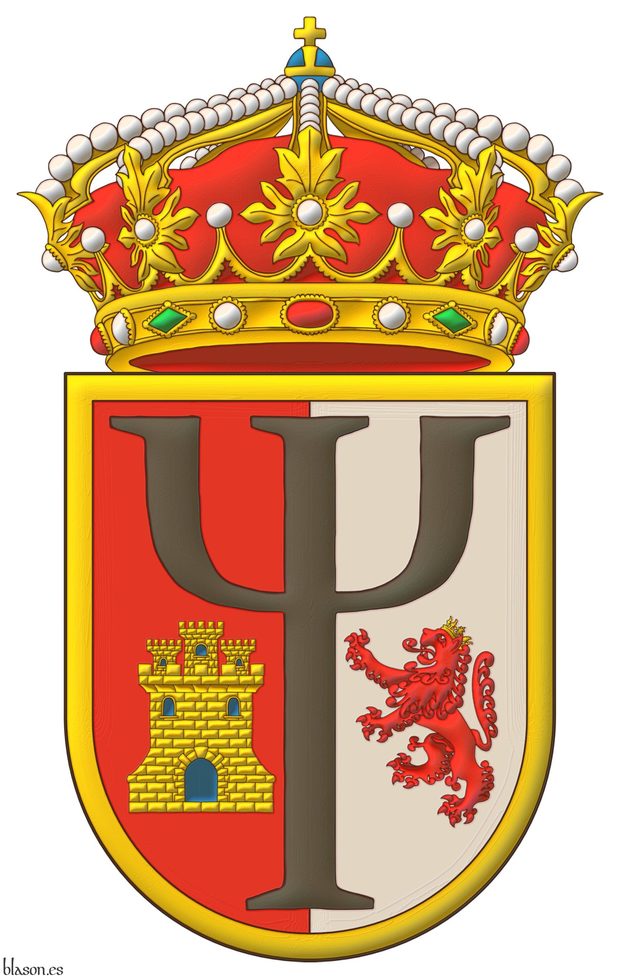
Party per pale: 1 Gules, in base a castle triple-towered Or, port and windows Azure, and masoned Sable; 2 Argent, in base a lion rampant Gules, crowned Or; overall a psi letter sable; a diminished bordure Or. Crest: A closed royal crown.
Coat of arms emblazoned by me, illuminated with lights and shadows, outlined in Sable, with a semi-circular external shape and with a texturized finishing.
Coat of arms of Crepsi, designed by my lieutenant colonel and friend Miguel Angel Nuñez Amador and emblazoned by me.
Blazon keywords: Gules, Argent, Or, Azure, Sable, Party per pale, In base, Castle, Triple-towered, Port and windows, Masoned, Lion, Rampant, Crowned, Overall, Letter, Diminished bordure, Closed royal crown and Crown.
Style keywords: Outlined in sable, Illuminated and Semi-circular.
Classification: Military, Interpreted, Boa and Coat of arms.
Bearer: Crepsi.


Crown of Her Royal Highness Doña Leonor Princess of Asturias
![Crown of Her Royal Highness Doña Leonor Princess of Asturias Quarterly: 1 Gules, a castle triple-towered Or, port and windows Azure, masoned Sable [for Castile]; 2 Argent, a lion rampant Purpure, armed and langued Gules, crowned Or [for Leon]; 3 Or, four pallets Gules [for Aragon]; 4 Gules, a chain orlewise, crosswise, and saltirewise Or, charged in the fess point with an emerald Vert [for Navarre]; enté en point Argent, a pomegranate proper, seeded Gules, slipped and leaved Vert [for Granada]; an inescutcheon Azure, three fleurs de lis Or, 2 and 1, a bordure Gules [for Bourbon]; and the whole debruised by a label of three points Azure. Crest: A Crown of Prince. The shield is surrounded by the Golden Fleece.](../escudo_armas/LeonorPA.27.Corona.Preciosas.Toison.Irisado.jpg)
Quarterly: 1 Gules, a castle triple-towered Or, port and windows Azure, masoned Sable [for Castile]; 2 Argent, a lion rampant Purpure, armed and langued Gules, crowned Or [for Leon]; 3 Or, four pallets Gules [for Aragon]; 4 Gules, a chain orlewise, crosswise, and saltirewise Or, charged in the fess point with an emerald Vert [for Navarre]; enté en point Argent, a pomegranate proper, seeded Gules, slipped and leaved Vert [for Granada]; an inescutcheon Azure, three fleurs de lis Or, 2 and 1, a bordure Gules [for Bourbon]; and the whole debruised by a label of three points Azure. Crest: A Crown of Prince. The shield is surrounded by the Golden Fleece.
Arms depicted by me, highlighted with lights and shadows, outlined in Sable, with a semi-circular external shape and with a iridescent finish.
This is my interpretation of the coat of arms of Her Royal Highness Doña Leonor Princess of Asturias (as heiress to the Crown of Castile), Princess of Girona (as heiress to the Crown of Aragon), and Princess of Viana (as heiress to the Kingdom of Navarre), with the Collar of the Distinguished Order of the Golden Fleece. Her coat of arms is that of her father, the King, charged with a label Azure and surmounted by the crown of a princess with four pearl diadems, three visible.
Blazon keywords: Gules, Azure, Purpure, Vert, Or, Argent, One, Three, Four, Quarterly, Castle, Triple-towered, Port and windows, Masoned, Lion, Rampant, Crowned, Pallet, Chain, Orlewise, Crosswise, Saltirewise, Charged, In the fess point, Emerald, Enté en point, Pomegranate, Proper, Slipped, Leaved, Inescutcheon, Fleur de lis, Ordered, Bordure, Cadency, Label of three points, Crown of Prince, Crown, Surrounded and Collar.
Style keywords: Outlined in sable, Illuminated, Semi-circular and Iridescent.
Classification: Personal, Kingdom of Spain, Interpreted, Boa and Coat of arms.
Bearer: Leonor Princess of Asturias.


Crown of the city of Almeria
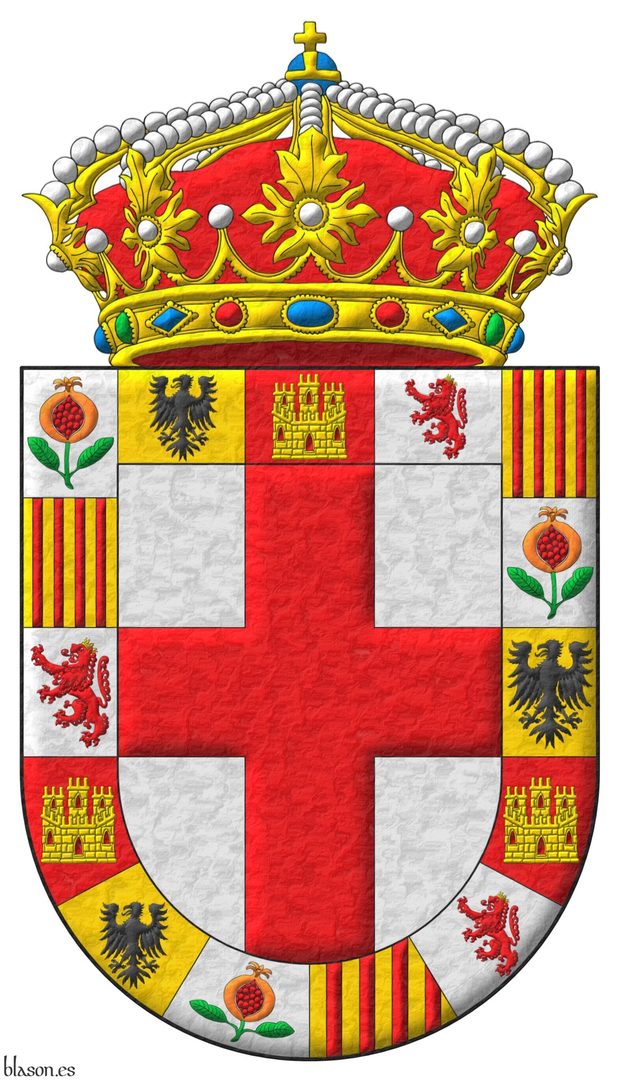
Argent, a cross Gules; a bordure compony of fifteen sections: 1, 6, and 11 Argent, a pomegranate seeded, slipped and leaved proper; 2, 7, and 12 Or, an eagle displayed Sable; 3, 8, and 13 Gules, a castle triple-towered Or, port and windows Gules, masoned Sable; 4, 9, and 14 Argent, a lion rampant Gules, crowned Or; 5, 10, and 15 Or, four pallets Gules. Crest: A closed royal crown.
Arms emblazoned by me, highlighted with lights and shadows, outlined in Sable, with a semi-circular outer contour and with a metal beaten finishing.
Coat of arms of the city of Almeria, Andalusia, emblazoned by me. The island of Alboran is geographically part of Africa, but politically it belongs to the city of Almeria. As a result, Almeria is one of the few cities in the world that spans two continents: Europe and Africa.
Blazon keywords: Argent, Gules, Or, Sable, Vert, One, Four, Fifteen, Cross, Bordure, Compony, Pomegranate, Slipped, Leaved, Proper, Eagle, Castle, Triple-towered, Port and windows, Masoned, Lion, Rampant, Crowned, Pallet, Closed royal crown and Crown.
Style keywords: Outlined in sable, Illuminated, Semi-circular and Metal beaten.
Classification: Civic, Interpreted, Boa and Coat of arms.
Bearer: Almeria, city of.


Dancetty, ratio, points and blazon
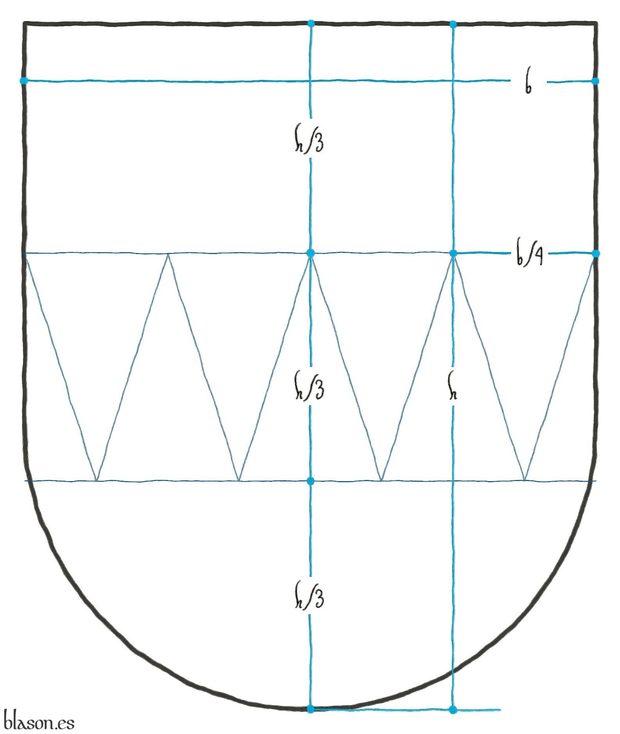
Party per fess Or and Gules dancetty of three full points and two half upwards.
Escudo cortado, encajado de tres piezas enteras y dos medias.
[Avilés, J.; 1780a; page 79], on the appropriate dimensions for outlining an indented shield, he explains that «encaxadas» or «emanchadas» refers to «the partitions of the shield, whose pieces fit into each other in the shape of thick and long triangles, which are regularly one-third of the length», that is, of the width of the shield for parted shields, «or of the height of the shield», that is, the height for fess shields, as in this example, «depending on the direction in which these figures are placed in the parted, fess, bend, and cut shields, etc. but being a Chief, they have half the base and the rest as point; and if it were a Fess, it is formed of alternating triangles, which fill it completely».
[Avilés, J.; 1780a; page 80], on which of the two components of an indented shield acts as the field and which as the piece, he clarifies that «the field of the partition is understood as the one occupying the upper part of the shield, with the lower part at the base considered the piece».
[Avilés, J.; 1780a; page 80], on how the blazon of an indented shield should be drafted, he establishes that «the number of whole and half triangles must be specified when there is more than one, and likewise, the direction in which the partitions are in the parted, fess, etc.», illustrating it with 2 examples that can also be seen in [Avilés, J.; 1725a; plate 8, illustrations 157 and 158].
Blazon keywords: Party per fess, Dancetty, Three and Two.
Style keywords: Semi-circular.
Classification: Schema.


Design with a fess between 4 water-bougets
Design ideas
The heraldic art often involves resolving design challenges while maintaining both aesthetic balance and adherence to tradition. The coat of arms illustrated here draws inspiration from the Dethick-Dethicke family arms of Derbyshire, though it features distinct differences. This design explores the placement of water-bougets, a medieval water vessel, in a 2+2 arrangement, with a fess vair.
One key consideration when arranging charges in heraldry is proportionality. In this case, the fess occupies 1/3 of the coat of arms's width and is positioned 1/3 of the height from the chief, rather than at the exact center, allowing the charges to balance harmoniously. The shape of the shield itself also plays a role: rounded shields can accommodate a 2+2 arrangement more comfortably than shields with a pointed base, which are better suited to 2+1 arrangements, this is de case of Dethick's arms.
Another challenge in heraldic design is asymmetry. To address the natural curves of the shield, the water-bougets may vary slightly in size or placement. This intentional asymmetry can help create a visually appealing composition that respects both tradition and the unique constraints of each design, because, heraldry is not only about rules but also about creativity.
Gules, a fess vair between four water-bougets Or, two in chief and two in base.
Escudo de gules, una faja de veros acompañada de cuatro pares de odres de oro, dos en jefe y dos en punta.
Water-bouget
In German, they are called «Wasserschlauch» in English «water-bougets» or «oges», and in French «bouses» or «chantepleures».
There is no specific heraldic term for them in Castilian. Based on «chantepleures», one could use «cantimploras», which are metallic or at least rigid. On the other hand, «oges» could translate as «odres», as they are typically made of leather as in this case. Additionally, since «water-bouget» are designed as a pair to be carried by a donkey or other animal, I have decided to use «par de odres» to convey the idea of one on each side of the animal.
In English, when there is a single charge, that is, a pair of water vessels, it is written in singular as «water-bouget», as can be seen in [Fox-Davies, A. C.; 1909; figure 551]. [Friar, S.; 1987; page 68] defines «bouget» as «...a stylized representation of a yoke supporting two leather waterbags».
Blazon keywords: Gules, One, Fess, Vair, Between, Four, Water-bouget, Or, Two, In chief and In base.
Style keywords: Ratio, Outlined, Outlined in sable, Illuminated, Semi-circular and Freehand.
Classification: Interpreted, Schema and Coat of arms.


Dubai Office of the European Chamber of Digital Commerce
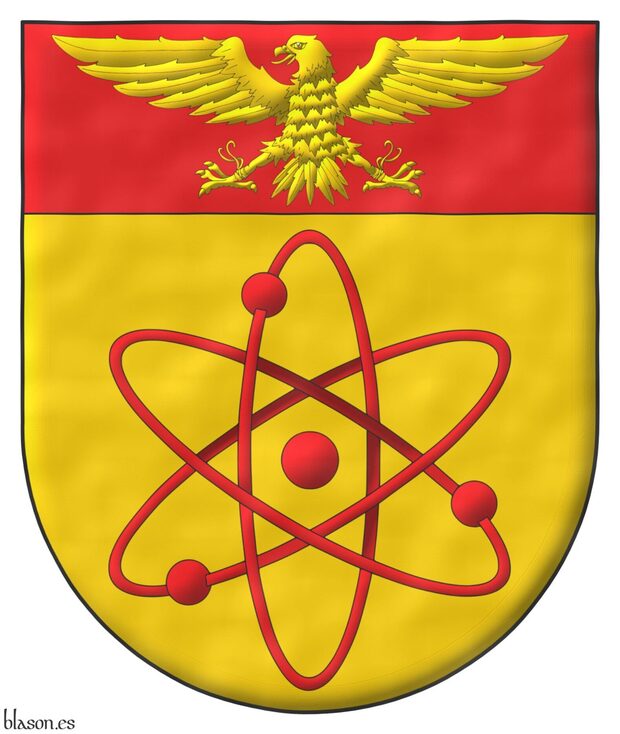
Or, an atom triple-orbited Gules; on a chief Gules, a falcon displayed and jessed Or
Illuminated and a watercolor finishing.
Jessed means with jesses, the thongs by which bells are fastened to the legs of a falcon.
The falcon use to be belled and jessed, with bells and leather strips on the legs. The attributes used to be citted in the blazon when its tincture is different that the main element to which it belongs. In this case, its leather strips are Or, the same tincture than the falcon Or, but I decided to blazoned it «a falcon displayed and jessed Or» to denote jessed but not belled.
Other falcons are also hooded.
Credits: Rudolf Juchter van Bergen Quast is the designer of the coat of arms.
Blazon keywords: Or, One, Atom, Three, Orbital, Gules, Chief, Falcon and Jessed.
Style keywords: Freehand, Outlined in sable, Illuminated and Semi-circular.
Classification: Interpreted, Emirate of Dubai and Coat of arms.
Bearer: Dubai Office of the European Chamber of Digital Commerce.


Duran, lineage of Andalucia, Extremadura, and Aragon
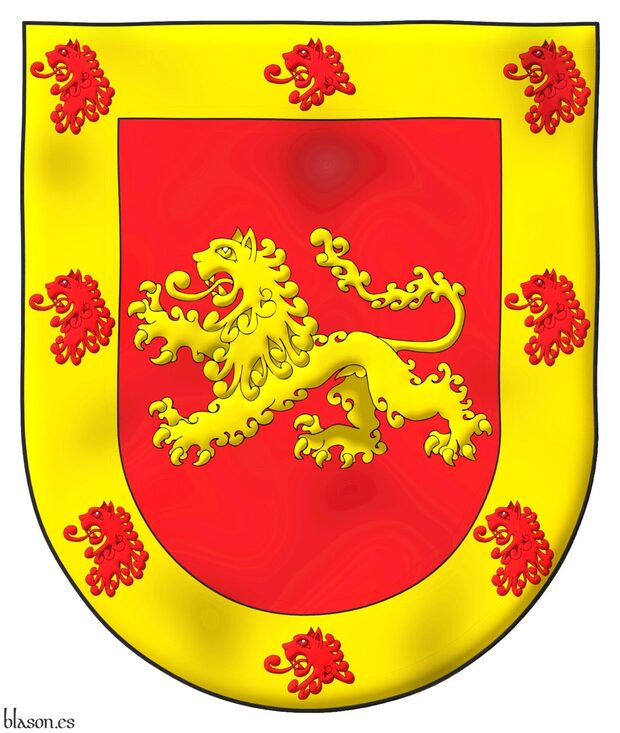
Blazon of the Duran lineage of Andalucia, Extremadura, and Aragon.
Gules, a lion passant Or; a bordure Or charged with eight lions’ heads erased Gules.
Escudo de gules, un león leopardado de oro; una bordura de oro, cargada de ocho cabezas de león arrancadas de gules.
Illuminated and with a glass finish.
Blazon keywords: Gules, Lion passant, Or, One, Bordure, Charged, Eight, Head and Erased.
Style keywords: Glass, Outlined in sable, Illuminated and Semi-circular.
Classification: Interpreted, Lineage and Coat of arms.


Edmund Plantagenet
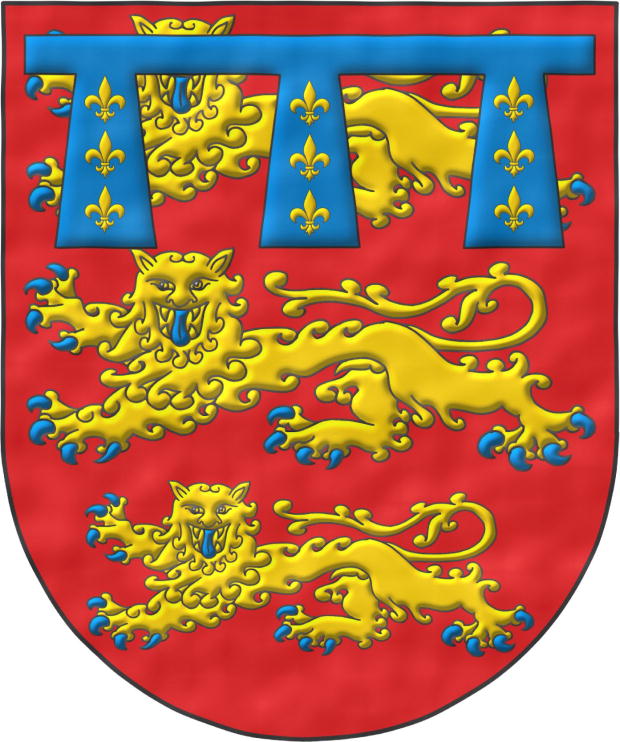
The one with the Cross on his back ~ Crouchback (1245–1296)
Arms of England; overall, a label Azure of three points, each charged with three fleurs-de-lis Or in pale.
Arms interpreted as follows: the mouth of the shield is semicircular (round); the field enamelled in a flat tint of Gules; the label and figures illuminated in Or and Azure and outlined in Sable; and the whole finished with a watercolour effect.
He was the second son of King Henry III of England, and took part in the Ninth Crusade, hence the epithet «Cross on the back».
In 1253 he was appointed Earl of Chester, holding dominion, among others, over the county of Cheshire, but the following year Pope Innocent IV granted him the crown of Sicily, so he ceded his earldom to his elder brother Edward I of England, however, he never came to occupy the throne of Sicily.
The label is an honourable ordinary and also «a kind of mark of cadency, and the most noble of all those used to differentiate the Arms of the younger sons of a House» [Avilés, J.; 1725a; page 248] and it can likewise be used by the eldest son while his father's arms are still in use, ceasing to bear the label when he inherits his father’s coat. When both the eldest and the second son bear a label, the latter’s label then has more points or is charged with figures to distinguish it.
The label is constructed with «a fillet, which is one-ninth of the width of the chief, with three pendants in the form of carpentry wedges or ill-shaped triangles, joined to it without any line of separation, falling twice as far as the fillet is wide, two placed at the ends and one in the middle, its usual position being in the centre of the chief’s length, without reaching the edges of the shield» [Avilés, J.; 1725a; page 248].
Blazon keywords: Without divisions, Gules, Or, Azure, Three, Leopard, Armed, Langued, In pale, Surmounted, Overall (deprecated), Label, Suspended, Charged and Fleur de lis.
Style keywords: Semi-circular, Illuminated, Outlined in sable and Watercolor.
Classification: Interpreted, Personal, Coat of arms, House of Plantagenet and Kingdom of England.
Bearer: Edmund Plantagenet.


Edward I of England
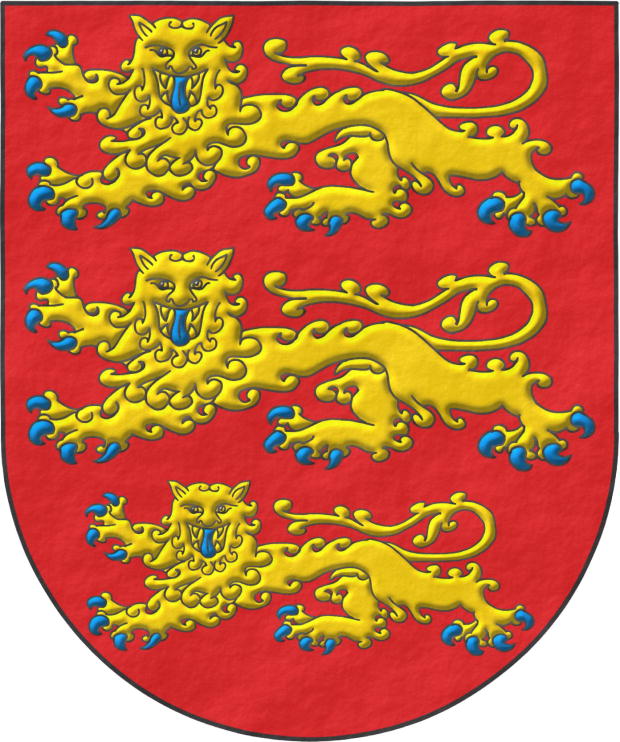
Apodado el Zanquilargo ~ Longshanks.
Gules, three lions, passant, guardant, in pale Or, armed and langued Azure.
Escudo de gules, tres leopardos en palo de oro, armados y lampasados de azur.
Escudo de armas que he interpretado con: la boca de medio punto; el campo esmaltado de tinta plana de color gules; los 3 leopardos iluminados de metal oro, color azur y delineados de sable y el que está en punta es algo menor para adaptarse a la forma del escudo; y el conjunto tiene un acabado rugoso.
Blazon keywords: Without divisions, Gules, Or, Azure, Three, Leopard, Armed, Langued and In pale.
Style keywords: Semi-circular, Illuminated, Outlined in sable and Rough.
Classification: Interpreted, Personal, Coat of arms, House of Plantagenet and Kingdom of England.
Bearer: Edward I of England.


Egado, lineage
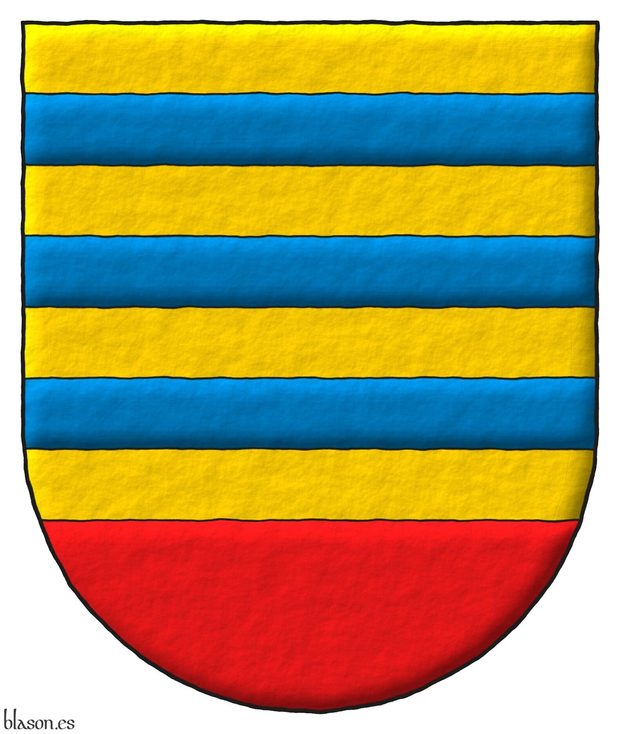
Or, three bars Azure; the base Gules.
Escudo de oro, tres burelas de azur; la punta de gules.
Arms painted by me, illuminated with lights and shadows, contoured in Sable, with a semi-circular outer contour and with a freehand finish.
Coat of arms of the lineage Egado emblazoned by me based on the description by [Cadenas y Vicent, V. de; 1987; page 635].
Blazon keywords: Or, Azure, Gules, Three, Bar and Base (lower 1/3).
Style keywords: Outlined in sable, Illuminated, Semi-circular and Freehand.
Classification: Personal, Lineage, Interpreted, Boa and Coat of arms.
Bearer: Egado, lineage.


Eight-ball
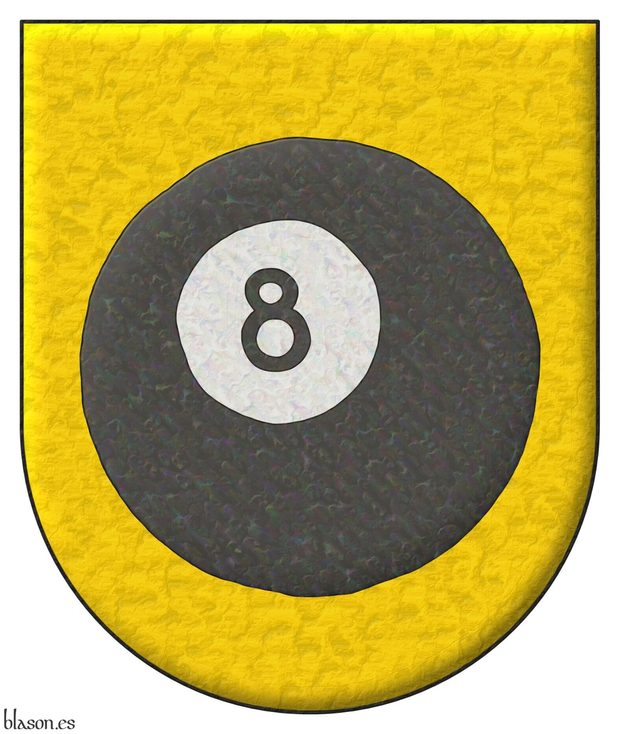
Imaginary coat of arms for the poolgame called Eight-ball.
Or, a Billiard 8 ball proper.
Coat of arms I created with: the shape semicircular at base; the field with a metallic finishing; and the charge with an iridescent finishing.
Blazon keywords: Without divisions, Or, One, Non-classic artifact and Proper.
Style keywords: Semi-circular, Crystalline, Soft metal, Outlined in sable and Illuminated.
Classification: Created, Imaginary and Coat of arms.
Imaginary bearer: Bola 8.


![Ver [Emblem of the Society of Heraldic Arts] en instituciones citadas. Fortaleza de oro y mazonada de sable.](../css/Fortaleza.Institucion.png)
Emblem of the Society of Heraldic Arts
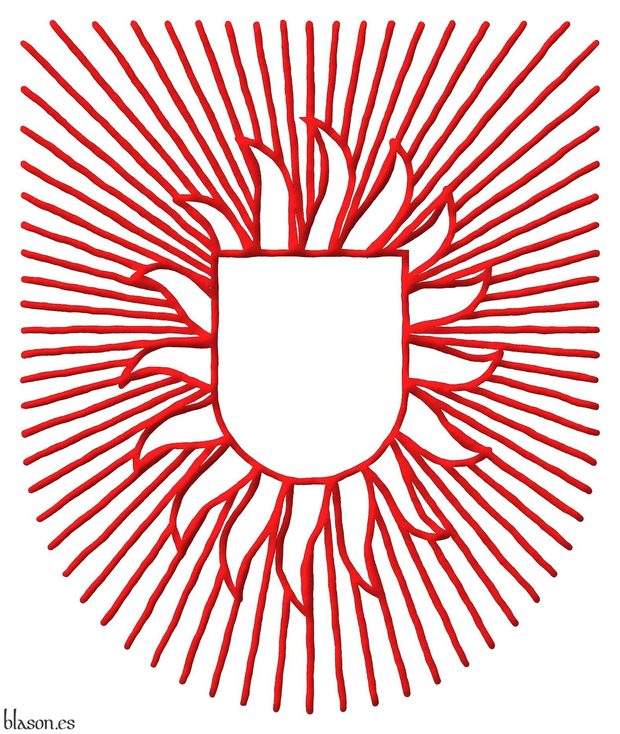
Emblem, an inescutcheon, enflamed in orle of sixteen points and irradiated throughout of sixty-four lines Gules.
Emblema, un escusón, llameante en orla de Dieciséis llamas y radiante de sesenta y cuatro líneas movientes todo de gules.
Its focus on heraldic art, along with its foundation in 1987, makes it a pioneering institution in this field on a global scale.
The Society of Heraldic Arts enjoys significant international recognition among heraldic artists, designers, and craftsmen, and its website is heraldic-arts.com.
Its members cover the full range of activities within heraldry for individuals, personal heraldry, public and private entities, socioeconomic heraldry, as well as municipalities, regions, etc., governance heraldry.
The Society of Heraldic Arts used to publish a quarterly magazine called «The Heraldic Craftsman», which was sent to all its members, but it is no longer in publication. The Society also provides advice on the correct use of heraldry to enhance corporate and personal identity.
Categories: Institution, Interpreted, Socioeconomic, Illuminated, Freehand, Semi-circular, Emblem, Gules, Inescutcheon, Enflamed, In orle, Sixteen, Flame, Irradiated, Sixty-four, Line and Throughout (all sides).
Root: Society of Heraldic Arts.


Espinosa, Diego
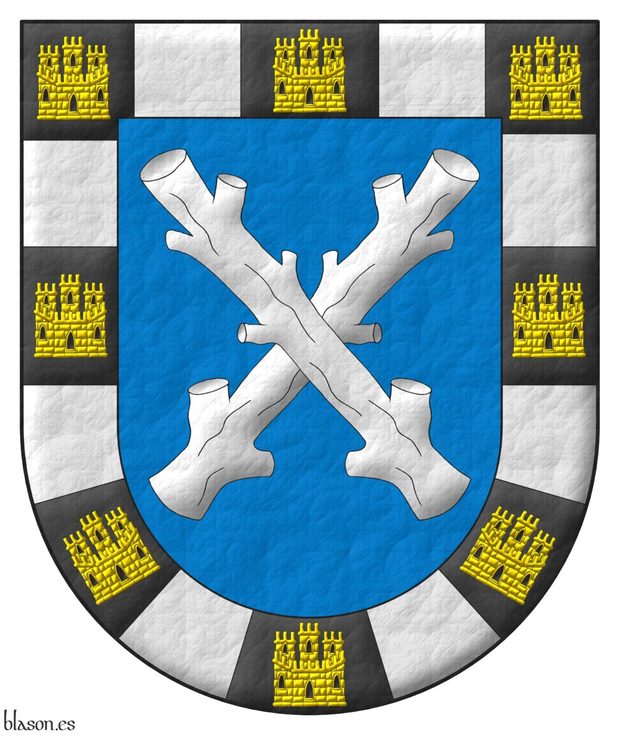
Azure, two trunks of a tree raguly, couped at random, in saltire Argent; a bordure compony of sixteen sections, eight sable charged with a castle triple-towered Or, port, windows, and masoned Sable, and eight Argent
Escudo de azur, dos troncos ecotados, nudosos, en sotuer de plata; una bordura componada de dieciseis compones: ocho de sable cargados de un castillo de oro, aclarado y mazonado de sable, y ocho de plata
Illuminated and a leather finishing.
Blazon keywords: Without divisions, Azure, Two, Trunk, Raguly, In saltire, Argent, One, Bordure, Compony, Sixteen, Section, Eight, Sable, Charged, Castle, Or, Port and windows and Masoned.
Style keywords: Leather, Outlined in sable, Illuminated and Semi-circular.
Classification: Personal and Interpreted.
Bearer: Espinosa, Diego.


Fabian Coulot
Or, two mullets of six points pierced in fess Gules; in chief a sabre fesswise Sable. Motto: «Curae virtus est».
Blazon keywords: Or, Two, Mullet of six points pierced, In fess, Gules, In chief, One, Sabre, Sword, Fesswise, Sable and Motto.
Style keywords: Outlined in sable, Semi-circular, Illuminated and Freehand.
Classification: Personal, Interpreted, Coat of arms and Latin language.
Bearer: Coulot, Fabian.


Family of Milos Dukat, structured and parallel blazons
Coat of arms of the family of Milos Dukat from Czechia and the Basque Country, designed by them and me, and emblazoned by me, with the blazon written in English and Castilian in a structured way to observe the parallelism between both forms.
Blazon keywords: Azure, Gules, Argent, Or, One, Two, Three, Party per pale, Overall, In chief, Lion, Rampant, Double queued, Armed, Langued, Crowned, In base, Upon, Wavy, Bar, Ship and Full sail.
Style keywords: Outlined in sable, Illuminated, Semi-circular and Freehand.
Classification: Personal, Created, Structured and parallel blazons, Boa and Coat of arms.
Bearer: Dukat, family of Milos.


Farnese, Alessandro
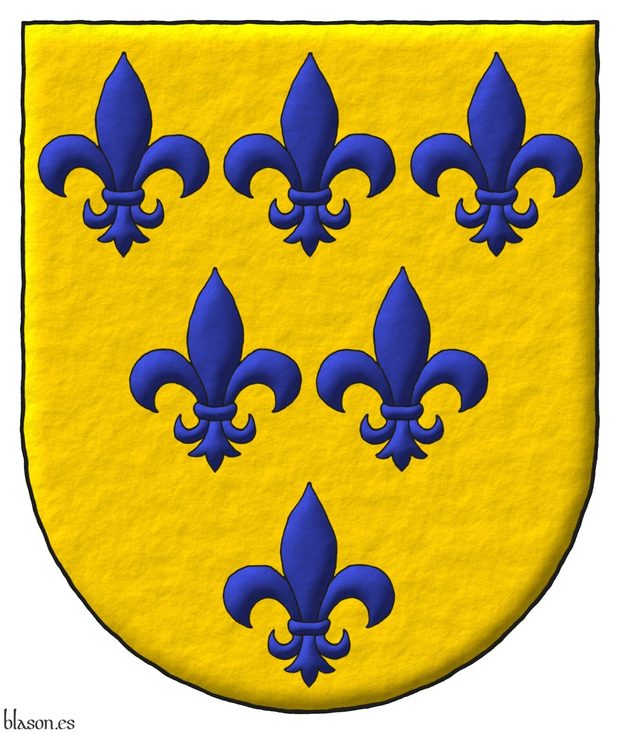
Or, six fleurs de lis Azure, 3, 2, and 1.
Escudo de oro, seis flores de lis de azur, 3, 2 y 1.
Coat of arms depicted by me, highlighted with lights and shadows, contoured in Sable, with a semi-circular outer contour and with a freehand finish.
Coat of arms of Alessandro Farnese, 1545–1592, emblazoned by me. In 1956, the fourth Tercio of the Spanish Legion was created and named Tercio Alessandro Farnese in his honor. The coat of arms of that Tercio features the arms of the Farnese in its central inescutcheon, although with its 6 fleurs de lis arranged in orle.
Blazon keywords: Or, Azure, Six and Fleur de lis.
Style keywords: Outlined in sable, Illuminated, Semi-circular and Freehand.
Classification: Personal, Interpreted, Boa and Coat of arms.
Bearer: Farnese, Alessandro.


Ferdinand II, imaginary coat of arms
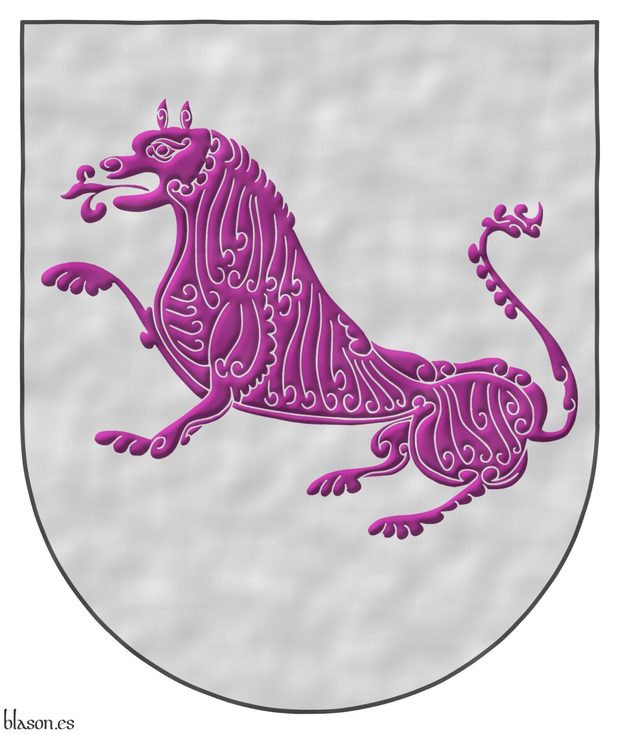
Argent, a lion sejant erect Purpure.
Escudo de plata, un león sentado de púrpura.
Imaginary coat of arms of King Fernando II of León, which I have developed based on his seal and the arms of his successor, with: the shape of the coat of arms is semi-circular; the field enameled in flat argent; the lion enameled in purpure and illuminated; and the whole rendered with a watercolor finish.
For this imaginary coat of arms I have chosen a representation of the lion in a posture similar to that of the great seal appearing in [Fernando II de León; 1167], which is sejant ~ «sentado» in Castilian, although beginning to rise «sejant erect».
It should be noted that we are in a pre-heraldic period where the possible attitudes of the lion were not yet clearly defined, although several of them are already anticipated in the great seals of Fernando II, as can be seen, for example, passant in [Fernando II de León; 1181] and in other attitudes in the photographs of [Martín Fuertes, J. A.; 2002].
Blazon keywords: Without divisions, Argent, Lion, Purpure and Sejant.
Style keywords: Semi-circular, Illuminated, Outlined in the field tincture and Watercolor.
Classification: Interpreted, Imaginary, Coat of arms and Kingdom of León.
Imaginary bearer: Ferdinand II of Leon.


Ferdinand III of Castile
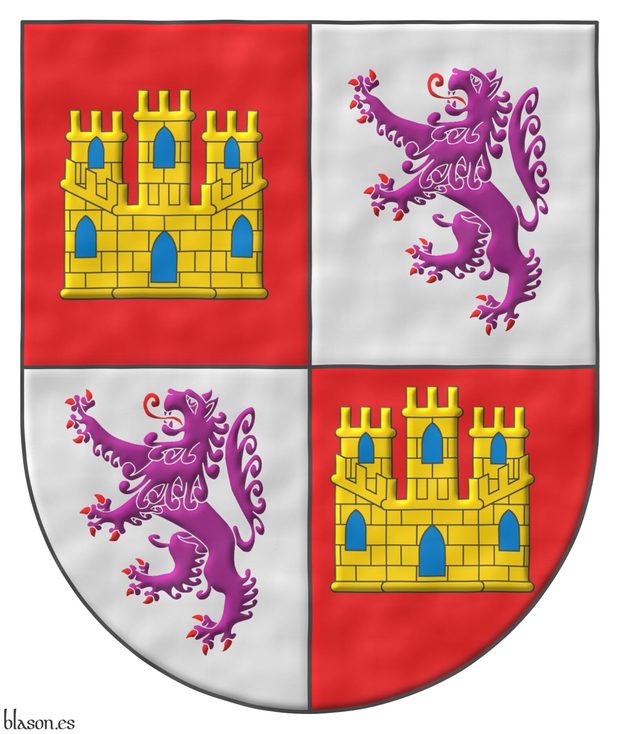
Son of Berenguela, Queen of Castile, and Alfonso IX, King of León.
Quarterly: 1 and 4 Gules, a castle triple towered Or, port and windows Azure, masoned Sable; 2 and 3 Argent, a lion rampant Purpure, armed and langued Gules.
Escudo cuartelado: 1o y 4o de gules, un castillo de oro, aclarado de azur, mazonado de sable; 2o y 3o de plata, un león rampante de púrpura, armado y lampasado de gules.
Arms of King Ferdinand III of Castile, as interpreted by me, with the following characteristics: the shield’s shape is rounded; the field, the two castles, and the two lions have been illuminated; and the whole composition features a watercolor finish.
It is with King Ferdinand III the Saint of Castile when «the emblematic system reaches its highest degree of perfection, acquiring two characteristics: realism, which becomes a hallmark of Spanish heraldry,... and the tendency to combine coats of arms» with the appearance of quarterly divisions replacing the cadency marks used in the rest of Europe [Valverde Ogallar, P. B.; 2001; page 100].
Shield in flat ink and illuminated metallic finish
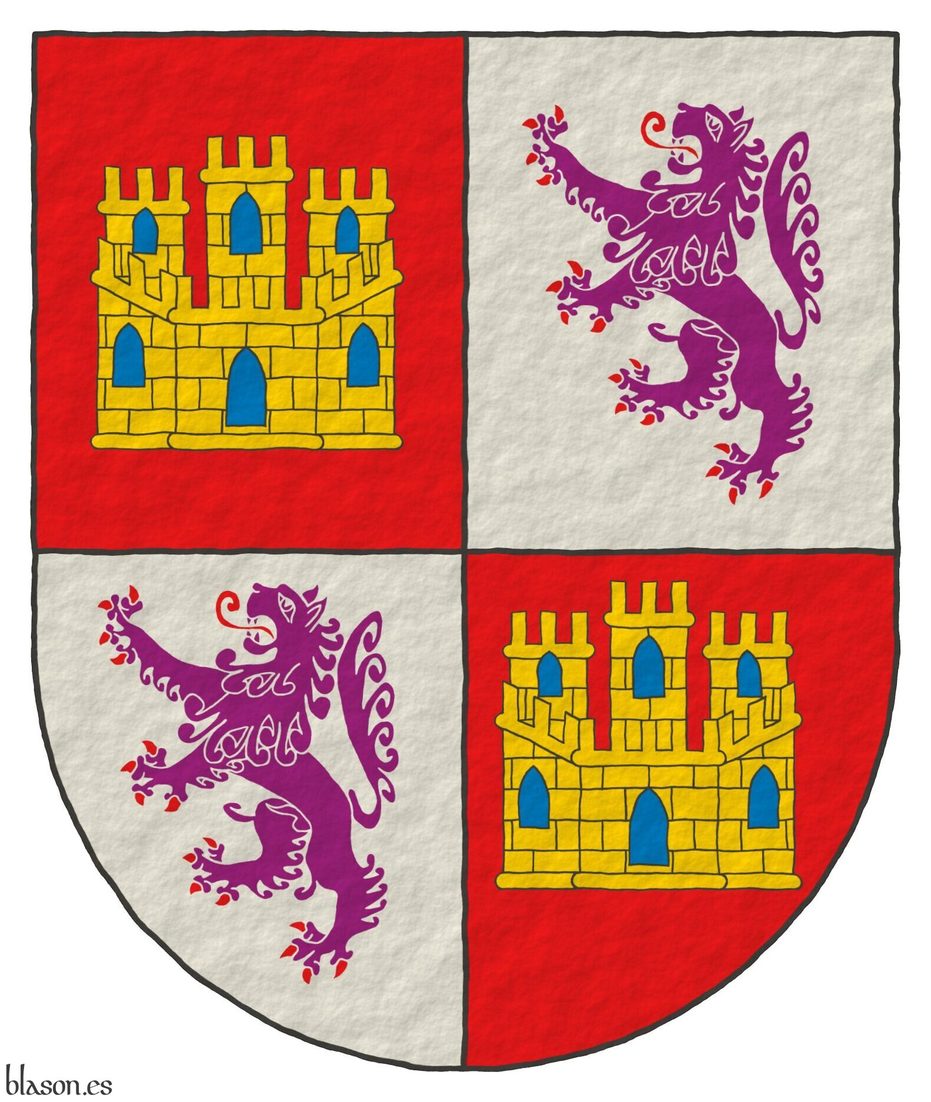
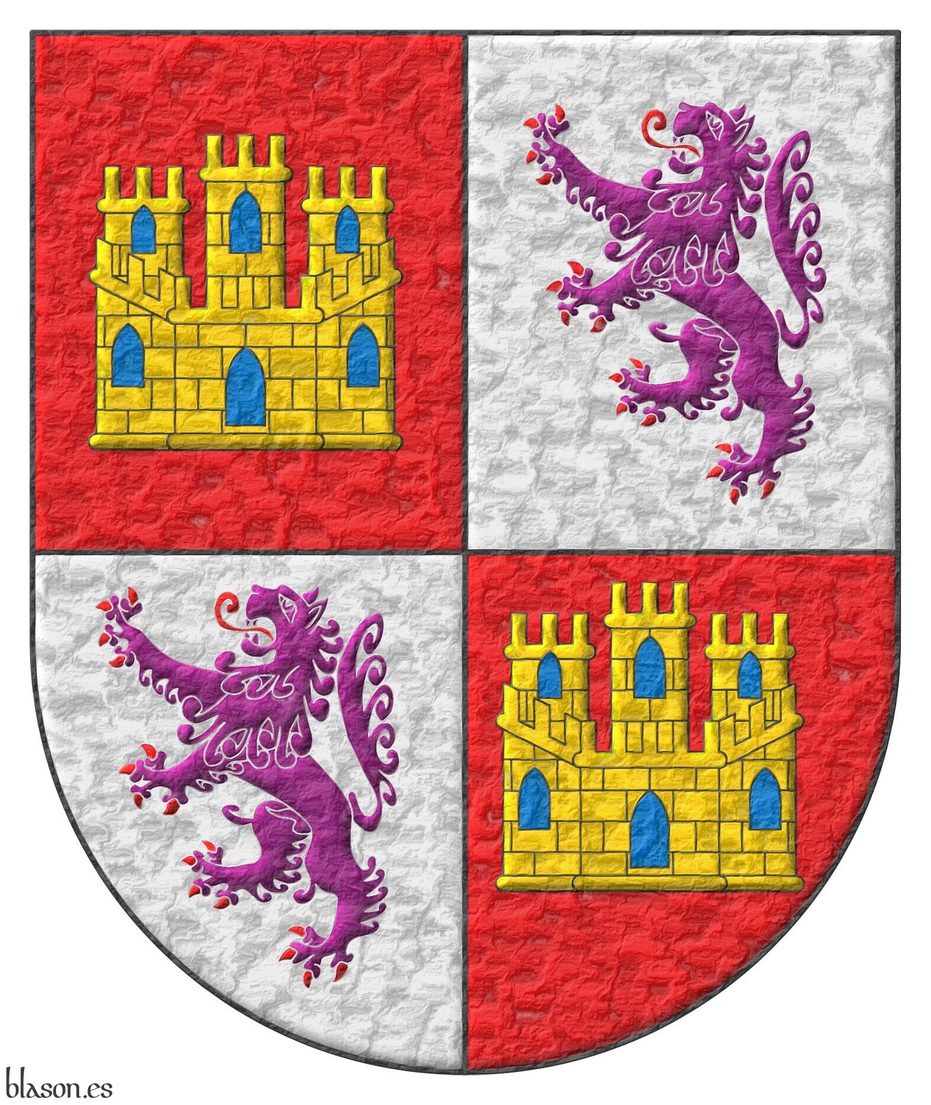
Design of a heraldic document
Blazon keywords: Quarterly, Gules, Or, Azure, Sable, One, Castle, Port and windows, Masoned, Argent, Purpure, Lion, Rampant, Armed and Langued.
Style keywords: Semi-circular, Illuminated and Watercolor.
Classification: Interpreted, Personal, Coat of arms and Kingdom of Castile and Leon.
Bearer: Ferdinand III of Castile.


Fernández de Córdoba y Carrillo, Diego
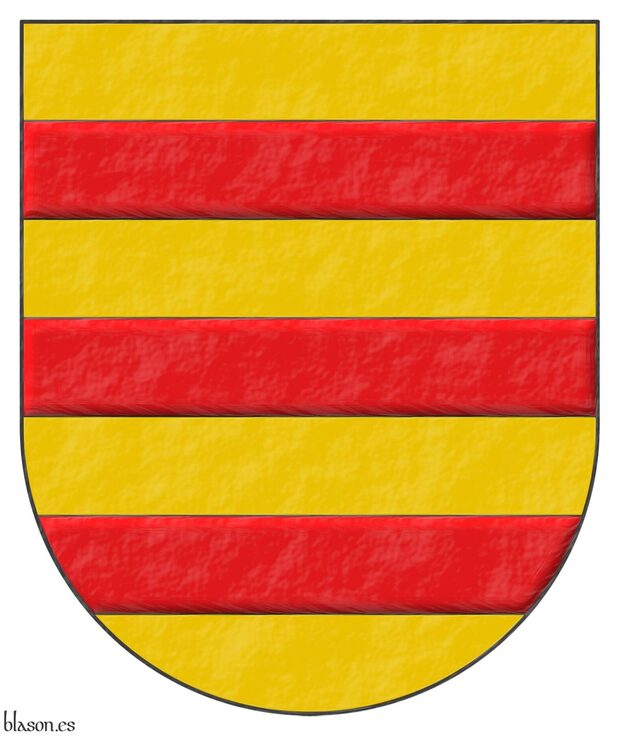
Marshal of Castile, first Lord of Baena and plenipotentiary ambassador to the court of Portugal (1355–1435).
Or, three fesses Gules.
Escudo de oro, tres fajas de gules.
Coat of arms del que fue mariscal de Castilla interpreted as follows: the shield has a semicircular (round) base; the field is illuminated in flat metal Or; its three fesses illuminated in Gules y outlined in Sable; y el conjunto con un plastered finish.
He served under the kings John I of Castile, Henry III of Castile, and John II of Castile.
These three bars of the Fernández de Córdoba lineage are found, for example, in the first quarter of the coat of arms of Gonzalo Fernández de Córdoba y Enríquez de Aguilar, known as *El Gran Capitán*.
Blazon keywords: Without divisions, Or, Fess and Gules.
Style keywords: Illuminated, Outlined in sable, Semi-circular and Gesso.
Classification: Interpreted, Personal, Coat of arms and Kingdom of Castile and Leon.
Bearer: Fernández de Córdoba y Carrillo, Diego.
Blazon equivalent to: Berry of Molland.


Fernandez de Cordoba, Gonzalo
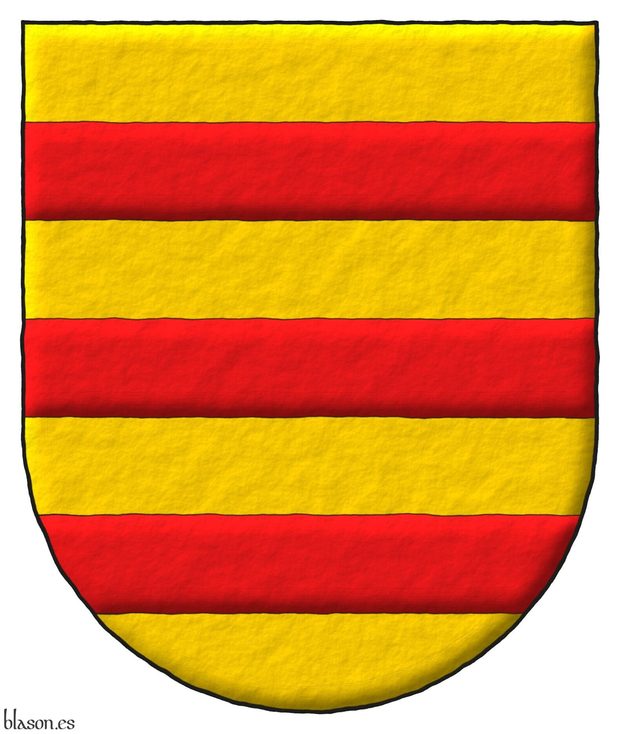
Or, three bars Gules.
De oro, tres fajas de gules.
Arms interpreted by me, highlighted with lights and shadows, contoured in Sable, with a semi-circular external shape and with a freehand finishing.
Coat of arms of Gonzalo Fernandez de Cordoba, 1453–1515, known as «The Great Captain», emblazoned by me. The Tercio Great Captain, 1st of the Spanish Legion, is named in honour of Gonzalo Fernandez de Cordoba, and the coat of arms of the unit bears a central inescutcheon with the arms of «The Great Captain».
Blazon keywords: Or, Gules, Three and Fess.
Style keywords: Outlined in sable, Illuminated, Semi-circular and Freehand.
Classification: Personal, Interpreted, Boa and Coat of arms.
Bearer: Fernandez de Cordoba, Gonzalo.


Francisca Aras Quirce
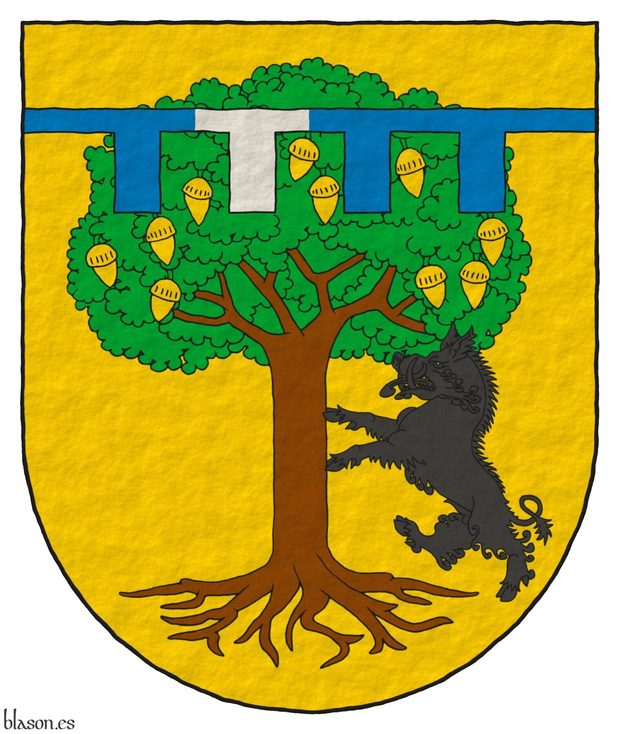
Or, an oak tree proper, fructed Or, with a boar supporting it Sable; the whole debruised by a label of four points Azure with the second point Argent.
Escudo de oro, un roble al natural, frutado de oro, con un jabalí empinado de sable; brisado de un lambel de cuatro pendientes de azur, el segundo pendiente de plata.
Coat of arms interpreted by me, in flat tinctures, outlined in Sable, with a semi-circular outer contour and with a texturized finish.
Coat of arms of Francisca Aras Quirce designed by Juan Lanzagorta Vallin and emblazoned by me.
Credits: Juan Lanzagorta Vallin is the designer of the coat of arms.
Blazon keywords: Or, One, Oak, Tree, Proper, Fructed, Boar, Supporting, Sable, Cadency, Label, Four, Azure and Argent.
Style keywords: Outlined in sable, Plain tincture and Semi-circular.
Classification: Personal, Interpreted and Coat of arms.
Bearer: Francisca Aras Quirce.


Francisco Domingo Larrosa Gil, plain tincture
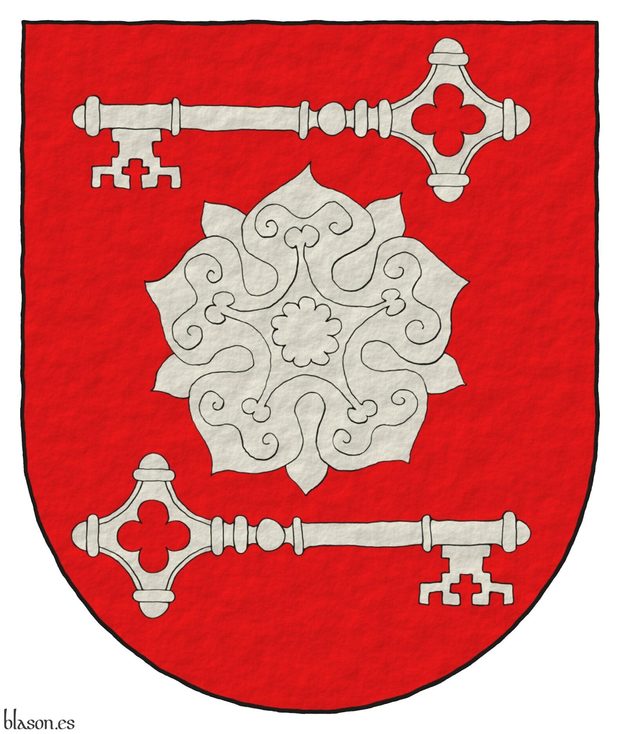
Gules, a rose between in chief a key wards to dexter facing downwards, in base a key wards to sinister facing downwards Argent.
Coat of arms emblazoned by me, in flat tinctures, outlined in Sable, with a semi-circular external shape and with a texturized finish.
The coat of arms for Francisco Domingo Larrosa Gil emblazoned by me.
Blazon keywords: Gules, Argent, One, Rose, Between, In chief, Key, Dexter, Point upwards, In base, Point downwards and Sinister.
Style keywords: Outlined in sable, Plain tincture and Semi-circular.
Classification: Personal, Interpreted, Boa and Coat of arms.
Bearer: Larrosa Gil, Francisco Domingo.


Frank, Markus Hermann
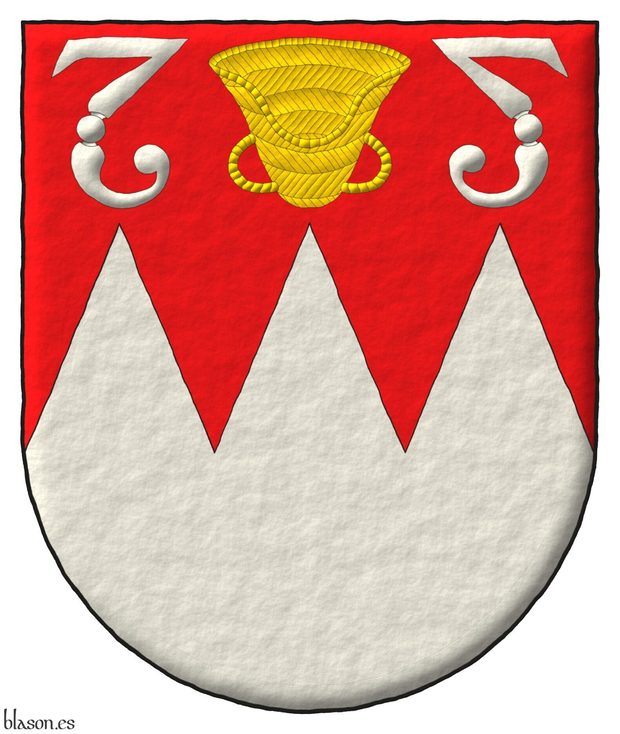
Party per fess dancetty of three points Gules and Argent, in chief a winnowing fan reversed Or between two fleams addorsed Argent.
Escudo cortado de gules, encajado de tres piezas enteras de plata, en jefe, un aventador ranversado de oro acompañado de dos lancetas adosadas de plata.
Coat of arms painted by me, highlighted with lights and shadows, outlined in Sable, with a semi-circular outer contour and with a freehand finish.
G0129, Chief Herald of Arms of Malta's grant of the coat of arms of Markus Hermann Frank, USA. This coat of arms has been emblazoned by me.
Design rationale
The coat of arms of Markus Hermann Frank features a Franconian Rake, a heraldic reference to his surname, making this a case of canting arms. The Franconian Rake is the historical emblem of the Franconia region in Germany, traditionally blazoned as per fess dancetty of three points Gules and Argent. He is a Medical Doctor and an Associate Professor at Harvard Medical School, which is reflected in the two fleams, surgical instruments historically used in medicine.
Blazon keywords: Gules, Argent, Or, One, Two, Three, Party per fess, Dancetty, In chief, Winnowing fan, Reversed, Between and Fleam.
Style keywords: Outlined in sable, Illuminated, Semi-circular and Freehand.
Classification: Personal, Interpreted, Design rationale, Boa and Coat of arms.
Bearer: Frank, Markus Hermann.


Freitas, lineage of Portugal
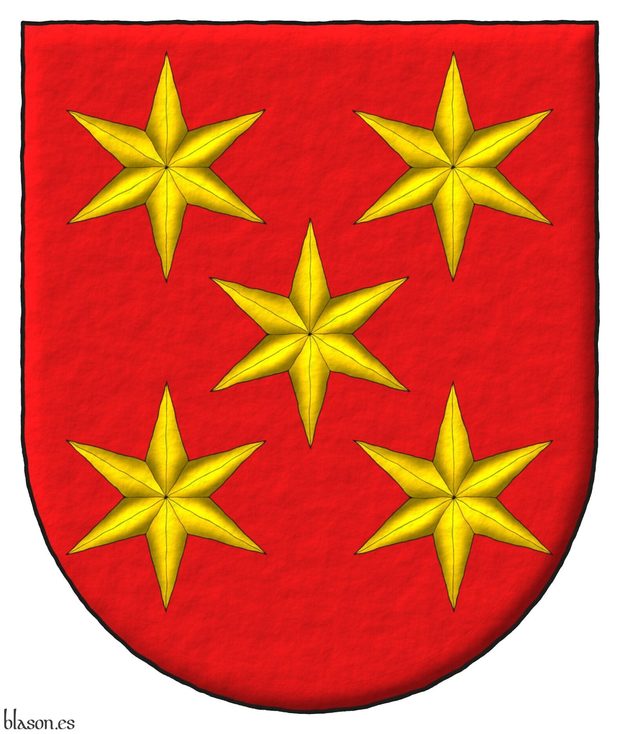
Blazon of the Freitas lineage of Portugal.
Gules, five mullets of six points Or.
Illuminated and a freehand finishing.
It can be found at [Cró, J. do; 1509; page 123].
Blazon keywords: Without divisions, Gules, Five, Mullet and Or.
Style keywords: Freehand, Outlined in sable, Illuminated and Semi-circular.
Classification: Interpreted, Lineage and Kingdom of Portugal.


Gangoiti, lineage
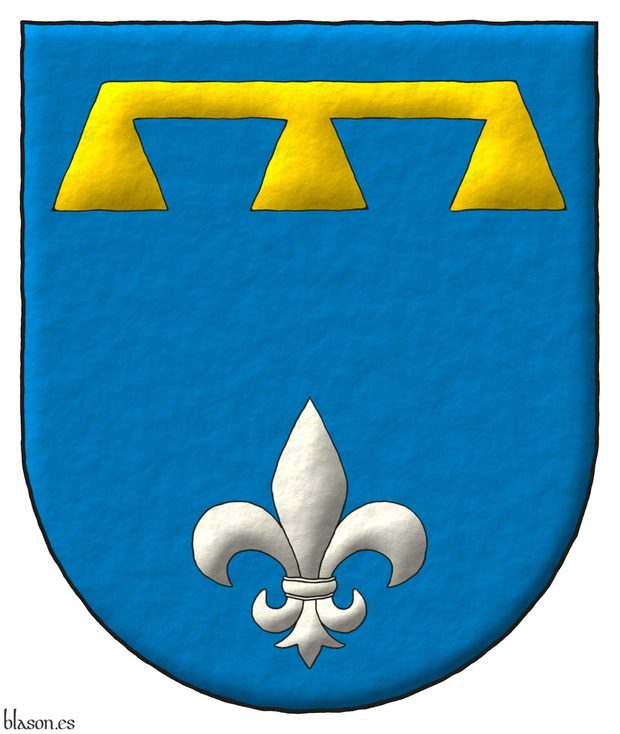
Azure, in chief a label Or, and in base a fleur de lis Argent.
Escudo de azur, en jefe un lambel de oro y en punta una flor de lis de plata.
Coat of arms painted by me, illuminated with lights and shadows, contoured in Sable, with a semi-circular outer contour and with a freehand finishing.
Coat of arms of the lineage Gangoiti emblazoned by me based on the description by [Cadenas y Vicent, V. de; 1987; page 770].
Blazon keywords: Azure, Or, Argent, One, In chief, Label, In base and Fleur de lis.
Style keywords: Outlined in sable, Illuminated, Semi-circular and Freehand.
Classification: Personal, Lineage, Interpreted, Boa and Coat of arms.
Bearer: Gangoiti, lineage.


Gonzalo Argote de Molina
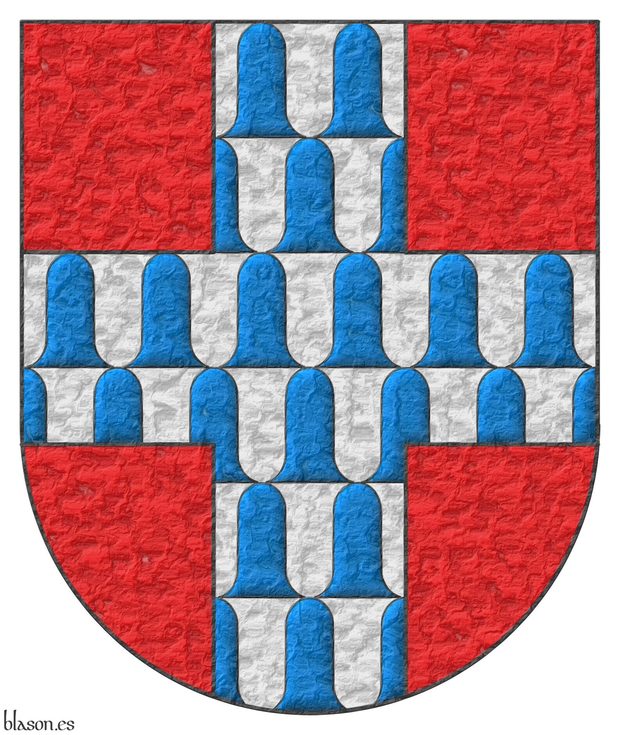
Gules, a cross vair ancient.
Escudo de gules, una cruz de veros antiguos.
Coat of arms that I have interpreted as follows: the shield has a semicircular (round) base; the field is in flat tincture of Gules; the vair ancient, rounded in the old style, are outlined in Sable and illuminated; and the whole has a raised-stroke drawing.
The coat of arms of the commune of Bailleul is very similar to this coat of arms, with the difference that it is of regular vair instead of ancient, rounded vair, like that borne by Gonzalo Argote de Molina.
Blazon keywords: Without divisions, Gules, Argent, Azure, Cross and Vair ancient.
Style keywords: Semi-circular, Illuminated, Outlined in sable and Metal beaten.
Classification: Interpreted, Personal, Coat of arms and Heraldry and heralds.
Bearer: Argote de Molina, Gonzalo.


Gregorio Lanzagorta Llaguno
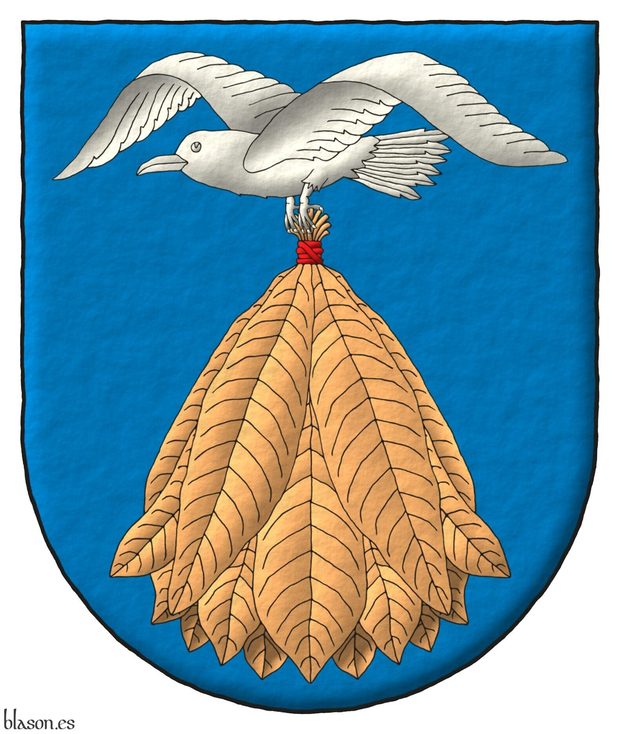
Azure, a seagull volant Argent, carrying in its feet a sheaf of tobacco proper, bound Gules.
Escudo de azur, una gaviota volante de plata, llevando entre sus patas una gavilla de tabaco al natural, liada de gules.
Arms painted by me, highlighted with lights and shadows, outlined in Sable, with a semi-circular outer contour and with a freehand finishing.
The coat of arms of Gregorio Lanzagorta Llaguno, harbor of San Blas, and cigar maker in Nayarit, Mexico. This coat of arms was designed by Juan Lanzagorta Vallín and painted by me.
Blazon keywords: Azure, Argent, Gules, One, Seagull, Volant, Grasping, Foot (palmiped), Sheaf of tobacco, Proper and Bound.
Style keywords: Outlined in sable, Illuminated, Semi-circular and Freehand.
Classification: Personal, Interpreted, Boa and Coat of arms.
Bearer: Gregorio Lanzagorta Llaguno.


Grimaldi, François
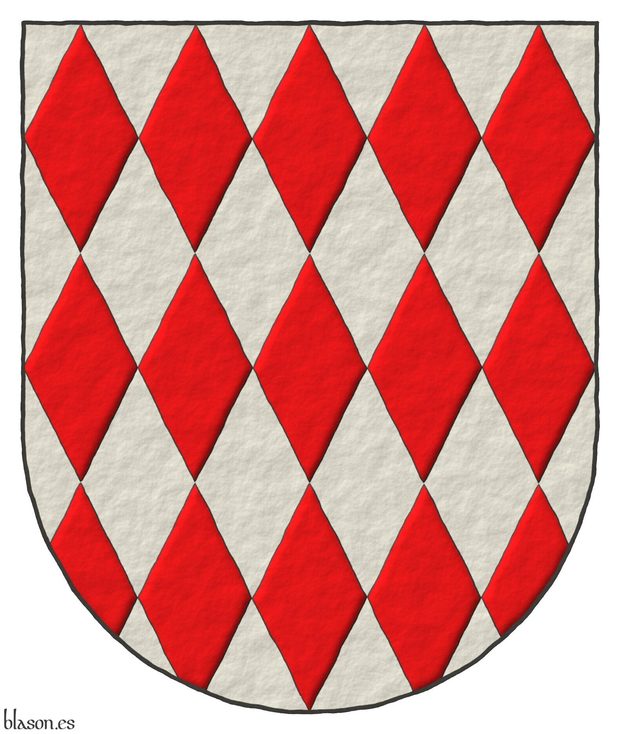
François Grimaldi ~ Francisco Grimaldi ~ Francesco Grimaldi.
Fusilly Argent and Gules.
Escudo fusado de plata y gules.
Coat of arms interpreted with: the semicircular base shape; the field of plain metal Argent; the fusils illuminated in Gules, outlined in Sable; the fusilly of proportion 3 x 5; and the whole with a raised-stroke effect.
Unlike how I have blazoned it here, this coat of arms can be found blazoned in [Arco y García, F. del; 1996b; page 10] as «Fusilly Argent and Gules».
He was the Genoese leader of the Guelphs who conquered the so-called Rock of Monaco on January 8, 1297, at night. To enter his fortress and have the gates opened for him, he dressed as a Franciscan monk along with his cousin Rainier I, Lord of Cagnes, and thus entered with his group of armed men. That is why the coat of arms of the Principality of Monaco has as supporters 2 Franciscan monks unsheathing their swords.
Francesco Grimaldi had no children, so after his death in 1309, he was succeeded by his cousin Rainier I, with whom he entered Monaco, and it is from Rainier I that the Grimaldi family and the Princes of Monaco who have governed the Principality ever since descend.
Blazon keywords: Fusilly, Argent and Gules.
Style keywords: Semi-circular, Illuminated, Outlined in sable and Freehand.
Classification: Interpreted and Personal.
Bearer: Grimaldi, François.


Grzeszkowiak, Tomasz Arkadiusz
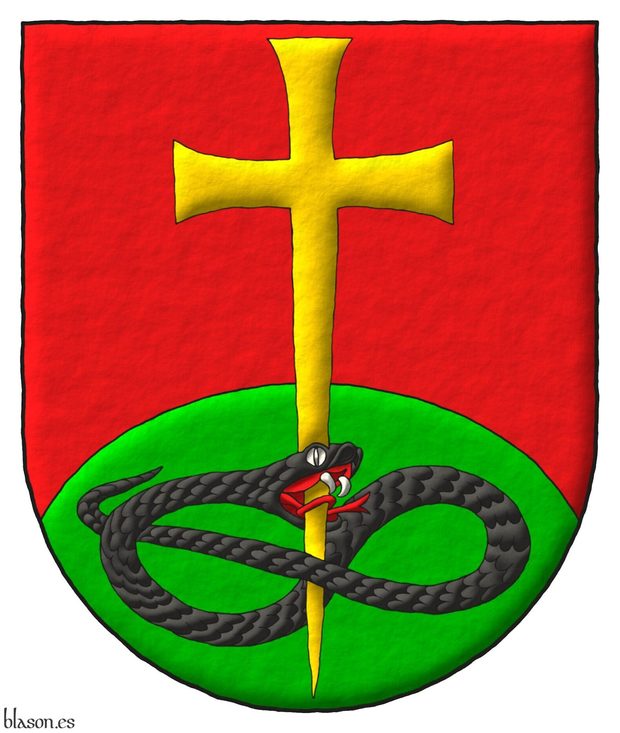
Gules, a base enarched Vert, overall a cross patty fitchy Or, piercing in base the head of a serpent nowed and facing sinister Sable, langued Gules.
I have interpreted this coat of arms with a semi-circular shape; tintures or, sable, vert and gules; outlined with sable; and a freehand finish.
In Polish heraldic tradition the color Sable can be over other colors, the color Vert in this case. The following bibliographical references can be consulted about the Polish use of the color Sable over other colors:
- [Bakala, K.; 2010; page 17] has written «nie pozwala nakladania metalu na metal, a barwy na barwe, za wyjatkiem barwy czarnej i purpurowej» ~ «does not allow to put metal on metal and color on color, except the color Sable and Purpure», notice that Sable and Purpure are the neutral colors whilst Gules, Azure and Vert are energetic colors.
- [Marecki, J.; 2012; page 67] has written about the rule of colors and metals «wyjatkiem byla czern, która laczono zarówno z metalami, jak i z innymi barwami» ~ «the exception was black, which was combined with both metals and other colors».
Blazon keywords: Without divisions, Gules, One, Mount, Vert, Issuant from base, Overall, Cross patty fitchy, Cross couped, Piercing, Head, Serpent, Nowed, Facing sinister, Sable and Langued.
Style keywords: Semi-circular, Freehand and Outlined in sable.
Classification: Interpreted, Personal and Coat of arms.
Bearer: Grzeszkowiak, Tomasz Arkadiusz.


Guebara of Navarre
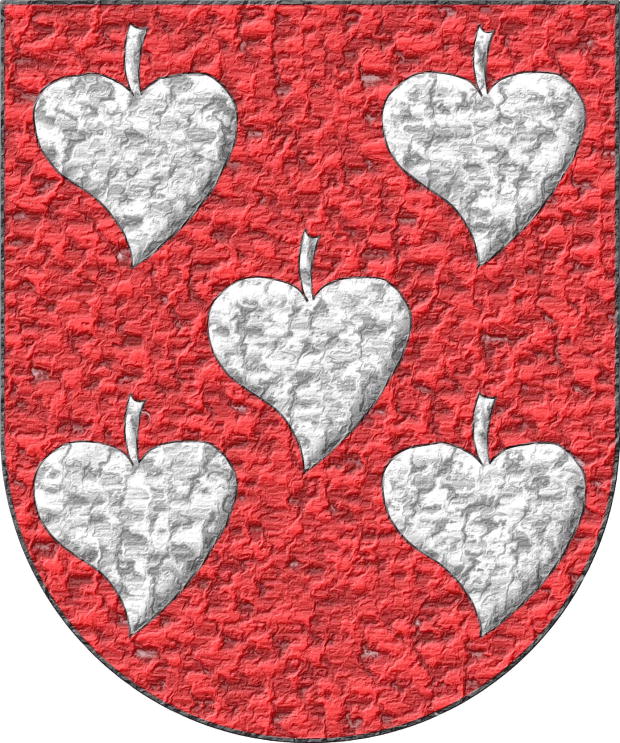
Of the twelve lineages of Noblemen, it is the second, descendant of Álava, the very ancient and powerful one, in which some served under Navarre, and others under the kings of Castile; they bear for arms and insignia, on a field Gules, which is red, five poplar-leaves (panelas) Argent, in the form and design in which this shield is painted.
Gules, five Poplar-leaves Argent, inverted.
Escudo de gules, cinco panelas de plata.
Coat of arms interpreted with: a semicircular (round) base; the field in flat Or; the pales outlined in Sable and illuminated in Azure enamel; and finished in highly-hammered metal.
Interpretation based on the second coat of arms of the «ricoshombres» of Navarre from [Bosque, J. del; 1540; folio 1 of the numbering of 1613] and the accompanying text is from the transcription made in [Martinena Ruiz, J. J.; 1982; pages 122 and 123].
The «panela» is a figure typical of Spanish heraldry [Valero de Bernabé, L.; 2007; page 11]. It is a leaf shaped like a heart with its stalk pointing upward. It could be a leaf of a tree such as, for example, the poplar, although there is no certainty that it is specifically that tree.
With first appearances prior to heraldry on Hispano-Roman tombstones, the «panela» is of Alavese origin, [Menéndez Pidal de Navascués, F.; 1985; page 474], spreading through the Basque-Navarrese region and from there throughout Spain, with the peculiar name «panela», which was initially called «pannella», [Valverde Ogallar, P. B.; 2001; page 532] derived from «pan», [Real Academia Española; 2001].
In the heraldry of other countries, leaves from different trees are used as heraldic symbols, but usually with the stalk pointing downward; therefore I transcribe in this blazon «panelas» ~ «Poplar-leaves, inverted».
[Menéndez Pidal de Navascués, F.; 1985; page 474] states that the «panela» is a natural figure equivalent to the linden leaf in German heraldry, with the stalk downward, and to the water-lily leaf in French heraldry, with the stalk upward; but since these are such different plants, I do not find it suitable to use linden, and even less water-lily, in the English transcription of this Navarrese blazon.
Under the title «Surname of Guebara» it can be consulted in [Vega, P. J. de; 1702; folio 2 of the manuscript].
Blazon keywords: Without divisions, Gules, Poplar leaf and Argent.
Style keywords: Semi-circular, Illuminated, Outlined in sable and Hard metal.
Classification: Interpreted, Personal and Kingdom of Navarre.
Bearer: Guebara of Navarre.


Heikki Halkosaari, plain tincture
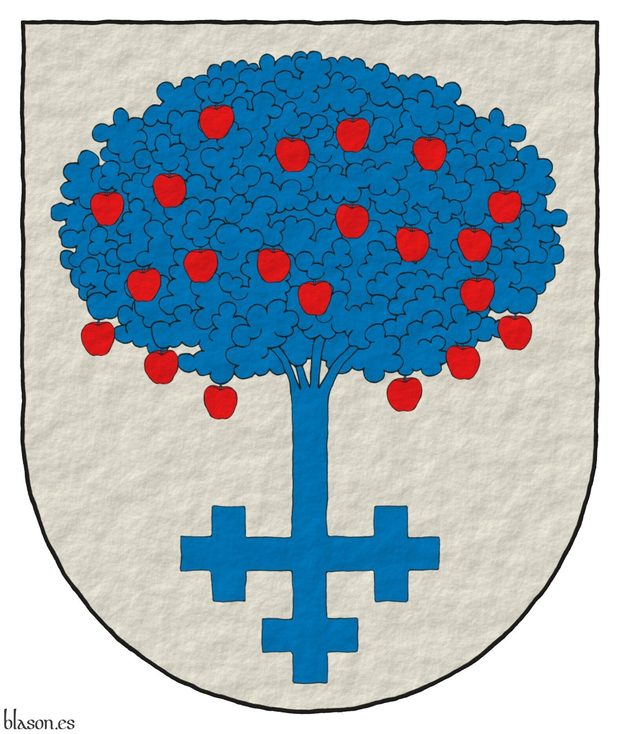
Argent, an apple tree, the base of its trunk forming a cross crosslet Azure, fructed Gules.
Arms interpreted by me, in flat tinctures, outlined in Sable, with a semi-circular outer contour and with a texturized finishing.
The coat of arms of Heikki Halkosaari, Finland, emblazoned by me.
Blazon keywords: Argent, Azure, Gules, One, Apple tree, Base, Trunk, Cross, Crosslet, Cross couped and Fructed.
Style keywords: Outlined in sable, Plain tincture and Semi-circular.
Classification: Personal, Interpreted, Boa and Coat of arms.
Bearer: Halkosaari, Heikki.


Henry III of England
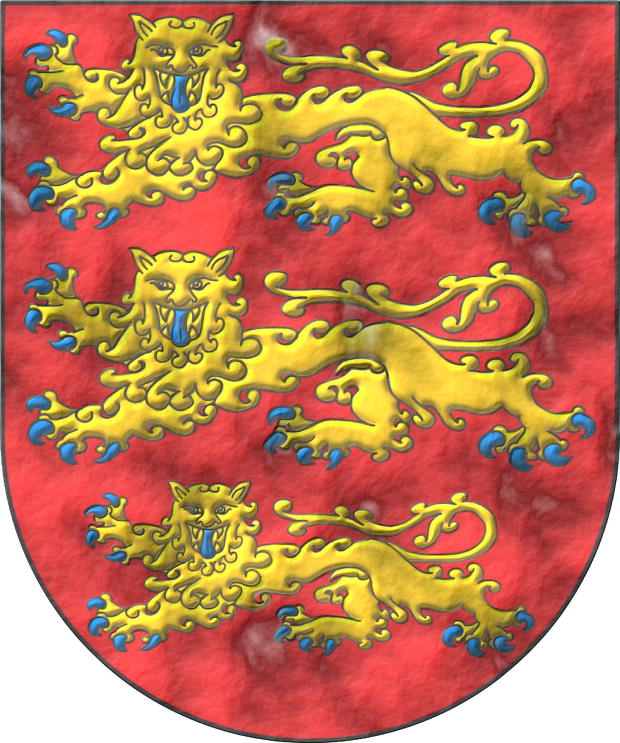
King of England, Lord of Ireland and Duke of Aquitaine from the year 1216 to the year 1272
Gules, three lions, passant, guardant, in pale Or, armed and langued Azure.
Escudo de gules, tres leopardos en palo de oro, armados y lampasados de azur.
Coat of arms interpreted as follows: the mouth of the shield is semicircular (round); its field has been enamelled in a flat tint of Gules; its leopards are illuminated in Or and Azure and outlined in Sable; and the whole has a finish of aged parchment.
Blazon keywords: Without divisions, Gules, Or, Azure, Three, Leopard, Armed, Langued and In pale.
Style keywords: Semi-circular, Illuminated, Outlined in sable and Old parchment.
Classification: Interpreted, Personal, Coat of arms, House of Plantagenet and Kingdom of England.
Bearer: Henry III of England.


Holy Trinity
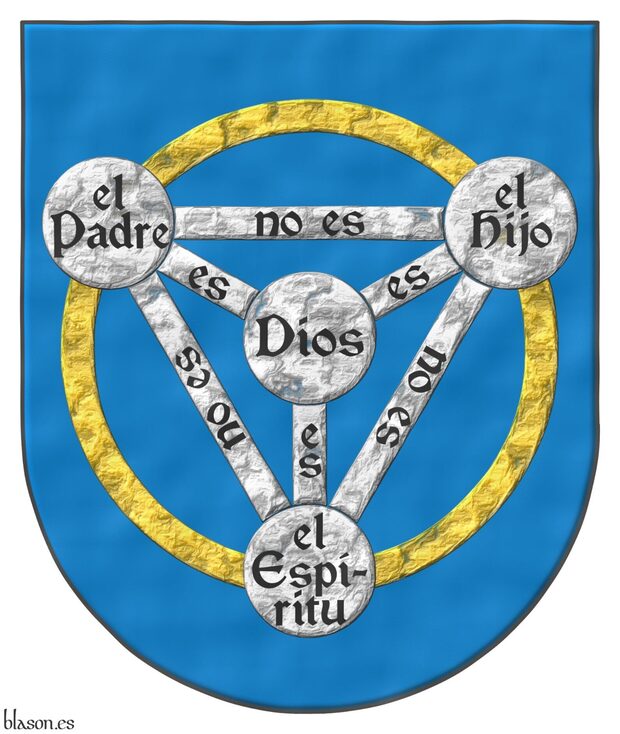
Azure, a pall couped Argent, its three arms charged with «es» Sable, within a triangle reversed Argent, its three arms charged with «no es» Sable, within an annulet Or, all debruised by four plates, three on the vertex of the triangle, in dexter chief, charged with «el Padre» Sable, in sinister chief, charged with «el Hijo» Sable, in base, charged with «el Espítiru» Sable, and one on the fess point, charged with «Dios» Sable.
Escudo de azur, una perla recortada de plata, sus tres brazos cargados con «es» de sable, dentro de un triángulo ranversado de plata, sus tres brazos cargados con «no es» de sable, dentro de un anillo de oro, todo resaltado de cuatro bezantes de plata, tres sobre los vértices del triángulo, en la diestra del jefe, cargado de «el Padre» de sable, en la siniestra del jefe, cargado con «el Hijo» de sable, en la punta, cargado con «el Espítiru» de sable y uno sobre el corazón, cargado con «Dios» de sable.
Imaginary coat of arms that I have interpreted as follows: its base is semicircular (round); its field is illuminated in watercolor Azure; the rest in heavily beaten metal, outlined of the field and illuminated in Argent, except for the annulet which is illuminated in Or; and its letters all in plain Gules ink.
Annulet
The circular crown when it is large and in the middle of the shield [Cadenas y Vicent, V. de; 1975] is called an annulet. [Avilés, J.; 1780a; pages 296 and 297] calls it annulet or small annulet depending on its size, if it is large an annulet and if it is small a small annulet. In English and French heraldry it is called «cyclamor» and hence the expression «cyclamor annulet» can also be found.
This annulet is my aesthetic contribution to this imaginary coat of arms as it is normally not represented with this annulet.
Bordure and Orle
In other interpretations the words «non est» go on a bordure or on an orle, the latter being the case blazoned, for example, [Husenbeth, F. C.; 1882; 2nd appendix] in the following way: «Gules, an orle and pall Argent, conjoined and surmounted of four plates, occupying the dexter and sinister chief and the base and fess points respectively; the first inscribed Pater, the second Filius, and the third Spiritus Sanctus, the centre Deus; the connecting portions of the orle between them having the words non est, and those of the pall est».
Blazon keywords: Without divisions, Azure, Cyclamor, Pall, Closed, Argent, Charged, Bezant and plate, Or, Dexter, Sinister, Chief, Base (lower 1/3) and Heart.
Style keywords: Semi-circular, Illuminated, Outlined in the field tincture, Watercolor and Hard metal.
Classification: Religious, Interpreted, Imaginary and Coat of arms.
Imaginary bearer: Holy Trinity.


House of Hohenzollern
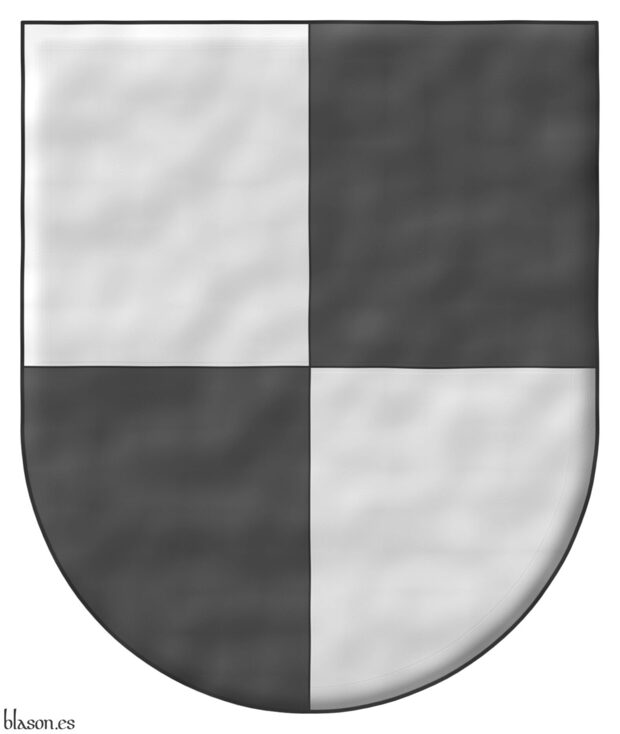
Royal and imperial German dynasty.
Quarterly Argent and Sable.
Escudo cuartelado de plata y sable.
Illuminated with lights and shadows and with a watercolor finish.
Blazon keywords: Quarterly, Argent and Sable.
Style keywords: Watercolor, Outlined in sable, Illuminated and Semi-circular.
Classification: Interpreted.
Bearer: House of Hohenzollern.


Howel ap Res
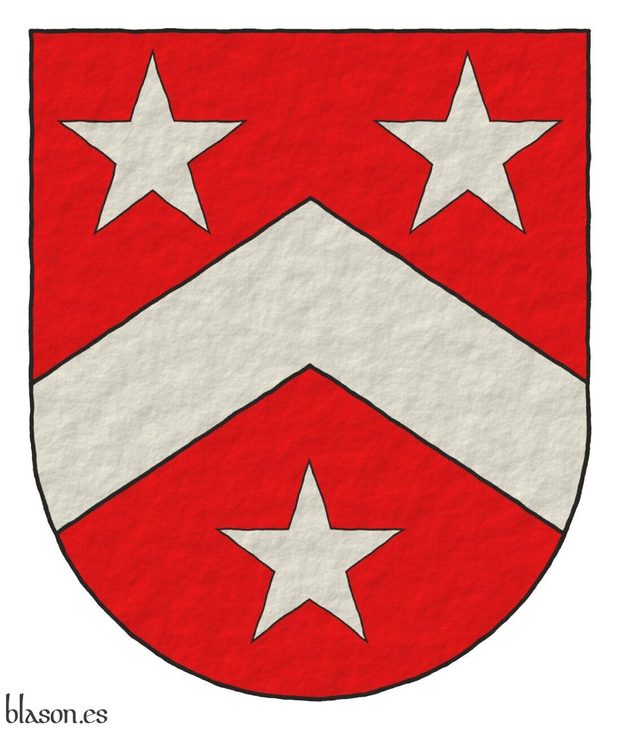
Howel Ap Rhys ~ Howel ap Res.
Gules, a chevron Argent, between three mullets Argent.
Escudo de gules, un cabrio de plata, acompañado de tres estrellas de cinco puntas de plata.
Included in [Vincent, MS; 1285; number 623] also known as [St. George's Roll; 1285; number 623].
The coat of arms of Howel Ap Rhys is the inverse of the coat of arms of Adan de Creeting.
Blazon keywords: Without divisions, Gules, One, Chevron, Argent, Between, Three and Mullet.
Style keywords: Semi-circular, Plain tincture and Outlined in sable.
Classification: Interpreted and Personal.
Bearer: Howel Ap Rhys.
Blazon equivalent to: Juan le Sturmy.


Hradec Králové Region
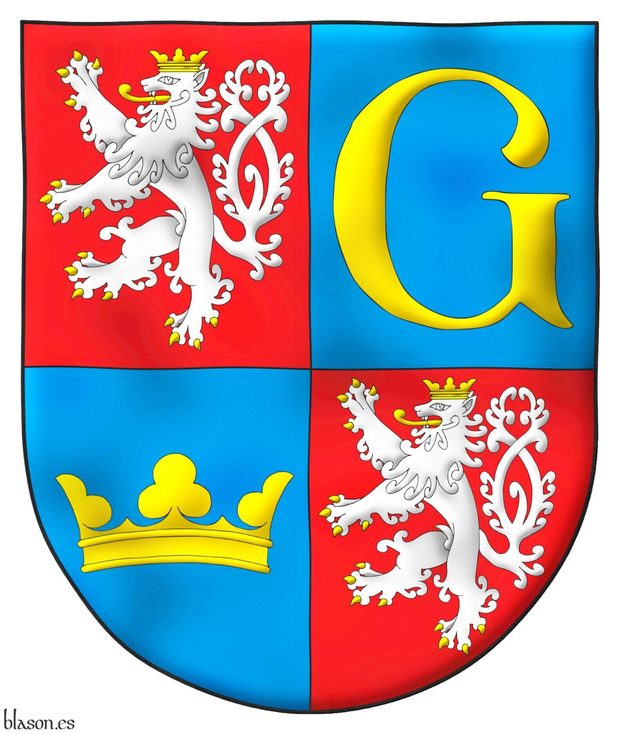
Quarterly: 1 and 4 Gules, a lion rampant, double queued Argent, armed, langued, and crowned Or; 2 Azure, a letter «G» Or; 3 Azure, a coronet trefoiled Or
Escudo cuartelado: 1o y 4o de gules, un león rampante, de cola horquillada de plata, armado, lampasado y coronado de oro; 2o de azur, una letra «G» de oro; 3o de azur, una corona trebolada de oro
This coat of arms is illuminated with lights and shadows and has a finish like glass.
The Hradec Králové Region is an administrative unit of the Czech Republic. It is located in the historical region of Bohemia. Its capital is Hradec Králové, whose Latin name is «Gradicium», hence its old name «Gradec». The letter «G» seen in both the coat of arms of the Hradec Králové Region and the coat of arms of its capital originates from this historical name. The lion rampant Anrgent, double queued and crowned in the 1st and 4th quarters is the symbol of Bohemia, and it also appears in the 1st and 4th quarters of the coat of arms of the Czech Republic. «Králové» means «of the queen» in Czech and there is a trefoiled crown in the 3rd quarter
Blazon keywords: Quarterly, Gules, One, Lion, Rampant, Tail, Double queued, Argent, Armed, Langued, Crowned, Or, Azure, Letter, Coronet trefoiled, Ancient coronet, Crown and Trefoiled.
Style keywords: Glass, Outlined in sable, Illuminated and Semi-circular.
Classification: Civic and Interpreted.
Bearer: Hradec Králové Region.


IESE, University of Navarra
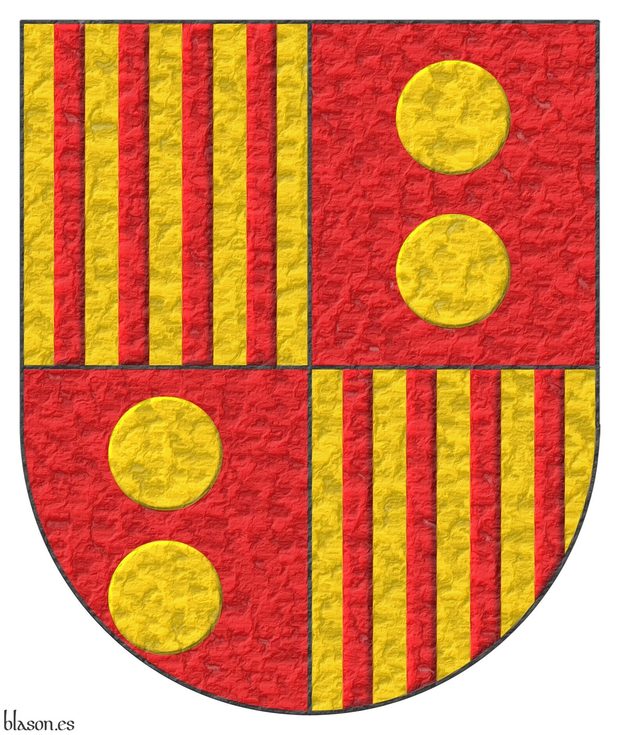
Quarterly: 1 and 4 Or, four pallets Gules; 2 and 3 Gules, two bezants in pale.
Escudo cuartelado: 1o y 4o de oro, cuatro palos de gules; 2o y 3o de gules, dos bezantes en palo de oro.
Coat of arms of IESE interpreted by me as follows: the shield has a semicircular (round) base; the field is illuminated in flat tinctures Or and Gules; the eight pales and the four bezants are illuminated in Gules and Or; and the whole coat of arms has a beaten metal finish.
IESE was founded in 1958 under the name Institute of Higher Business Studies, it is the business management school of the University of Navarra and is currently known as IESE Business School.
Blazon keywords: Quarterly, Gules, Or, Pale, Bezant and plate and In pale.
Style keywords: Semi-circular, Illuminated and Metal beaten.
Classification: Interpreted, Socioeconomic, Education and Coat of arms.
Bearer: IESE.


Ifrah, Yishay
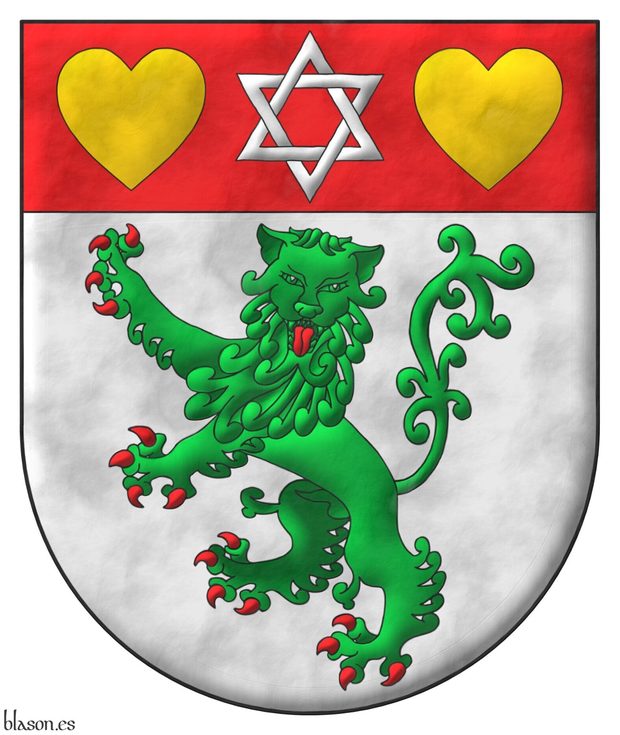
Argent, a lion rampant guardant Vert, armed and langued Gules; on a chief Gules, a mullet of six points voided, interlaced Argent between two hearts Or.
Escudo de plata, un leopardo leonado de sinople, armado y lampasado de gules; un jefe de gules cargado de una estrella de seis puntas, hueca y entrelazada de plata acompañada de dos corazones de oro.
Arms interpreted by me, illuminated with lights and shadows, outlined in Sable, with a semi-circular external shape and with a texturized finishing.
The coat of arms of Yishay Ifrah emblazoned by me. Alternative blazon: «Argent, a lion rampant guardant Vert, armed and langued Gules; a chief Gules charged with a star of David Argent between two hearts Or».
Blazon keywords: Argent, Vert, Gules, Or, One, Two, Lion rampant guardant, Armed, Langued, Chief, Charged, Star of David, Mullet, Voided, Interlaced, Between and Heart.
Style keywords: Outlined in sable, Illuminated and Semi-circular.
Classification: Personal, Interpreted, Boa and Coat of arms.
Bearer: Ifrah, Yishay.


![Ver [In bend and palewise] en criterios utilizados. Unicornio saltante sobre la divisa, criterio.](../css/Unicornio.Criterio.png)
In bend and palewise
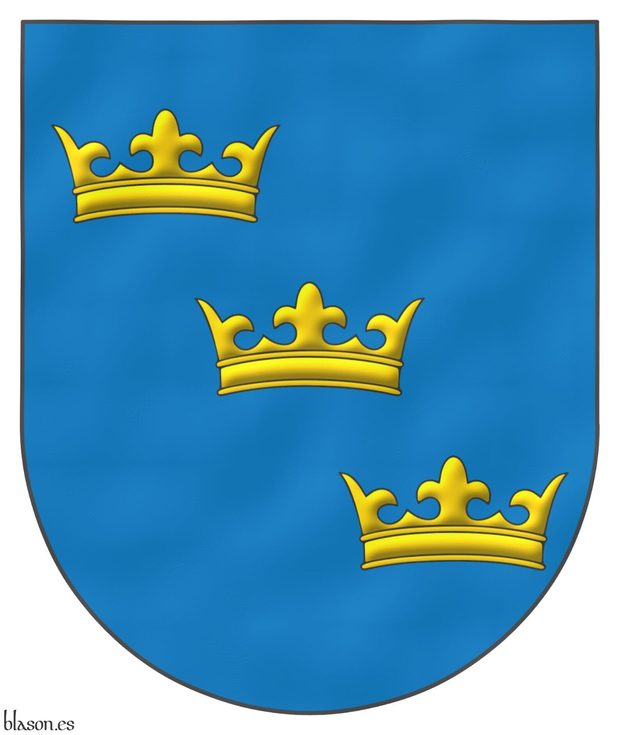
Azure, three crowns in bend, palewise Or.
Escudo de azur, tres coronas en banda, puestas en palo de oro.
Although the crowns are placed palewise, their natural position, since they are also along the bend, then specifying in the blazon that they are placed palewise can avoid the error of placing them rotated.
- En banda ~ in bend.
- Puesto en palo ~ palewise.
In the coats of arms of the members of The Heraldry Society, as in many other places, cases of «puesto en palo» ~ «palewise» can be seen, for example:
- Stephen Richard Shires tiene por armas «Gyronny of eight Gules and Vert on a bend Argent between two pairs of keys saltirewise wards upwards and outwards Or a bend Sable charged with three towers palewise masoned in stretcher blocks Argent and header blocks Sable». The natural position of a tower is «puesta en palo», that is, «palewise», but in this case, being charged on a bend, «...a bend Sable charged with three towers...» there might be doubt if its orientation also follows that of the bend, which is why the clarification «palewise» seems most appropriate to me.
- David Boven tiene por armas «Per bend grady Sable and Gules two vines in bend overall a bow palewise all within a bordure Or, for difference».
- «palewise» is also used in the crest, as is the case with John Hamilton Gaylor, who bears the arms «Per fess Argent and Gules a dance flory parted per dance Sable and Argent» and for crest «A demi-griffin Sable armed Or holding a key palewise its wards in chief and to the sinister proper».
Blazon keywords: Without divisions, Azure, Or, Crown, In bend and Palewise.
Style keywords: Semi-circular, Outlined in sable and Watercolor.
Classification: Criterion.
Bearer: In and wise.


![Ver [Inescutcheon with the arms of Brutus of Britain] en criterios utilizados. Unicornio saltante sobre la divisa, criterio.](../css/Unicornio.Criterio.png)
Inescutcheon with the arms of Brutus of Britain
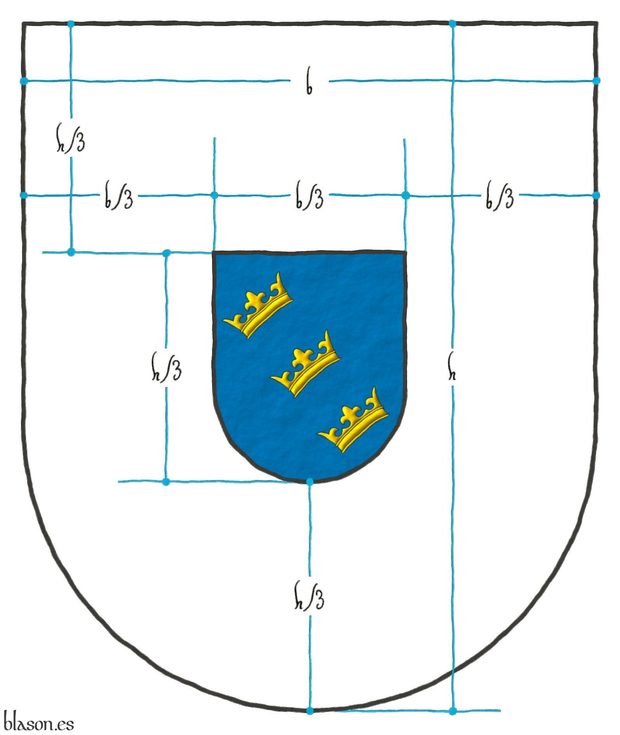
On an inescutcheon Azure, three crowns in bend, bendwise Or.
Escusón de azur, tres coronas en banda, puestas en banda de oro.
Coat of arms interpreted by me as follows: the field is enameled in plain Azure ink; the three crowns are outlined in Sable, illuminated in Or and shaded; and the imaginary shield has a crystalline finish.
Construction process of the inescutcheon of the banner with the inescutcheon of Edward IV from the coat of arms of Brutus of Britain.
Blazon keywords: Inescutcheon.
Style keywords: Illuminated, Semi-circular, Outlined in sable and Watercolor.
Classification: Schema, Interpreted, Imaginary, Kingdom of England and Criterion.
Imaginary bearer: Brutus of Britain.


Innocent IV
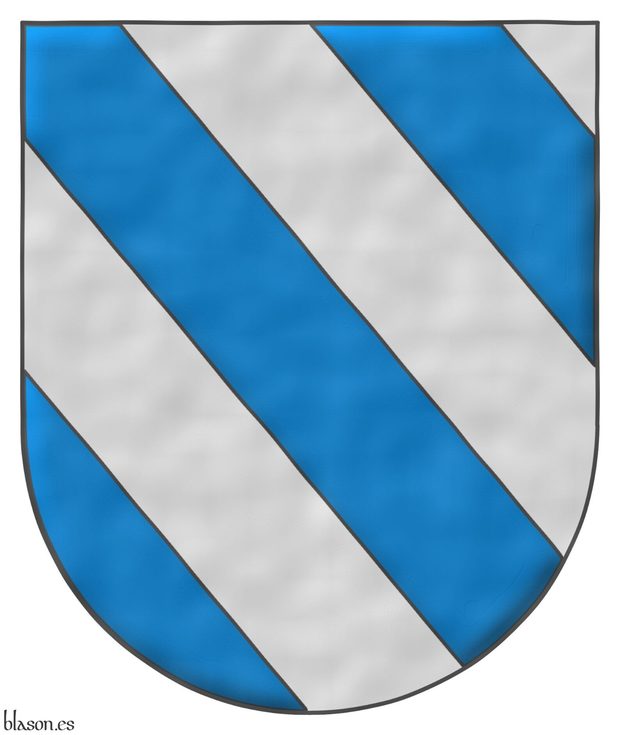
180th Pope of the Church, from 1243 to 1254. «Innocentius IV», born Sinibaldo dei Fieschi, was born in Manarola in northwest Italy.
Bendy of six Azure and Argent.
Escudo bandado de seis piezas de azur y plata.
Papal coat of arms interpreted by me with: a semicircular shield shape; a plain Argent field; bands illuminated in Azure and outlined in Sable; and the whole design with a watercolor finish.
Order of tinctures
In the bendy pattern, the tinctures are named starting from the one located at the dexter base of the shield and following an ascending sequence towards the sinister chief, although the most orthodox approach is to have only 2 tinctures, being one color and one metal.
Number of bands
It is said that it is not necessary to specify the number of bands when there are precisely 6, as in this case, and that it should be specified when there are, for example, 4 or 8. I have chosen to specify it for greater clarity of the blazon.
About the bendy pattern and the need to specify or not specify the number of its pieces, [Avilés, J.; 1725a; pages 40 and 41] and [Avilés, J.; 1780a; pages 45 and 46] say that it is «composed of four, six, or eight bends; in such a way that there are as many colors as metals, always specifying the number four and eight bands when blazoning, and not the one composed of six, as it is understood thus, without declaring the number of pieces» and without agreeing with it, and by its wording I believe that he is not entirely in agreement either, he adds «the reason that may exist for not specifying the number of six bends (although the authors do not express it) is that as the bend is one-third of the shield; and having six pieces, or six bends, the resulting number is doubled, as if the three parts were divided, which implies that the shield is filled with three bends; and taking the denomination of the figure infers, that the bendy is of six pieces: which does not happen with this equality in those of four and eight, requiring other proportions and consequently it becomes necessary to specify their number», therefore, note that the bendy of 6 does not follow the proportions of the bend, nor do those of 4 or 8, the only differential property of the one of 6 is being a multiple of 3, being 1/3 the width of the bend.
Blazon keywords: Without divisions, Bendy, Six, Azure and Argent.
Style keywords: Semi-circular, Illuminated, Outlined in sable and Watercolor.
Classification: Interpreted, Religious and Papal States.
Bearer: Innocent IV.


Ixai Lanzagorta Ochoa, schema 2x2
Argent, a chevron Sable and an ouroboros Azure, armed and langued Sable, interlaced.
The coat of arms of Ixai Lanzagorta Ochoa, designed by him, his father, Juan Lanzagorta Vallin, and me, and emblazoned by me in 4 steps: proportions, delineation, plain colors and metal, and lights and shadows. His favorite version is the flat, classic representation of his coat of arms.
Credits: Juan Lanzagorta Vallin is the designer of the coat of arms.
Blazon keywords: Argent, Sable, Azure, One, Chevron, Ouroboros, Armed, Langued and Interlaced.
Style keywords: Ratio, Outlined, Outlined in sable, Plain tincture, Illuminated and Semi-circular.
Classification: Personal, Created, Schema, Boa and Coat of arms.
Bearer: Lanzagorta Ochoa, Ixai.


Jacques de Molay
Azure, a bend Or. Behind the shield an eight-pointed cross patty Gules.
Blazon keywords: Azure, One, Bend, Or, Behind the shield, Eight-pointed cross, Cross couped and Gules.
Style keywords: Outlined in sable, Illuminated, Semi-circular and Freehand.
Classification: Religious, Military, Knights Templar, Interpreted and Coat of arms.
Bearer: Molay, Jacques de.


James de Sottone, le Fitz
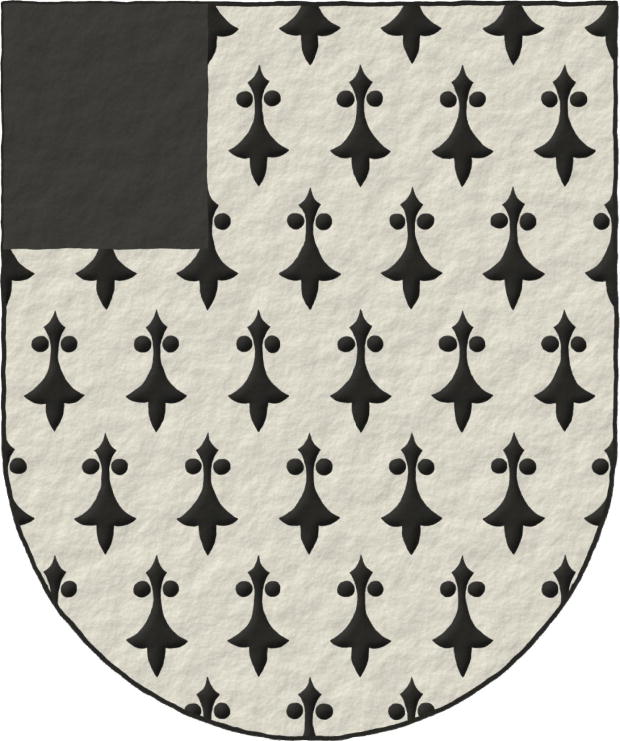
James de Sutton ~ James de Sottone, le Fitz.
Ermine, a canton Sable.
Escudo de armiños, un cantón de sable.
Included in [Vincent, MS; 1285; number 599] also known as [St. George's Roll; 1285; number 599].
Blazon keywords: Without divisions, Ermine, One, Canton and Sable.
Style keywords: Semi-circular and Illuminated.
Classification: Interpreted and Personal.
Bearer: Jaime de Sutton.


James I of Aragon
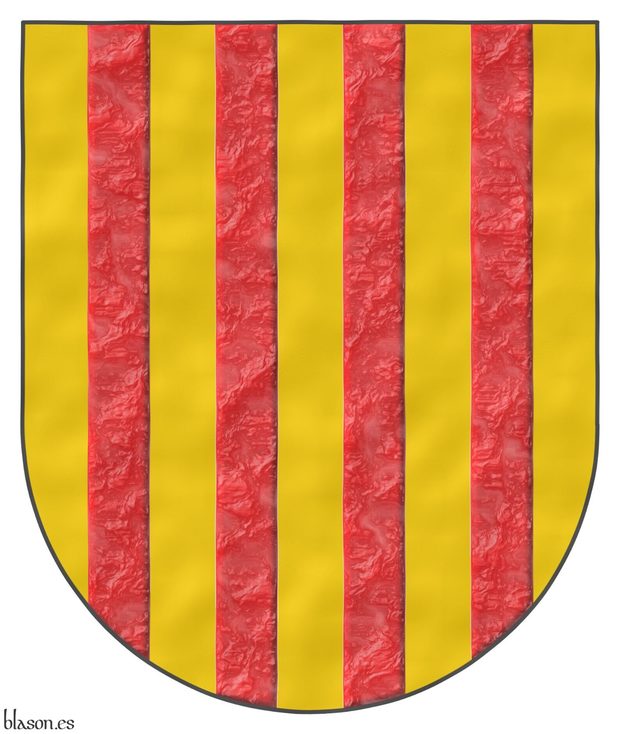
King of Aragon, Valencia and Majorca, Count of Barcelona, Count of Urgell, Lord of Montpellier and known as the Conqueror
Or, four pallets Gules.
Escudo de oro, cuatro palos de gules.
Coat of arms interpreted by me as follows: the escutcheon shape is semicircular; the field is rendered in flat Or with a watercolored effect; and the pallets are illuminated and finished with a crystalline texture.
A semicircular-shaped shield of Aragon can be seen, for instance, in [Argote de Molina, G.; 1588; chapter XLII].
This shield, but with a pointed base, appears in the second part of the armorial [Wijnbergen; 1265; shield no. 1,293], under the title «Le roy Darragon». This second part was compiled between 1270 and 1285 and, since James I was king of Aragon from 1213 to 1276, it could refer to him; although it might also refer to his son Peter III, the Great, who succeeded James I in 1276.
This coat of arms is also the arms of Aix-en-Provence, granted to that French city, according to tradition, by Alfonso II of Aragon [Aix-en-Provence; 1351], grandfather of James I, the Conqueror.
Blazon keywords: Without divisions, Or, Four, Pale and Gules.
Style keywords: Semi-circular, Illuminated, Watercolor and Crystalline.
Classification: Interpreted, Personal, Coat of arms and Kingdom of Aragon.
Bearer: James I of Aragon.


Jamilena
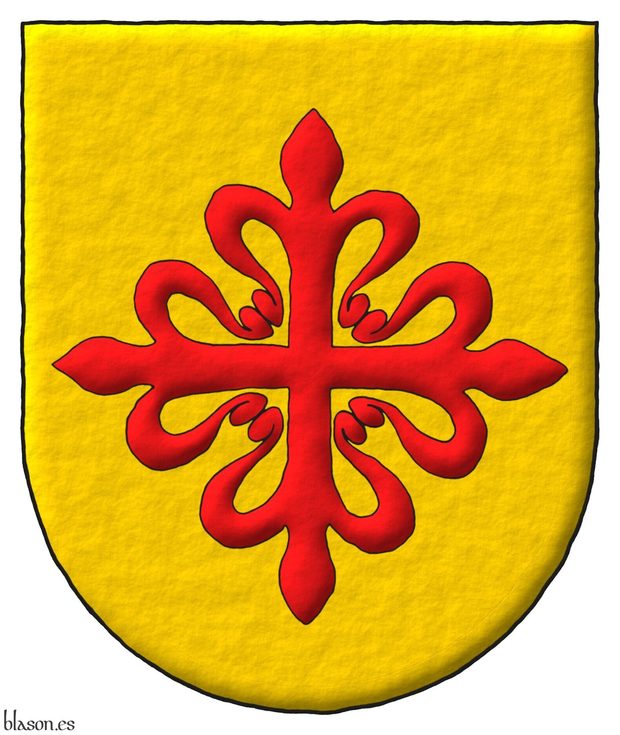
Coat of arms of the municipality of Jamilena, province of Jaén.
Or, a cross of Calatrava.
Escudo de oro, una cruz de Calatrava.
Coat of arms interpreted as follows: the shield's shape is a semicircular arch; the field is illuminated in metal Or; the cross of Calatrava is outlined in Sable and illuminated in Gules; and the entire piece has a rough line finish.
Blazon keywords: Without divisions, Or, Cross of Calatrava, Cross couped and Cross.
Style keywords: Semi-circular, Illuminated, Outlined in sable and Freehand.
Classification: Interpreted, Civic and Coat of arms.
Bearer: Jamilena.


Jan Bobor, structured and parallel blazons
Canting arms of Jan Bobor, Slovakia, emblazoned under his directions, with the blazon written in English and Castilian in a structured way to observe the parallelism between both forms.
Blazon keywords: Gules, Or, Argent, Azure, One, Three, Beaver, Erect, Armed, Tailed, Grasping, Dexter, Shoulder, Sword, Hilted, Chief, Embattled and Fleur de lis.
Style keywords: Outlined in sable, Plain tincture and Semi-circular.
Classification: Personal, Interpreted, Structured and parallel blazons, Boa and Coat of arms.
Bearer: Bobor, Jan.


Janovsti of Janovic of Czechia, lineage
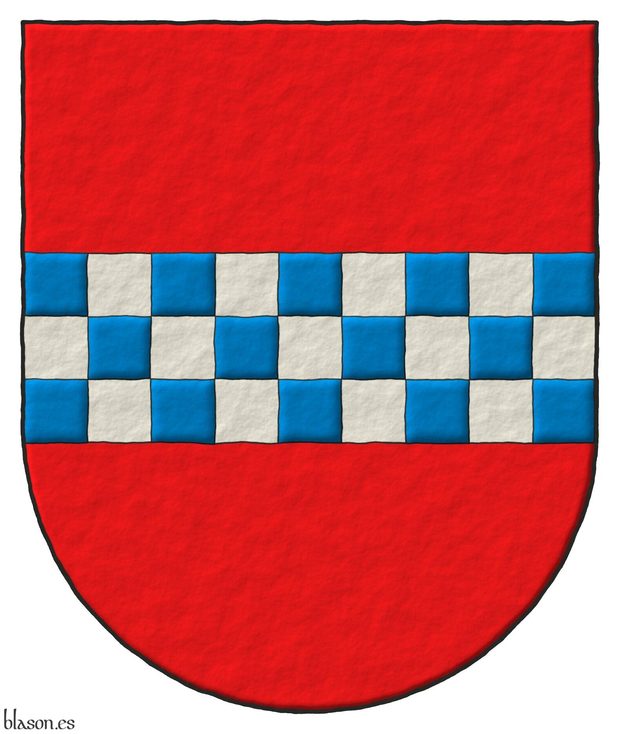
Gules, a fess chequey Azure and Argent.
Escudo de gules, una faja ajedrezada de azur y plata.
Arms emblazoned by me, highlighted with lights and shadows, contoured in Sable, with a semi-circular outer contour and with a freehand finish.
Coat of arms of the lineage Janovsti of Janovic of Czechia. It is also the coat of arms of the lineage Klenovsky of Klenove of Czech. I have emblazoned it with a fess chequy of 3 rows, symmetric and with 9 columns of squares, provided that its height is 1/3 of the width of the coat of arms.
Blazon keywords: Gules, Azure, Argent, One, Three, Nine, Fess and Chequey.
Style keywords: Outlined in sable, Illuminated, Semi-circular and Freehand.
Classification: Personal, Lineage, Interpreted, Boa and Coat of arms.
Bearer: Janovsti of Janovic of Czechia, lineage.
Blazon equivalent to: Lindsay of Scotland, lineage.


Javier Fernández-Cortés y Fonseca, motto
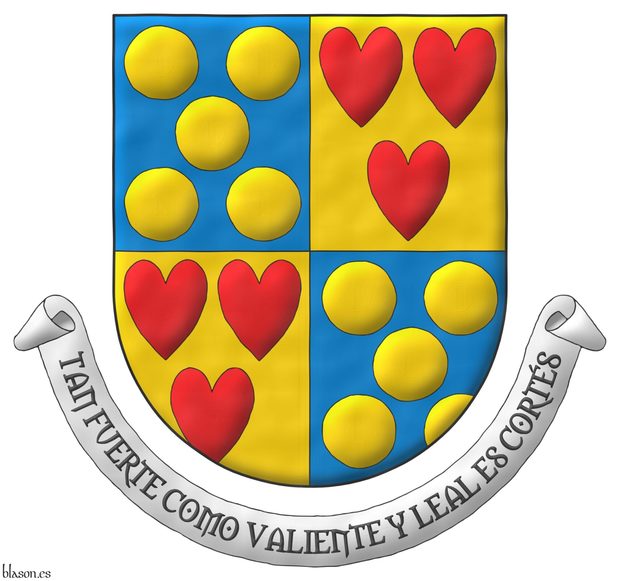
Quarterly: 1 and 4 Azure, five Bezants in saltire; 2 and 3 Or, three hearts Gules ordered. Motto: «Tan fuerte como valiente y leal es Cortés».
Watercolor finishing
Blazon keywords: Quarterly, Azure, Five, Bezant, Bezant and plate, In saltire, Or, Three, Heart, Gules, Ordered and Motto.
Style keywords: Watercolor, Semi-circular, Illuminated and Outlined in sable.
Classification: Coat of arms, Interpreted and Personal.
Bearer: Fernández-Cortés y Fonseca, Javier.


Jesus Christ, with bezants Or
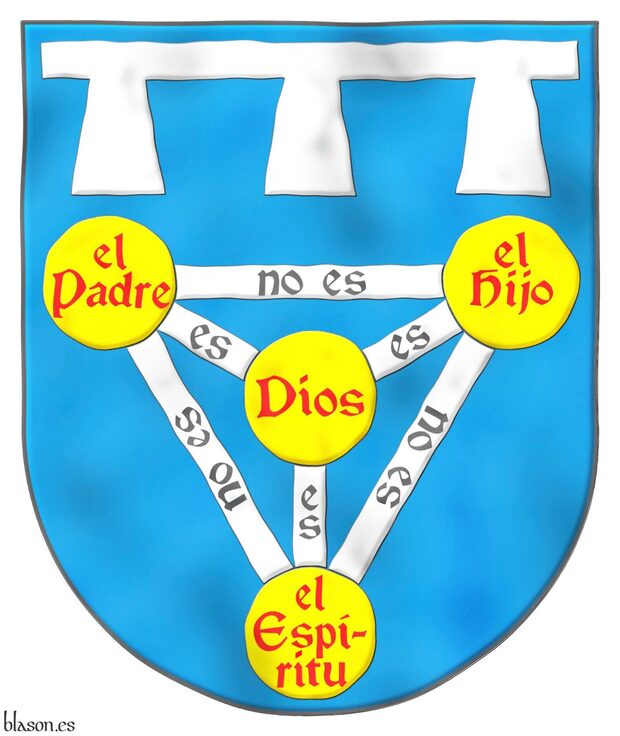
Azure, a pall couped Argent, its three arms charged with «es» Sable, within a triangle reversed Argent, its three arms charged with «no es» Sable, all debruised by four bezants, three on the vertex of the triangle, in dexter chief, charged with «el Padre», in sinister chief, charged with «el Hijo», in base, charged with «el Espítiru», and one on the fess point, charged with «Dios» Gules; in chief a label of three points Argent.
Escudo de azur, una perla recortada de plata, sus tres brazos cargados con «es» de sable, dentro de un triángulo ranversado de plata, sus tres brazos cargados con «no es» de sable, todo resaltado de cuatro bezantes de oro, tres sobre los vértices del triángulo, en la diestra del jefe, cargado de «el Padre», en la siniestra del jefe, cargado con «el Hijo», en la punta, cargado con «el Espítiru» y uno sobre el corazón, cargado con «Dios» todo de gules; en jefe un lambel de tres pendientes de plata.
Imaginary coat of arms that I have interpreted as follows: its base is semicircular (round); its field is illuminated in Azure; the rest is illuminated in Argent and outlined in Sable, except for the bezants which are Or and also outlined in Sable; its letters in plain tinctures, some Gules and others Sable; and the set with a glazed finish.
Pall
The pall (perla) as defined by [Avilés, J.; 1780a; page 239] is «a figure composed of three moving cotises, or that emerge from the two angles of the Chief and the Base, which meet in the center or heart of the Shield in the form of a Greek Y, as if this figure were formed from a half Saltire, and a half Pale».
Blazon keywords: Without divisions, Azure, One, Pall, Couped, Argent, Three, Charged, Letter, Sable, Within, Triangle, Reversed, Four, Bezant, In the dexter chief, In the sinister chief, In base, In the fess point, Gules, Cadency and Label of three points.
Style keywords: Semi-circular, Illuminated, Outlined in sable and Glass.
Classification: Religious, Interpreted, Imaginary and Coat of arms.
Imaginary bearer: Jesus Christ.


John de Ladbrooke
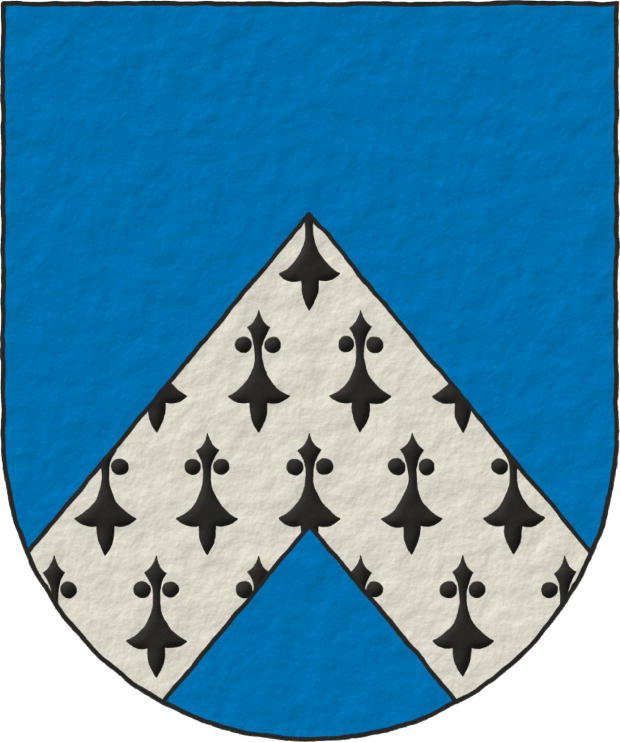
John de Ladbrooke ~ Joan de Lodbroke.
Azure, a chevron Ermine.
Escudo de azur, un cabrio de armiños.
Included in [Vincent, MS; 1285; number 662] also known as [St. George's Roll; 1285; number 662].
Blazon keywords: Without divisions, Azure, One, Chevron and Ermine.
Style keywords: Semi-circular, Illuminated and Outlined in sable.
Classification: Interpreted and Personal.
Bearer: Juan de Ladbrooke.


John I of England
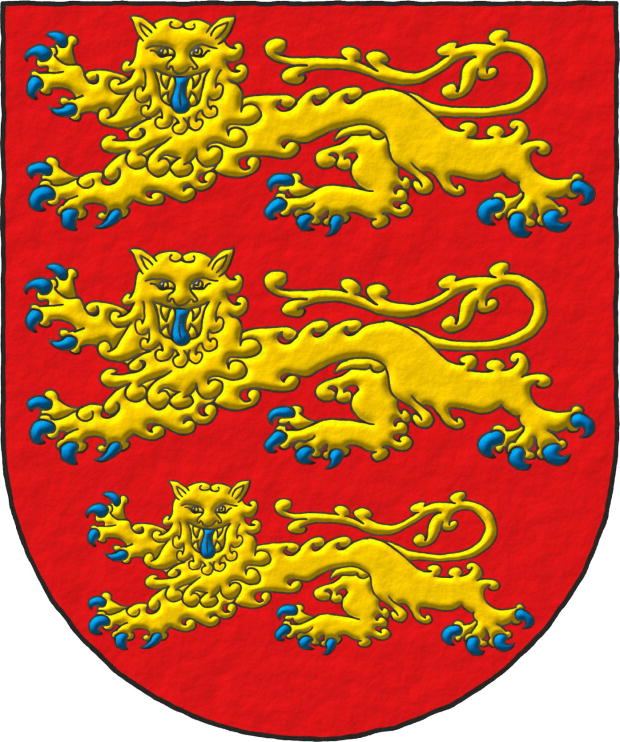
John Lackland ~ Juan sin Tierra ~ Sans-Terre.
Gules, three lions, passant, guardant, in pale Or, armed and langued Azure.
Escudo de gules, tres leopardos en palo de oro, armados y lampasados de azur.
Existing arms interpreted as follows: the mouth of the coat of arms is semicircular (round); the field has been enamelled in a flat tint of Gules; the three leopards are outlined in Sable and illuminated in Or and Azure; and the whole is executed with a raised-stroke effect.
Regarding this version of the shield of John I, [Humphery-Smith, C.; 1983] writes that «Richard's younger brother John... bore two lions because he was a junior member of the Plantagenet line», thus showing his belonging to a second level of the ruling family, although, after his brother Richard I of England, he not only ended up being king but it was also his line of succession that continued to reign in England.
Blazon keywords: Without divisions, Gules, Or, Azure, Three, Leopard, Armed, Langued and In pale.
Style keywords: Semi-circular, Illuminated, Outlined in sable and Freehand.
Classification: Interpreted, Personal, Coat of arms, House of Plantagenet and Kingdom of England.
Bearer: John I of England.


Jon Sneddon, arms on tartan
Argent, three lozenges Sable; on a chief wavy Azure, three snowflakes Argent.
Heraldic device emblazoned by me, highlighted with lights and shadows, outlined in Sable, with a semi-circular external shape and with a watercolor finishing.
The coat of arms of Jon Sneddon emblazoned by me over his personal tartan registered in the Scottish Register of Tartans. John Sneddon designed his tartan with the help of Elliot Nesterman.
Blazon keywords: Argent, Sable, Azure, Three, Lozenge, Chief, Charged, Wavy, Snowflake and Ordered.
Style keywords: Outlined in sable, Illuminated, Semi-circular and Watercolor.
Classification: Personal, Interpreted, Boa and Tartan.
Bearer: Sneddon, Jon.


Jose Manuel Gutiérrez Benítez, plain tincture
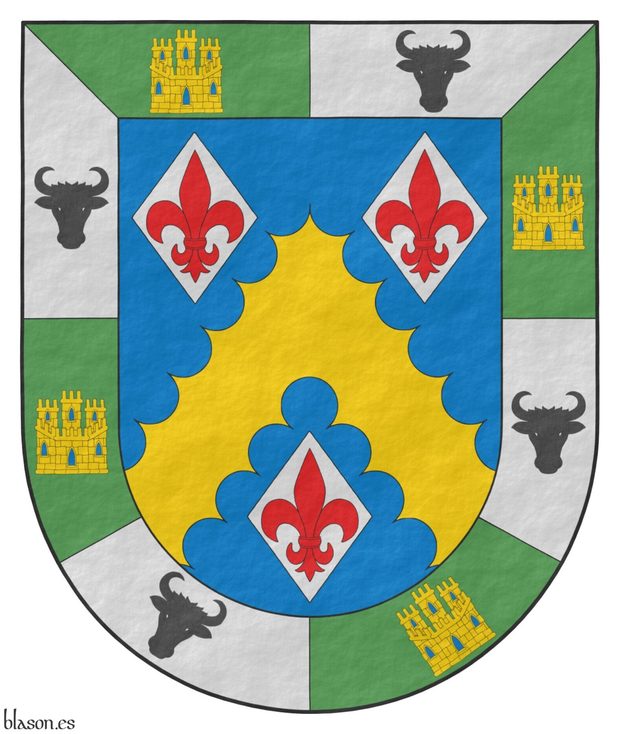
Azure, a chevron engrailed Or between three lozenges Argent, each charged with a fleur de lis Gules; a bordure compony of eight sections, four Vert each charged with a castle triple-towered Or, port and windows Azure, masoned Sable, and four Argent each charged with a bull's head caboshed Sable.
Arms designed by me, in flat tinctures, contoured in Sable, with a semi-circular outer contour and with a texturized finish.
This is the coat of arms of Jose Manuel Gutierrez Benitez designed by him and me and emblazoned by me.
Blazon keywords: Azure, Or, Argent, Gules, Vert, Sable, One, Three, Four, Eight, Chevron, Engrailed, Lozenge, Fleur de lis, Bordure, Compony, Castle, Triple-towered, Port and windows, Masoned, Bull, Head and Caboshed.
Style keywords: Outlined in sable, Plain tincture and Semi-circular.
Classification: Personal, Created, Boa and Coat of arms.
Bearer: Gutiérrez Benítez, Jose Manuel.


José Manuel Villauriz Álvarez, outlined
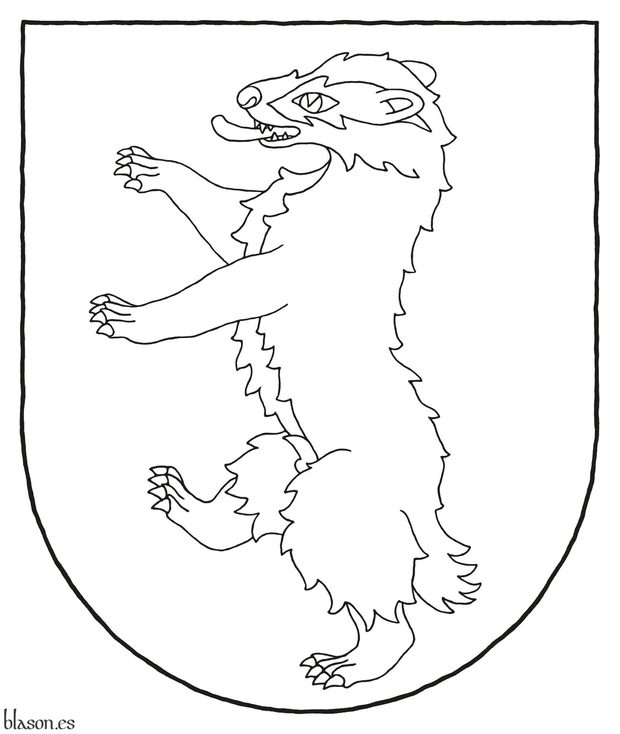
Or, a badger rampant Sable.
Coat of arms of Jose Manuel Villauriz Alvarez, outlined by me under the directions of Alfonso Ceballos-Escalera Gila, Cronista de Armas de Castilla y Leon.
Blazon keywords: Or, Sable, One, Badger and Rampant.
Style keywords: Outlined and Semi-circular.
Classification: Personal, Interpreted, Boa and Coat of arms.
Bearer: Villauriz Álvarez, José Manuel.


Juan Bautista Lanzagorta Escutia, plain tincture
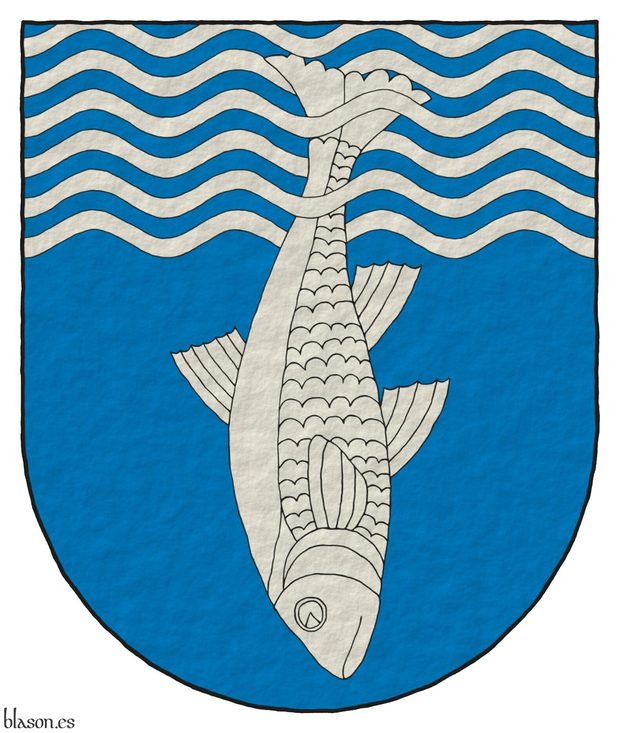
Azure, a chief wavy and barry wavy of twelve Azure and Argent debruised and interlaced by a fish urinant Argent.
Coat of arms of Juan Bautista Lanzagorta Escutia designed by Juan Lanzagorta Vallín and emblazoned by me.
Blazon keywords: Azure, Argent, One, Twelve, Chief, Wavy, Barry, Debruised, Interlaced, Fish and Urinant.
Style keywords: Ratio, Outlined, Outlined in sable, Plain tincture and Semi-circular.
Classification: Personal, Interpreted, Boa and Coat of arms.
Bearer: Lanzagorta Escutia, Juan Bautista.


Juan Lanzagorta Aras, plain tincture
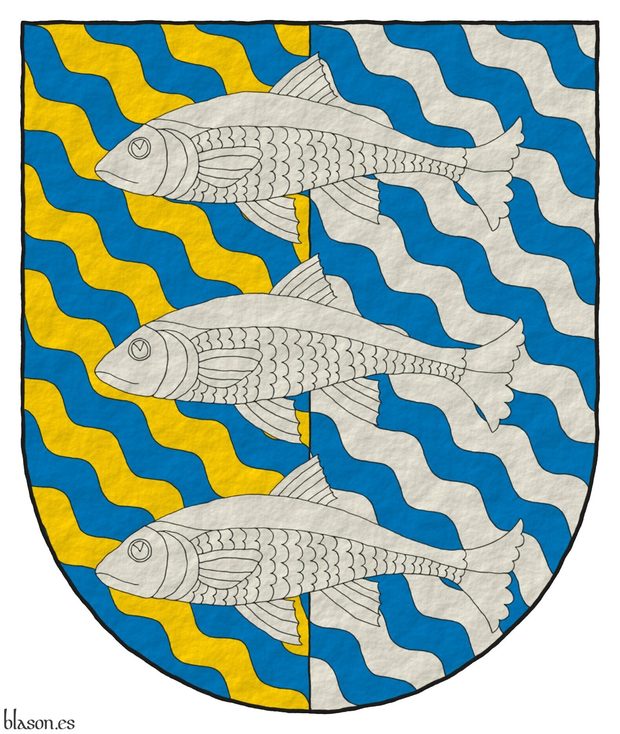
Party per pale bendy wavy Azure and Or and bendy wavy Azure and Argent, overall three fish naiant in pale Argent.
Arms painted by me, in plain tinctures, contoured in Sable, with a semi-circular external shape and with a texturized finishing.
Coat of arms of Juan Lanzagorta Aras designed by Juan Lanzagorta Vallín and emblazoned by me. Note that the second quarter begins and ends in Argent; therefore, while the first quarter is properly bendy, having an even number of bands and beginning in Or and ending in Azure, the second is not, as it has an odd number. It is almost impossible to align both quarters so that the wavy bands continue seamlessly from one to the other. Heraldically, such continuity is not required, but artistically it makes much more sense. For this reason, in this case, I chose to prioritize the artistic criterion of continuity, even if the second quarter ends with a small strip of Argent instead of finishing in Azure.
Blazon keywords: Azure, Or, Argent, Three, Party per pale, Bendy, Wavy, Overall, Fish, Naiant and In pale.
Style keywords: Outlined in sable, Plain tincture and Semi-circular.
Classification: Personal, Interpreted, Boa and Coat of arms.
Bearer: Lanzagorta Aras, Juan.


Kingdom of Jerusalem
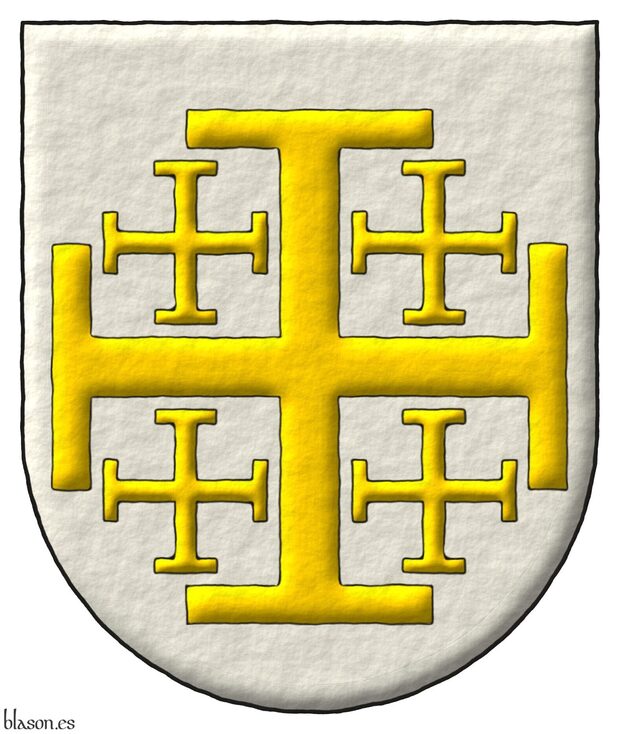
Metal Or over metal Argent.
Argent, a cross potent cantoned of four crosslets potent Or.
Escudo de plata, una cruz potenzada cantonada de cuatro cruces potenzadas todas de oro.
Illuminated with lights and shadows and with a freehand finish.
Perhaps the most classic example of non-compliance with the heraldic rule of tinctures having metal Or over metal Argent. In [Galdiano L.; Century XVII; folio 6], you can see a version of the arms of Jerusalem with the field in Gules, which would indeed follow the rule of tinctures as it is metal on color.
Blazon keywords: Without divisions, Argent, One, Cross potent, Cross couped, Cantoned, Four and Or.
Style keywords: Freehand, Outlined in sable, Illuminated, Semi-circular and Metal on metal.
Classification: Interpreted and Civic.
Bearer: Kingdom of Jerusalem.


Kingdom of Spain, schema 2x2
Quarterly: 1 Gules, a castle triple-towered Or, port and windows Azure, masoned Sable [for Castile]; 2 Argent, a lion rampant Purpure, armed and langued Gules, crowned Or [for Leon]; 3 Or, four pallets Gules [for Aragon]; 4 Gules, a chain orlewise, crosswise, and saltirewise Or, charged in the fess point with an emerald Vert [for Navarre]; enté en point Argent, a pomegranate proper, seeded Gules, slipped and leaved Vert [for Granada]; an inescutcheon Azure, three fleurs de lis Or, 2 and 1, a bordure Gules [for Bourbon].
The figure illustrates my construction scheme outlined with my main proportions for the coat of arms of the Kingdom of Spain. The scheme is conceptually divided into three horizontal rectangles of equal height: the first one dedicated to the Royal Crown, the second to the quarters of Castile and and Leon, and the third rectangle to the quarters of Aragon and Navarre. The width of the central inescutcheon is defined as 1/3 of the total shield width. The curve of the enté en point of Granada is designed such that the resulting shapes in the quarter for Aragon and the quarter for Navarre are symmetrical, evoking the form of a pointed shield.
Blazon keywords: Gules, Azure, Purpure, Vert, Or, Argent, One, Three, Four, Quarterly, Castle, Triple-towered, Port and windows, Masoned, Lion, Rampant, Crowned, Pallet, Chain, Orlewise, Crosswise, Saltirewise, Charged, In the fess point, Emerald, Enté en point, Pomegranate, Proper, Slipped, Leaved, Inescutcheon, Fleur de lis, Ordered and Bordure.
Style keywords: Ratio, Outlined, Outlined in sable, Illuminated and Semi-circular.
Classification: Civic, Kingdom of Spain, Interpreted, Schema, Boa and Coat of arms.
Bearer: Spain, Kingdom of.


Labarrieta N, María

Azure semé of moons with human face Argent, a sword point upwards Gules, the sinister of its blade debruised by a moon with human face Argent both bend sinisterwise.
Escudo de azur sembrado de lunas figuradas de plata, una espada alzada de gules, la siniestra de su hoja resaltada de una luna figurada de plata ambas puestas en barra.
Coat of arms depicted by me, in plain tinctures, contoured in Sable, with a semi-circular external shape and with a texturized finish.
The coat of arms of María Labarrieta N. designed by Juan Lanzagorta Vallín and emblazoned by me.
Blazon keywords: Azure, Argent, Gules, One, Semé, Moon, With human face, Sword, Point upwards, Sinister, Debruised and Bend sinisterwise.
Style keywords: Outlined in sable, Plain tincture and Semi-circular.
Classification: Personal, Interpreted, Boa and Coat of arms.
Bearer: Labarrieta N, María.


Larkin, Kevin
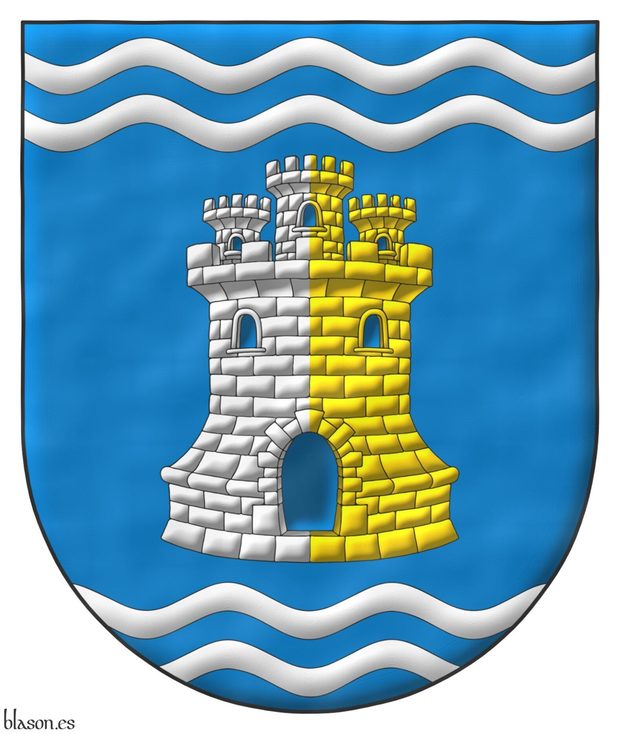
Azure, a castle triple-towered per pale Argent and Or, masoned Sable, port and windows Azure, between in chief two bars wavy Argent, in base two bars wavy Argent.
Escudo de azur, un castillo partido de plata y oro, mazonado de sable, aclarado de azur, acompañado en jefe de dos fajas ondadas de plata, y en en punta de dos fajas ondadas de plata.
Coat of arms devised by me, highlighted with lights and shadows, outlined in Sable, with a semi-circular outer contour and with a watercolor finishing.
The arms of Kevin Larkin from Ireland and Spain, designed and emblazoned by me. Blazon in French: «D'azur à la tour partie d'argent et d'or, donjonnée de trois tourelles, maçonnée de sable, ouverte et ajourée du champ, accompagnée en chef et en pointe de deux jumelles ondées d'argent».
Blazon keywords: Azure, Argent, Or, One, Two, Castle, Triple-towered, Party per pale, Masoned, Port and windows, Between, In chief, Bar, Wavy and In base.
Style keywords: Outlined in sable, Illuminated, Semi-circular and Watercolor.
Classification: Personal, Created, Boa and Coat of arms.
Bearer: Larkin, Kevin.


Larre, lineage of Bayonne, French Basque Country
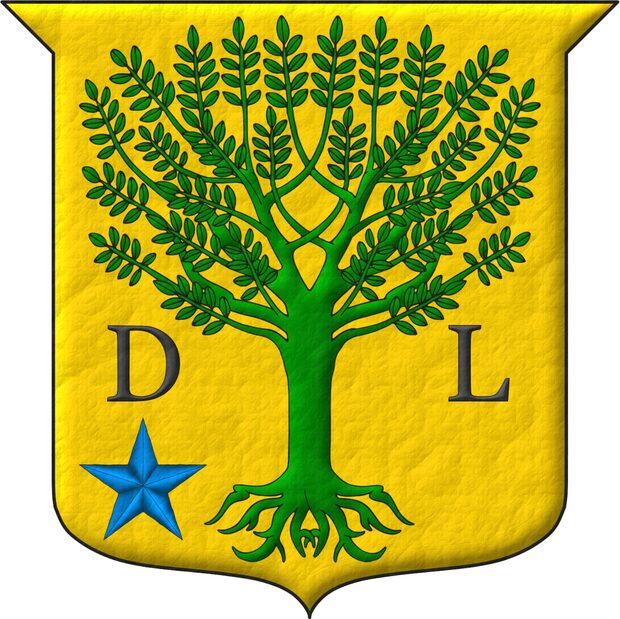
D'or à un arbre arraché de sinople, accosté à dextre de la lettre capitale «D» et à senestre de la lettre capitale «L» du même, et une étoile d'azur posée au canton dextre de la pointe.
Or, a tree eradicated Vert between a capital letter «D» and a capital letter «L» Sable, in the dexter of the base a mullet Azure.
Illuminated with lights and shadows and with a leather finish.
Blazon keywords: Without divisions, Or, One, Tree, Erased, Vert, Between, Letter, Sable, Canton, Dexter, Base (lower 1/3), Mullet, Five and Azure.
Style keywords: Leather, Outlined in sable, Illuminated and Semi-circular.
Classification: Interpreted, Lineage and Kingdom of France.


Lazaro of Aragon, lineage
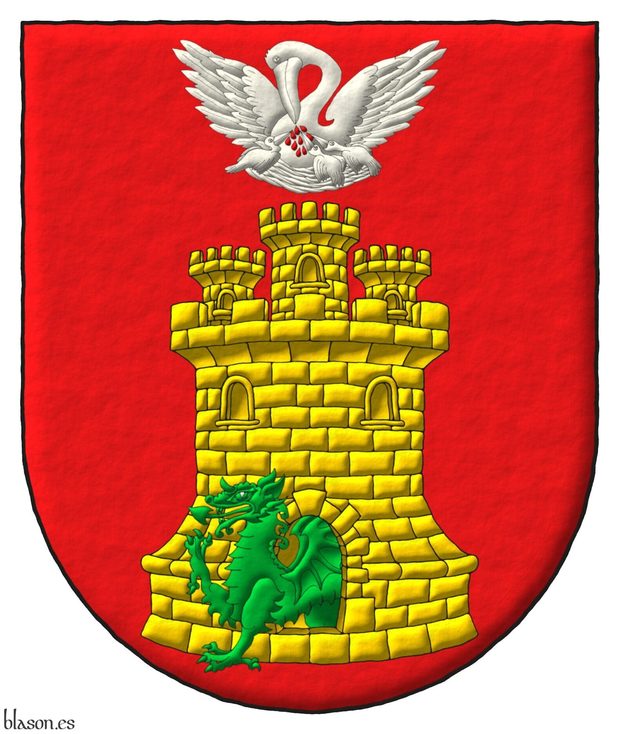
Gules, a castle triple-towered Or, masoned Sable, issuant from its port a dragon passant Vert, in chief a pelican in her piety Argent, vulned Gules.
Escudo de gules, un castillo de oro, mazonado de sable y saliendo por su puerta un dragón pasante de sinople, en jefe un pelícano desplegado de plata, la piedad de gules.
Coat of arms interpreted by me, highlighted with lights and shadows, outlined in Sable, with a semi-circular outer contour and with a freehand finishing.
Ancient arms of the lineage Lazaro of Aragon emblazoned by me.
Blazon keywords: Gules, Or, Vert, Argent, One, Castle, Triple-towered, Masoned, Issuant (port), Dragon, Passant, In chief, Pelican in her piety and Pelican.
Style keywords: Outlined in sable, Illuminated, Semi-circular and Freehand.
Classification: Personal, Lineage, Interpreted, Boa and Coat of arms.
Bearer: Lazaro of Aragon, lineage.


Lete of Navarre
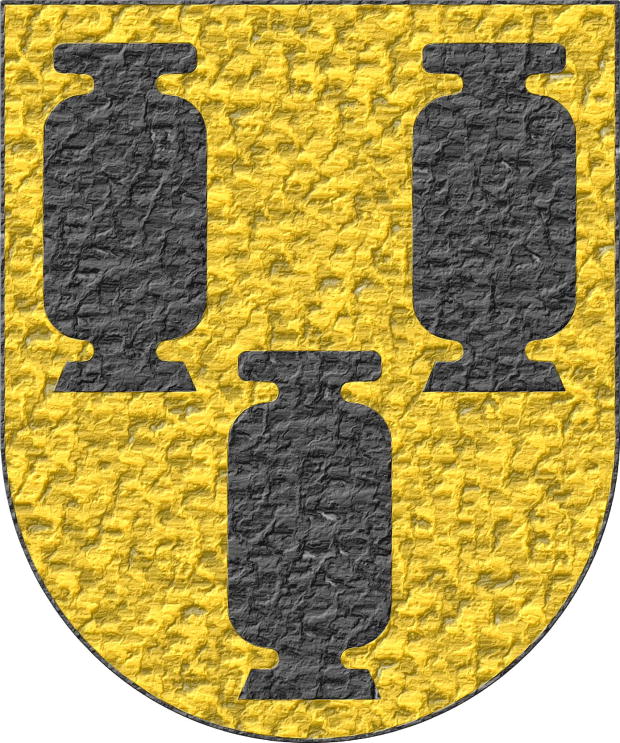
Of the twelve lineages of Noblemen, the sixth is that of Lete, from which descended Don Juan Corbarán de Let: they bear as arms, on a field Or, three pots shaped like cauldrons, slightly elongated, as painted in this shield.
Or, three Fleshpot Sable.
Escudo de oro, tres potes de sable.
Coat of arms interpreted with: a semicircular (round) base; the field in flat Or metal; the three pots illuminated in Sable with vertical, but not horizontal symmetry; and finished in highly-hammered metal.
It is not easy to find in English a similar figure:
- it could be considered «pote» ~ «pot», although perhaps «pot» is too generic,
- another possibility is «pote» ~ «fleshpot», which, although usually represented with three legs instead of a base and with two handles, is the one I tend to prefer,
- the English term «cauldron», but this corresponds to our «caldero» ~ «cauldron».
Coat of arms based on the sixth of the Navarrese «ricoshombres» from [Bosque, J. del; 1540; folio 1 of the numbering of 1613]. The text heading this article is taken from the transcription made by [Martinena Ruiz, J. J.; 1982; pages 122 and 123].
Although I have not found any reference about it, it could be considered that originally they might have been canting arms and that these three «potes» could have been milk pots, in reference to their bearers «Lete».
Under the title «Surname of Let» it can also be consulted in [Vega, P. J. de; 1702; folio 6 of the manuscript], although the number has been altered, possibly having been a 5 and perhaps interpreted as an 8, it is deduced by being placed after folio 7.
Blazon keywords: Without divisions, Or, Clay pot and Sable.
Style keywords: Semi-circular, Illuminated and Hard metal.
Classification: Interpreted, Personal, Kingdom of Navarre and Canting.
Bearer: Lete of Navarre.


Lindsay of Scotland, lineage
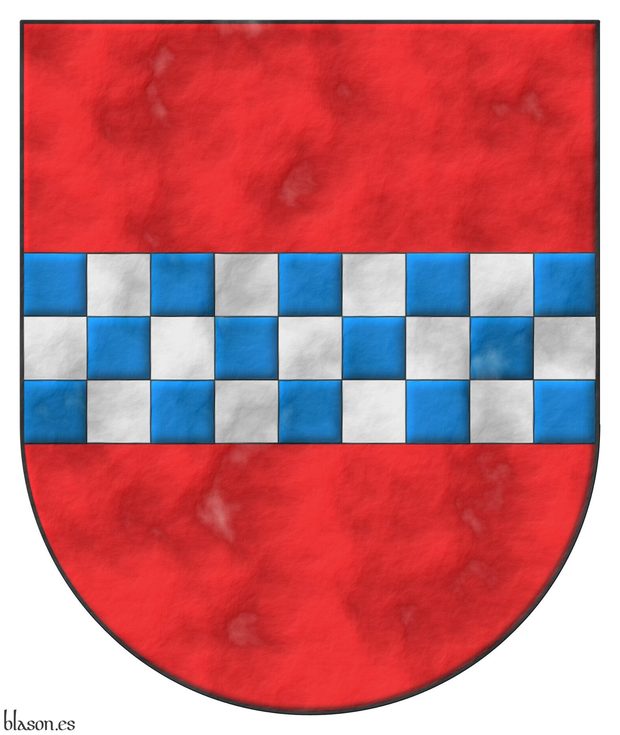
Gules, a fess chequey Azure and Argent.
Escudo de gules, una faja ajedrezada de azur y plata.
Arms depicted by me, highlighted with lights and shadows, outlined in Sable, with a semi-circular external shape and with a parchment finishing.
Coat of arms of the lineage Lindsay of Scotland. I have emblazoned it with a fess chequy of 3 rows, symmetric and with 9 columns of squares, provided that its height is 1/3 of the width of the coat of arms.
Blazon keywords: Gules, Azure, Argent, One, Three, Nine, Fess and Chequey.
Style keywords: Outlined in sable, Illuminated, Semi-circular and Parchment.
Classification: Personal, Lineage, Interpreted, Boa and Coat of arms.
Bearer: Lindsay of Scotland, lineage.
Blazon equivalent to: Janovsti of Janovic of Czechia, lineage.


Lindsay of the Byres, lineage
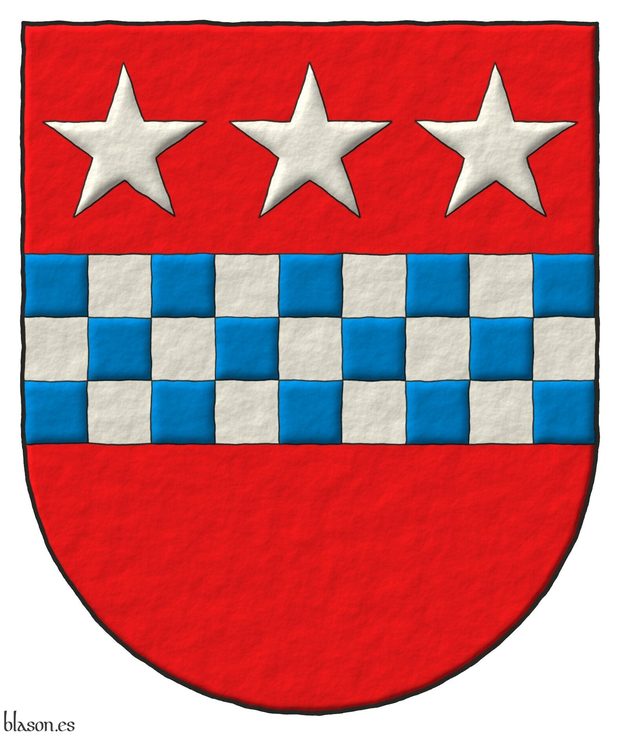
Gules, a fess chequey Azure and Argent, in chief three mullets of five points Argent.
Escudo de gules, una faja ajedrezada de azur y plata, en jefe tres estrellas de cinco puntas de plata.
Arms interpreted by me, highlighted with lights and shadows, outlined in Sable, with a semi-circular outer contour and with a freehand finish.
Coat of arms of the lineage Lindsay of the Byres. I have emblazoned it with a fess chequy of 3 rows, symmetric and with 9 columns of squares, provided that its height is 1/3 of the width of the coat of arms.
Blazon keywords: Gules, Azure, Argent, One, Three, Nine, Fess, Chequey, In chief and Mullet.
Style keywords: Outlined in sable, Illuminated, Semi-circular and Freehand.
Classification: Personal, Lineage, Interpreted, Boa and Coat of arms.
Bearer: Lindsay of the Byres, lineage.


Lineage Mark of Germany, collage
[ Or, a fess chequey Gules and Argent ] · [ Or, a fess chequey Azure and Argent ] · [ Gules, a fess chequey Azure and Argent ] · [ Gules, a fess chequey Azure and Argent ] · [ Azure, a fess chequey Gules and Argent ].
Diagram featuring the coat of arms of the lineage Mark of Germany with the coats of arms of Stewart of Scotland, Janovští z Janovic, Klenovský z Klenové of Czechia, and Lindsay and Boyd of Scotland.
Blazon keywords: Or, Gules, Argent, Azure, One, Three, Nine, Fess and Chequey.
Style keywords: Outlined in sable, Illuminated, Semi-circular and Iridescent.
Classification: Personal, Lineage, Interpreted, Schema, Boa and Coat of arms.
Bearer: Mark of Germany, lineage.


Lineage Peraza of Cantabria, plain tincture
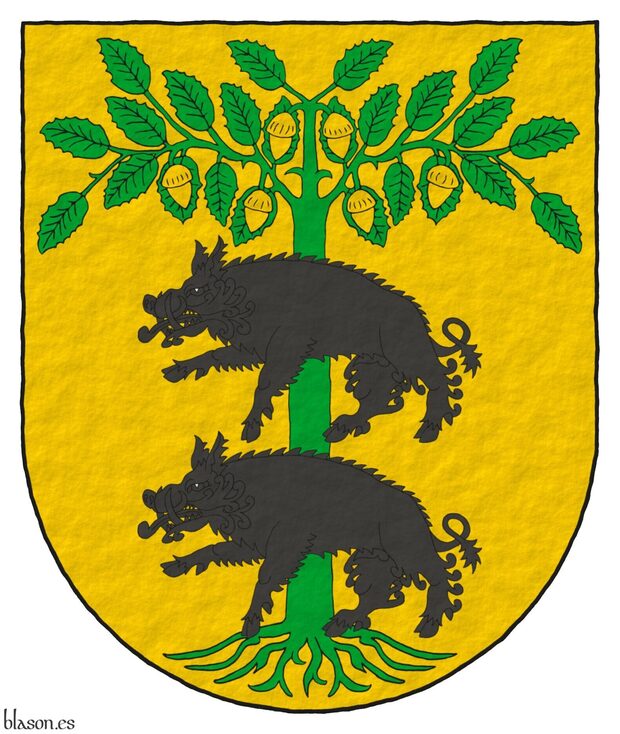
Or, a holm oak eradicated Vert, fructed Or, in front of its trunk two boars passant, in pale Sable.
Arms painted by me, in plain tinctures, contoured in Sable, with a semi-circular external shape and with a texturized finish.
Ancient arms of the lineage Peraza of Cantabria emblazoned by me. Around the year 1235, the solar house of Peraza was established in the Carriedo Valley, Cantabria. From this house descended Fernando de Peraza, Castellan and Governor of the Old Fortress of Aguilar in the land of Campo, Judicial District of Villalón, Valladolid, and another Fernando Ibárjez de Peraza, Lieutenant Governor of the Castle of Zurita, on the banks of the Zurita, after it was reconquered by King Alfonso VIII. The Peraza family connected with the Great House of Ayala and adopted the surname Peraza de Ayala.
Blazon keywords: Or, Vert, Sable, Holm oak, Eradicated, Fructed, In front (tree), Trunk, Boar, Passant and In pale.
Style keywords: Outlined in sable, Plain tincture and Semi-circular.
Classification: Personal, Lineage, Interpreted, Boa and Coat of arms.
Bearer: Peraza of Cantabria, lineage.


Loubet del Bayle, Jean-Christophe
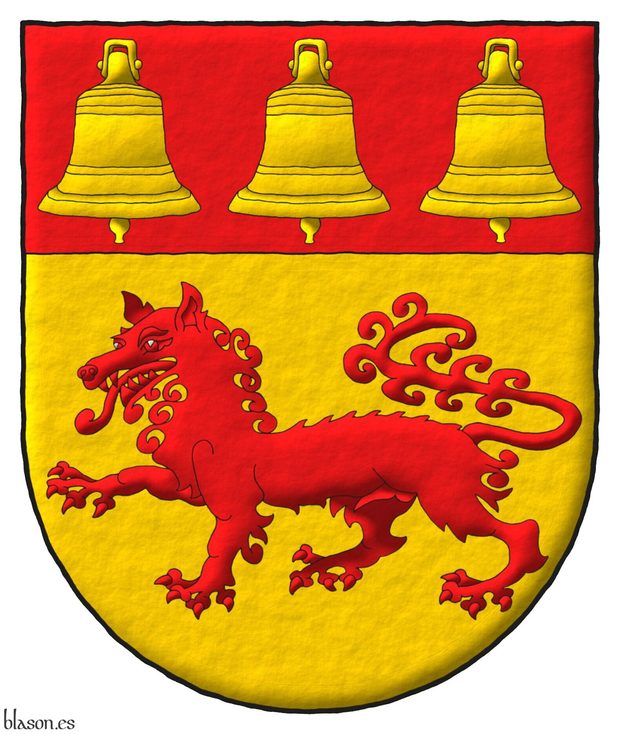
Or, a wolf passant Gules; on a chief Gules, three bells Or.
Escudo de oro, un lobo pasante de gules; en un jefe de gules, tres campanas de oro.
Coat of arms painted by me, highlighted with lights and shadows, outlined in Sable, with a semi-circular external shape and with a freehand finish.
The coat of arms of Jean-Christophe Loubet del Bayle emblazoned by me.
Blazon keywords: Or, Gules, One, Three, Wolf, Passant, Chief and Bell.
Style keywords: Outlined in sable, Illuminated, Semi-circular and Freehand.
Classification: Personal, Interpreted, Boa and Coat of arms.
Bearer: Loubet del Bayle, Jean-Christophe.


Louis IX of France
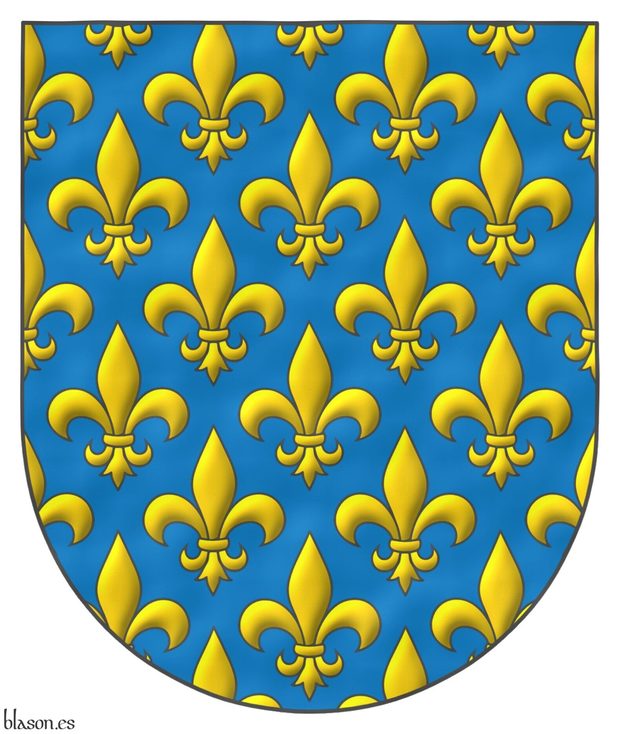
Saint Louis, King of France (1214-1270), son of Blanche of Castile.
Azure semé of fleurs de lis Or.
Escudo de Azur sembrado de flores de lis de oro.
Coat of arms interpreted by me as follows: the shield has a semicircular (round) base; the field is enamelled in flat Azure; the fleurs-de-lis are outlined in Sable and illuminated in Or; and finished with a watercolor effect.
Toward the end of his reign, the armorial called [Wijnbergen; 1265] was created, whose first part is devoted to recording his coat of arms [Wijnbergen; 1265; shield no. 1], which was also that of his father Louis VIII, husband of Blanche of Castile, and the coats of arms of those who were his vassals.
Blazon keywords: Without divisions, Azure, Or, Semé and Fleur de lis.
Style keywords: Semi-circular, Illuminated, Outlined in sable and Watercolor.
Classification: Interpreted, Personal, Coat of arms, Kingdom of France and House of the Capetians.
Bearer: Louis IX of France.


Lozengy 5x6 and 6x7
There are 2 rhombuses in heraldry: the lozenge and the fusil. I like to represent the lozenge, which is a less elongated rhombus than the fusil, as a square with its 2 diagonals placed one vertically and the other horizontally. Lozengy and fusilly consist of filling the entire space with lozenges, in the first case, or with fusils, in the second case, joined 4 by 4 at their corners.
[Avilés, J.; 1780a; page 25] writes «Fusils, Lozenges, and Mascles can be accolados, when they touch with their flanks; and to be so called, the entire Shield must not be filled with these figures, because in that case it would be called Fusilly, or Fuselado and Lozengy.».
In this case, two lozengy schemata of lozenges are presented with their 4 angles at 90o, the first 5 wide by 6 high, which is exact because the angles are 90o and it matches the 5x6 dimensions of the coat of arms and the second 6 wide by 7 high, which may be more suitable for shields that resemble the structure of per pale of three.
In [Cadenas y Vicent, V. de; 1987] one can see written both «losange» with «g» and «losanje» with «j», although the occurrences of «losange» with «g» are more than double those of «losanje» with «j».
In [Royal Spanish Academy; 2014] only the term «losange» with «g» is recorded, it says it comes from the French «losange» and defines it as «a rhombus figure placed so that one of the acute angles is at the base and its opposite at the top.».
Blazon keywords: Lozengy and Lozenge.
Style keywords: Semi-circular.
Classification: Schema.


Lozengy, comparison between 5x6 and 6x7
Comparison between lozengy of 5x6 lozenges and 6x7 lozenges based on the coats of arms of Thomas de Warbrentone and of Pierre de Forcade. It can be observed that, for example, in the case where there is a central pale of Gules, this fits better over the metal Or in the lozengy of smaller lozenges, the 6x7 one, than in the lozengy of larger lozenges, the 5x6 one.
Blazon keywords: Lozengy and Lozenge.
Style keywords: Semi-circular.
Classification: Schema.


Lucius III
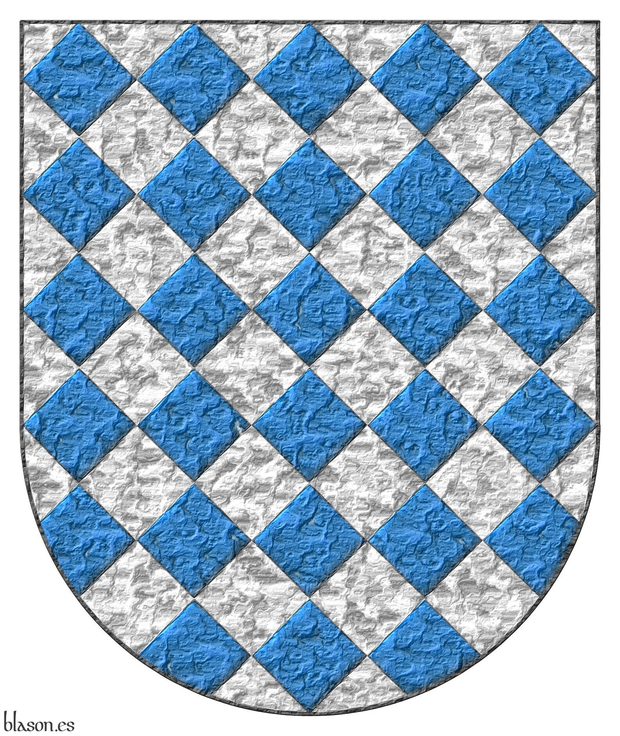
171st Pope of the Church, from the year 1181 to the year 1185. «Lucius III», born Ubaldo Allucinoli, was born in Lucca in northwest Italy.
Lozengy Argent and Azure.
Escudo losanjado de plata y azur.
Papal coat of arms interpreted by me with: a semicircular shield shape; a plain Argent field; checky or squares illuminated in Azure and outlined in Sable; and the whole design with a watercolor finish.
Blazon keywords: Without divisions, Lozengy, Argent and Azure.
Style keywords: Semi-circular, Illuminated, Outlined in sable and Hard metal.
Classification: Interpreted, Religious and Papal States.
Bearer: Lucius III.


Malka Gittel Bas Reuven, page of armorial
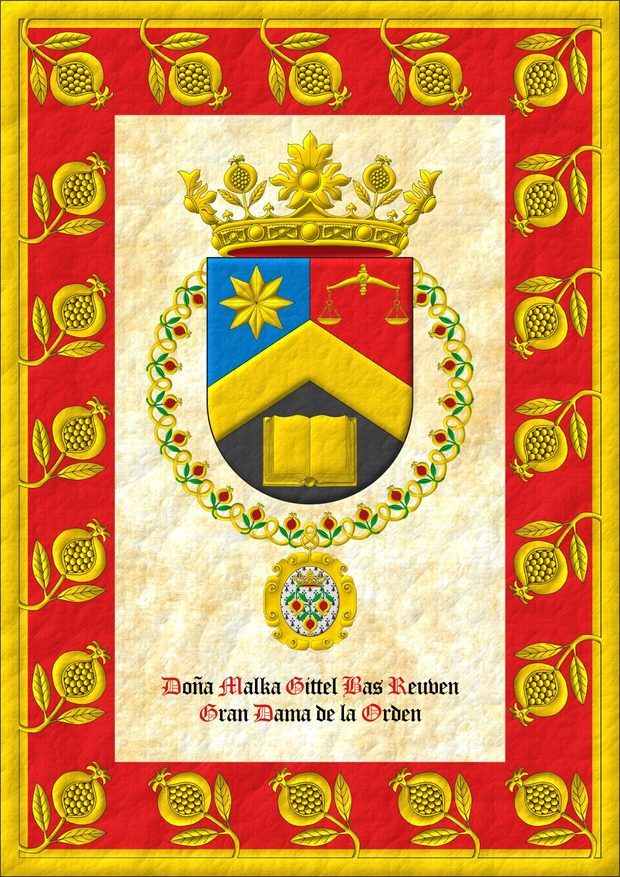
Tierced pallwise inverted Azure, Gules, and Sable; overall a chevron between, in the dexter of the chief, a mullet of six points, in the sinister of the chief a pair of scales, and in base an open book Or.
It has been painted by me, illuminated with lights and shadows, contoured in Sable, with a semi-circular outer contour and with a texturized finish.
Coat of arms of Her Excellency Ratu Muda Malka Bas Reuven emblazoned by me with for the Roll of Arms of the Soberana y Muy Noble Orden de la Granada.
Blazon keywords: Azure, Gules, Sable, Or, One, Six, Tierced pallwise inverted, Overall, Chevron, Between, Dexter, Chief, Mullet, Sinister, Pair of scales, In base, Open book, Book, Crown of the Sovereign and Most Noble Order of the Pomegranate, Crown, Surrounded and Collar.
Style keywords: Outlined in sable, Illuminated and Semi-circular.
Classification: Personal, Interpreted, Boa, Armorial roll and Castilian language.
Bearer: Gittel Bas Reuven, Malka.


Malvin de Montazet, lineage of Languedoc
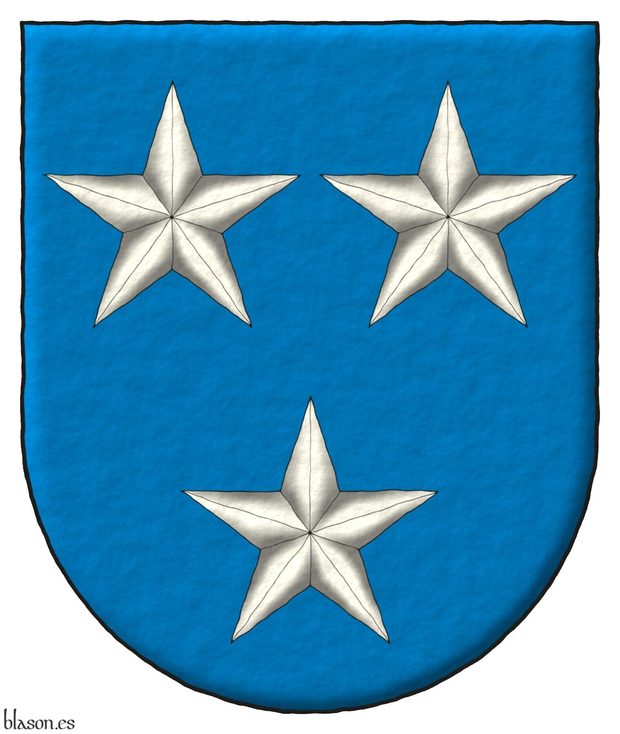
Blazon of the Malvin de Montazet lineage of Languedoc, France.
Azure, three mullets Argent, 2 and 1.
Illuminated and a freehand finishing.
Its French blazon «d'azur, à trois étoiles d'argent, 2 et 1» can be found at [Rietstap, J. B.; 1861; page 140].
Blazon keywords: Without divisions, Azure, Three, Mullet, Argent and Ordered.
Style keywords: Freehand, Outlined in sable, Illuminated and Semi-circular.
Classification: Interpreted, Lineage and Kingdom of France.


Manuel Beninger, page of armorial
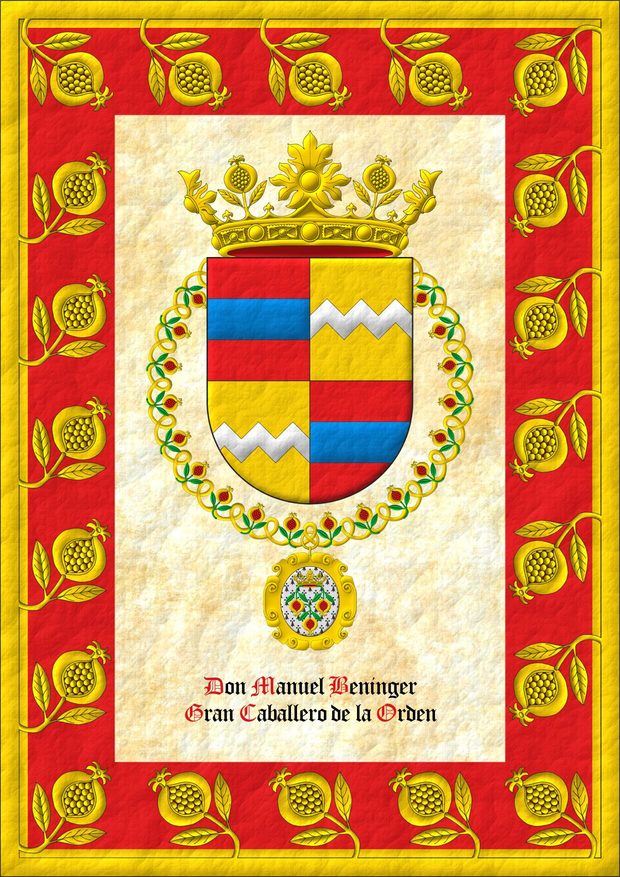
Quarterly: 1 and 4 Gules, a fess Azure; 2 and 3 Or, a fess dancetty Argent. Crest: A crown of the Sovereign and Most Noble Order of the Pomegranate. The shield is surrounded by the Grand Collar of the Sovereign and Most Noble Order of the Pomegranate.
This is his coat of arms of emblazoned by me for the Roll of Arms of the Sovereign and Most Noble Order of the Pomegranate.
Blazon keywords: Quarterly, Gules, One, Fess, Azure, Or, Dancetty, Argent, Crest and mantling, Crown, Pomegranate, Surrounded and Grand collar.
Style keywords: Colour on colour, Metal on metal, Semi-circular, Outlined in sable, Illuminated and Leather.
Classification: Personal, Interpreted, Coat of arms, Armorial roll and Castilian language.
Bearer: Beninger, Manuel.


María Dolores Escutia Sánchez, plain tincture
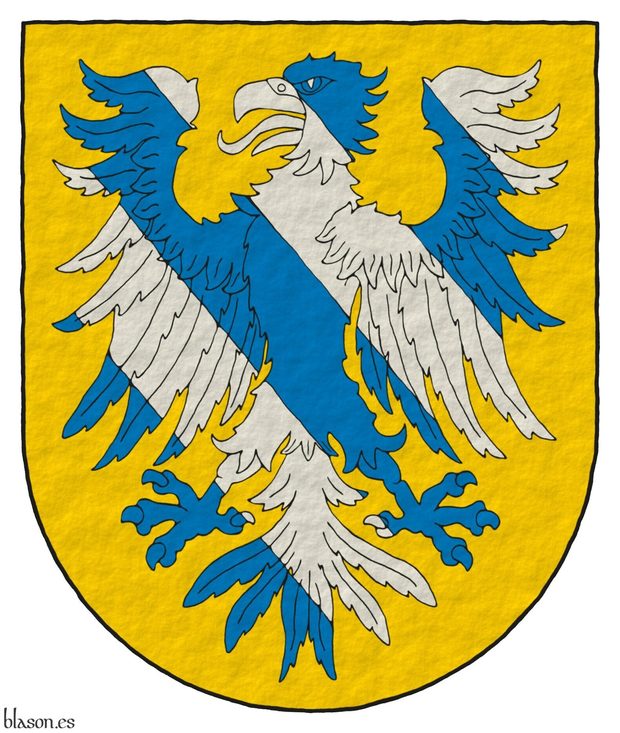
Or, an eagle displayed bendy Azure and Argent.
Coat of arms emblazoned by me, in plain tinctures, contoured in Sable, with a semi-circular external shape and with a texturized finish.
Coat of arms of María Dolores Escutia Sánchez designed by Juan Lanzagorta Vallín and emblazoned by me. In the case of a bendy field like that of this eagle, it is not immediately clear whether it should be blazoned as bendy Azure and Argent, or rather as bendy Argent and Azure. I have followed the criterion of starting to list the tinctures from the dexter chief, that is, from the upper part of the eagle’s dexter wing, and therefore I blazon it as bendy Azure and Argent.
Blazon keywords: Or, Azure, Argent, One, Eagle, Displayed and Bendy.
Style keywords: Outlined in sable, Plain tincture and Semi-circular.
Classification: Personal, Interpreted, Boa and Coat of arms.
Bearer: Escutia Sánchez, María Dolores.


Mark, County of
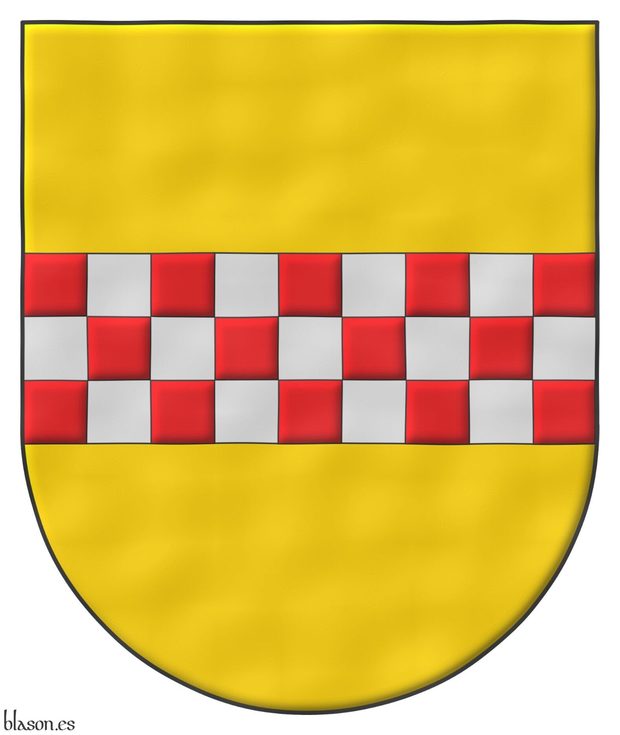
Or, a fess chequey Gules and Argent.
Escudo de oro, una faja ajedrezada de gules y plata.
Arms emblazoned by me, highlighted with lights and shadows, outlined in Sable, with a semi-circular external shape and with a watercolor finish.
Coat of arms of the County of Mark, Germany. I have emblazoned it with a fess chequy of 3 rows, symmetric and with 9 columns of squares, provided that its height is 1/3 of the width of the coat of arms.
Blazon keywords: Or, Gules, Argent, One, Three, Nine, Fess and Chequey.
Style keywords: Outlined in sable, Illuminated, Semi-circular and Watercolor.
Classification: Civic, Interpreted, Boa and Coat of arms.
Bearer: Mark, County of.


Mascarenhas, lineage of Portugal
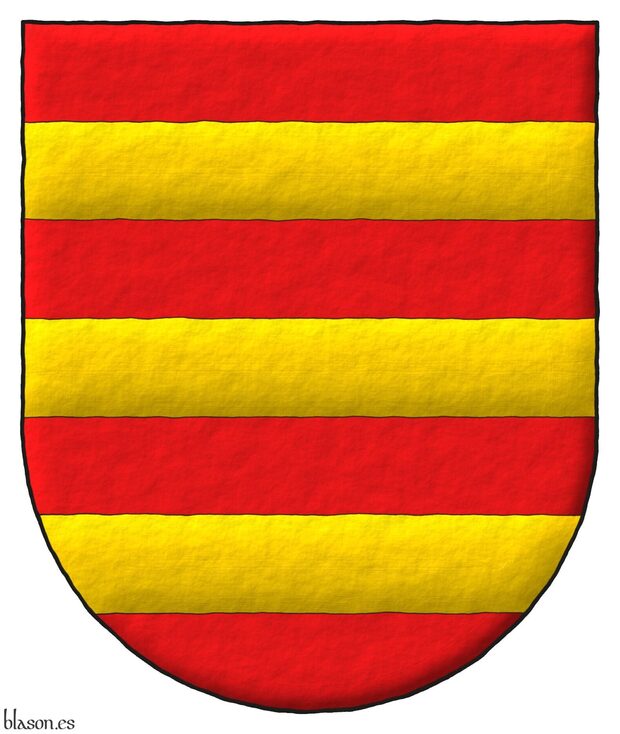
Blazon of the Mascarenhas lineage of Portugal.
Gules, three bars Or.
Illuminated and a freehand finishing.
It can be found at [Cró, J. do; 1509; page 77].
Blazon keywords: Without divisions, Gules, Three, Fess and Or.
Style keywords: Freehand, Outlined in sable, Illuminated and Semi-circular.
Classification: Interpreted, Lineage and Kingdom of Portugal.


Mauleón of Navarre
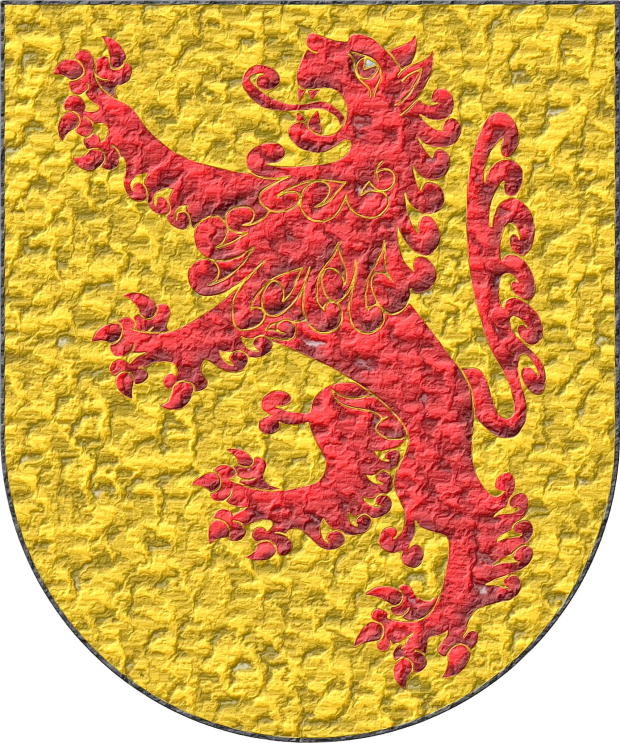
Of the twelve lineages of Noblemen, the twelfth bears as insignia and arms, on a shield Or, a rampant lion Gules, as painted in this shield.
Or, a Lion Gules, rampant.
Escudo de oro, un león de gules, rampante.
Coat of arms interpreted with: a semicircular (round) base; the field in flat Or; the lion illuminated in Gules and outlined in the colour of the field, that is, in Or metal; and the whole finished in highly-hammered metal.
Coat of arms interpreted from the last of the shields of the Navarrese «ricoshombres» illustrated in [Bosque, J. del; 1540; folio 1 of the numbering of 1613] and with the text preceding the blazon taken from the transcription by [Martinena Ruiz, J. J.; 1982; pages 122 and 123].
I consider these to be canting arms, and that this «lion» Gules refers to its bearers «Mauleón».
Under the title «Surname of Mauleon», without an accent on the letter «o», it can be consulted in [Vega, P. J. de; 1702; folio 12 of the manuscript].
Blazon keywords: Without divisions, Or, Lion, Gules and Rampant.
Style keywords: Semi-circular, Illuminated, Outlined in sable and Hard metal.
Classification: Interpreted, Personal, Kingdom of Navarre and Canting.
Bearer: Mauleón of Navarre.


McCartney, Michael
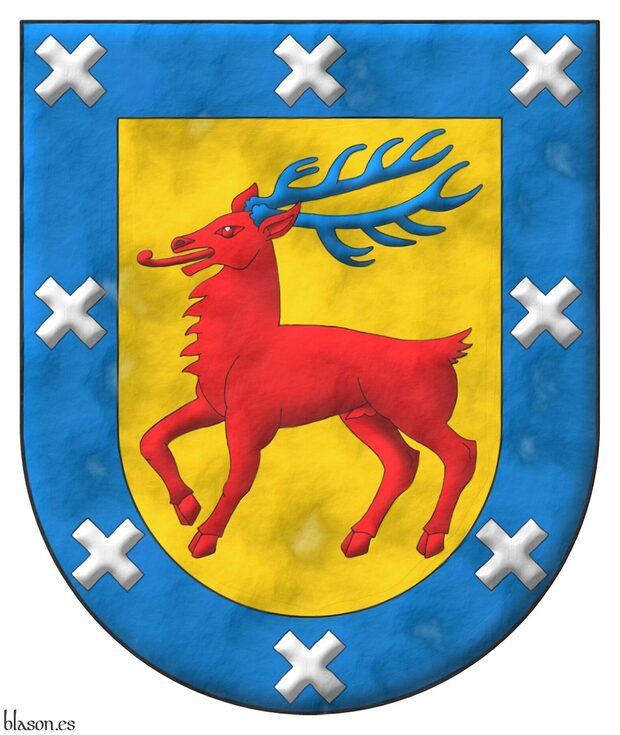
Or, a stag trippant Gules, attired Azure; a bordure Azure charged with eight saltires couped Argent.
Escudo de oro, un ciervo pasante de gules, acornado de azur; una bordura de azur cargada con ocho sotueres de plata.
Coat of arms interpreted and emblazoned by me with with a semi-circular ended shape, illuminated, and with a parchment finishing.
Blazon keywords: Without divisions, Or, One, Stag, Tripant, Gules, Attired, Azure, Bordure, Charged, Eight, Saltire and Argent.
Style keywords: Parchment, Outlined in sable, Illuminated and Semi-circular.
Classification: Interpreted and Coat of arms.
Bearer: McCartney, Michael.


Mediterranean, Sea of the
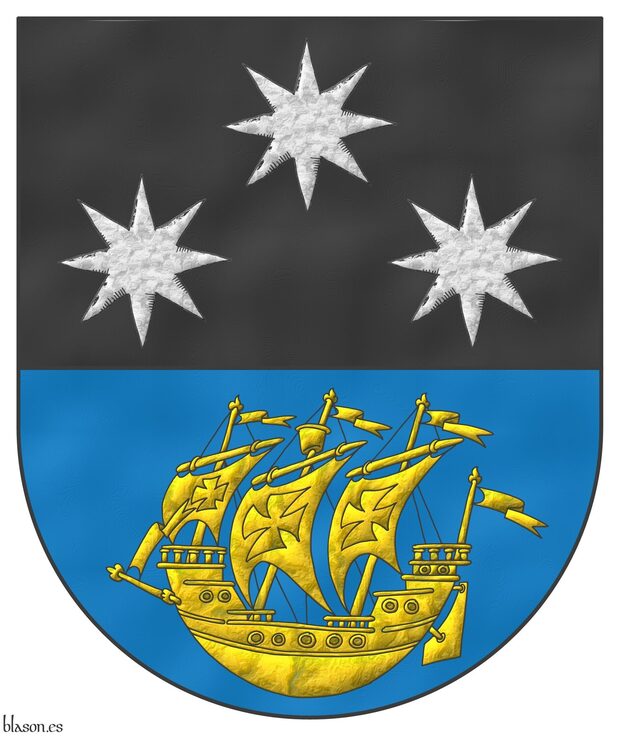
Party per fess: 1 Sable, three mullets of eight points Argent, 1 and 2; 2 Azure, a ship in full sail Or.
Escudo cortado: 1o de sable, tres estrellas de plata de ocho puntas, 1 y 2; 2o de azur, un barco de oro.
Arms devised by me, highlighted with lights and shadows, outlined in Sable, with a semi-circular external shape and with a watercolor finish.
Blazon keywords: Sable, Argent, Azure, Or, Three, Eight, One, Party per fess, Mullet, Disordered, Ship and Full sail.
Style keywords: Outlined in sable, Illuminated, Semi-circular and Watercolor.
Classification: Imaginary, Created, Boa and Coat of arms.
Imaginary bearer: Mediterranean, Sea of the.


Milian, family
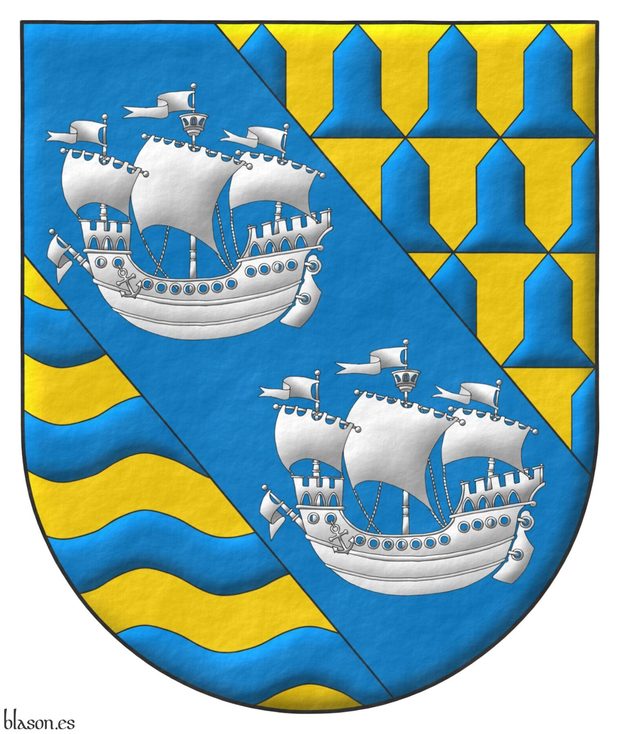
Tierced per bend: 1 vairy Or and Azure; 2 Azure, two ships in full sail, in bend Argent; 3 Or, four bars wavy Azure.
Escudo terciado en banda: 1o verado de oro y azur; 2o de azur, dos barcos en banda de plata; 3o de oro, cuatro burelas ondadas de azur.
Arms designed by me, highlighted with lights and shadows, outlined in Sable, with a semi-circular outer contour and with a rough finishing.
The coat of arms of the Milian family, created by me following their suggestions.
Blazon keywords: Or, Azure, Argent, Two, Four, Tierced per bend, Vairy, Ship, Full sail, In bend, Bar and Wavy.
Style keywords: Outlined in sable, Illuminated, Semi-circular and Rough.
Classification: Personal, Created, Boa and Coat of arms.
Bearer: Milian, family.


Moguer, municipality of
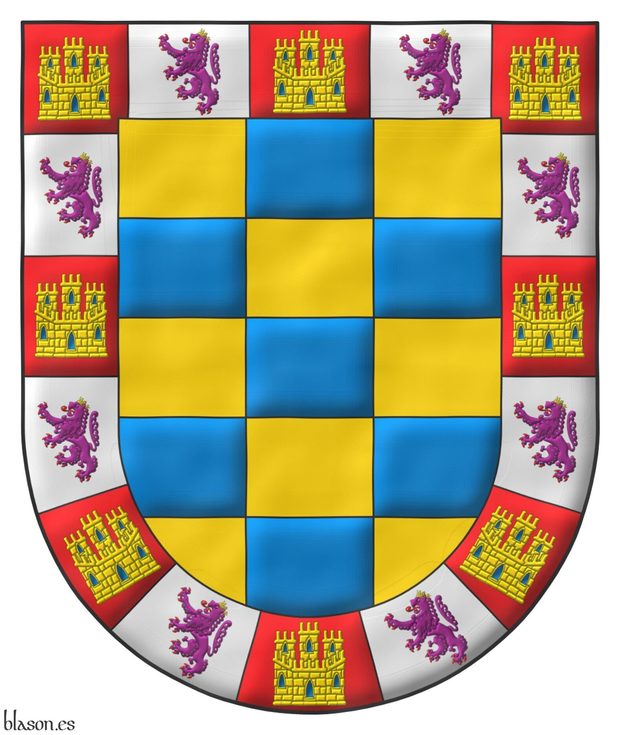
Chequey of fifteen Or and Azure; a bordure compony of sixteen sections, eight gules, a castle triple-towered Or, port and windows Azure, masoned Sable, eight Argent, a lion rampant Purpure, crowned Or, armed and langued Gules.
Escudo ajedrezado de quince piezas de oro y azur; una bordura componada de dieciséis compones, ocho de gules, un castillo de oro, aclarado de azur, mazonado de sable, ocho de plata, un león rampante de púrpura, coronado de oro, armado y lampasado de gules.
Coat of arms emblazoned by me, highlighted with lights and shadows, outlined in Sable, with a semi-circular outer contour and with a watercolor finish.
Coat of arm of the municipality of Moguer, Andalusia, emblazoned by me.
Blazon keywords: Or, Azure, Gules, Argent, One, Fifteen, Sixteen, Eight, Chequey, Bordure, Compony, Section, Charged, Castle, Triple-towered, Port and windows, Masoned, Lion, Rampant, Crowned, Armed and Langued.
Style keywords: Outlined in sable, Illuminated, Semi-circular and Watercolor.
Classification: Civic, Interpreted, Boa and Coat of arms.
Bearer: Moguer, municipality of.


Monteagudo of Navarra
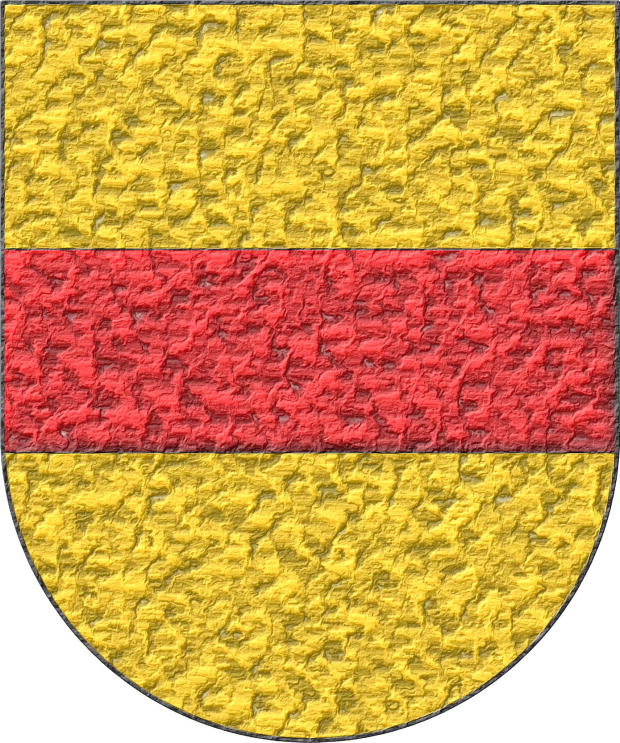
Of the twelve lineages of Noblemen, the eleventh is the house of Monteagudo; they bear as arms a shield Or, and in the middle a fess Gules, in the manner in which this shield is painted.
Or, a fess Gules.
Escudo de oro, una faja de gules.
Coat of arms interpreted as follows: a semicircular (round) base; the field enamelled in flat Or; the fess outlined in Sable and illuminated in Gules; and the whole finished in highly-hammered metal.
Interpreted from the eleventh coat of arms of the Navarrese «ricoshombres» from [Bosque, J. del; 1540; folio 1 of the numbering of 1613] and with the preceding text taken from the transcription appearing in [Martinena Ruiz, J. J.; 1982; pages 122 and 123].
Under the title «Surname of Monteagudo» this blazon can be consulted in [Vega, P. J. de; 1702; folio 11 of the manuscript].
Blazon keywords: Without divisions, Or, Fess and Azure.
Style keywords: Semi-circular, Illuminated, Outlined in sable and Hard metal.
Classification: Interpreted, Personal and Kingdom of Navarre.
Bearer: Monteagudo of Navarra.


Mortés, Jean
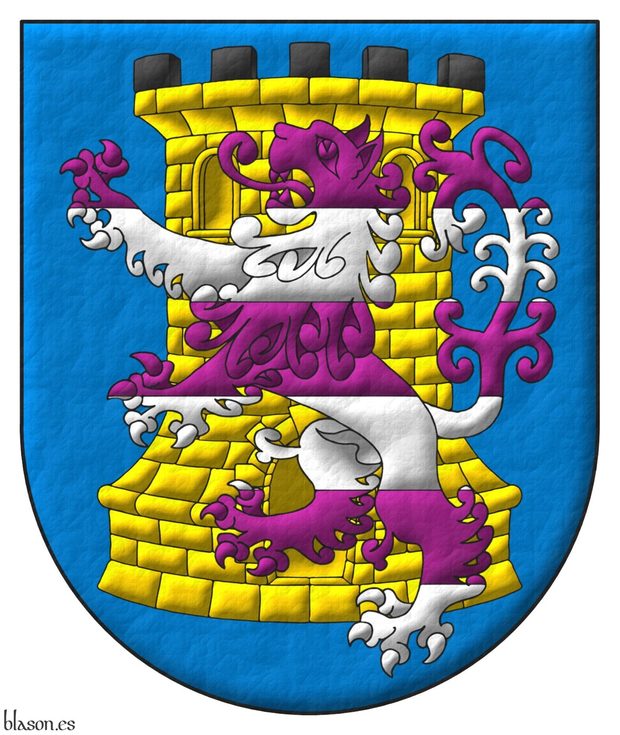
Azure, a tower Or, embattled and masoned Sable, overall a lion rampant barry Purpure and Argent.
Escudo de azur, una torre de oro, almenada y mazonada de sable, brochante sobre el todo un león rampante fajado de púrpura y plata.
Coat of arms interpreted by me, highlighted with lights and shadows, outlined in Sable, with a semi-circular external shape and with a leather finish.
Coat of arms of Jean Mortes from Brittany, France, emblazoned by me with a shield with a semi-circular base.
Blazon keywords: Azure, Or, Sable, Argent, Purpure, One, Tower, Embattled, Masoned, Overall, Lion, Rampant and Barry.
Style keywords: Outlined in sable, Illuminated, Semi-circular and Leather.
Classification: Personal, Interpreted, Boa and Coat of arms.
Bearer: Mortés, Jean.


Motto around the shield of Alejandra Espeja Avieda

Or, four bell towers issuant from base Gules, windows Or. Motto around the shield: «Linaje Lanzagorta Otxoa · Catalunya · Barcelona» Sable over a scroll Argent.
Coat of arms painted by me, in plain tinctures, contoured in Sable, with a semi-circular external shape and with a texturized finishing.
Coat of arms of Alejandra Espeja Avieda, familiarly known as Sandra. This shield, surrounded by an annular scroll Argent inscribed in sable, has been designed byhas been designed by Juan Lanzagorta Vallín and emblazoned by me.
Blazon keywords: Or, Gules, Sable, Argent, Four, One, Bell tower, Issuant from base, Port and windows, Within, Motto (identification) and Scroll.
Style keywords: Outlined in sable, Plain tincture and Semi-circular.
Classification: Personal, Interpreted, Boa and Coat of arms.
Bearer: Espeja Avieda, Alejandra.


Motto of Carmen Giaimo di Prizzi
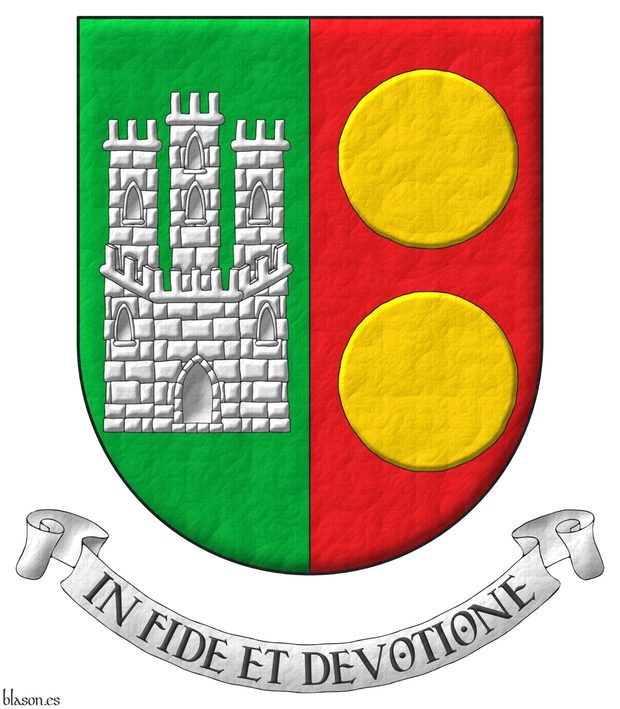
Party per pale: 1 Vert, a Castle triple-towered Argent; 2 Gules, two bezants in pale Or. Motto: «In Fide et Devotione»
Blazon keywords: Party per pale, Vert, One, Castle, Argent, Gules, Two, Bezant and plate, Bezant, In pale and Motto.
Style keywords: Semi-circular, Leather and Outlined in sable.
Classification: Interpreted, Personal and Coat of arms.
Bearer: Giaimo di Prizzi, Carmen.


Nicholas Malmains
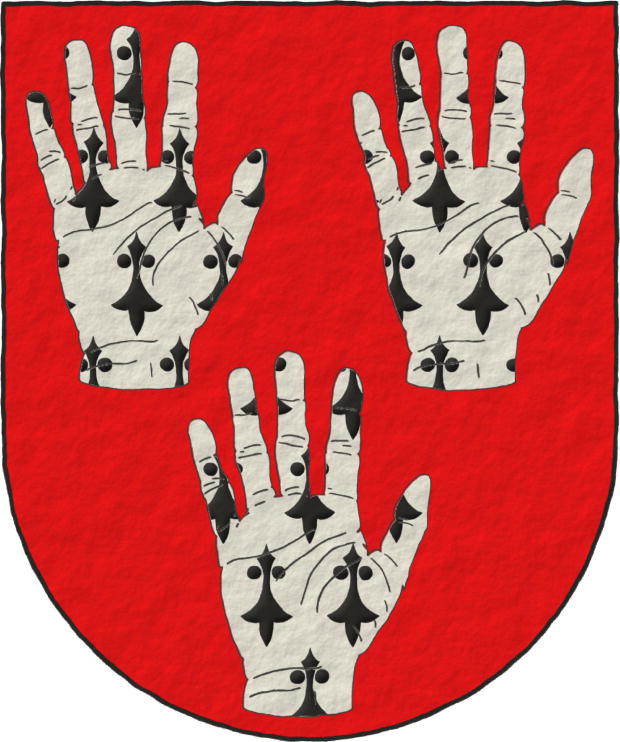
Nicolás Malmains ~ Nicholas Malmains ~ Nicol Malemeins.
Gules, three dexter hands turned up, and appaumée Ermine.
Escudo de gules, tres manos diestras levantadas y apalpadas de armiños.
Included in [Vincent, MS; 1285; number 622] also known as [St. George's Roll; 1285; number 622].
Blazon keywords: Without divisions, Gules, Three, Hand, Dexter, Ermine, Turned up, Appaumée and Ordered.
Style keywords: Semi-circular, Illuminated, Outlined in sable and Freehand.
Classification: Interpreted and Personal.
Bearer: Nicolás Malmains.


Noblemen of Navarre
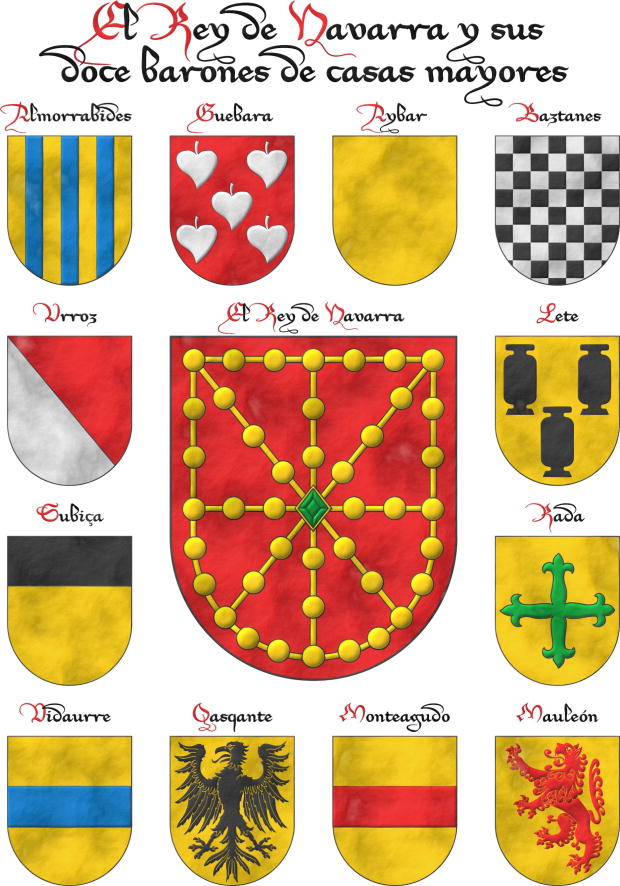
The King of Navarre, at the time of his new and solemn coronation, is raised and lifted up as King by the hands of twelve barons of the greatest and oldest houses of the said Kingdom, and these are the twelve Noblemen who are named on the other side, with their blazons and coats of arms.
Interpretation and composition of 13 coats of arms that I have created with a parchment-like finish.
A free interpretation, for example, without the central crown over the arms of Navarre, with a different title, written «Navarra» and not «Nabarra», etc., based on the principal plate of [Bosque, J. del; 1540; folio 1 of the numbering of 1613] and with texts taken from the transcription by [Martinena Ruiz, J. J.; 1982; pages 122 and 123].
«Ricohombre», written together, currently means «title that formerly belonged to the highest nobility of Spain», [Real Academia Española; 2001].
Its plural «ricoshombres» is the most commonly used form, but «ricohombres» is also correct and used; and in [Bosque, J. del; 1540] it is written separately, and «honbre» with an «n» before the «b», that is, «ricos honbres».
Blazon keywords: Without divisions, Party per bend, Azure, Gules, Or, Argent, Sable, Vert, Eagle, Chequey, Cross flory, Cross couped, Fess, Chief, Lion, Pale, Poplar leaf, Clay pot and Rampant.
Style keywords: Semi-circular and Old parchment.
Classification: Interpreted and Kingdom of Navarre.
Bearer: Noblemen of Navarre.


![Ver [Norsk Heraldisk Forening] en instituciones citadas. Fortaleza de oro y mazonada de sable.](../css/Fortaleza.Institucion.png)
Norsk Heraldisk Forening
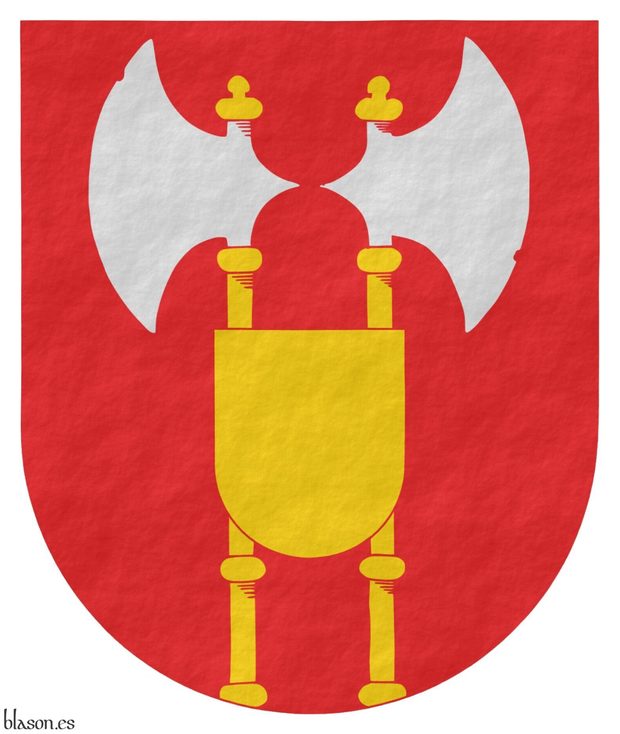
Norsk Heraldisk Forening, in English, Nordic Heraldry Society, was founded on February 27, 1969, at the National Archives in Oslo, with the aim of promoting the study and knowledge of heraldry through meetings, lectures, excursions, and other dissemination methods, and additionally, to become an advisory body to resolve issues in matters of heraldry, flags, personal coats of arms, etc. Its first president was Dr. Philos Herman L. Løvenskiold.
Since then, these have remained the objectives of the Norsk Heraldisk Forening, and its membership count has remained between 150 and 200 members, and it cooperates with the Nordic Heraldry Society, «Societas Heraldica Scandinavica».
The website's address is Heraldikk.no, its content is available in both Norwegian and English, and they work systematically to expand it and provide greater and better information to both its members and those interested in heraldry.
Blazon
Alex Maxwell Findlater described it in English, including its crest, in an article that was on their previous website under the title «About the society», as follows: «Gules issuant from base two battle-axes addorsed Argent shafted Or overall at the nombril point an escutcheon Or; for Crest between two axes of the arms a panache of three peacock feathers proper; Mantling Gules doubled Or». But given that «shafted» applies to weapons with a shaft and «hafted» to weapons with a handle, in the case of axes, I use «hafted» although both terms correspond to the Spanish «fustado».
Note how the axes are described as battle-axes, just as in the blazon of the Norwegian coat of arms, where its lion holds a battle-axe.
Coat of arms I attempted to interpret in the Norwegian style, all in flat tinctures, without Sable outlines, lighting or shading, and only with a simple rough finish.
Categories: Institution, Interpreted, Socioeconomic, Semi-circular, Plain tincture, Outlined in the field tincture, Rough, Coat of arms, Without divisions, Gules, Axe, Argent, Hafted, Or, Addorsed, Issuant from base, Overall, At the nombril and Escutcheon.


o-XI, video of the heraldic starmap
The starship of this video is based on the «Narcissus», the lifeboat of the «Nostromo», designed by Ron Cobb for the film «Alien». The music is «Also sprach Zarathustra», Opus 30, from Richard Strauss, interpreted by Kevin MacLeod.
Credits: Kevin MacLeod is the author of the music and Ron Cobb is the designer of the original starship.
Blazon keywords: Quarterly, Sable, Or, One, Letter, Two, Wolf, Passant, In pale, Number, Unicorn, Mullet and Compass rose.
Style keywords: Semi-circular and Freehand.
Classification: Video, Map, Created and Personal.
Bearer: Salmerón Cabañas, Antonio.


Ormazabal of the Basque Country, lineage
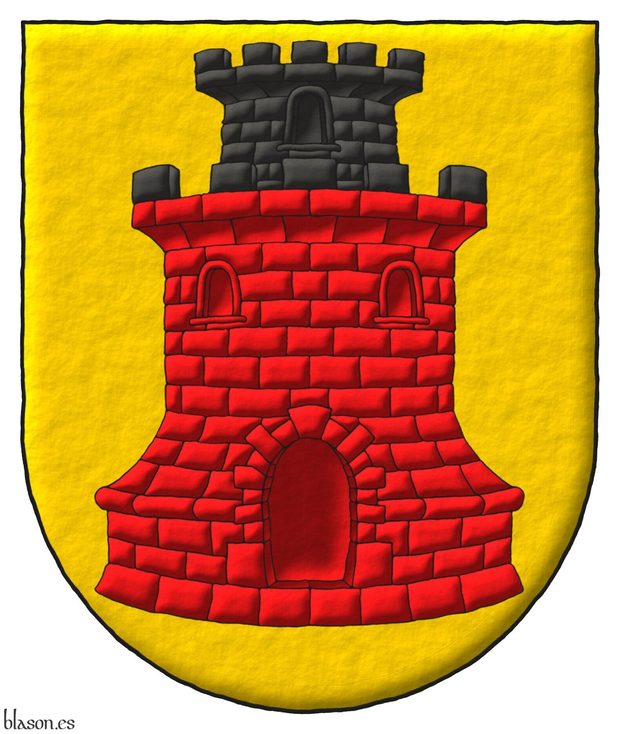
Or, a tower Gules, embattled, masoned and with a turret Sable.
Escudo de oro, una torre de gules, almenada, mazonada y donjonada de sable.
Coat of arms emblazoned by me, highlighted with lights and shadows, outlined in Sable, with a semi-circular outer contour and with a freehand finishing.
Ancient arms of the lineage Ormazabal of the Basque Country emblazoned by me.
Blazon keywords: Or, Gules, Sable, One, Tower, Embattled, Masoned and With a turret.
Style keywords: Outlined in sable, Illuminated, Semi-circular and Freehand.
Classification: Personal, Lineage, Interpreted, Boa and Coat of arms.
Bearer: Ormazabal of the Basque Country, lineage.


Orrantia of the Basque Country, lineage
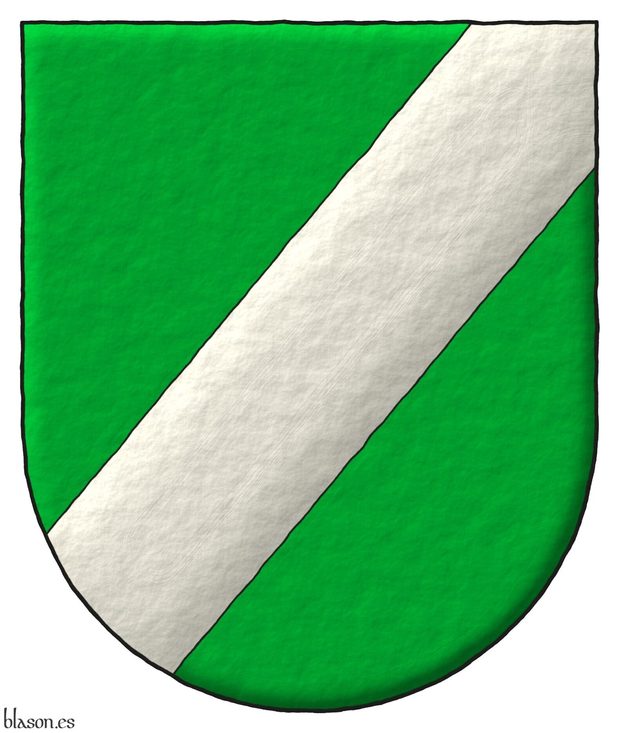
Vert, a bend sinister Argent.
Escudo de sinople, una barra de plata.
Coat of arms emblazoned by me, illuminated with lights and shadows, outlined in Sable, with a semi-circular outer contour and with a freehand finishing.
Coat of arms of the lineage Orrantia of the Basque Country emblazoned by me.
Blazon keywords: Vert, Argent, One and Bend sinister.
Style keywords: Outlined in sable, Illuminated, Semi-circular and Freehand.
Classification: Personal, Lineage, Interpreted, Boa and Coat of arms.
Bearer: Orrantia of the Basque Country, lineage.


Oschoven of the Rhin
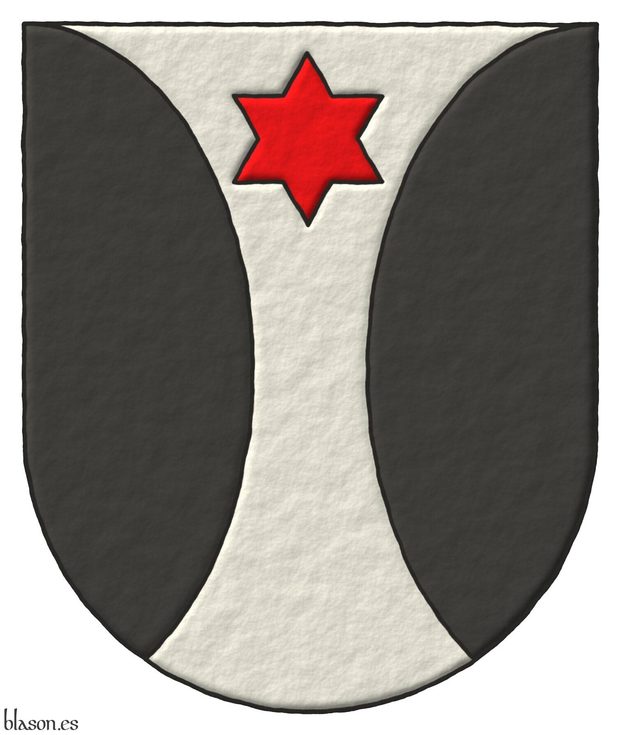
Argent, flanched Sable, in chief a mullet of six points Gules.
Escudo de plata, flanqueado curvo de sable, en jefe una estrella de seis rayos de gules
Coat of arms interpreted with: a semicircular (round) base; illuminated in the tinctures Argent, Gules, and Sable; all outlined in Sable; and finished with a raised-stroke effect.
[Avilés, J.; 1725a; pages 92 and figure 197] blazons it as «Argent, and a six-pointed star Gules in chief, flanched in oval Sable». When he illustrates it in [Avilés, J.; 1725a; figure 197], the space left between both flanches is only 1/5 of the base of the coat of arms; this is feasible because the only charge is a mullet in chief. If there were more charges, it would be necessary to leave more space, for example, 1/3 of the base of the shield.
«Oschoven au Rhein» in the book [Menestrier, C. F.; 1659; page 315], it is blazoned «d'argent flanqué arrondi de sable à vne molette de mesme en chef», so the mullet would be Sable, bacause «de mesme» is written, and with a hole in the middle, this hole does not exits in other sources.
In the book [Rietstap, J. B.; 1861], it is blazoned «Argent, flanched in round Sable, Argent charged in chief of a mullet Gules», and in French «d'argent, flanqué en rond de sable, l'argent chargé en chef d'une étoile de gueules».
Some time ago I used to blazon it in English as «Argent, in chief a mullet of six points Gules, between two flanches Sable».
Blazon keywords: Argent, Sable, Gules, Mullet, Chief and Flanched.
Style keywords: Semi-circular, Illuminated, Outlined in sable and Freehand.
Classification: Interpreted and Personal.
Bearer: Oschoven of the Rhin.


Osona, lineage
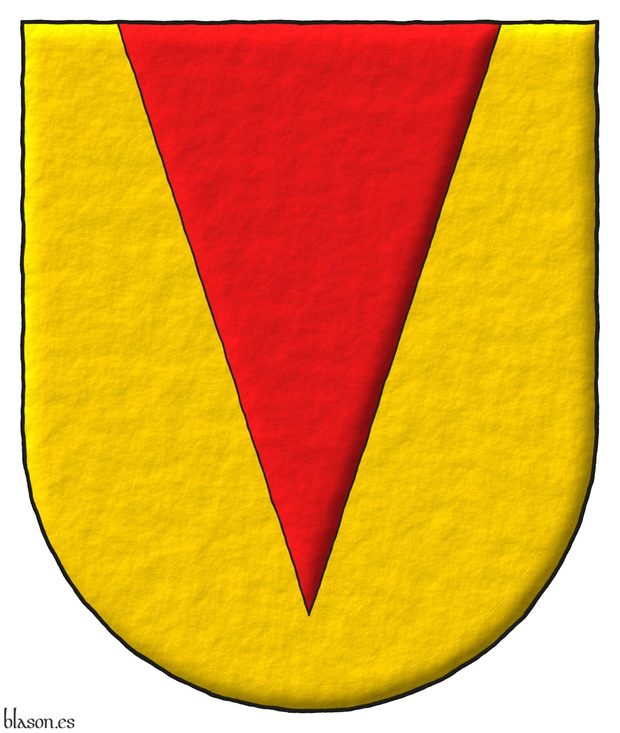
Or, a pile Gules.
Escudo de oro, una pila de gules.
Coat of arms emblazoned by me, illuminated with lights and shadows, contoured in Sable, with a semi-circular external shape and with a freehand finishing.
Coat of arms of the lineage Osona emblazoned by me based on the description by [Cadenas y Vicent, V. de; 1987; page 1325].
Blazon keywords: Or, Gules, One and Pile.
Style keywords: Outlined in sable, Illuminated, Semi-circular and Freehand.
Classification: Personal, Lineage, Interpreted, Boa and Coat of arms.
Bearer: Osona, lineage.


Our Lady of Mercy, Order of
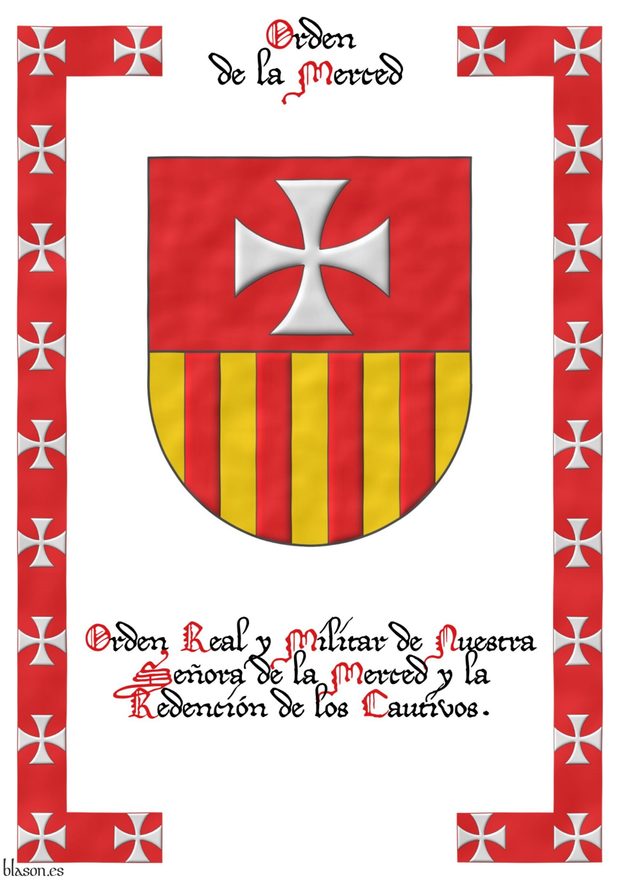
Royal and Military Order of Our Lady of Mercy and the Redemption of Captives.
Party per fess: 1 Gules, a cross patty Argent; 2 Or, four pallets Gules.
Escudo cortado: 1o de gules, una cruz patada de plata; 2o de oro, cuatro palos de gules.
Existing coat of arms which has been interpreted by me with the following characteristics: the mouth of the shield ends in a semicircular arch shape; the field has been enameled with flat tinctures of Gules color and Or metal; the cross patty and the pales are illuminated with Argent metal and Gules color; the whole has received a watercolor finish; and all within a Gules frame with 22 cross patties Argent, to which the name of its owner and blazon written in Sable and Gules tinctures is added.
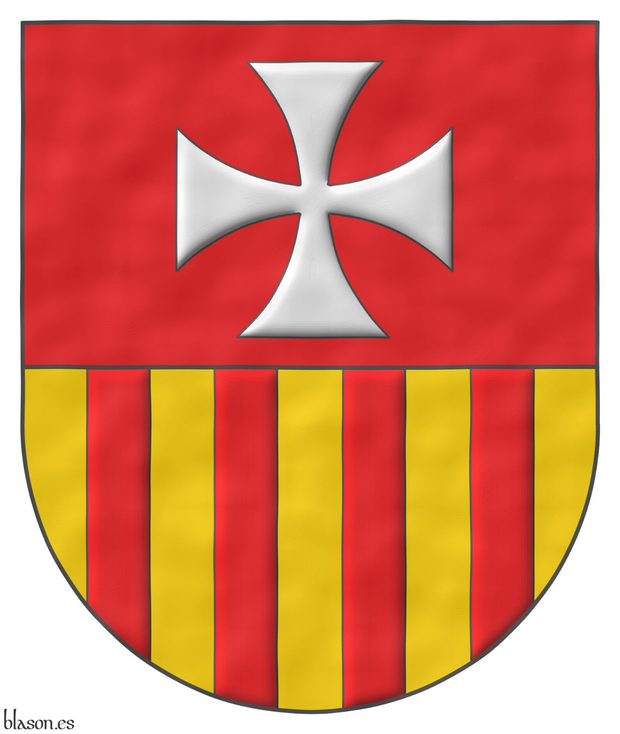
In [Medél, R.; 1846; plate 35, illustration 7] can be seen his interpretation of the coat of arms of the Order of Mercy.
The 2nd coat of arms of the Order of Mercy also illustrating this article is the same as the one included within the frame that appears in the 1st illustration of this article.
Another way to write the blazon of the coat of arms of the Order of Mercy could be the following, which simplifies the description of the 2nd quarter by saying that they are the arms of Aragon:
Party per fess: 1 Gules, a cross patty Argent; and 2 Or, four pallets Gules.
This coat of arms has been classified within the category called religious heraldry.
Blazon keywords: Party per fess, Gules, Or, Argent, Cross, One, Cross patty, Cross couped and Pale.
Style keywords: Semi-circular, Illuminated, Outlined in sable and Watercolor.
Classification: Interpreted, Religious and Frame.
Bearer: Our Lady of Mercy, Order of.


Patus, lineage
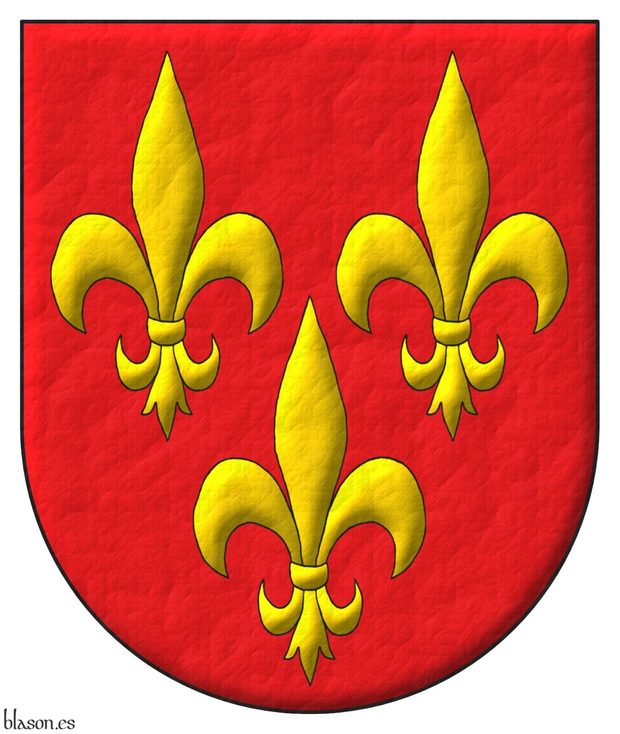
Gules, three fleur de lis Or.
Escudo de gules, tres flores de lis de oro.
Coat of arms depicted by me, highlighted with lights and shadows, contoured in Sable, with a semi-circular outer contour and with a leather finish.
Coat of arms of the lineage Patus emblazoned by me.
Blazon keywords: Gules, Or, Three and Fleur de lis.
Style keywords: Outlined in sable, Illuminated, Semi-circular and Leather.
Classification: Personal, Interpreted, Boa and Coat of arms.
Bearer: Patus, lineage.


Peregrina Corona, Dolores
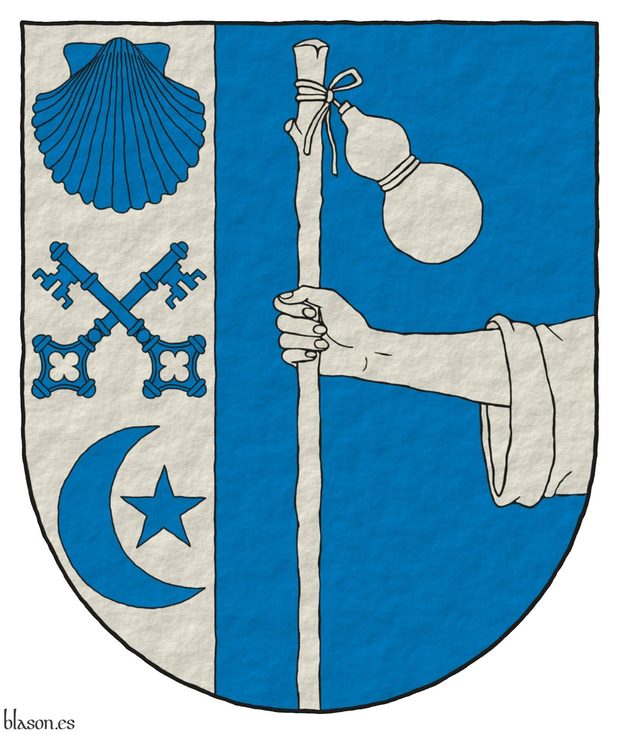
Tierce: 1 Argent, two keys points upwards, in saltire, between in chief an escallop, and in base a mullet of five points environed at dexter by a crescent bendwise azure; 2 Azure, a dexter arm vested, issuant from sinister, grasping a pilgrim's staff palewise, issuant from base, tied to it a gourd bendwise Argent.
Escudo adiestrado: 1o de plata, dos llaves alzadas en sotuer, acompañadas en jefe de una venera, y en punta de una estrella de cinco puntas, circundada a la diestra de un creciente puesto en banda todo de azur; 2o de azur, un brazo diestro vestido, moviente de la siniestra, teniendo un bordón de peregrino puesto en palo, moviente de la punta, y atada a él una calabaza puesta en banda todo de plata.
Arms designed by me, in flat tinctures, contoured in Sable, with a semi-circular outer contour and with a texturized finishing.
Canting arms of Dolores Peregrina Corona designed by Juan Lanzagorta Vallín and me and emblazoned by me. In Castilian heraldic tradition, the «adiestrado» ~ «tierce» used in this coat of arms and its symmetrical «siniestrado» ~ «tierce sinister» are «irregular divisions of the field by one line» ~ «particiones irregulares». That is why I use «tierce» and «tierce sinister» in English. There is another possibility, which is to call the «adiestrado» ~ «pale in dexter flank» and the «siniestrado» ~ «pale in sinister flank», thus ceasing to be a type of «divisions of the field» ~ «particiones» and becoming «ordinaries» ~ «piezas fundamentales». This has implications, as the rule of tinctures would apply if it were considered a «pale» ~ «palo». In any case, I will write the blazon in both ways. Alternative blazon: Azure, a dexter arm vested, issuant from sinister, grasping a pilgrim's staff palewise, issuant from base, tied to it a gourd bendwise; on a pale in dexter flank Argent two keys points upwards, in saltire, between in chief an escallop, and in base a mullet of five points environed at dexter by a crescent bendwise azure.
Design rationale
These are canting arms because her surname is «Peregrina» ~ «pilgrim», and her coat of arms depicts the arm of a pilgrim, as she is one herself, with her staff and her gourd for carrying water, advancing towards the dexter, in order to reach the destination of her three most important life pilgrimages: Santiago de Compostela, Rome, and Jerusalem.
Blazon keywords: Azure, Argent, One, Two, Tierce, Key, Point upwards, In saltire, Between, In chief, Escallop, In base, Mullet, Environed, Dexter, Crescent, Bendwise, Arm, Vested, Issuant from the sinister flank, Grasping, Pilgrim's staff, Palewise, Issuant from base, Tied and Gourd.
Style keywords: Outlined in sable, Plain tincture and Semi-circular.
Classification: Personal, Created, Boa and Coat of arms.
Bearer: Peregrina Corona, Dolores.


Pesquera de Ebro
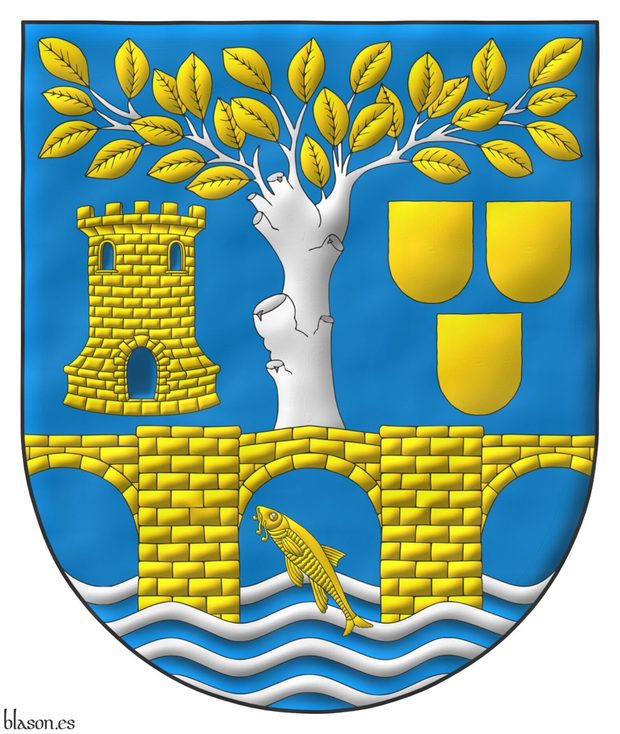
Azure, on four bars wavy Argent a barbel bendwise Or and a three arch bridge Or, masoned Sable, throughout, supporting a elm couped Argent leaved Or, between, in dexter a tower Or, port and windows Azure, mazoned Sable, and in sinister three escutcheon Or, 2 and 1.
Escudo de azur, en punta cuatro burelas ondadas de plata sumadas de un barbo puesto en banda de oro y un puente de tres ojos moviente de los flancos de oro, mazonado de sable, sosteniendo una olma nurida de plata, hojada de oro, acompañada a su diestra de una torre de oro, aclarada de azur, mazonada de sable y a su siniestra de tres escudetes de oro, 2 y 1.
Arms designed by me, illuminated with lights and shadows, contoured in Sable, with a semi-circular outer contour and with a watercolor finish.
Blazon keywords: Argent, Or, Azure, Sable, One, Three, On, Bar, Wavy, Barbel, Bendwise, Bridge, Masoned, Throughout, Upon, Elm, Couped (tree), Leaved, Tower, Port and windows, Escutcheon and Ordered.
Style keywords: Outlined in sable, Illuminated, Semi-circular and Watercolor.
Classification: Civic, Created, Boa and Coat of arms.
Bearer: Pesquera de Ebro.


Philip Daubeny
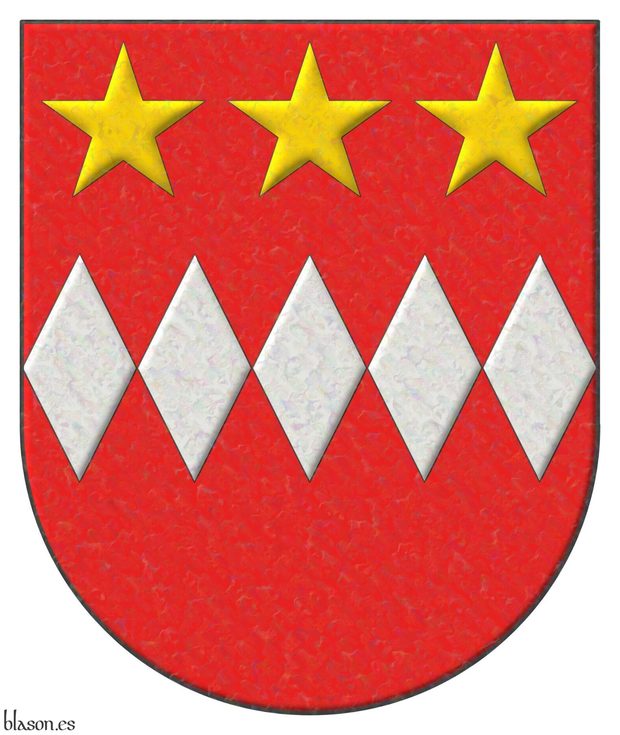
Philip Daubeny ~ Philip Daubeney.
Gules, a fess of five fusils Argent, in chief three mullets Or.
Escudo de gules, una faja de cinco fusos de plata, en jefe tres estrellas de oro.
Coat of arms interpreted in the following manner: the shape of the base is semicircular; the field is illuminated in Gules; the fusils outlined in Sable and illuminated in metal Argent; the fess is 5 fusils in length; the 3 mullets in chief of 5 points, outlined in Sable and illuminated in metal Or; and the whole with an iridescent finish.
This post corresponds to the English post number 61 in the same series.
Blazon keywords: Gules, Fusil, Argent, In fess, Mullet, Or and In chief.
Style keywords: Semi-circular, Illuminated, Outlined in sable and Iridescent.
Classification: Interpreted and Personal.
Bearer: Daubeny, Philip.


Pierre de La Forcade
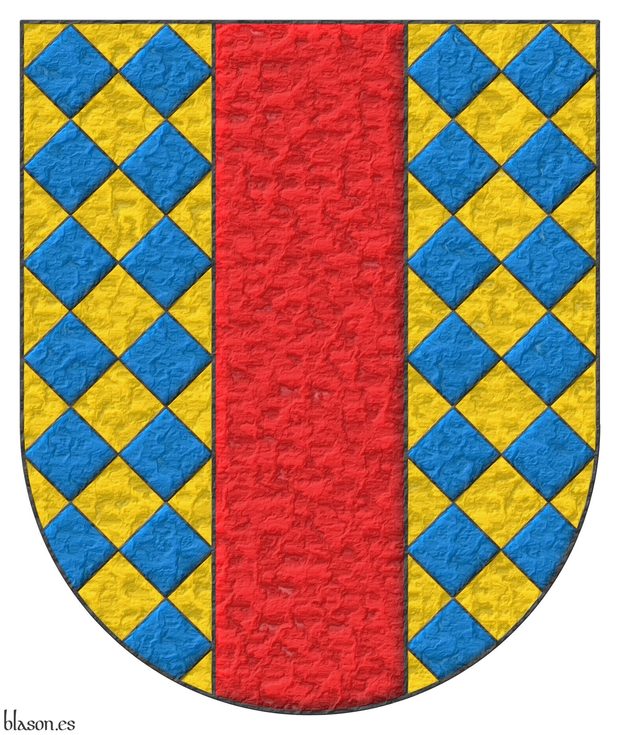
Pierre de Forcade ~ Pierre de La Forcade.
Lozengy Or and Azure, a pale Gules.
Escudo losanjado oro y azur, un palo de gules.
Coat of arms interpreted in the following manner: the shape of the base is semicircular; the field of plain metal tint Or; the lozenges with their 4 equal angles, outlined in Sable and illuminated in Azure; the lozengy of 6 lozenges wide by 7 lozenges high; the pale outlined in Sable and illuminated in Gules; and the whole with a marble finish.
He was born at the beginning of the 15th century, served Gaston IV of Foix as a man-at-arms and, as such, participated in the conquest of the cities of Blaye and Bourg and, in 1439, fought against the English troops near Saint-Sever in Les Landes, southwest of France.
Blazon keywords: Lozengy, Or, Azure, Pale and Gules.
Style keywords: Semi-circular, Illuminated, Outlined in sable and Metal beaten.
Classification: Interpreted and Personal.
Bearer: La Forcade, Pierre de.


Pile issuant from the base in the Dictionary of the Spanish Language
Supporting document illustrating my proposal, pages 4 and 5.
I have made a suggestion to the Lexicography Institute of the Royal Spanish Academy regarding the heraldic term «pira» in the Dictionary of the Spanish Language. I drafted a document that justified my suggestion, illustrated it, and proposed two ways to refine its definition within the Dictionary. I am honored that they have accepted my proposal and chosen the first of the alternative definitions I suggested. The following images are some of those I used to illustrate the supporting document.
Schema.
Delineation.
Coats of arms of the Burr, Osona, Gangoiti and Egado lineages.
I used the following bibliographical references [Académie internationale d'héraldique; 1952], [Arco y García, F. del; 1996a], [Avilés, J.; 1725a], [Avilés, J.; 1780a], [Cadenas y Vicent, V. de; 1987], [Cadenas y Vicent, V. de; 1975], [Cadenas y Vicent, V. de; 2002], [Messía de la Cerda y Pita, L.; 1990], and [Messía de la Cerda y Pita, L.; 1980].
Categories: Schema, Ratio, Outlined, Outlined in sable, Illuminated, Semi-circular and Doctor.


Pius V
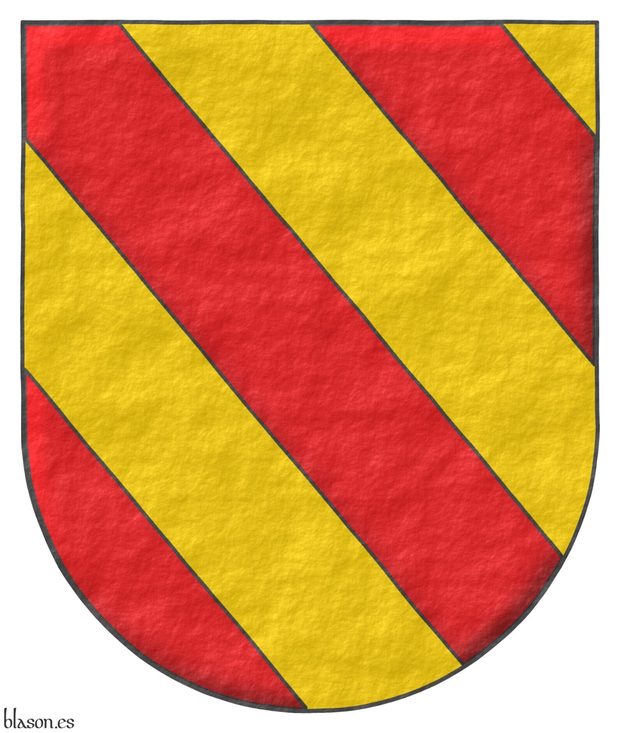
225th Pope of the Church, from 1566 to 1572. «Pius V», named Antonio Michele Ghislieri, was canonized in 1712.
Bendy of six Gules and Or.
Escudo bandado de seis piezas de gules y oro.
Papal coat of arms interpreted with: a rounded mouth; the field in flat tincture of Or; the bands outlined in Sable and illuminated in Gules; and the whole with a rough finish.
I have also seen this coat of arms described as «a shield banded of six pieces of Or and Gules».
Blazon keywords: Without divisions, Bendy, Six, Gules and Or.
Style keywords: Semi-circular, Illuminated, Outlined in sable and Rough.
Classification: Interpreted, Religious and Papal States.
Bearer: Pius V.


Point or emerald for Navarre
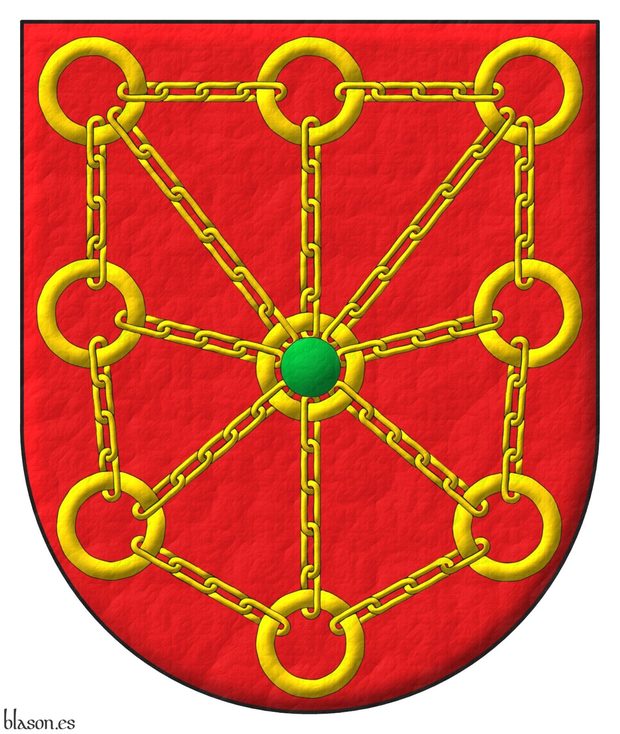
Gules, a chain orlewise, crosswise, and saltirewise Or, charged in the fess point with an emerald Vert.
Arms painted by me, highlighted with lights and shadows, outlined in Sable, with a semi-circular outer contour and with a leather finish.
Arms of the Kingdom of Navarre emblazoned by me. This version of this coat of arms features a vert roundel at the fess point following the official specification of the coat of arms of Spain, instead of an emerald as I usually depict it and as is, for example, suggested in the blazon on page 142, although listed as 151 in its index, of the armorial [Urfé; Century XV; page 142], Bibliothèque nationale de France ms. fr. 32753: «Le Roy de Navarre... de gueles à l'escarboucle d'or pommelée alumée de sinoble en la moyenne en guise d'esmeraude», which may be translated as: «The King of Navarre... Gules, a carbuncle Or pommelly, lit Vert at the centre, in the manner of an emerald». This emerald is incompatible with the official blazon of the coat of arms of Spain; however, in my humble opinion, it would give this coat of arms a charge, the emerald, of greater heraldic substance than the roundel. Although I have painted it in a way that it is not known whether it is a large point or an uncutt circular emerald, in the blazon I have described it as an emerald both in Spanish and in English, since the point does not have a clear heraldic existence in Spanish and even less so in English.
Blazon keywords: Gules, Vert, Or, One, Chain, Orlewise, Crosswise, Saltirewise, Charged, In the fess point and Emerald.
Style keywords: Outlined in sable, Illuminated, Semi-circular and Leather.
Classification: Civic, Kingdom of Navarre, Interpreted, Boa and Coat of arms.
Bearer: Navarre.


Portugal
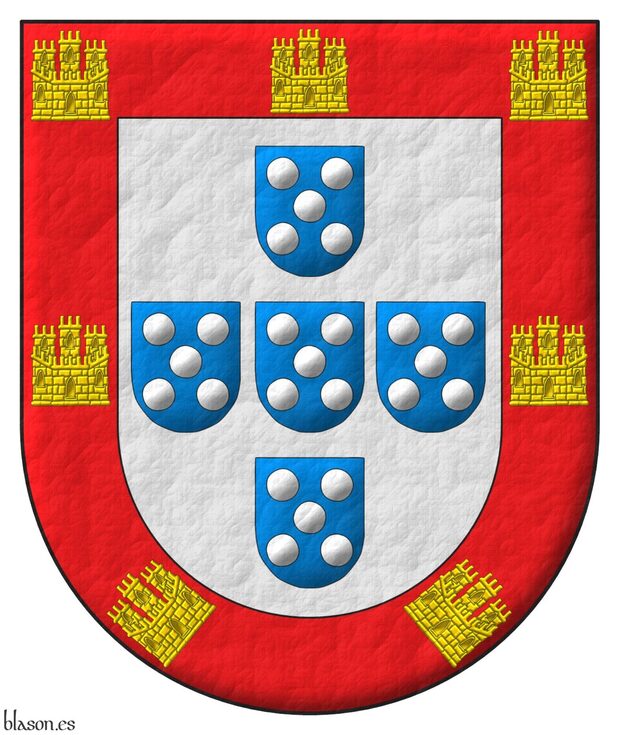
Argent, five escutcheons in cross Azure, each charged with five plates in saltire; a bordure Gules, charged with seven castles triple-towered Or, 3, 2, and 2
Escudo de plata, cinco escudetes en cruz de azur, cada uno cargado de cinco bezantes en sotuer de plata; una bordura de gules, cargada de siete castillos de oro, tres en jefe, uno en cada flanco y dos en punta
Illuminated and a leather finishing.
This coat of arms can be seen in [Avilés, T. de; XVI; página 16], [Bergshammars; 1440; page 4], [Lutzelbourg, N. de; 1530; page 37], and in [Gourdon de Genouillac, H.; 1889; page 247].
Blazon keywords: Without divisions, Argent, Five, Escutcheon, In cross, Azure, Charged, Bezant and plate, Plate, In saltire, Bordure, Gules, Seven, Castle, Or, Three, In chief, One, In each flank and In base.
Style keywords: Leather, Outlined in sable, Illuminated and Semi-circular.
Classification: Civic, Interpreted and Kingdom of Portugal.
Bearer: Portugal.


Province of Cáceres with Cross of Alcántara
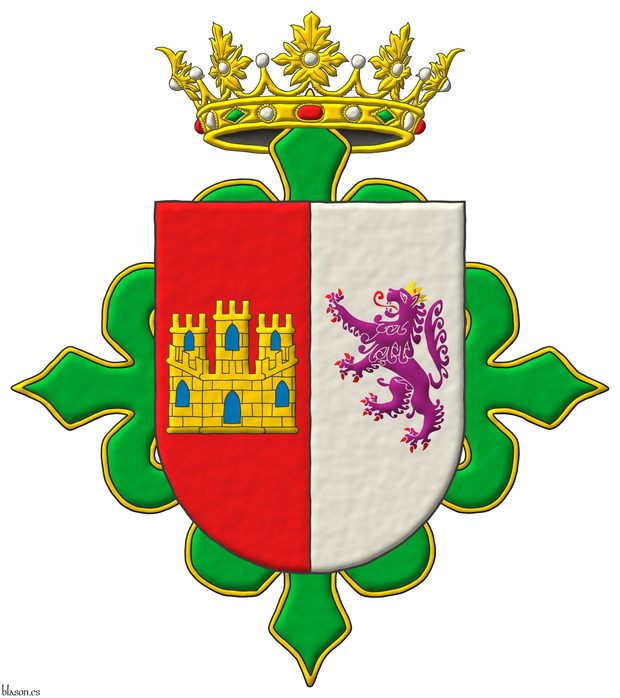
Party per pale: 1 Gules, a castle triple towered Or, port and windows Azure, masoned Sable; 2 Argent, a lion rampant Purpure, armed and langued Gules, crowned Or. Crest: An open royal crown. Behind the shield a cross of Alcantara.
Escudo partido: 1o de gules, un castillo de oro, aclarado de azur, mazonado de sable; 2o de plata, un león rampante de púrpura, armado y lampasado de gules, coronado de oro. Timbrado de una corona real abierta. Acolada detrás del escudo una cruz de Alcántara.
Civic coat of arms interpreted by me as follows: the shield of arms has a semicircular (round) base; the quarters are enameled and illuminated in the tinctures Argent and Gules; the castle, the lion, the Cross of Alcántara and the crown are illuminated; the lion and its crown are outlined in the colour of the field; the open royal crown, the Cross of Alcántara and the castle are outlined in Sable; the Cross of Alcántara is fimbriated Or; and the whole has a watercolor finish.
In [Medél, R.; 1846; plate 35, illustration 5] one can see his interpretation of the Cross of Alcántara.
Blazon keywords: Argent, Purpure, Gules, Or, Azure, Party per pale, Castle, Lion, Port and windows, Masoned, Rampant, Armed, Langued, Crowned, Crest and mantling, Crown, Open royal crown, Behind the shield, Cross, Cross of Alcantara and Cross couped.
Style keywords: Semi-circular, Illuminated and Watercolor.
Classification: Interpreted, Civic and Coat of arms.
Bearer: Cáceres, Province of.


Qasqante of Navarre
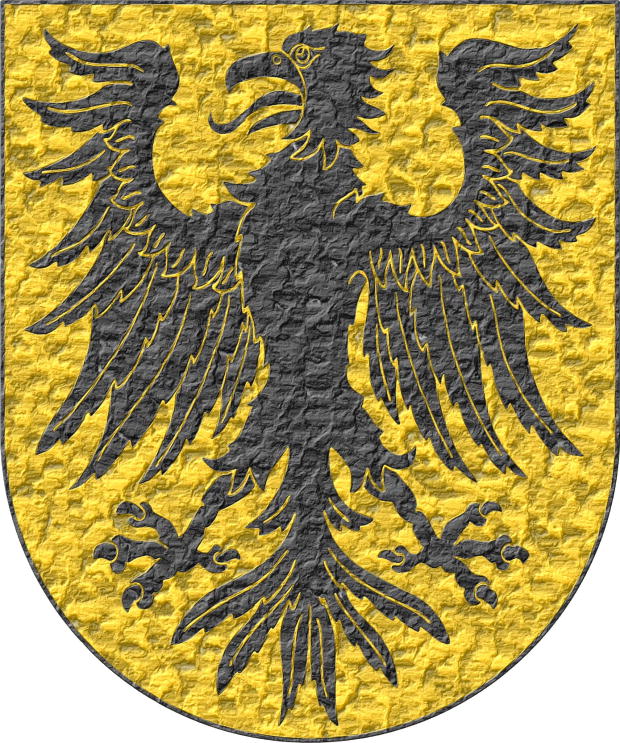
Of the twelve lineages of Noblemen, the tenth is that of Qasqante; they bear as arms a shield Or and, on the shield, an eagle Sable, which is black, as it is now painted.
Or, an Eagle displayed Sable.
Escudo de oro, un águila de sable.
Coat of arms interpreted with: a semicircular (round) base; the field in flat Or; the eagle outlined in the colour of the field and illuminated in Sable; and finished in highly-hammered metal.
Based on the tenth coat of arms of the Navarrese «ricoshombres» from [Bosque, J. del; 1540; folio 1 of the numbering of 1613] and the text is from the transcription made by [Martinena Ruiz, J. J.; 1982; pages 122 and 123].
Under the title «Surname of Cascante» it can also be consulted in [Vega, P. J. de; 1702; folio 10 of the manuscript].
Blazon keywords: Without divisions, Or, Eagle and Sable.
Style keywords: Semi-circular, Illuminated, Outlined in the field tincture and Hard metal.
Classification: Interpreted, Personal and Kingdom of Navarre.
Bearer: Qasqante of Navarre.


Quartered arms of André de Montbard
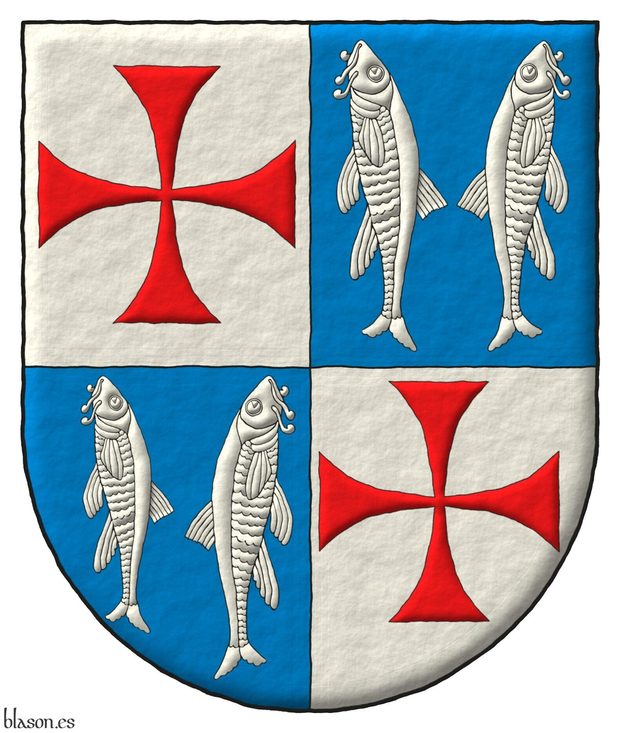
Quarterly: 1 and 4 Argent, a cross patty Gules; 2 and 3 Azure, two barbels addorsed Argent
Escudo cuartelado: 1o y 4o de plata, una cruz patada de gules; 2o y 3o de de azur, dos barbos adosados de plata.
Blazon keywords: Azure, Two, Barbel, Addorsed, Argent, Quarterly, One, Cross patty, Cross couped and Gules.
Style keywords: Outlined in sable, Semi-circular, Illuminated and Freehand.
Classification: Religious, Military, Knights Templar, Interpreted and Coat of arms.
Bearer: Montbard, André de.


Rada of Navarre
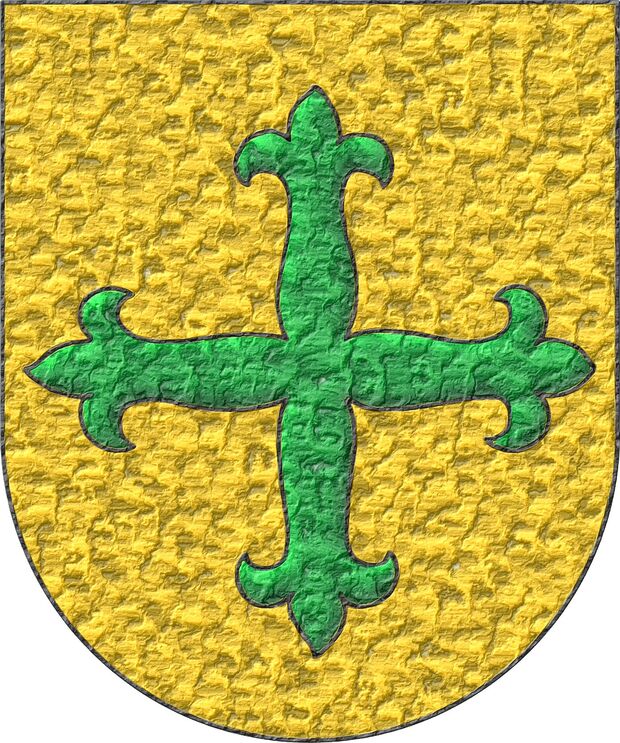
Of the twelve lineages of Noblemen, the eighth is that of Rada; they bear as arms a shield Or with a flory cross Vert, in the same manner as painted in this shield.
Or, a Cross flory Sinople.
Escudo de oro, una cruz flordelisada de sinople.
Coat of arms interpreted with: a semicircular (round) base; the field in flat Or; the flory cross outlined in Sable and illuminated in Vert enamel; and finished in highly-hammered metal.
Based on the eighth coat of arms of the Navarrese «ricoshombres» from [Bosque, J. del; 1540; folio 1 of the numbering of 1613] and the text is from the transcription made by [Martinena Ruiz, J. J.; 1982; pages 122 and 123].
Under the title «Surname of Rada» it can also be consulted in [Vega, P. J. de; 1702; folio 8 of the manuscript].
Blazon keywords: Without divisions, Or, Cross flory, Cross couped and Vert.
Style keywords: Semi-circular, Illuminated, Outlined in sable and Hard metal.
Classification: Interpreted, Personal and Kingdom of Navarre.
Bearer: Rada of Navarre.


Ramon Berenguer IV, Count of Barcelona
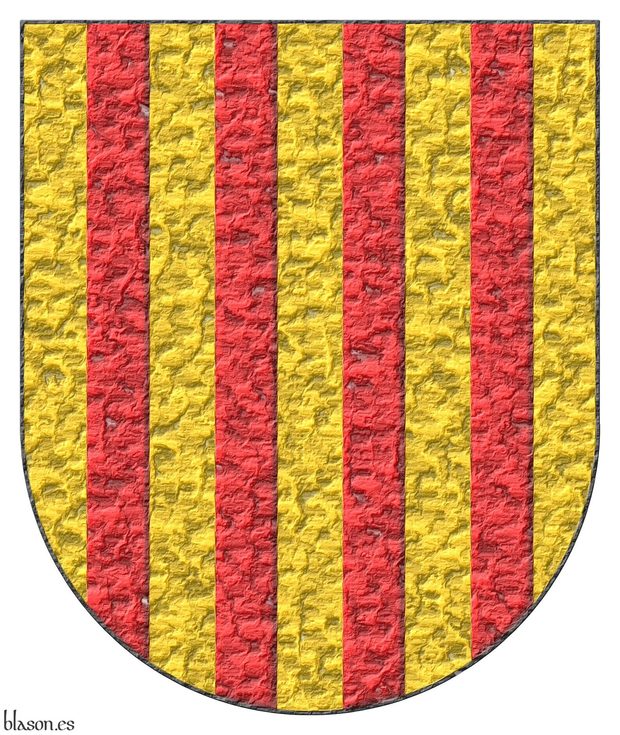
Or, four pallets Gules.
Escudo de oro, cuatro palos de gules.
Coat of arms of the Count of Barcelona interpreted by me with the following features: the escutcheon shape is semicircular; the field is rendered in flat Or; the pallets are illuminated; and the whole has been given a heavily beaten metal finish.
[Menéndez Pidal de Navascués, F.; 1988; page 537] tells us that, unlike other more territorial emblems, «from his earliest seal the pallets appear on the shield of the equestrian figures on both sides, and in line with this configuration the emblem is inherited, without distinction, by his three sons and all his grandsons... it seems one must conclude that the emblem had a familial, not territorial, character from the very beginning».
Blazon keywords: Without divisions, Or, Four, Pale and Gules.
Style keywords: Semi-circular, Illuminated and Hard metal.
Classification: Interpreted, Personal, Coat of arms and County of Barcelona.
Bearer: Ramon Berenguer IV, Count of Barcelona.


Rauf Daubeny
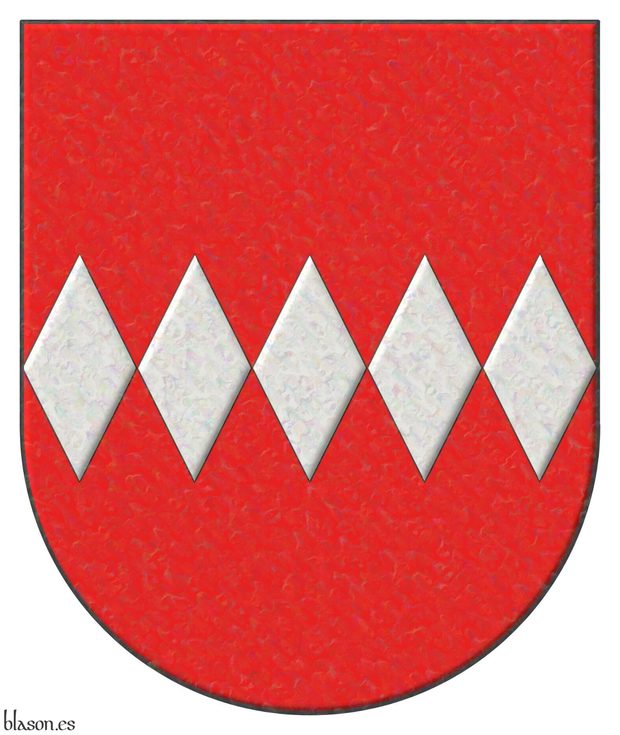
Ralph de Albini ~ Rauf de Albini.
Gules, a fess of five fusils Argent.
Escudo de gules, una faja de cinco fusos de plata.
Coat of arms interpreted in the following manner: the shape of the base is semicircular; the field is illuminated in Gules; the fusils outlined in Sable and illuminated in metal Argent; the fess is 5 fusils in length; and the whole with an iridescent finish.
I tend to blazon «Gules, a fess of five fusils Argent» ~ «Escudo de gules, una faja de cinco fusos de plata» which, as the piece called a fess touches the edges of the shield and is a unit, means the fusils touch the edges of the shield and touch each other, forming a single fess of 5.
While in the blazon «Gules, five fusils in fess Argent.» ~ «Escudo de gules, cinco fusos en faja de plata» the fusils neither touch each other nor the edges of the shield; this second blazon tells us that the fusils are «in fess» ~ «en faja», it does not tell us that they are forming a fess.
Blazon keywords: Gules, Fusil, Argent and In fess.
Style keywords: Semi-circular, Illuminated, Outlined in sable and Iridescent.
Classification: Interpreted and Personal.
Bearer: Daubeny, Rauf.


![Ver [Registro Internacional de Armas Gentilicias] en instituciones citadas. Fortaleza de oro y mazonada de sable.](../css/Fortaleza.Institucion.png)
Registro Internacional de Armas Gentilicias
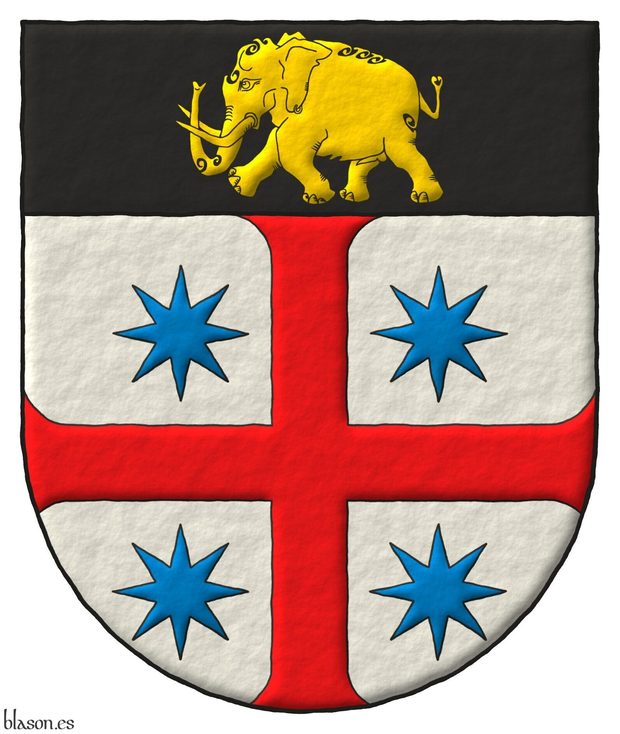
RIAG
Argent, a cross patty Gules, cantoned of four mullets of eight points Azure; on a chief Sable, an elephant passant Or.
The Registro Internacional de Armas Gentilicias, is also known as RIAG, and riag.com.es is it domain.
It is a private register of coat of arms founded in 2006 in Seville, Spain by the herald Ignacio Koblischek Zaragoza.
Categories: Institution, Socioeconomic, Semi-circular, Illuminated, Outlined in sable, Outlined in the field tincture, Freehand, Argent, Diminished cross, Patty, Gules, Cantoned, Mullet, Eight, Azure, Chief, Sable, Elephant, Passant and Or.


Ricardo de Mandeville, fretty illuminated
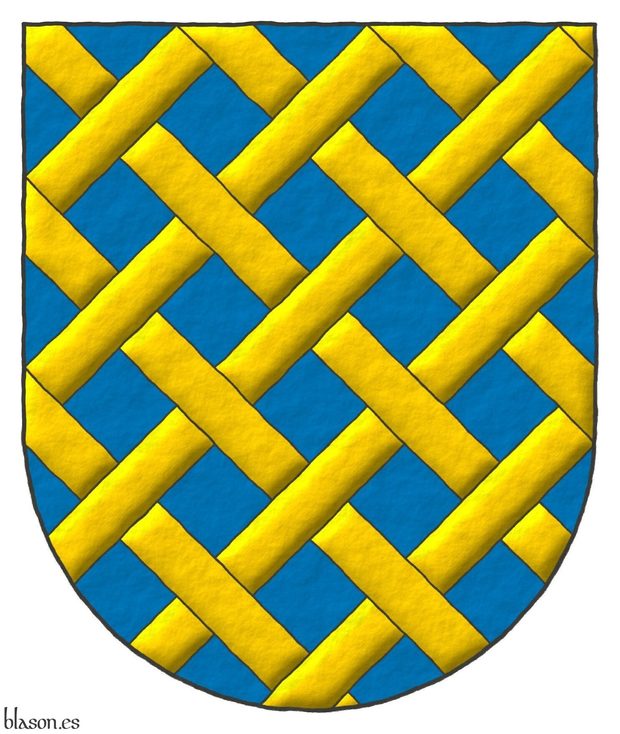
fretty ~ fretté.
Azure fretty Or.
Escudo de azur fretado de oro.
Blazon keywords: Without divisions, Azure, Fretty and Or.
Style keywords: Semi-circular, Illuminated, Outlined in sable and Freehand.
Classification: Interpreted and Personal.
Bearer: Ricardo de Mandeville.


Richard de Bures outlined
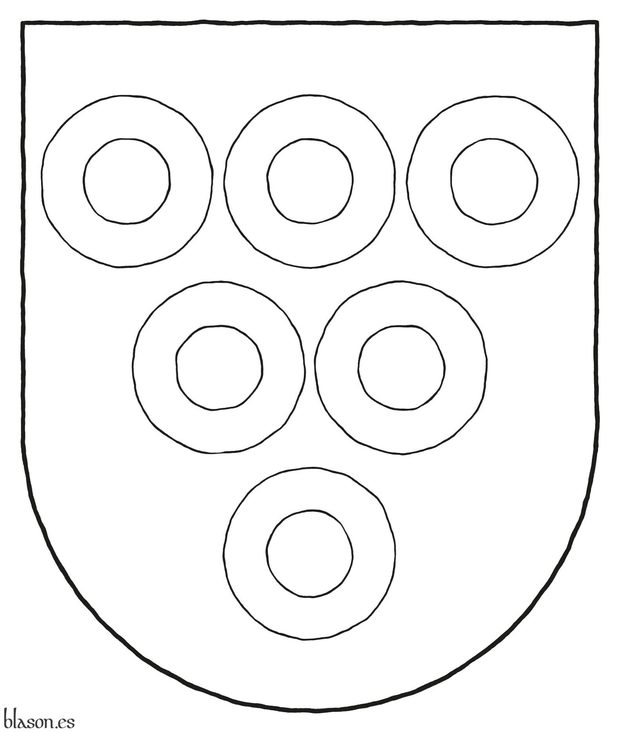
Or, six annulets Gules, 3, 2, and 1.
Escudo de oro, seis anilletes de gules, ordenados 3, 2 y 1.
Blazon keywords: Or, Six, Annulet, Gules, Ordered, Three, Two and One.
Style keywords: Outlined in sable and Semi-circular.
Classification: Religious, Military, Knights Templar, Interpreted and Coat of arms.
Bearer: Richard, Richard.


Richard I of England
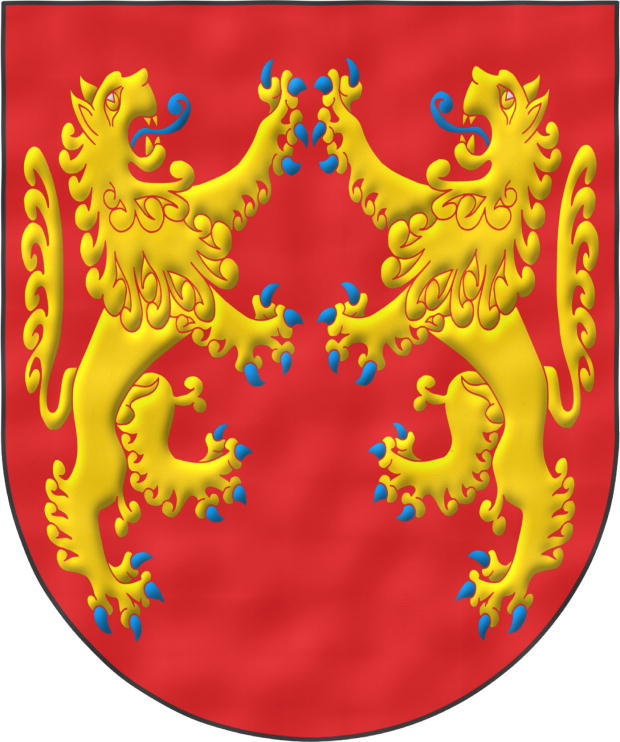
Lionheart ~ Corazón de León ~ Cœur de Lion.
Escudo de gules, dos leones de oro, afrontados, armados y lampasados de azur.
Coat of arms interpreted as follows: the mouth drawn as a semicircular (round) base; the field enamelled in a flat tint of Gules; the two lions outlined in the colour of the field and illuminated in Or and Azure; and the whole finished with a watercolour effect.
He was born in 1157, being the third of eight children of Henry II of England and Eleanor of Aquitaine, elder brother of Eleanor Plantagenet. He was king of England between 1189 and 1199, although he spent much of his life far from it; in fact, during his ten-year reign, he was on English soil only twice, which together did not amount even to six months. He died in 1199 in Normandy.
In 1198, during the Battle of Gisors, he supposedly used, as watchword or as motto, the expression «Dieu et mon Droit ~ God and my right». This phrase refers to his refusal to bow before Emperor Henry VI, since by his rank Richard acknowledged only God as superior. Later, Henry V of England adopted it as his motto, and since then it has been used by the British monarchy.
According to [Humphery-Smith, C.; 1983], Richard the Lionheart was the first English king who can be proved to have borne arms, although some of his predecessors may also have had them. He bases his statement on the existence of two seals of Richard I: on one, Richard bears a shield with a rampant lion, and on the other there already appear the three lions that are the forerunners of the arms of England. The use of this second seal does not imply that he stopped using the first.
In contrast, there are also British authors who maintain that his shield actually bore two affronted lions; this hypothesis is based on the lion on his first seal facing to sinister. That latter hypothesis is the one interpreted in this shield, remaining a purely artistic interpretation and without my entering into a complex and open discussion about how, when, and why the three leopards, «leones pasantes ~ lions passant» for the English, appeared —a discussion in which there are various alternatives— ranging from the combination of his hereditary arms to the wish to have more lions than his younger brother, who would later be King John I of England, to possible influences from other European realms.
This version of Richard I’s shield is similar to the imaginary shield of Hector of Troy, Gules with two lions Or affronté, which is a term used when «two things are placed facing each other, like two Lions, two Dogs, or other animals that look at one another» [Avilés, J.; 1725a; page 32].
Blazon keywords: Without divisions, Gules, Lion, Or, Combatant, Armed, Langued and Azure.
Style keywords: Semi-circular, Illuminated, Outlined in sable and Freehand.
Classification: Interpreted, Personal, Coat of arms, House of Plantagenet and Kingdom of England.
Bearer: Richard I of England.


Rivas of Aragon, lineage
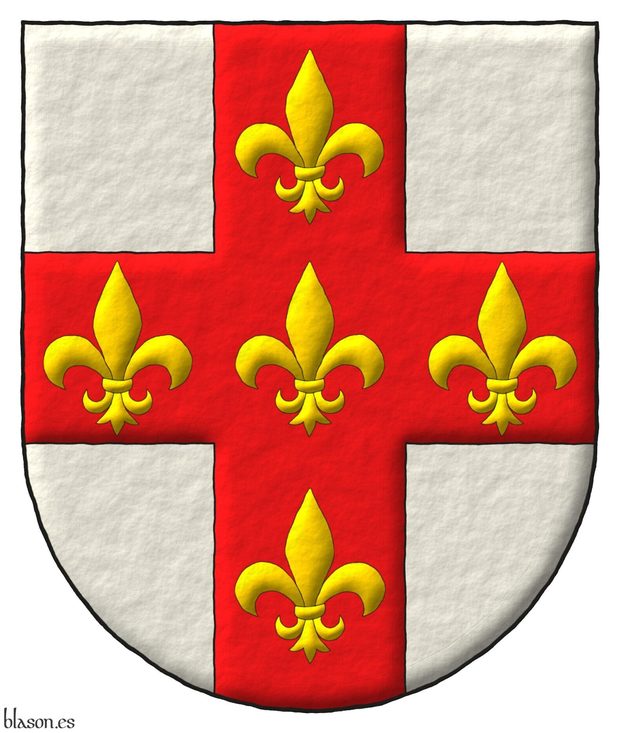
Argent, on a cross Gules five fleurs de lis Or.
Escudo de oro, una cruz de gules cargada de cinco flores de lis de oro.
Arms depicted by me, illuminated with lights and shadows, contoured in Sable, with a semi-circular outer contour and with a freehand finish.
Ancient arms of the lineage Rivas of Aragon emblazoned by me. Alternative blazon: «Argent, a cross Gules charged with five fleurs de lis Or».
Blazon keywords: Argent, Gules, Or, One, Five, Cross, Charged and Fleur de lis.
Style keywords: Outlined in sable, Illuminated, Semi-circular and Freehand.
Classification: Personal, Lineage, Interpreted, Boa and Coat of arms.
Bearer: Rivas of Aragon, lineage.


Roberto Luchoro and Darryn Carlo, plain tincture
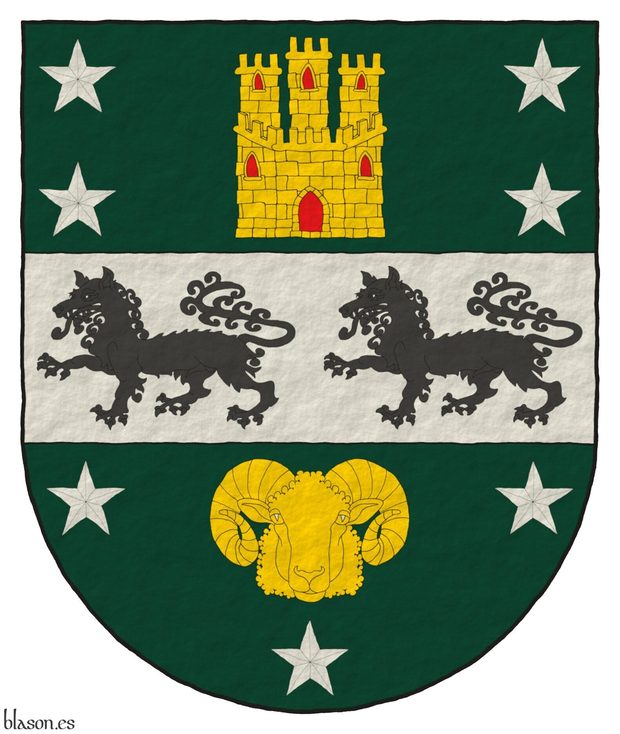
Vert, on a fess Argent, between in chief a castle triple-towered Or, port and windows Gules, masoned Sable, between four mullets Argent, 2 and 2, and in base a Merino ram's head caboshed Or, between three mullets Argent, 2 and 1, two wolves passant Sable.
Arms devised by me, in plain tinctures, contoured in Sable, with a semi-circular outer contour and with a texturized finish.
These are the matrimonial and family arms of Darryn Carlo and Roberto Luchoro emblazoned by me.
Blazon keywords: Vert, Argent, Or, Gules, Sable, One, Two, Seven, Fess, Between, In chief, Castle, Triple-towered, Port and windows, Masoned, Mullet, In base, Merino ram, Head, Caboshed, Wolf and Passant.
Style keywords: Outlined in sable, Plain tincture and Semi-circular.
Classification: Personal, Created, Boa and Coat of arms.
Bearer: Luchoro and Darryn Carlo, Roberto.


Royal Spanish Academy, coat of arms
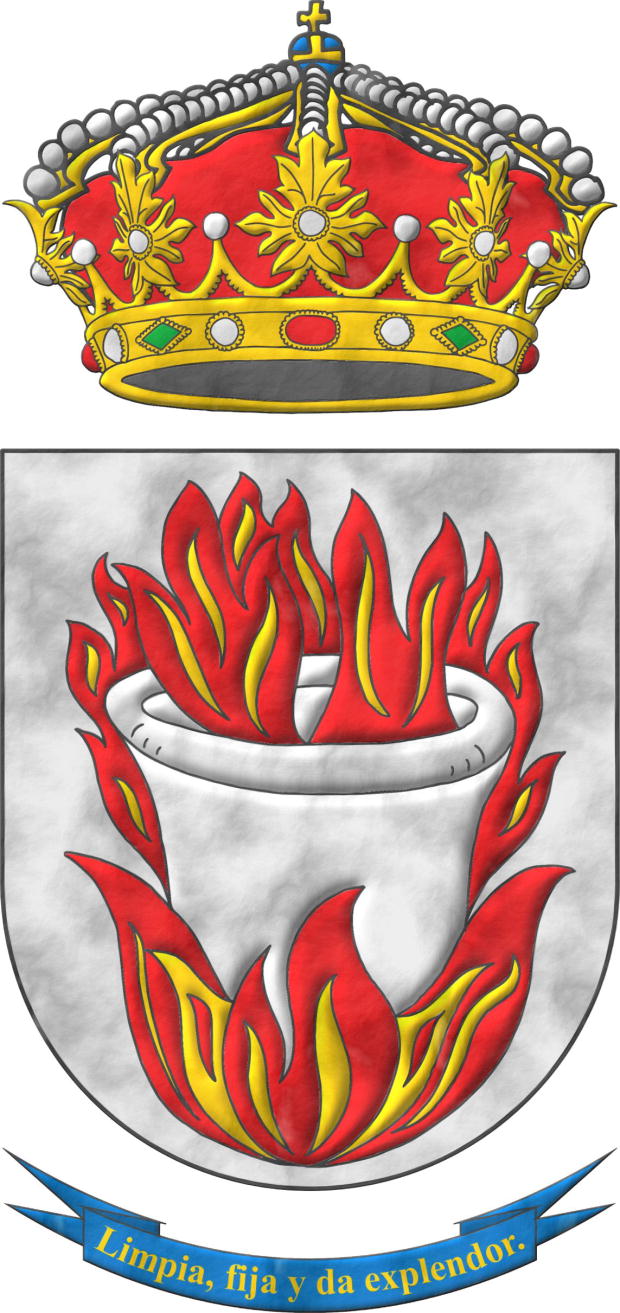
Argent, a crucible Argent, enflamed and on a bonfire hoguera Gules and Or. Crest: A closed royal crown Or, with eight arches, visible five. Motto: «Limpia, fixa, y da esplendor» Or over a scroll Azure.
Escudo de plata, un crisol de plata, llameante y sumado a una hoguera de gules y oro. Timbrado de una corona real cerrada. Lema: «Limpia, fixa, y da esplendor» de oro sobre una filacteria de azur.
Interpretation made from the Royal Academy emblem: transforming it into a semicircular-based shield, instead of its oval shape; with its motto on a scroll beneath the base, instead of surrounding it; keeping the closed royal crown in its place; with everything illuminated except the field which is in plain color; and the whole outlined in sable and with a parchment-like finish.
In this interpretation, on the Argent field, the Gules fire of the bonfire completely surrounds the Argent crucible, to avoid the metal Argent on the same.
To write the blazon for this coat of arms I use the heraldic term «llameante». Therefore, I do not follow [Avilés, J.; 1780a; page 82 and figure 163] when he writes «...y un Fénix de gules sobre una hoguera encendida de lo mismo.». He uses this example to illustrate the 2 fundamental uses of the term «encendido» which is said when «the Eyes of animals... are of a different color» and «also of a burning Bush and the same for a Torch, when the flame is of a different tincture».
Blazon keywords: Without divisions, Argent, One, Crucible, Enflamed, Bonfire, Gules, Or, Closed royal crown, Crown, Motto, Scroll and Azure.
Style keywords: Semi-circular, Illuminated, Outlined in sable and Parchment.
Classification: Interpreted, Socioeconomic and Coat of arms.
Bearer: Royal Spanish Academy.


Royal standard of Felipe VI of Spain
Quarterly: 1 Gules, a castle triple-towered Or, port and windows Azure, masoned Sable [for Castile]; 2 Argent, a lion rampant Purpure, armed and langued Gules, crowned Or [for Leon]; 3 Or, four pallets Gules [for Aragon]; 4 Gules, a chain orlewise, crosswise, and saltirewise Or, charged in the fess point with an emerald Vert [for Navarre]; enté en point Argent, a pomegranate proper, seeded Gules, slipped and leaved Vert [for Granada]; an inescutcheon Azure, three fleurs de lis Or, 2 and 1, a bordure Gules [for Bourbon]. Crest: A closed royal crown. The shield is surrounded by the Golden Fleece. Behind the shield, a crimson square.
It has been depicted by me, illuminated with lights and shadows, contoured in Sable, with a square outer contour and with a texturized finishing.
The Royal Standard of His Majesty the King Felipe VI of Spain emblazoned by me. In this case, crimson is not treated as a heraldic tincture, but merely as a chromatic description.
Blazon keywords: Gules, Azure, Purpure, Vert, Or, Argent, One, Three, Four, Quarterly, Castle, Triple-towered, Port and windows, Masoned, Lion, Rampant, Crowned, Pallet, Chain, Orlewise, Crosswise, Saltirewise, Charged, In the fess point, Emerald, Enté en point, Pomegranate, Proper, Slipped, Leaved, Inescutcheon, Fleur de lis, Ordered, Bordure, Closed royal crown, Crown, Surrounded, Collar, Behind the shield and Fimbriated.
Style keywords: Outlined in sable, Illuminated, Semi-circular and Square.
Classification: Personal, Kingdom of Spain, Interpreted, Boa, Standard and Flag.
Bearer: Felipe VI of Spain.


Santiago-Vazquez, Lory
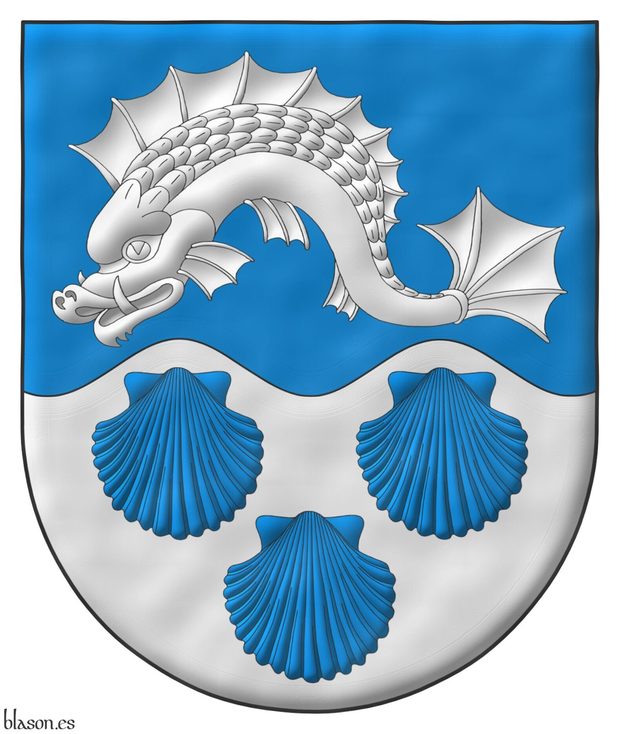
Party per fess wavy Azure and Argent in chief a dolphin and in base three escallops counterchanged.
Escudo cortado ondado: 1o de azur, un delfín nadante; 2o de plata, tres veneras de azur.
Coat of arms painted by me, highlighted with lights and shadows, outlined in Sable, with a semi-circular outer contour and with a watercolor finish.
The coat of arms of Lory Santiago-Vazquez emblazoned by me.
Blazon keywords: Azure, Argent, One, Three, Party per fess, Wavy, Dolphin, Naiant and Escallop.
Style keywords: Outlined in sable, Illuminated, Semi-circular and Watercolor.
Classification: Personal, Interpreted, Boa and Coat of arms.
Bearer: Santiago-Vazquez, Lory.


Savoy, Duchy of
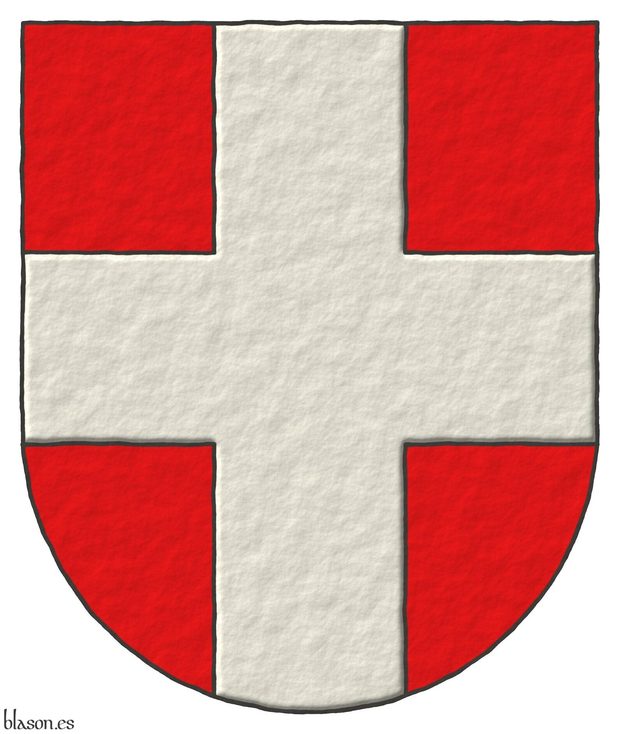
Gules, a cross Argent.
Escudo de gules, una cruz de plata.
Coat of arms of the House of Savoy and the Duchy of Savoy, which I have interpreted as follows: the shield has a semicircular (round) base; the field is illuminated in flat tincture Gules; the cross is illuminated in Argent; and the whole coat of arms is rendered with a raised-stroke effect.
This coat of arms is both familial and political, for it is also the coat of arms of the French departments of Savoy and Haute-Savoie, both belonging to the Rhône-Alpes region.
The cross in this shield is an honourable ordinary, for it is a full cross, the result of combining a fess and a pale. This full cross is wide and reaches the edges of the shield and is therefore large enough to bear charges. For this reason these ordinaries are called “honourable,” because they may be honoured with additional charges. In English heraldry they are known as «ordinaries», [The Heraldry Society; 2013; page 11].
This coat of arms is recorded in the armorial [Marshal, L.; 1295; shield number 32] together with the text «Le Counte de Sauveys, Gules a cross argent, Amadeus V, Comte de Savoie».
Blazon keywords: Without divisions, Gules, Argent and Cross.
Style keywords: Semi-circular, Illuminated and Freehand.
Classification: Interpreted, Personal, Coat of arms and House of Savoy.
Bearer: Savoy, Duchy of.


Schema of a bordure and a diminished bordure
Proporciones de una bordura y una filiera, una filiera es una bordura con su ancho disminuido en 2/3.
In heraldry, a diminished bordure is a diminished bordure. In the design, it is typically drawn at 2/3 the width of a standard bordure. Since the width of a standard bordure is usually 1/6 of the coat of arms' width, a diminished bordure calculated this way would be 1/9 of the coat of arms' width.
However, diminished bordures can also be found with a width of 1/2 that of a standard bordure, in other words, 1/12 of the coat of arms' width, or 1/3 that of a standard bordure, that is to say, 1/18 of the coat of arms's width.
The so-called bordure of pieces usually has a width of 1/2 that of a standard bordure, which is 1/12 of the coat of arms's width.
Blazon keywords: Without divisions, Bordure and Diminished bordure.
Style keywords: Semi-circular.
Classification: Schema and Coat of arms.
Bearer: Categories of heraldry.


Scheme of a bend and a bend sinister
Proportions and angle of a bend and a bend sinister.
The proportion of a coat of arms is 5/6,
- with 5 being the base, the so-called adjacent side, b in the diagram, and
- with 6 being the height, the so-called opposite side, h in the diagram.
The tangent of the angle between the base of the shield and the diagonal of the bend is calculated as the opposite side divided by the adjacent side, that is, 6 divided by 5 which is 1.2 = 6/5.
If I wish to know the angle, I must apply the inverse function of the tangent, which is the arctangent. Therefore, the angle is arctangent(6/5) = arctangent(1.2) = 50.194o, which in radians is 0.876, and I usually round it to 50.2o.
The complementary angle to 50.2o is 39.8o (90o - 50.2o = 39.8o), which is the angle formed between the diagonal of the bend sinister and the dexter side of the shield.
Depending on the artist, on his style or, in other cases, on the need to organize the space within the shield, angles of 45o can also be used, corresponding to the diagonal angle of a square.
Blazon keywords: Without divisions, Bend and Bend sinister.
Style keywords: Semi-circular.
Classification: Schema and Coat of arms.
Bearer: Zúñiga y Guzmán, Álvaro de.


Scheme with a pale and a cross
Proportions of the cross and its similarity with the pale.
This schema shows two coats of arms, the first with the proportion scheme of a pale, the second with the proportion scheme of a cross, and allows us to observe the common proportions between a pale and a cross.
Blazon keywords: Without divisions, Pale and Cross.
Style keywords: Semi-circular.
Classification: Schema and Coat of arms.
Bearer: Saboya, Ducado de.


Sea of Alborán, plain tincture
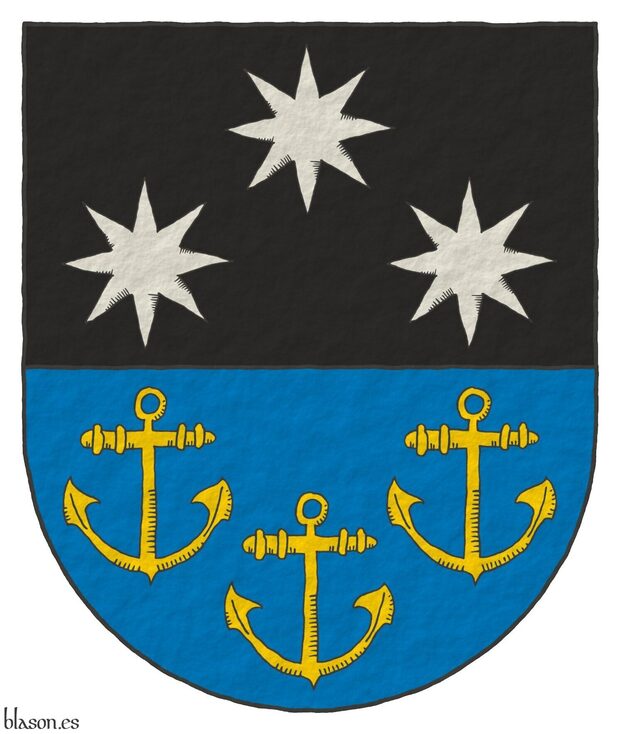
Party per fess: 1 Sable, three mullets of eight points Argent, 1 and 2; 2 Azure, three anchors Or, 2 and 1.
Arms devised by me, in flat tinctures, contoured in Sable, with a semi-circular external shape and with a texturized finishing.
Coat of arms of the Sea of Alboran designed and emblazoned by me as imaginary heraldry. This coat of arms is one of my very first heraldic designs.
Blazon keywords: Sable, Argent, Azure, Or, Three, Party per fess, Mullet, Disordered, Anchor and Ordered.
Style keywords: Outlined in sable, Plain tincture and Semi-circular.
Classification: Imaginary, Created, Boa and Coat of arms.
Imaginary bearer: Alborán, Sea of.


Shield surrounded by the Grand Collar of the OERC
It has been interpreted by me, highlighted with lights and shadows, outlined in Sable, with a semi-circular outer contour and with a rough finishing.
Coat of arms with the Grand collar of the Ordo Equestris Reginae Caeli emblazoned by me. The OERC promotes solidarity, compassion, and the spirit of service toward those most in need.
Blazon keywords: Order, Decoration, Azure, Or, Argent, One, Four, Eight-pointed cross, Cross couped, Fleur de lis, Crowned, Monogram, Grand collar and Surrounded.
Style keywords: Outlined in sable, Illuminated, Semi-circular and Rough.
Classification: Interpreted and Boa.
Bearer: Ordo Equestris Reginae Caeli.


Simon de Crombe
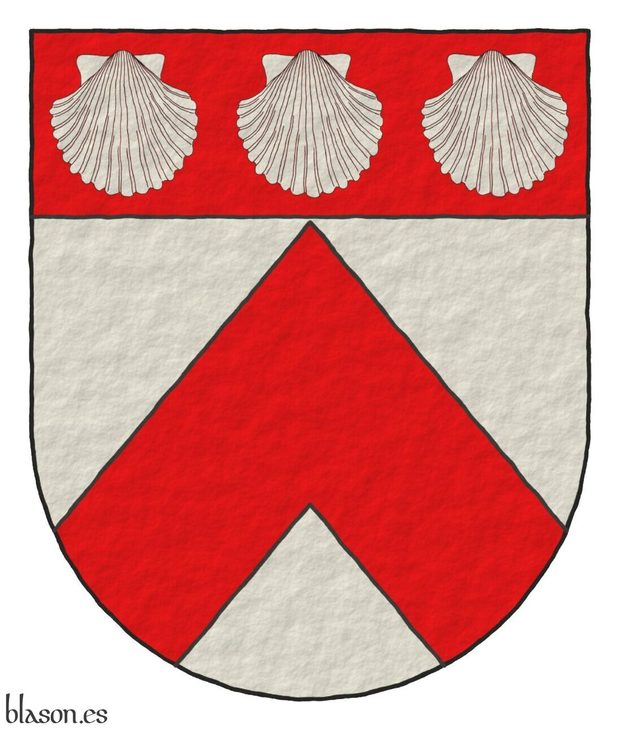
Simon de Croome ~ Simon de Crombe.
Argent, a Chevron Gules, on a Chief Gules, three escallops Argent, in fess.
Escudo de plata: un cabrio de gules; el jefe de azur, tres veneras de plata, en faja.
Included in [Vincent, MS; 1285; number 623] also known as [St. George's Roll; 1285; number 623].
The 3 escallops are in the chief then the description «in fess» are not really needed.
Blazon keywords: Without divisions, Argent, One, Chevron, Gules, Chief, Three, Escallop and In fess.
Style keywords: Semi-circular, Plain tincture, Outlined in sable and Freehand.
Classification: Interpreted and Personal.
Bearer: Simón de Croome.


Simon de Ver
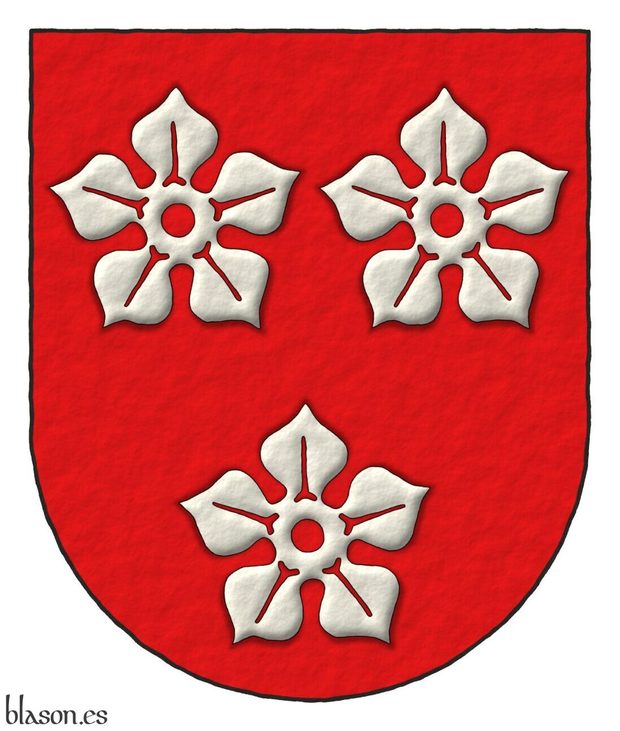
Simon de Vere ~ Simon de Ver.
Gules, three cinquefoils Argent.
Escudo de gules, tres quinquefolios de plata.
Included in [Vincent, MS; 1285; number 85] also known as [St. George's Roll; 1285; number 85].
Blazon keywords: Without divisions, Gules, Three, Cinquefoil, Argent and Ordered.
Style keywords: Semi-circular, Illuminated, Shaded, Outlined in sable and Freehand.
Classification: Interpreted and Personal.
Bearer: Simón de Vere.


Simon le FizSimon
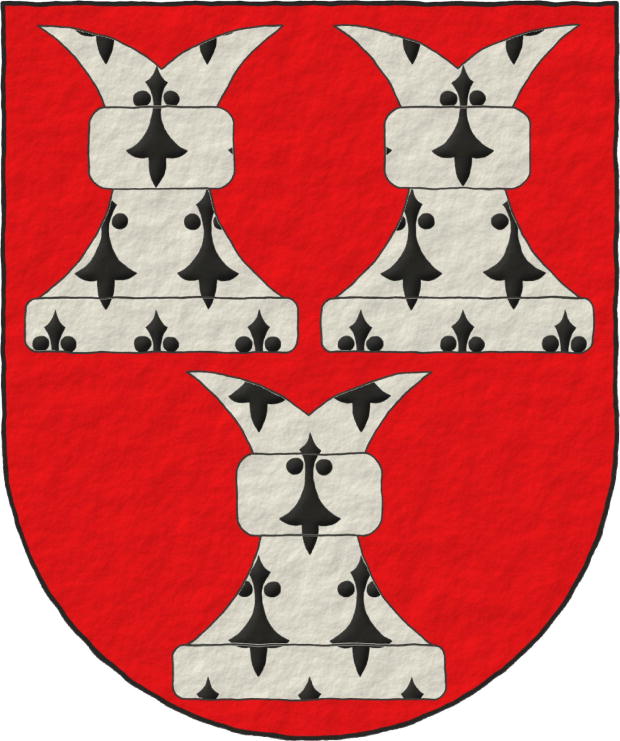
Simon FitzSimon ~ Simon le FizSimon.
Gules, three chess rooks Ermine.
Escudo de gules, tres roques de armiños.
Included in [Vincent, MS; 1285; number 224] also known as [St. George's Roll; 1285; number 224].
Blazon keywords: Without divisions, Gules, Three, Chess rooks, Ermine and Ordered.
Style keywords: Semi-circular, Illuminated and Outlined in sable.
Classification: Interpreted and Personal.
Bearer: Simón FitzSimon.


Sister Esperanza Vega Lanzagorta, plain tincture
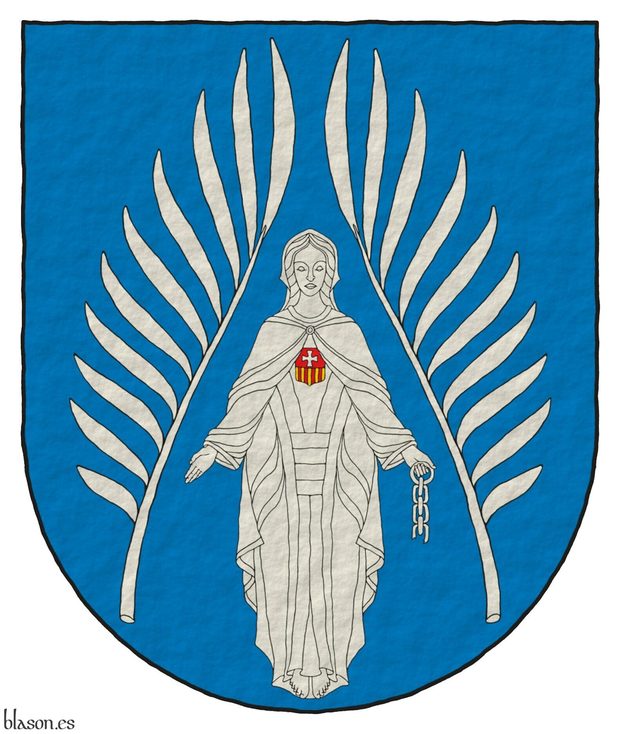
Azure, between two palm fronds in pile reversed a Lady of Mercy grasping in her sinister hand a broken chain Argent, and charged on the chest with an escutcheon per fess, 1 Gules, a cross patty Argent, and 2 Or, four pallets Gules.
Coat of arms designed by me, in flat tinctures, outlined in Sable, with a semi-circular external shape and with a texturized finishing.
This is the coat of arms of Sister Esperanza Vega Lanzagorta, designed by Juan Lanzagorta Vallin and painted by me. Alternative blazon: «Azure, between two palm fronds in pile reversed a Virgin of Mercy grasping in her sinister hand a broken chain Argent, and charged on the chest the Mercedarian coat of arms».
Credits: Juan Lanzagorta Vallin is the designer of the coat of arms.
Blazon keywords: Azure, Argent, Gules, Or, One, Two, Our Lady of Mercy, Grasping, Sinister, Hand, Broken, Chain, Charged, Chest, Escutcheon, Party per fess, Cross patty, Cross couped, Between, Palm frond and In pile reversed.
Style keywords: Outlined in sable, Plain tincture and Semi-circular.
Classification: Personal, Created, Boa and Coat of arms.
Bearer: Vega Lanzagorta, Sister Esperanza.


Stauffenberg, Claus von
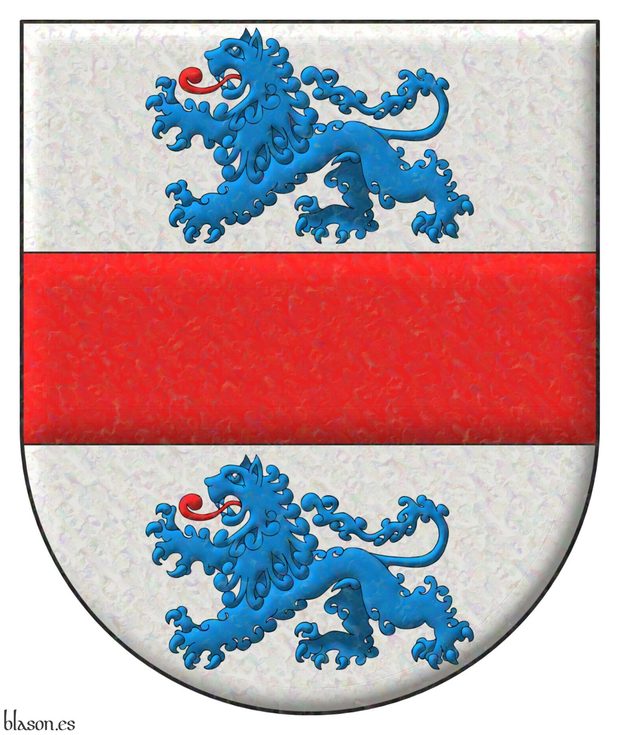
Argent, a fess Gules between two Lions passant Azure, langued Gules.
I have interpreted this coat of arms with a semi-circular shape; tintures argent, gules, and azure; outlined with sable; and a iridiscent finishing.
Blazon keywords: Argent, One, Fess, Gules, Between, Two, Lion passant, Azure and Langued.
Style keywords: Semi-circular, Iridescent (nacar) and Outlined in sable.
Classification: Interpreted, Personal and Coat of arms.
Bearer: Stauffenberg, Claus von.


Stephan Urs Breu, arms on tartan
Scottish Register of Tartans, registration number 13980.
Party per fess: 1 Argent, a rose Gules, barbed and seeded proper; 2 Gules, two swords in saltire Argent, hilted Or.
Escudo cortado: 1o de plata, una rosa de gules, hojada de sinople, botonada de oro; 2o de gules, dos espadas en sotuer de plata, guarnecidas de oro.
Coat of arms emblazoned by me with a semi-circular shape, illuminated, and with a leather finishing, over his personal tartan registered in the Scottish Register of Tartans.
Blazon keywords: Party per fess, Argent, One, Rose, Gules, Leaved, Seeded, Two, Sword, In saltire, Hilted, Or and Proper.
Style keywords: Semi-circular, Outlined in sable, Illuminated and Leather.
Classification: Personal, Interpreted, Coat of arms and Tartan.
Bearer: Breu, Stephan Urs.


Stewart of Scotland, lineage
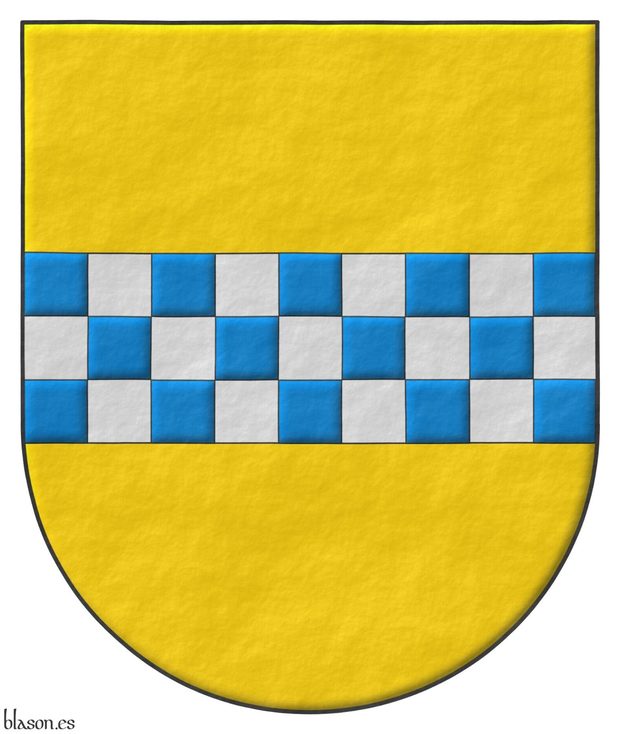
Or, a fess chequey Azure and Argent.
Escudo de oro, una faja ajedrezada de azur y plata.
Coat of arms emblazoned by me, illuminated with lights and shadows, outlined in Sable, with a semi-circular outer contour and with a rough finishing.
Coat of arms of the lineage Stewart of Scotland. I have emblazoned it with a fess chequy of 3 rows, symmetric and with 9 columns of squares, provided that its height is 1/3 of the width of the coat of arms.
Blazon keywords: Or, Azure, Argent, One, Three, Nine, Fess and Chequey.
Style keywords: Outlined in sable, Illuminated, Semi-circular and Rough.
Classification: Personal, Lineage, Interpreted, Boa and Coat of arms.
Bearer: Stewart of Scotland, lineage.


Stuart, John
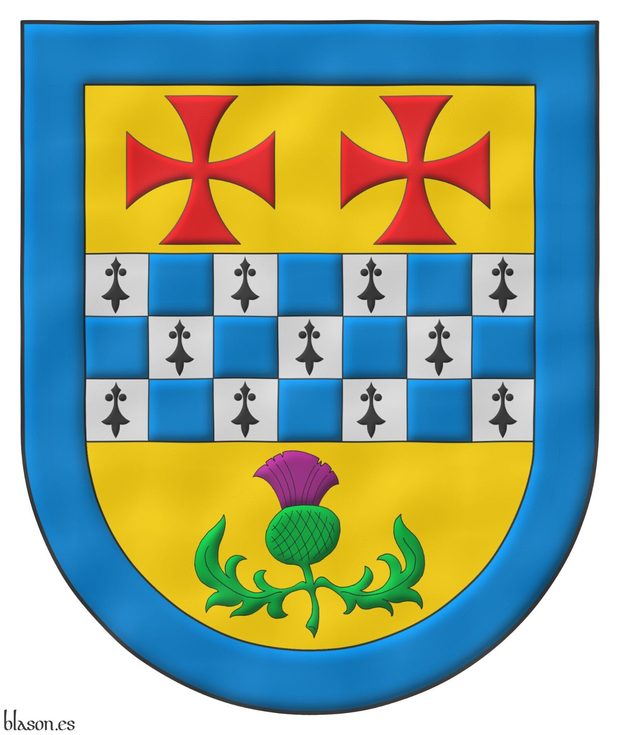
Or, a fess chequey Argent, charged with an ermine spot, and Azure, between in chief two cross patty Gules, in base a thistle proper; a diminished bordure Azure.
Escudo de oro, una faja ajedrezada de plata, cargada de una cola de armiño, y azur, acompañada en jefe de dos cruces patadas de gules, en base de un cardo al natural; una filiera de azur.
Coat of arms painted by me, highlighted with lights and shadows, outlined in Sable, with a semi-circular outer contour and with a watercolor finish.
Coat of arms of Reverend John Stuart, XVIII century, emblazoned by me.
Blazon keywords: Or, Argent, Azure, One, Three, Nine, Two, Fess, Chequey, Charged, Ermine spot, Between, In chief, Cross, Patty, In base, Thistle, Proper and Diminished bordure.
Style keywords: Outlined in sable, Illuminated, Semi-circular and Watercolor.
Classification: Personal, Interpreted, Boa and Coat of arms.
Bearer: Stuart, John.


Subiça of Navarre
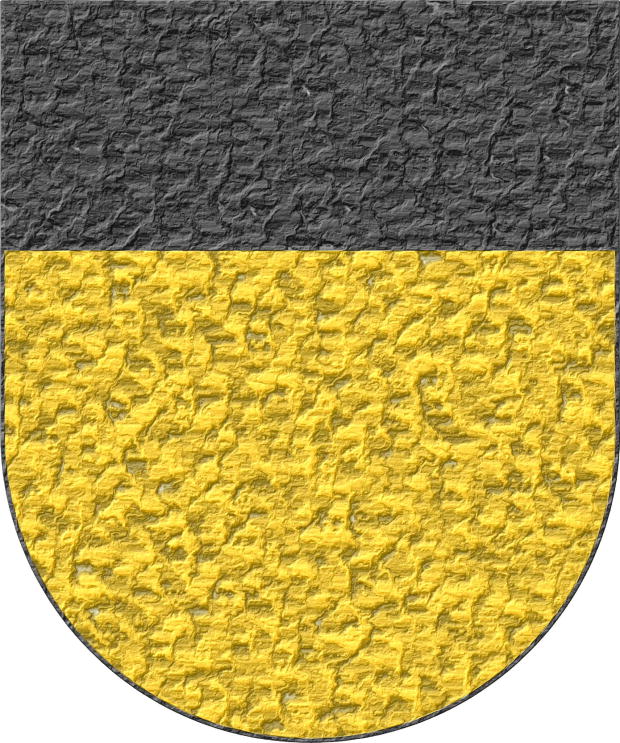
Of the twelve lineages of Noblemen, the seventh is Subiça, and bears as arms a shield Or, with a chief Sable at the upper part of the shield, in the same manner as painted in this one.
Or; a chief Sable.
Escudo de oro; el jefe de sable.
Coat of arms interpreted with: a semicircular (round) base; the field in flat Or metal; the chief in flat Sable; and the whole finished in highly-hammered metal.
Coat of arms based on the seventh of the Navarrese «ricoshombres» from [Bosque, J. del; 1540; folio 1 of the numbering of 1613]. The text heading it is taken from the transcription made by [Martinena Ruiz, J. J.; 1982; pages 122 and 123].
Under the title «Surname of Cubiza» these armorial bearings can be consulted in [Vega, P. J. de; 1702; folio 7 of the manuscript].
Blazon keywords: Without divisions, Or, Chief and Sable.
Style keywords: Semi-circular, Plain tincture and Hard metal.
Classification: Interpreted, Personal and Kingdom of Navarre.
Bearer: Subiça of Navarre.


Talbot, lineage of England
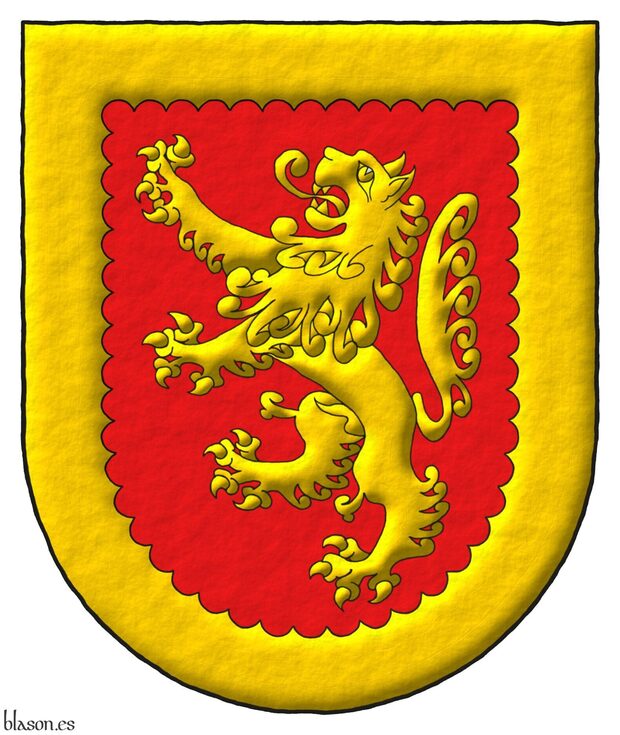
Blazon of the Talbot lineage of England.
Escudo de gules, un león rampante dentro de una bordura angrelada todo oro.
Gules, a lion rampant within a bordure engrailed Or.
Illuminated with lights and shadows and with a freehand finish.
[Rietstap, J. B.; 1861] writes it in French as «de gueules, au lion d'or, à la bordure engrelée du même». y [Burke, J.; 1836; volume 3, pages 359-360] writes it in English as «Gu. a lion rampant, within a bordure engr. or».
Blazon keywords: Without divisions, Gules, One, Lion, Rampant, Within, Bordure, Engrailed and Or.
Style keywords: Freehand, Outlined in sable, Illuminated and Semi-circular.
Classification: Interpreted, Lineage and Kingdom of England.


Technica impendi nationi
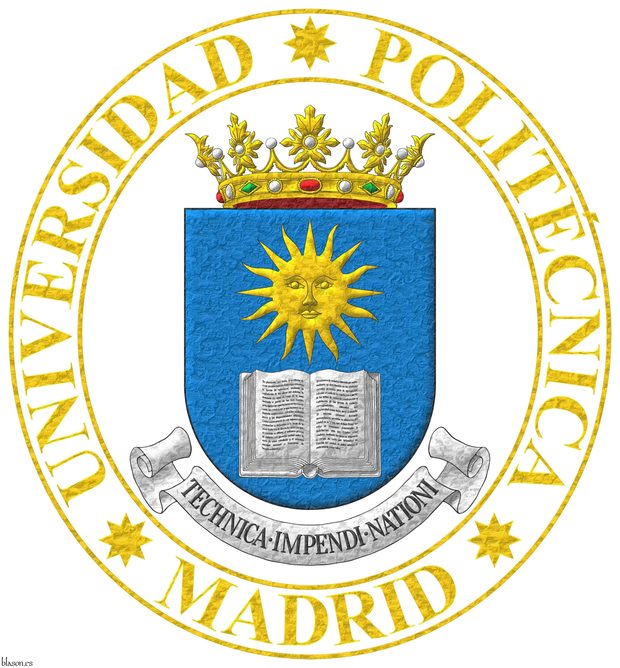
Azure, in base an open book Argent, in chief a sun in splendour Or. Crest: An open royal crown. Motto: «Technica impendi nationi». Motto around the shield: «Universidad de Politécnica de Madrid» fimbriated and depinted Or.
Escudo de azur, un libro abierto de plata surmontado de un sol de oro. Timbrado de una corona real abierta. Lema: «Technica impendi nationi». Divisa alrededor del escudo: «Universidad de Politécnica de Madrid» perfilada y en letras de oro.
Coat of arms interpreted as follows: a semicircular (round) base; the field in flat Azure; the field and charges are illuminated in the tinctures Azure and the metals Argent and Or, all outlined in Sable; my rendition of this coat of arms differs from others in that the sun’s rays, although outlined in Sable, are Or; in the legibility of the text written on the book; and in separating with a dot the words that form the motto; and the whole finished with a beaten-metal effect.
Metal batido y anacarado
Blazon keywords: Without divisions, Azure, Argent, Or, Book, Sun in splendour, Crest and mantling, Crown, Open royal crown, Motto and Motto (identification).
Style keywords: Semi-circular, Oval, Illuminated, Outlined in sable and Metal beaten.
Classification: Interpreted, Socioeconomic and Education.
Bearer: Technical University of Madrid.


![Ver [Templar and Humanitarian Order of the Kingdom of Spain in Twelve Lineages] en enlaces recomendados. Áncora de oro y la divisa enlace.](../css/Ancora.Enlace.png)
Templar and Humanitarian Order of the Kingdom of Spain in Twelve Lineages
My interpretation of the arms of the Templar and Humanitarian Order of the Kingdom of Spain with the help of Antonio José Gómez Morillo, on the blog Twelve Lineages of Soria in an article entitled: Beautiful rendering of the Arms of the T.H.O.K.S., created by Mr. Antonio Salmerón Cabañas.
Categories: Link, Watercolor, Freehand, Semi-circular, Closed royal crown, Crown, Supporter (human form), Supporter, Mantle, Sable, Gules, Argent, Or, Ermine, Cross of Saint James, Cross couped, Escallop, Flag and Party per pale.
Root: Twelve Lineages of Soria.


Tercio Alessandro Farnese
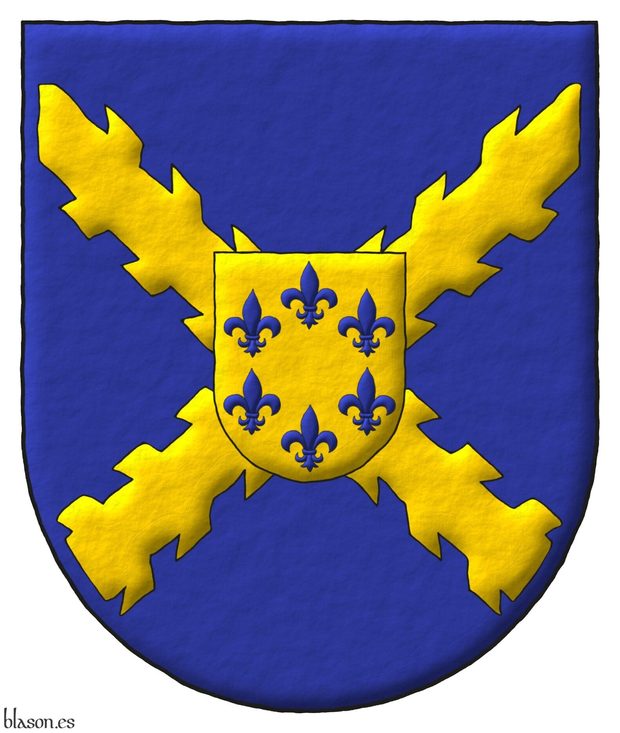
Azure, a cross of Burgundy Or; an inescutcheon Or, six fleurs de lis in orle Azure.
Escudo de azur, una cruz de Borgoña de oro; un escusón de oro, seis flores de lis en orla de azur.
Coat of arms interpreted by me, illuminated with lights and shadows, contoured in Sable, with a semi-circular external shape and with a freehand finishing.
Coat of arms of the Tercio Alessandro Farnese, 4th of the Spanish Legion, emblazoned by me. In honor of Alessandro Farnese, the central inescutcheon bears in orle the 6 fleurs de lis of the Farnese family.
Blazon keywords: Azure, Or, One, Six, Cross of Burgundy, Cross couped, Inescutcheon, Fleur de lis and In orle.
Style keywords: Outlined in sable, Illuminated, Semi-circular and Freehand.
Classification: Military, Interpreted, Boa and Coat of arms.
Bearer: Tercio Alessandro Farnese.


Tercio Great Captain
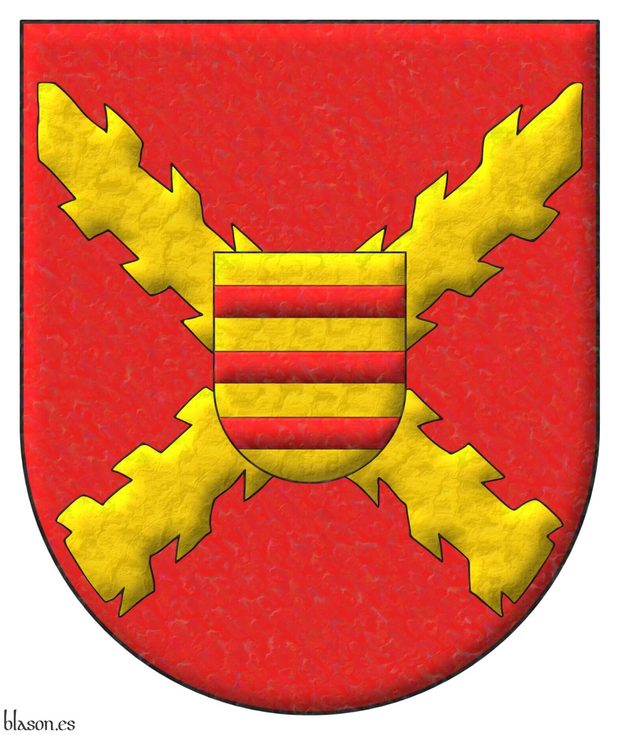
Gules, a cross of Burgundy Or; an inescutcheon Or, three bars Gules.
Escudo de gules, una cruz de Borgoña de oro; un escusón de oro, tres fajas de gules.
Arms painted by me, illuminated with lights and shadows, outlined in Sable, with a semi-circular outer contour and with a metal beaten finish.
Coat of arms of the Tercio Great Captain, 1st of the Spanish Legion, emblazoned by me. The inescutcheon represents the coat of arms of Gonzalo Fernandez de Cordoba, 1453-1515, known as «The Great Captain». During the Italian campaigns in the late 15th and early 16th centuries, especially during the wars of Naples, Gonzalo Fernandez de Cordoba reformed the Spanish army, adapting it to the new conditions of Renaissance warfare. He created a flexible tactical system based on the combination of pikemen, inspired by the Swiss; «espingarderos», forerunners of the arquebusiers; and «espadas» or shock troops, this combination would form the foundation of the future «Tercios».
Blazon keywords: Gules, Or, One, Three, Cross of Burgundy, Cross couped, Inescutcheon, Bar and Fess.
Style keywords: Outlined in sable, Illuminated, Semi-circular and Metal beaten.
Classification: Military, Interpreted, Boa and Coat of arms.
Bearer: Tercio Great Captain.


Teresa of Entenza
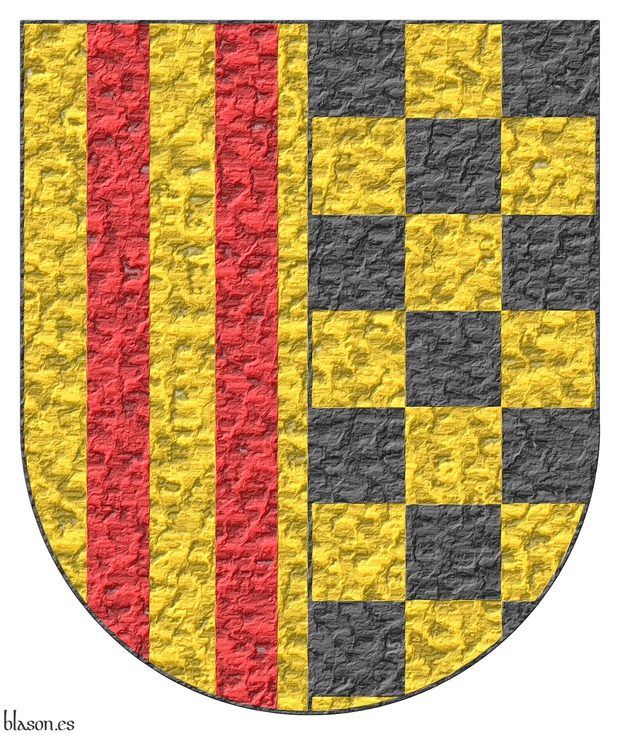
Countess of Urgell, Viscountess of Ager, Lady of Alcolea de Cinca, died in 1327.
Dimidiated: 1 Or, four pallets Gules; 2 chequey Or and Sable.
Escudo dimidiado: 1o de oro, cuatro palos de gules; 2o ajedrezado de oro y sable.
Arms interpreted with: a round-bottom shield; all tinctures in flat Or, Gules, and Sable; and a heavily beaten metal finish.
A dimidiated coat of arms is the result of combining two shields of arms by taking the dexter half of the first and the sinister half of the second.
Dimidiation was used in the 13th and 14th centuries to combine, for instance, the arms of two families.
Its blazoning method does not consist of describing what appears in each of the resulting quarters, but rather, by stating from the beginning that it is dimidiated, describing the original coats of arms. Thus, in this particular case of the arms of Teresa of Entenza, it is not stated that there are only two pallets in the first quarter, but that it is dimidiated and has four pallets, so the reader must know that from the four pallets, only the first two are visible due to the dimidiation.
This method of dimidiating the arms of predecessors results in very beautiful and original designs, but depending on the charges and figures involved, in other cases the result may be unrecognisable or even absurd.
Blazon keywords: Dimidiated, Pale, Chequey, Or, Gules and Sable.
Style keywords: Semi-circular, Plain tincture and Hard metal.
Classification: Interpreted, Personal, Coat of arms and Kingdom of Aragon.
Bearer: Teresa of Entenza.


Terraza of Aragon, lineage

Or, three lion’s paws erect and erased Or, 2 and 1, each grasping a Madonna lily Argent.
Escudo de oro, tres garras de león arrancadas y alzadas de oro, ordenadas, 2 y 1, teniendo cada una una azucena de plata.
Arms emblazoned by me, illuminated with lights and shadows, contoured in Sable, with a semi-circular external shape and with a watercolor finishing.
Coat of arms of the lineage Terraza of Aragon, emblazoned by me following the instructions of Enrique de Alzaga Aliena. The fleur de lis ~ «flor de lis» is a stylized or idealized lily. The lily ~ «lirio» is the flower itself, of which there are various species. The Madonna lily ~ «azucena» is a specific kind of lily; I do not call it white lily to avoid redundancy when it is Argent ~ «plata».
Blazon keywords: Azure, Or, Argent, Three, One, Lion, Paw, Erect, Erased, Ordered, Grasping and Madonna lily.
Style keywords: Outlined in sable, Illuminated, Semi-circular and Watercolor.
Classification: Personal, Lineage, Interpreted, Boa and Coat of arms.
Bearer: Terraza of Aragon, lineage.


The coat of arms of Gilbert Hérail in 3 steps
Argent, a cross Azure.
Blazon keywords: Argent, One, Cross and Azure.
Style keywords: Outlined in sable, Illuminated, Semi-circular, Plain tincture and Freehand.
Classification: Religious, Military, Knights Templar, Interpreted, Coat of arms and Schema.
Bearer: Hérail, Gilbert.


The coat of arms of María Concepción Vallín de Lanzagorta outlined
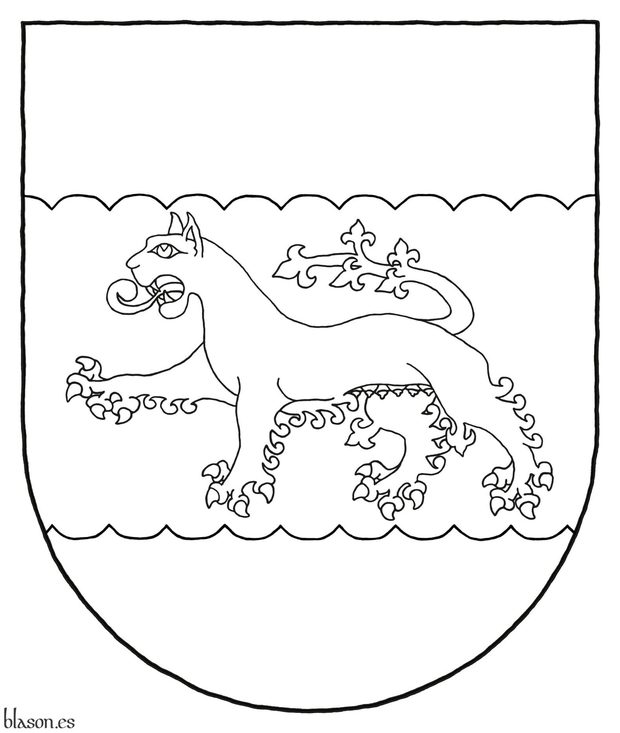
Gules, on a fess invected Argent, a lioness Azure, armed, langued and the udders Gules.
Blazon keywords: Gules, One, Fess, Invected, Argent, Charged, Lioness, Azure, Armed, Langued and Udder.
Style keywords: Semi-circular, Outlined in sable, Diapered and Outlined.
Classification: Personal, Interpreted and Coat of arms.
Bearer: Vallín de Lanzagorta, María Concepción.


The coat of arms of Miguel Francisco Lanzagorta Escutia outlined
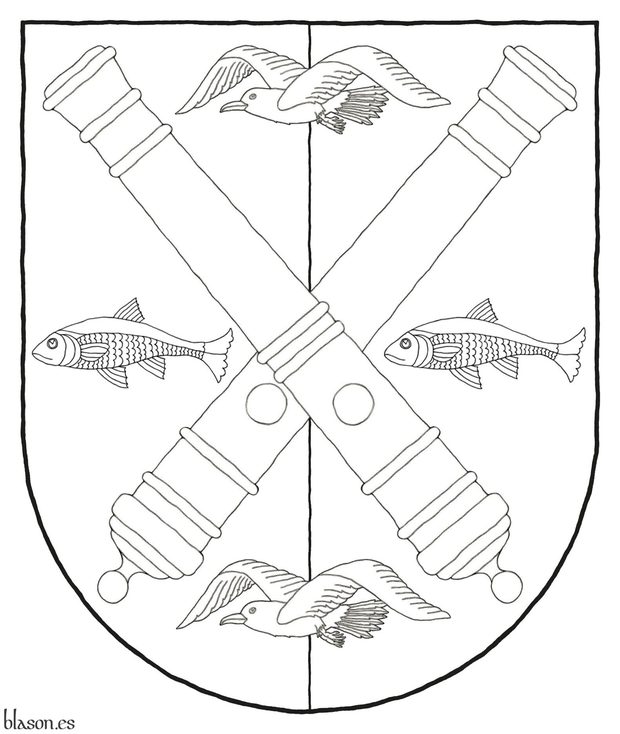
Party per pale Vert and Azure, overall two cannons dismounted in saltire, between two seagulls volant in pale, and two fish naiant in fess Argent.
Blazon keywords: Party per pale, Vert, Azure, Overall, Two, Cannon dismounted, Cannon, In saltire, Between, Seagull, Volant, In pale, Fish, Naiant, In fess and Argent.
Style keywords: Semi-circular, Outlined in sable and Outlined.
Classification: Personal, Interpreted and Coat of arms.
Bearer: Lanzagorta Escutia, Miguel Francisco.


![Ver [The Heraldry Society of Scotland] en instituciones citadas. Fortaleza de oro y mazonada de sable.](../css/Fortaleza.Institucion.png)
The Heraldry Society of Scotland
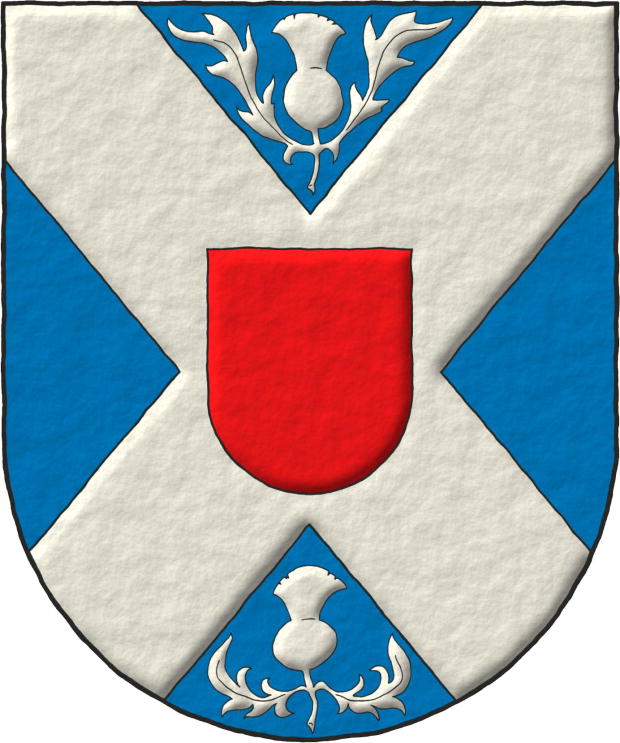
Objectives and activities
The Heraldry Society of Scotland ~ «The Heraldry Society of Scotland», was founded in 1977. Its objectives are to promote the study of heraldry and to encourage its correct use both in Scotland and abroad.
The HSS (acronym for The Heraldry Society of Scotland) encourages those who have a coat of arms and those who intend to adopt their own arms to become members of the society and also encourages to join all those interested in Scottish heraldry, therefore the HSS admits and has members from all over the world.
The HSS holds active and regular meetings throughout the year and organizes conferences and visits to places of historical and heraldic interest, both within Scotland and in other countries.
Online content
They also maintain and update a website, whose domain is Heraldry-Scotland.co.uk, with interesting and abundant reading material, among which their list of online armorials with blazons in English stands out, among which the following armorials can be highlighted:
- Sir David Lindsay's Armorial from 1542, with 504 coats of arms and identification letters «DL», from «DL001» to «DL504». Includes imaginary coats of arms, for example, that of «DL011» of Hector of Troy which it imagines as «Sable, two lions combatant Or», which [Avilés, J.; 1725a; page 7] blazons with a Gules field, this difference would allow tracing the sources of each author, which would be interesting as it is, moreover, imaginary.
- Hamilton Armorial, from 1560, with 82 coats of arms they say, although only 79 appear, and identification letters «HM», from «HM001» to «HM079», where for example, «HM001» is the arms of Scotland «Or, a lion rampant Gules armed and langued Azure within a double tressure flory counter-flory Gules» and «HM026» is the insignia of Scotland «Or, a lion rampant within a double tressure flory counter-flory Gules».
- Queen Mary's Roll from 1562, with 204 coats of arms and identification letters «QM». from «QM001» to «QM204».
- Forman's Armorial from 1563, with 258 coats of arms they say, although only 247 appear, and identification letters «FAL», that is, from «FAL001», the arms of Scotland, to «FAL247».
- Slains Armorial from 1565, with 712 coats of arms they say, although only 638 appear, and identification letters «SL», that is, from «SL001» to «SL638».
- Armorial of Sir David Lindsay of the Mount, Secundus from 1599, with 285 coats of arms and identification letters «DLS».
- Seton Armorial from 1599, with 422 coats of arms and identification letters «SN», from «SN001» to «SN422».
- Dunvegan Armorial estimated to be around 1600, with 282 coats of arms they say, although only 52 appear, and identification letters «DV», only 2 digits and without leading zeros, from «DV1» to «DV52».
- Kings and Nobilities Arms, 2nd volume from 1638, with 111 coats of arms and identification letters «KNB», from «KNB001», the arms of the King of Scotland, to «KNB111».
- Nisbet's A System of Heraldry published in 1722, with 2,608 coats of arms, according to my count, and which I reference as [Nisbet, A.; 1722], 1st edition and [Nisbet, A.; 1816], for a later one that I have available. On the same page appears the blazon of Alexander Nisbet himself, in entry 1,926 according to my calculations, as «Argent, three boars' heads erased Sable within a bordure invected Gules», that is, «Argent: three boars' heads erased Sable; a bordure invected Gules» where «invected» ~ «acanalado» as opposed to «engrailed» ~ «angrelado».
I also find very interesting, for example, their pages on the basic principles of heraldic design, written by Doctor Patrick Barden.
Categories: Institution, Interpreted, Socioeconomic, Illuminated, Outlined in sable, Iridescent (nacar), Freehand, Semi-circular, Coat of arms, Without divisions, Azure, Saltire, Argent, Thistle, Couped (tree), In chief, In base, Inescutcheon and Gules.


Thomas de Warbleton
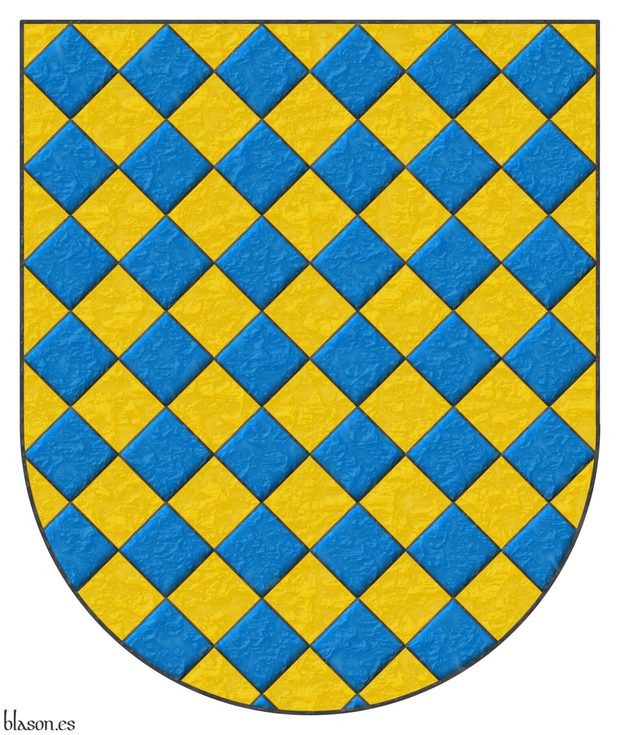
Thomas de Warbrentone ~ Thomas de Warbleton.
Lozengy Or and Azure.
Escudo losanjado oro y azur.
Coat of arms interpreted in the following manner: the shape of the base is a semicircular arch; the field has been enameled with plain metal tint Or; the lozenges with their 4 rectangular and equal angles, are outlined in Sable and illuminated in Azure; the lozengy is 6 lozenges wide by 7 lozenges high, which can also be indicated as 7 lozenges in length by 7 lozenges in latitude; and the whole has received a marble finish.
Lozengy is defined by [Avilés, J.; 1780a; page 101] as «it is said of the Shield and pieces covered with lozenges».
Blazon keywords: Lozengy, Or and Azure.
Style keywords: Semi-circular, Illuminated, Outlined in sable and Marmoreal.
Classification: Interpreted and Personal.
Bearer: Warbleton, Thomas de.


Thomas de Werblintone
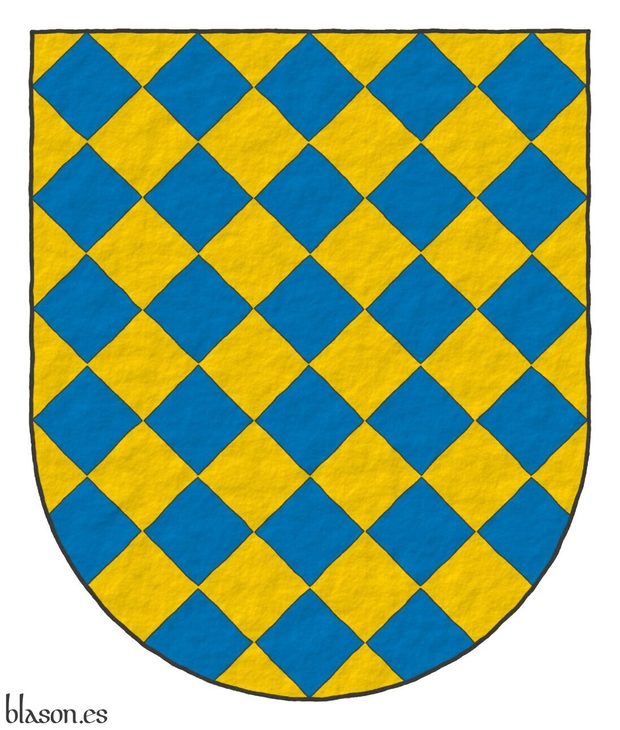
Thomas de Warbleton ~ Thomas de Werblintone.
Lozengy Or and Azure.
Escudo losanjado de oro y azur.
Included in [Vincent, MS; 1285; number 245] also known as [St. George's Roll; 1285; number 245].
Blazon keywords: Without divisions, Lozengy, Or and Azure.
Style keywords: Semi-circular, Plain tincture and Outlined in sable.
Classification: Interpreted and Personal.
Bearer: Tomás de Warbleton.


Thomas le FizThomas
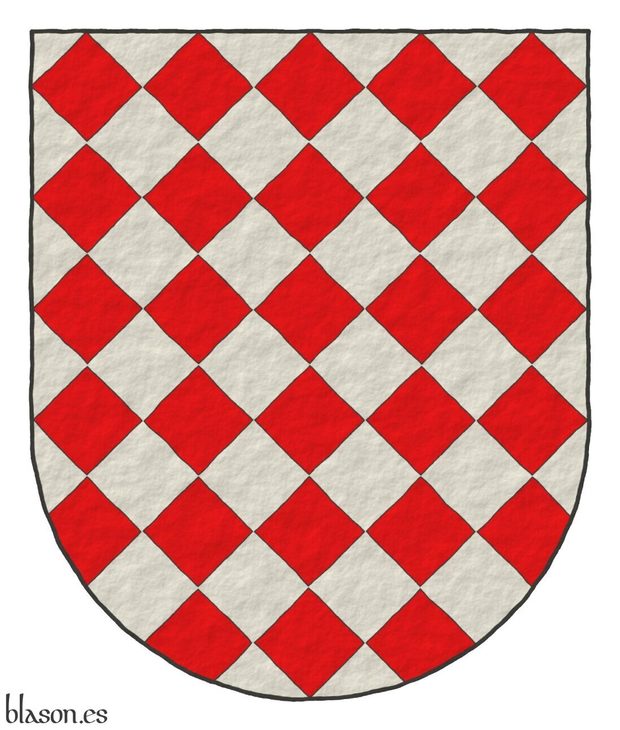
Thomas FitzThomas ~ Thomas le FizThomas.
Lozengy Argent and Gules.
Escudo losanjado de plata y gules.
Included in [Vincent, MS; 1285; number 245] also known as [St. George's Roll; 1285; number 245].
Blazon keywords: Without divisions, Lozengy, Argent and Gules.
Style keywords: Semi-circular, Plain tincture and Outlined in sable.
Classification: Interpreted and Personal.
Bearer: Tomás FitzThomas.


UBU
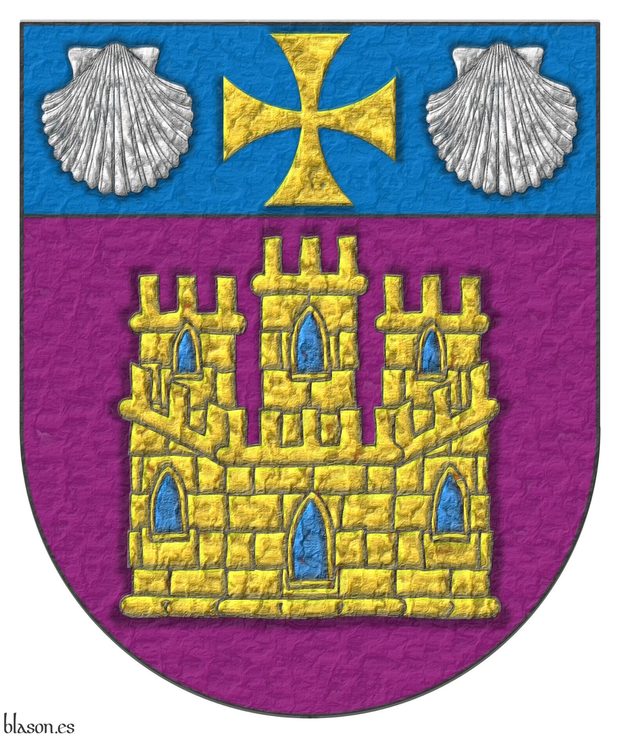
Purpure, a castle triple-towered Or, port and windows Azure, masoned Sable; on a chief Azure, a cross patty Or, between two escallops Argent.
Escudo de púrpura, un castillo de oro, aclarado de azur, mazonado de sable; un jefe de azur, cargado de una cruz patada de oro acompañada de dos veneras de plata.
Coat of arms interpreted as follows: with a semicircular (round) base; the field and the chief in the flat tinctures Purpure and Azure, with a lightly-hammered metal finish; and the four charges outlined in Sable, shaded, illuminated, and with a very hammered metal finish.
I hold the University Specialist degree in Real Estate Management and Administration, awarded by the Department of Private Law of the University of Burgos. These studies are structured over three academic years and are pursued online in combination with periods of traditional classes in the summers and on-site examinations during the winters. This was my first long-term online training experience.
Blazon keywords: Purpure, Or, Azure, Sable, Argent, Castle, Chief, Cross, Cross patty, Cross couped and Escallop.
Style keywords: Semi-circular, Illuminated, Shaded, Outlined in sable, Soft metal and Hard metal.
Classification: Interpreted, Socioeconomic and Education.
Bearer: Burgos, University of.


Urban V
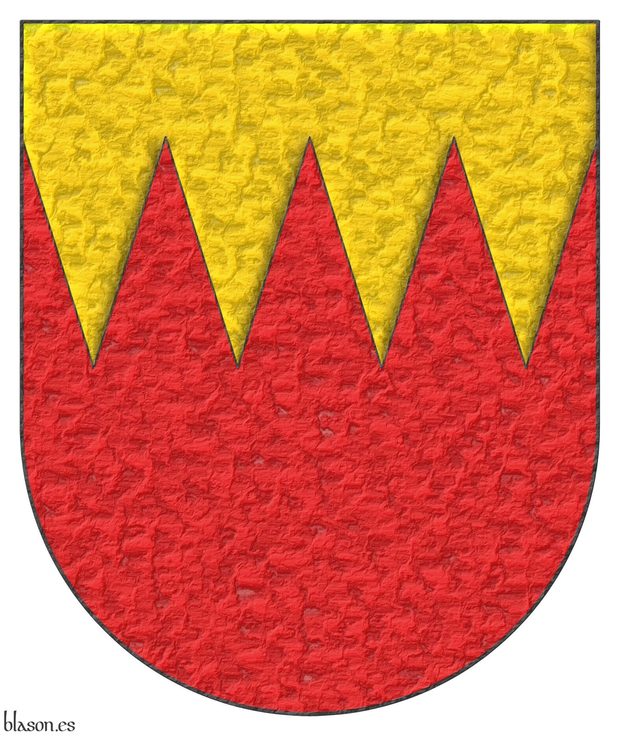
200th Pope of the Church, from 1362 to 1370. «Urbanus V», born Guillaume de Grimoard, was born in Le Pont-de-Montvert, in the Languedoc.
Gules, a chief dancetty of four full points Or.
Escudo de gules, un jefe encajado de cuatro piezas enteras de oro.
Papal coat of arms interpreted with: a round-topped shield; the field in plain Gules; the chief indented, illuminated in metal Or, and outlined in Sable; and the whole design in hammered metal.
[Rietstap, J. B.; 1861] blazons it as Grimoard «de gueules, au chef émanché de quatre pièces d'or».
Blazon keywords: Gules, Chief, Dancetty, Or, Three and Two.
Style keywords: Semi-circular, Illuminated, Outlined in sable and Metal beaten.
Classification: Interpreted, Religious and Papal States.
Bearer: Urban V.


Urgell, County of
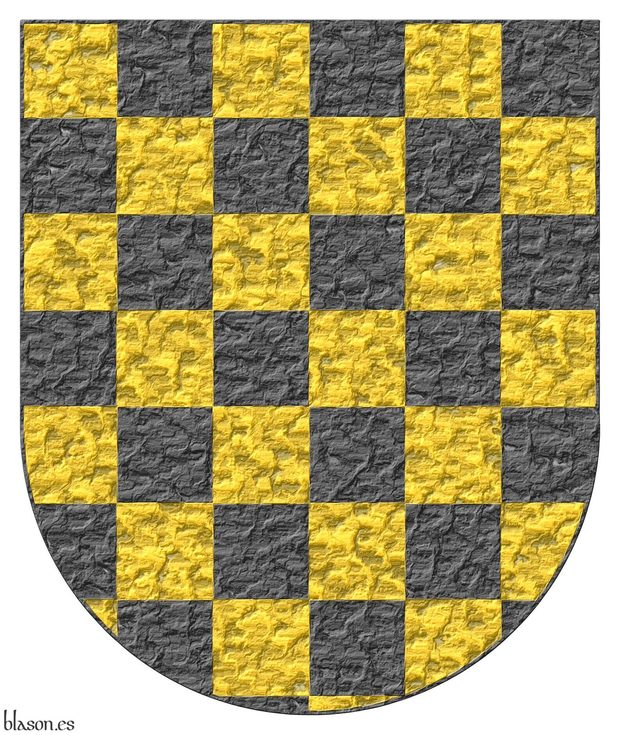
Chequey Or and Sable.
Escudo ajedrezado de oro y sable.
Arms interpreted with: a round-topped shield shape; the chequey pattern in flat metal Or and colour Sable; and a heavily beaten metal finish.
[Avilés, J.; 1780a; page 33] writes about the application of the chequey pattern to shields, ordinaries and charges: «chequey is said of the shield, the principal ordinaries, and even some animals, such as eagles, lions, and other charges, when they are composed of alternating square pieces in the fashion of a chessboard.» On the minimum number of panes he generally specifies that «for a shield to be called chequey, it must have at least twenty chessboard panes; because if it has only nine, it is called equipoll; and if it has fifteen, it is said to be of fifteen panes of chequey» and for its application to ordinaries that «other ordinaries, such as bends, fesses, etc., must have at least two rows of chequey to be considered chequey, otherwise they would be called compony.»
Blazon keywords: Chequey, Or and Sable.
Style keywords: Semi-circular, Plain tincture and Hard metal.
Classification: Interpreted, Civic, Coat of arms and Kingdom of Aragon.
Bearer: Urgell, County of.


Urroz of Navarre
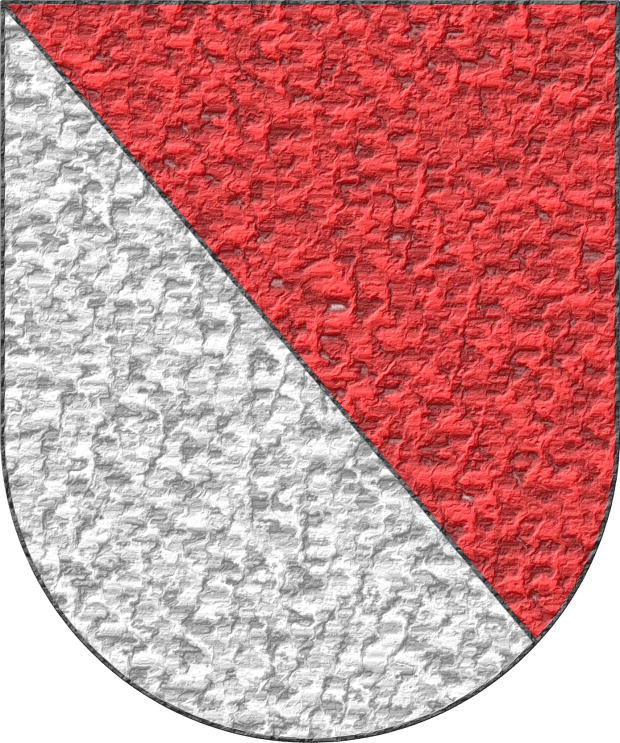
De los doce linajes de Ricos Hombres el quinto es la buena villa de Urroz, la torre blanca; y goza en armas un escudo partido por medio, de lo alto ata baxo, a manera de banda, desta forma e deuisas que en este escudo está de presente pintado.
Party per bend: 1 Gules; 2 Argent.
Escudo tronchado: 1o de gules; 2o de plata.
Coat of arms with poco margen for the interpretación con: la base of semicircular (round); el field of tintas planas of Gules and Argent; y con a finish of metal muy batido.
Coat of arms basado in the 5o of los «ricoshombres» of Navarra de [Bosque, J. del; 1540; folio 1o of the numeración of 1613]. El texto previo a su blasón está extraído of the transcripción realizada por [Martinena Ruiz, J. J.; 1982; páginas 122 and 123].
Bajo the título «Apellido of Vrroz» también puede consultarse en [Vega, P. J. de; 1702; folio 4B of the manuscrito], estando the 4 in the esquina superior izquierda and the B in the base of the coat of arms. Este folio tendría that estar numerado with a 5.
Blazon keywords: Party per bend, Gules and Sable.
Style keywords: Semi-circular, Plain tincture and Hard metal.
Classification: Interpreted, Personal and Kingdom of Navarre.
Bearer: Urroz of Navarre.


Vera, lineage of Aragon
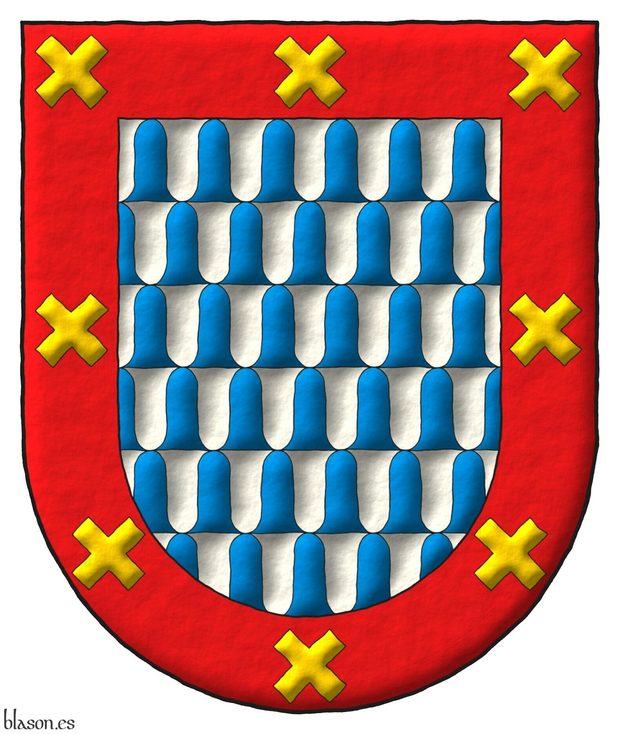
Blazon of the Vera lineage of Aragon.
Vair ancient, a bordure gules charged with eight saltires couped Or.
Escudo de veros antiguos, una bordura de Gules cargada de ocho sotueres cortados de oro.
Illuminated and with a glass finish.
It can be consulted in [Mogrovejo de la Cerda, J.; 1636; cover].
[Friar, S.; 1987; pages 156-157] says of the vair: «originates from the fur of a species of squirrel... which was popular in the Middle Ages as a lining for the garments of those not entitled to wear ermine. The animal was blue-grey on the back and white underneath. By sewing a number of these pelts together, with white and blue-grey alternating,... one which easily translated into the stylized armorial form of Vair and its variants».
Blazon keywords: Vair ancient, One, Bordure, Gules, Charged, Eight, Saltire, Party per fess and Or.
Style keywords: Freehand, Outlined in sable, Illuminated and Semi-circular.
Classification: Interpreted, Lineage and Coat of arms.


Vermandois, County of
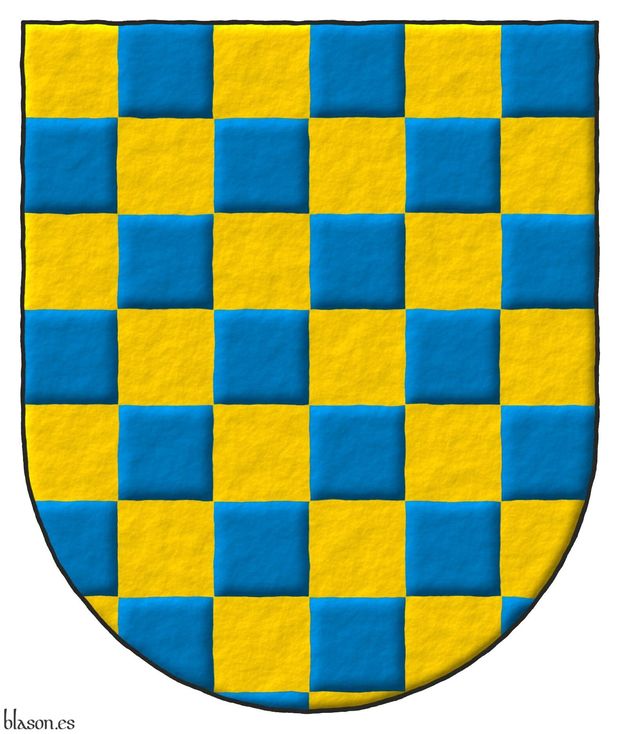
Chequey Or and Azure.
Escudo ajedrezado de oro y azur.
Arms interpreted by me, highlighted with lights and shadows, outlined in Sable, with a semi-circular outer contour and with a freehand finishing.
Coat of arms of the County of Vermandois, France, emblazoned by me.
Blazon keywords: Or, Azure and Chequey.
Style keywords: Outlined in sable, Illuminated, Semi-circular and Freehand.
Classification: Civic, Interpreted, Boa and Coat of arms.
Bearer: Vermandois, County of.


Vichiers, Renaud de
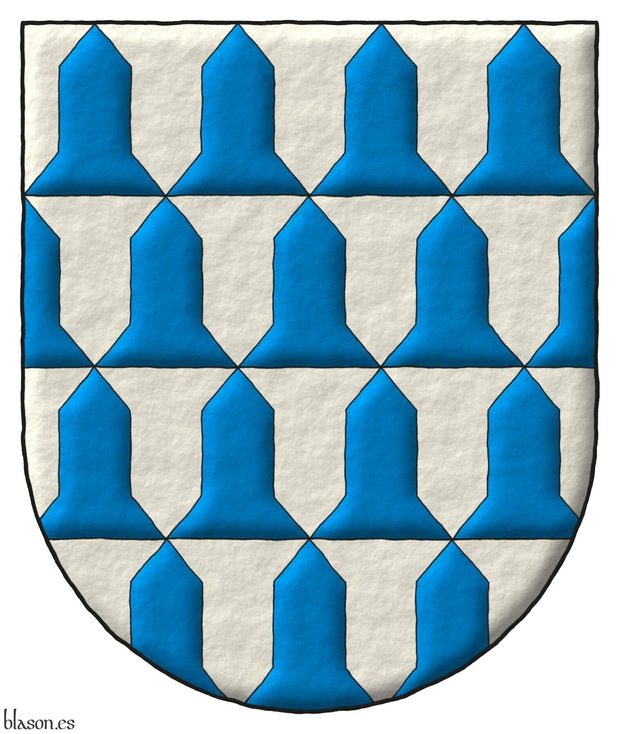
Vair.
Escudo de veros.
Coat of arms emblazoned by me with a semi-circular shape, illuminated, and with a freehand finishing.
You can consult how to paint a veros fur in [Costa y Turell, M.; 1858; page 37, plate 1, illustrations 17 and 18].
Blazon keywords: Vair.
Style keywords: Outlined in sable, Illuminated, Semi-circular and Freehand.
Classification: Religious, Military, Knights Templar, Interpreted and Coat of arms.
Bearer: Vichiers, Renaud de.


Vidaurre of Navarre
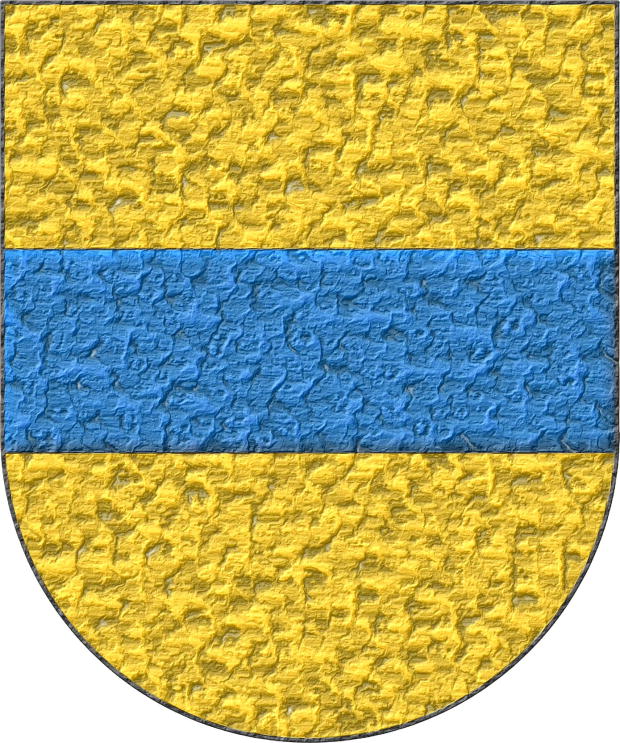
Of the twelve lineages of Noblemen, the ninth is Vidaurre, who bears as arms a shield Or and, in the middle, a fess Azure, in the same manner as this shield is now painted.
Or, a fess Azure.
Escudo de oro, una faja de azur.
Coat of arms interpreted with: a semicircular (round) base; the field in flat Or; the fess illuminated in Azure and outlined in Sable; and the whole finished in highly-hammered metal.
Interpreted from the ninth coat of arms of the Navarrese «ricoshombres» from [Bosque, J. del; 1540; folio 1 of the numbering of 1613] and with the preceding text taken from the transcription appearing in [Martinena Ruiz, J. J.; 1982; pages 122 and 123].
Under the title «Surname of Vidaurre» this coat of arms can be consulted in [Vega, P. J. de; 1702; folio 9 of the manuscript].
Blazon keywords: Without divisions, Or, Fess and Azure.
Style keywords: Semi-circular, Illuminated, Outlined in sable and Hard metal.
Classification: Interpreted, Personal and Kingdom of Navarre.
Bearer: Vidaurre of Navarre.
Blazon equivalent to: Vernon, barón de Shubbroc.


Vidriales, C. M.
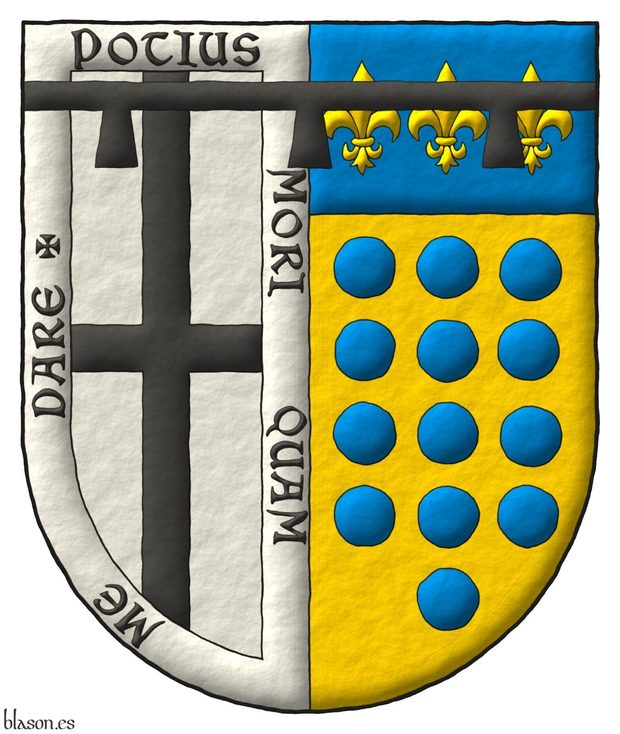
Interpreted coat of arms: with a semi-circular shape; illuminated with metals argent and or and colors sable and azure; outlined with sable; and a freehand finish.
Blazon keywords: Party per pale, Argent, Cross, Sable, Bordure, Motto, Or, Thirteen, Hurt, Hurt, torteau, pellet, pomme and golpe, Azure, Three, In pale, Four, Five, Chief, Fleur de lis, Label and Suspended.
Style keywords: Freehand, Semi-circular, Illuminated and Outlined in sable.
Classification: Coat of arms, Interpreted and Personal.
Bearer: Vidriales, C. M..


Vidriales, M. P.
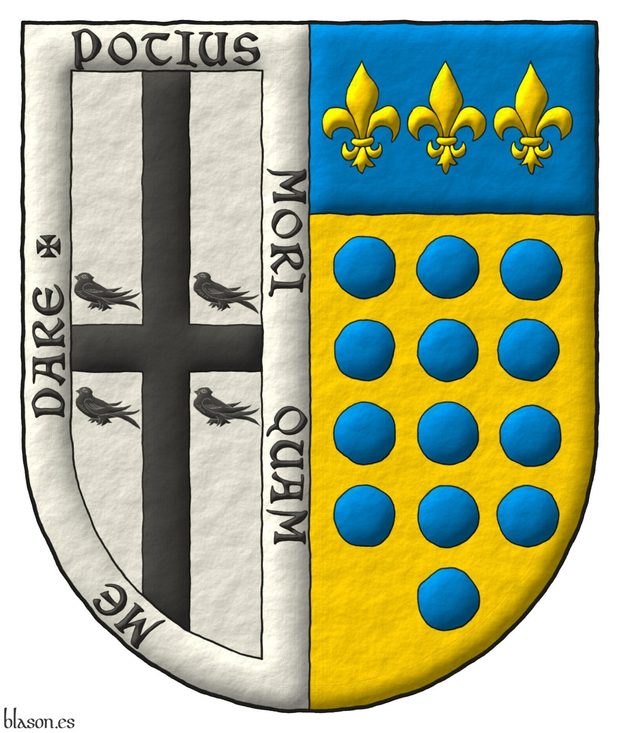
Interpreted coat of arms: with a semi-circular shape; illuminated with metals argent and or and colors sable and azure; outlined with sable; and a freehand finish.
Blazon keywords: Party per pale, Argent, Cross, Sable, Bordure, Motto, Or, Thirteen, Hurt, Hurt, torteau, pellet, pomme and golpe, Azure, Three, In pale, Four, Five, Chief, Fleur de lis, Cantoned and Martlet.
Style keywords: Freehand, Semi-circular, Illuminated and Outlined in sable.
Classification: Coat of arms, Interpreted and Personal.
Bearer: Vidriales, M. P..


Vilardi, lineage of Italy
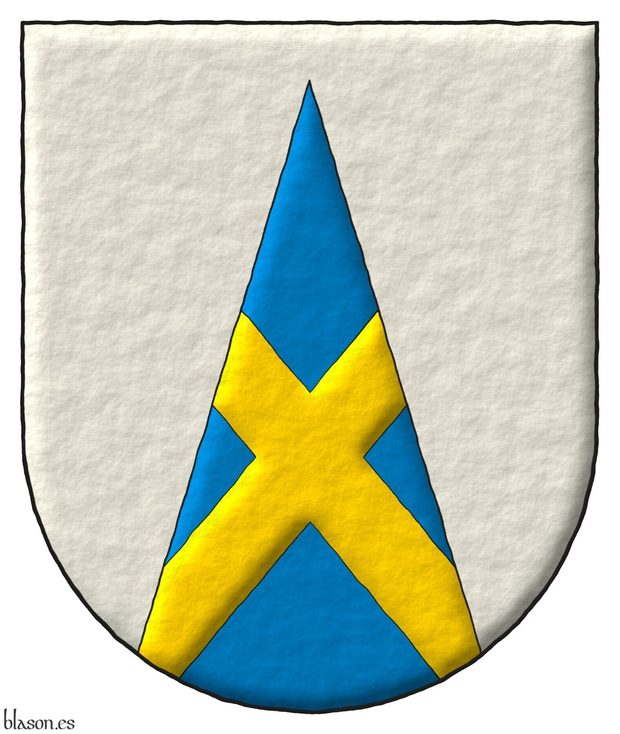
Blazon of the Vilardi lineage of Italy.
Argent, on a pile issuant from the base Azure a saltire Or.
Escudo de plata, una pira de azur cargada de un sotuer de oro.
Illuminated and a free hand finishing.
[Cadenas y Vicent, V. de; 2002; page 138] says that the a pile issuant from the base is «a triangle whose base issues from the base of the shield, being a third of its width», but when it is painted in [Cadenas y Vicent, V. de; 2002; page 268, figure 279] along with the pile the width of the base of both isosceles triangles is 2/3 of the width of the shield. I think the width of 2/3 is, in these 2 cases, better than 1/3 width, because with 1/3 there is not enough room for charges, as shown in the figure below.
There are scholars who say that the pile issuant from the base must not touch the upper edge of the shield and others that its tip should be in the center of the chief. In the previous image, the pile issuant from the base of the 1st shield fulfills the first affirmation, and in the 2nd shield, its tip is in the center of the chief.
I have the doubt if it should not be a saltire raguly.
Blazon keywords: Without divisions, Argent, One, Pile issuant from base, Azure, Charged, Saltire and Or.
Style keywords: Freehand, Outlined in sable, Illuminated and Semi-circular.
Classification: Interpreted, Lineage and Italian Republic.


von Haimb, Isadora
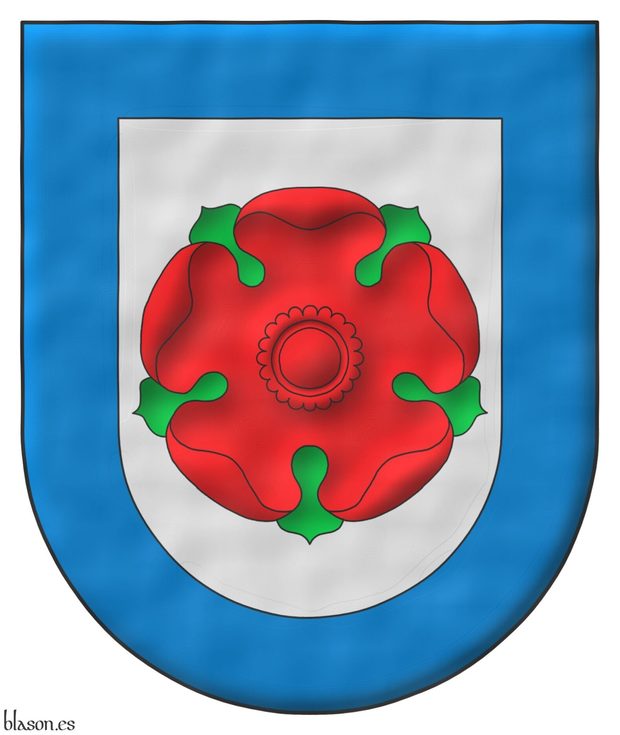
Argent, a rose Gules, barbed Vert; a bordure Azure.
Escudo de plata, una rosa de gules, hojada de sinople; una bordura de azur.
Coat of arms painted by me, illuminated with lights and shadows, contoured in Sable, with a semi-circular outer contour and with a watercolor finish.
These are the arms of Isadora von Haimb emblazoned by me.
Blazon keywords: Argent, Gules, Vert, Azure, One, Rose, Barbed and Bordure.
Style keywords: Outlined in sable, Illuminated, Semi-circular and Watercolor.
Classification: Personal, Interpreted, Boa and Coat of arms.
Bearer: von Haimb, Isadora.


Warbrentone, Thomas de
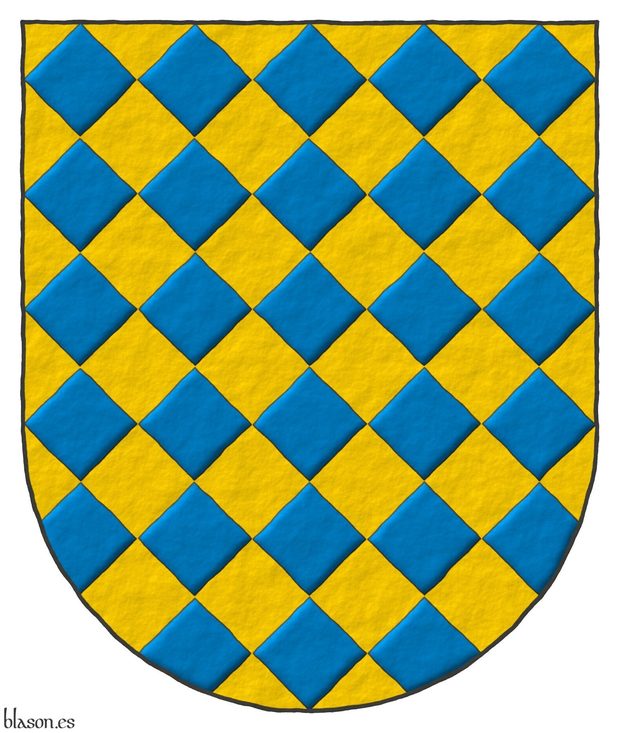
Thomas de Warbleton ~ Thomas de Warbrentone.
Lozengy Or and Azure.
Escudo losanjado oro y azur.
Coat of arms interpreted with: the semicircular base shape; the field of plain metal Or; the lozenges illuminated in Azure, outlined in Sable and with their 4 angles at 90o; the lozengy of proportion 5 x 6; and the whole with a raised-stroke effect.
Can be found in [Heralds' Roll, T.; 1280; shield number 647], in [St. George's Roll; 1285; shield number 245] and in [Charles' Roll; 1285; shield number 360].
Blazon keywords: Lozengy, Or and Azure.
Style keywords: Semi-circular, Illuminated, Outlined in sable and Freehand.
Classification: Interpreted and Personal.
Bearer: Warbrentone, Thomas de.


Which one is the single blazon? Solution
The blazon without a partner is the number zero Gules, row 2 and column 4. Its blazon is the following:
0) «Palado de seis piezas de sinople y oro; brochante sobre el todo una banda de azur».
There are 14 coat of arms equal two by two, thus there are 7 couples with the following blazons, they are numered in color Sable in the previous image:
1) «Paly of six Azure and Or; over all a bend Azure».
2) «Paly of six Azure and Or; over all a bend Vert».
3) «Paly of six Vert and Or».
4) «Paly of six Vert and Or; over all a bend Vert».
5) «Paly of six Azure and Or».
6) «Paly of six Or and Azure; over all a bend Azure».
7) «Paly of six Vert and Or; over all a bend Azure».
Categories: Riddle solution, Semi-circular, Pointed, Triangular curved, Ogee, Rounded, Outlined in sable, Freehand, Paly, Six, Surmounted, Overall (deprecated), Bend, Azure, Vert and Or.
Root: Gifra, Vittorio.

William Bardolf
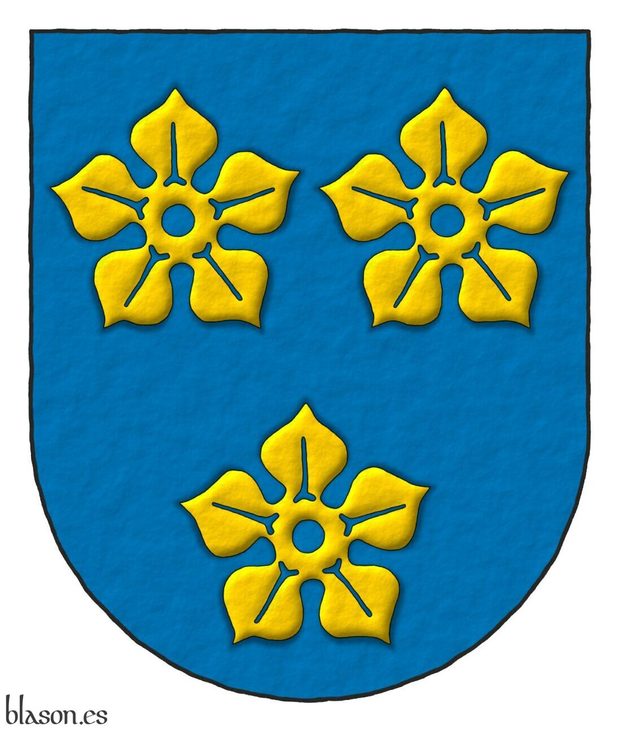
Guillermo Bardolf ~ William Bardolf ~ Willem Bardulf.
Azure, three cinquefoils Or.
Escudo de azur, tres quinquefolios de or.
Included in [Vincent, MS; 1285; number 223] also known as [St. George's Roll; 1285; number 223].
Blazon keywords: Without divisions, Azure, Three, Cinquefoil, Or and Ordered.
Style keywords: Semi-circular, Illuminated, Shaded, Outlined in sable and Freehand.
Classification: Interpreted and Personal.
Bearer: Guillermo Bardolf.


William de Hondeshacre
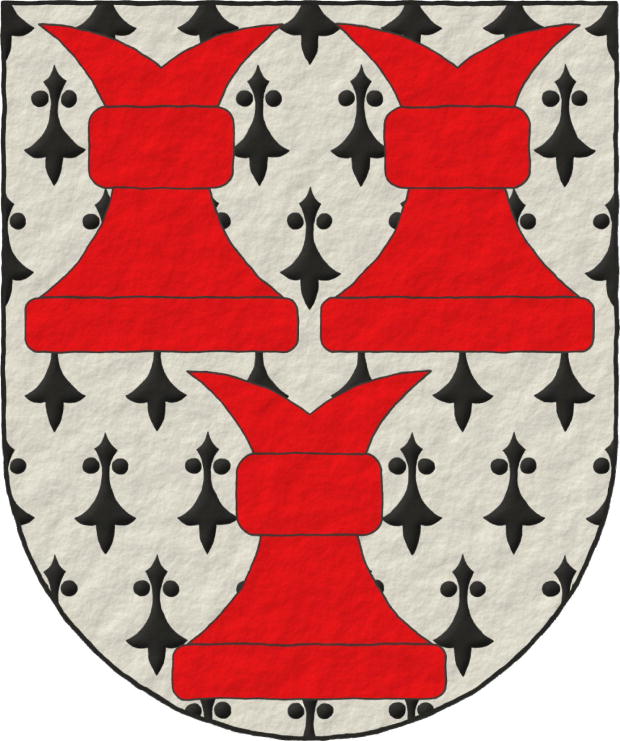
William de Handsacre ~ William de Hondeshacre.
Ermine, three chess rooks Gules.
Escudo de armiños, tres roques de gules.
Included in [Vincent, MS; 1285; number 469] also known as [St. George's Roll; 1285; number 469].
Blazon keywords: Without divisions, Ermine, Three, Chess rooks, Gules and Ordered.
Style keywords: Semi-circular, Illuminated, Outlined in sable and Freehand.
Classification: Interpreted and Personal.
Bearer: Guillermo de Handsacre.


Yñigo-Genio, Elias
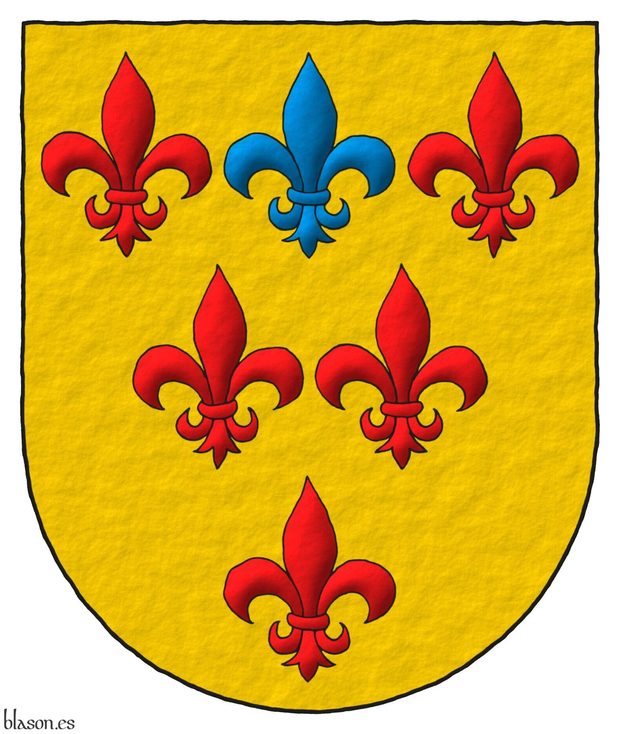
Or, six fleurs de lis, three, two, one, five Gules and one in the middle of the chief Azure.
Arms interpreted using a semi-circular shape; tinctures metal or and colors gules and azur; the color sable for delineation; and a freehand finish.
Credits:
- Rolando Yñigo-Genio is the designer of the coat of arms.
- Antonio Salmerón y Cabañas is the author of the heraldic art.
Blazon keywords: Or, Six, Fleur de lis, Ordered, Three, two and one, Five, Gules, One, Azure and In the middle of the chief.
Style keywords: Semi-circular, Freehand and Outlined in sable.
Classification: Interpreted, Personal and Coat of arms.
Bearer: Yñigo-Genio, Elias.


Yñigo-Genio, Rolando
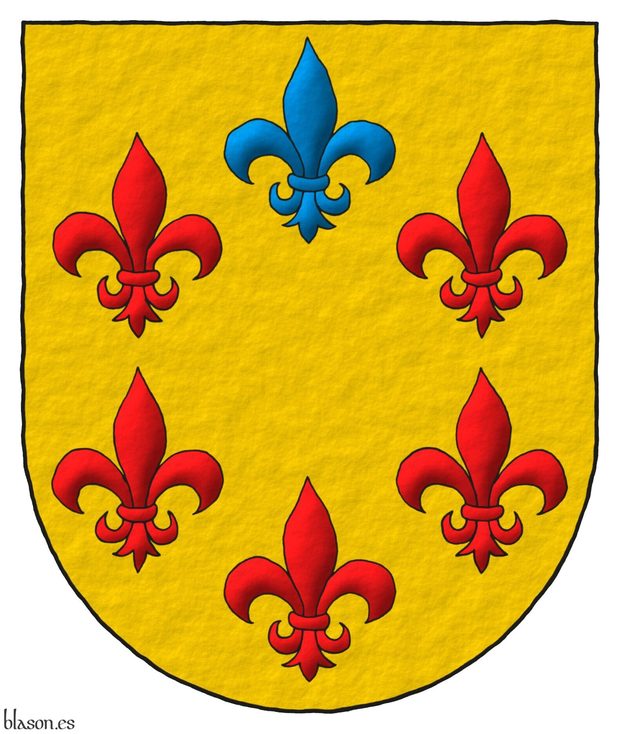
Or, six fleurs de lis in orle, five Gules and one in chief Azure.
I have interpreted this coat of arms with a semi-circular shape; tintures or, azure and gules; outlined with sable; and a freehand finish.
Rolando Yñigo-Genio publish on his website DeviantArt his interpretation of my coat of arms as I publish here in Blason.es I my interpretation of his arms and those of his brothers Noelia Yñigo-Genio and Elias Yñigo-Genio.
Credits: Rolando Yñigo-Genio is the designer of the coat of arms and Antonio Salmerón y Cabañas is the author of the heraldic art.
Blazon keywords: Or, Six, Fleur de lis, Orle, Five, Gules, One, Azure and In chief.
Style keywords: Semi-circular, Freehand and Outlined in sable.
Classification: Interpreted, Personal and Coat of arms.
Bearer: Yñigo-Genio, Rolando.
-
Language
-
Categories of heraldry
-
Divisions of the field
- Without divisions
- Party per pale
- Party per fess
- Party per bend
- Party per bend sinister
- Tierce
- Tierce sinister
- Tierced per pale
- Tierced per fess
- Tierced per bend
- Tierced pallwise inverted
- Quarterly
- Quarterly per saltire
- Gyronny
- Party per fess, the chief per pale
- Party per pale, the sinister per fess
- Party per fess, the base per pale
- Party per pale, the dexter per fess
- Chapé
- Chaussé
- Embrassé
- Contre-embrassé
- Party per chevron
- Enté
- Enté en point
- Flanched
-
Metals
-
Colours
-
Furs
-
Other tinctures
-
Ordinaries and sub-ordinaries
-
Diminutives of the ordinaries
-
Geometric charges
-
Composite ordinaries
-
Inanimate charges from Nature
Atom, Crescent, Diamond, Emerald, Estoile, Increscent, Lightning flash, Moon, Mount, Mullet, Mullet of four points, Orbital, Plough of Ursa Major, Rainbow, Ray of the sun, River, Sea, Snowflake, Sun, Sun in splendour, Sun of May, Trimount, Water and Wave.
-
Vegetal charges from Nature
Acorn, Apple, Apple tree, Ash, Bluebonnet, Camellia, Chrysanthemum, Cinquefoil, Cornflower, Dogwood flower, Double rose, Elm, Fleur de lis, Flower, Gourd, Holm oak, Hop cone, Kapok tree, Laurel, Lily, Linden, Lotus flower, Madonna lily, Oak, Olive tree, Palm tree, Pomegranate, Poplar leaf, Rose, Shamrock, Sunflower, Thistle, Tree, Tulip, Vine and Wheat.
-
Animal charges from Nature
Badger, Bald eagle, Barbel, Barn owl, Bear, Beaver, Beetle, Bighorn sheep, Blackbird, Boar, Brach hound, Bull, Doe, Dog, Dolphin, Dove, Eagle, Elephant, Falcon, Fish, Flame, Fly, Fox, Frog, Goat, Goldfinch, Goose, Heron, Horse, Hummingbird, Jaguar, Lark, Leopard, Lion, Lion passant, Lion rampant guardant, Lioness, Lynx, Male figure, Martlet, Merino ram, Owl, Panther, Parrot, Peacock, Pelican, Pelican in her piety, Puffin, Quetzal, Raven, Roe deer, Rooster, Savage, Seagull, Serpent, She-wolf, Stag, Starling, Talbot, Tyger, Vulture, Warren hound and Wolf.
-
Parts of natural charges
Arm, Beak, Branch, Caboshed, Chest, Claw, Covert, Dorsal fin, Eagle claw, Ermine spot, Escallop, Feather, Foot (palmiped), Foreleg, Forepaw, Hand, Head, Heart, Hoof, Leaf, Neck, Ostrich feather, Palm frond, Paw, Roe deers' attires, Shoulder, Sprig, Stags' attires, Stem, Swallow-tail, Tail, Tail addorsed, Tail fin, Talon, Tooth, Trunk, Trunk (elephant), Two hands clasped, Two wings in vol, Udder, Wheat spike, Wing and Wrist.
-
Artificial charges
Ace of spades, Anchor, Anvil, Arch, Arm vambraced, Armillary sphere, Arrow, Axe, Bell, Bell tower, Beret, Bonfire, Book, Bookmark, Bow, Bridge, Broken, Buckle, Cannon, Cannon dismounted, Cannon port, Canopy roof, Carbuncle, Castle, Celtic Trinity knot, Chain, Chess rooks, Church, Clarion, Clay pot, Closed book, Club, Column, Comb, Compass rose, Conductor's baton, Cord, Covered cup, Crozier, Crucible, Cuffed, Cup, Cyclamor, Dagger, Double vajra, Drum, Ecclesiastical cap, Fanon, Federschwert, Fleam, Four crescents joined millsailwise, Galician granary, Garb, Gauntlet, Geometric solid, Grenade, Halberd, Hammer, Harp, Host, Hourglass, Key, Key ward, Knight, Knot, Lantern, Letter, Line, Loincloth, Menorah, Millrind, Millstone, Millwheel, Monstrance, Mortar, Mullet of six points pierced, Nail, Non-classic artifact, Norman ship, Number, Oar, Oil lamp, Open book, Page, Pair of scales, Parchment, Pestle, Piano, Pilgrim's staff, Plough share, Polish winged hussar, Port, Portcullis, Potent, Quill, Ribbon, Rosette of acanthus leaves, Sabre, Sackbut, Sail, Scroll, Scythe, Sheaf of tobacco, Ship, Skirt, Spear, Spear's head, Stairway, Star of David, Step, Sword, Symbol, Tetrahedron, Torch, Tower, Trident, Trumpet, Turret, Two-handed sword, Wagon-wheel, Water-bouget, Wheel, Winnowing fan and With a turret.
-
Immaterial charges
Angel, Archangel, Basilisk, Dragon, Dragon's head, Garuda, Golden fleece, Griffin, Heart enflamed, Mermaid, Our Lady of Mercy, Ouroboros, Paschal lamb, Pegasus, Phoenix, Sacred Heart of Jesus, Saint George, Sea-griffin, Trinity, Triton, Unicorn, Winged hand and Wyvern.
-
External elements
-
Heraldic creations
-
References
-
Formats
-
Keywords on this page
Port and windows, Between, Watercolor, Armed, Azure, Boa, Bordure, Charged, Castle, Created, Cross, Cross couped, Quarterly, Four, Outlined in sable, Two, In chief, In base, Coat of arms, Schema, Mullet, Fess, Fleur de lis, Personal, Gules, Illuminated, Interpreted, Chief, Langued, Lion, Lineage, Masoned, Semi-circular, Hard metal, Ordered, Or, Party per pale, Leather, Argent, Without divisions, Civic, Rampant, Religious, Sable, Vert, Plain tincture, Freehand, Three and One.

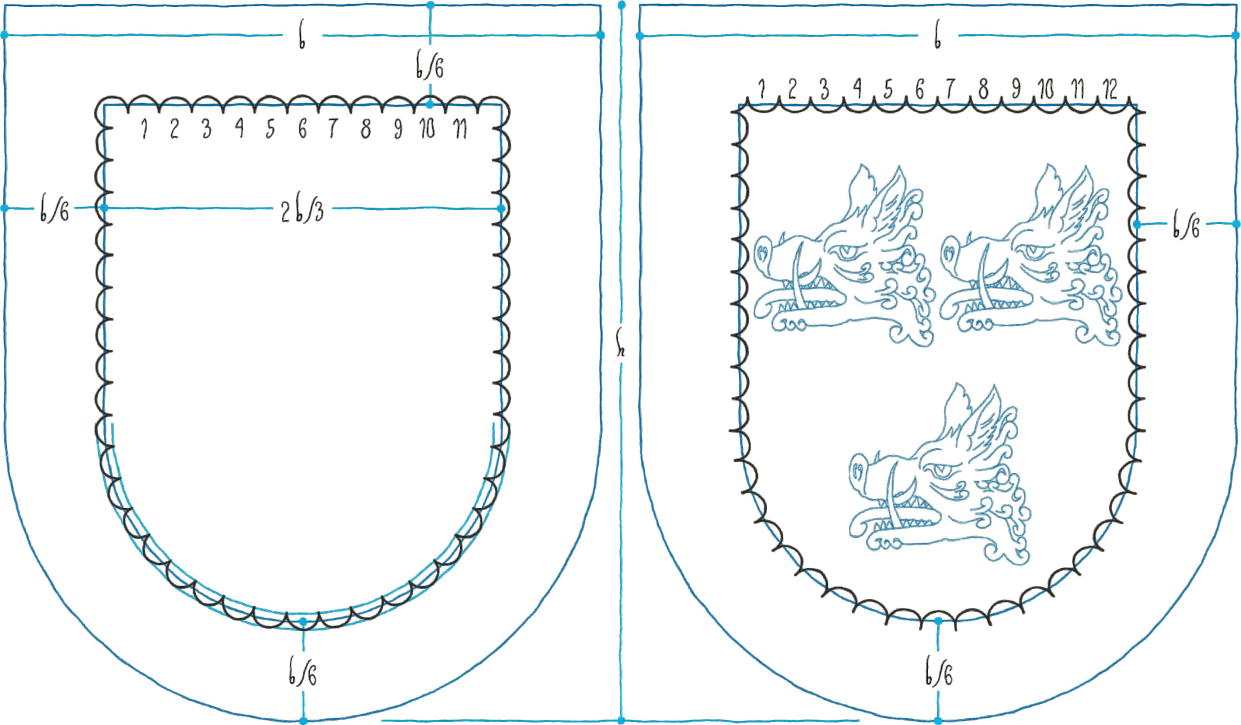
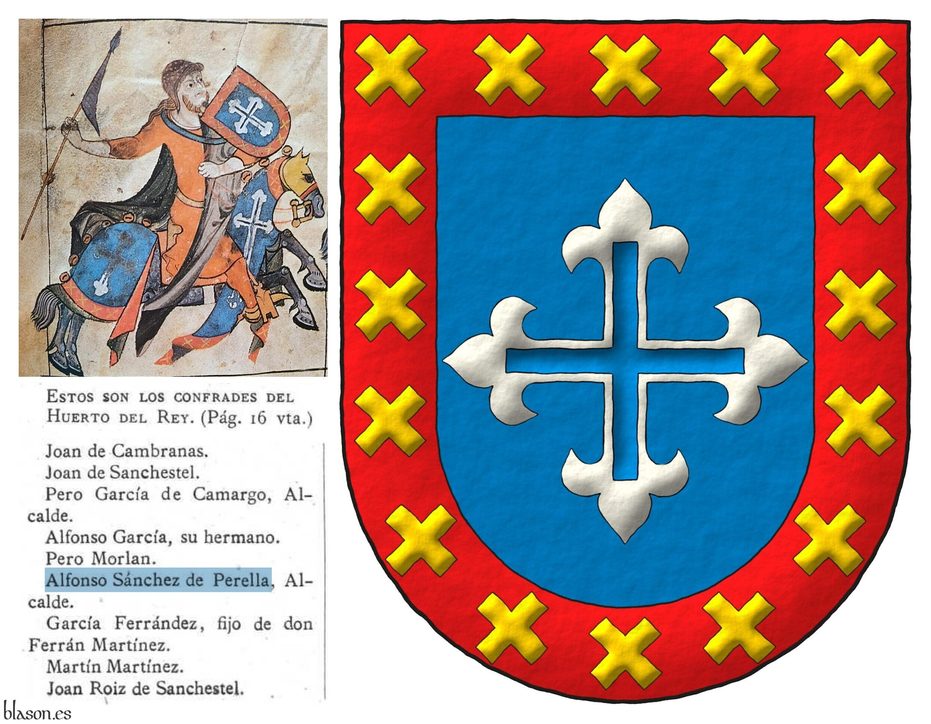
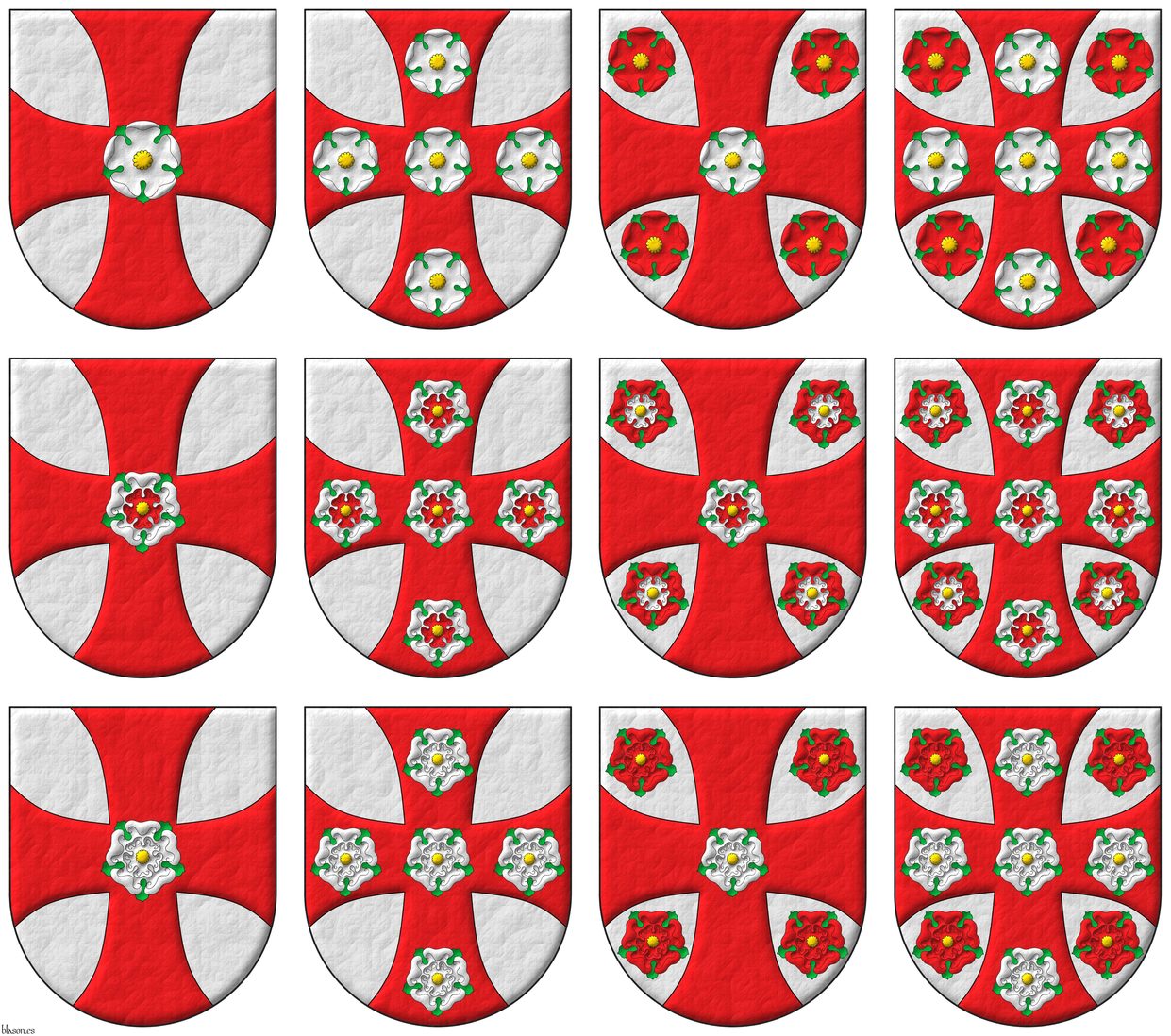
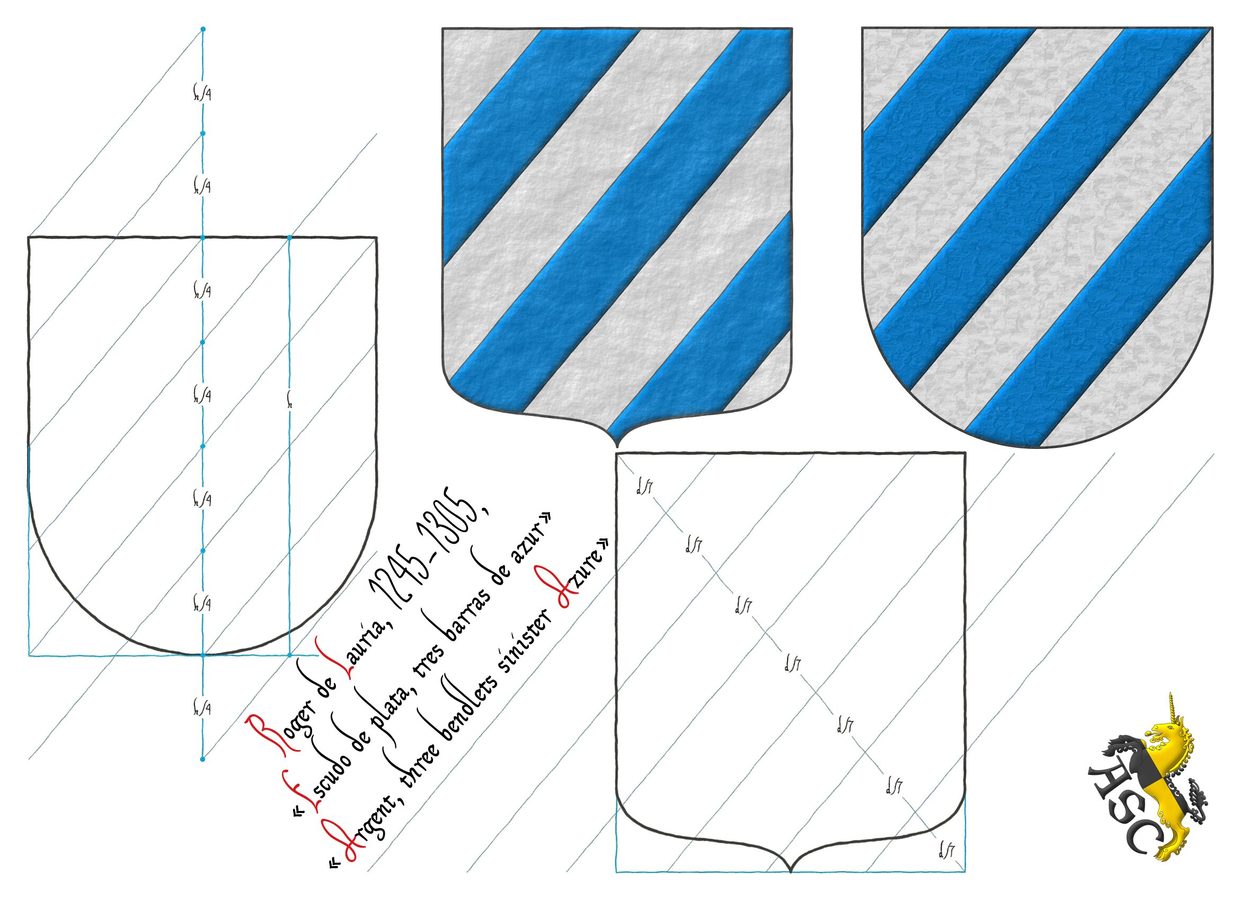
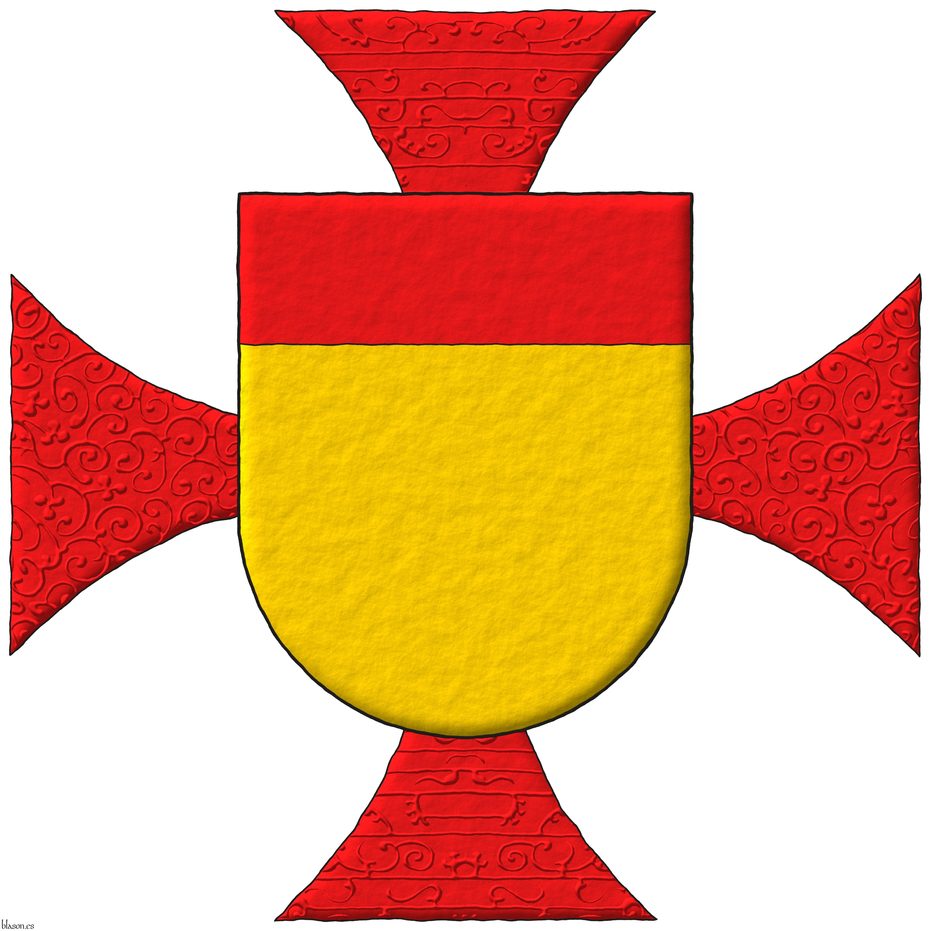
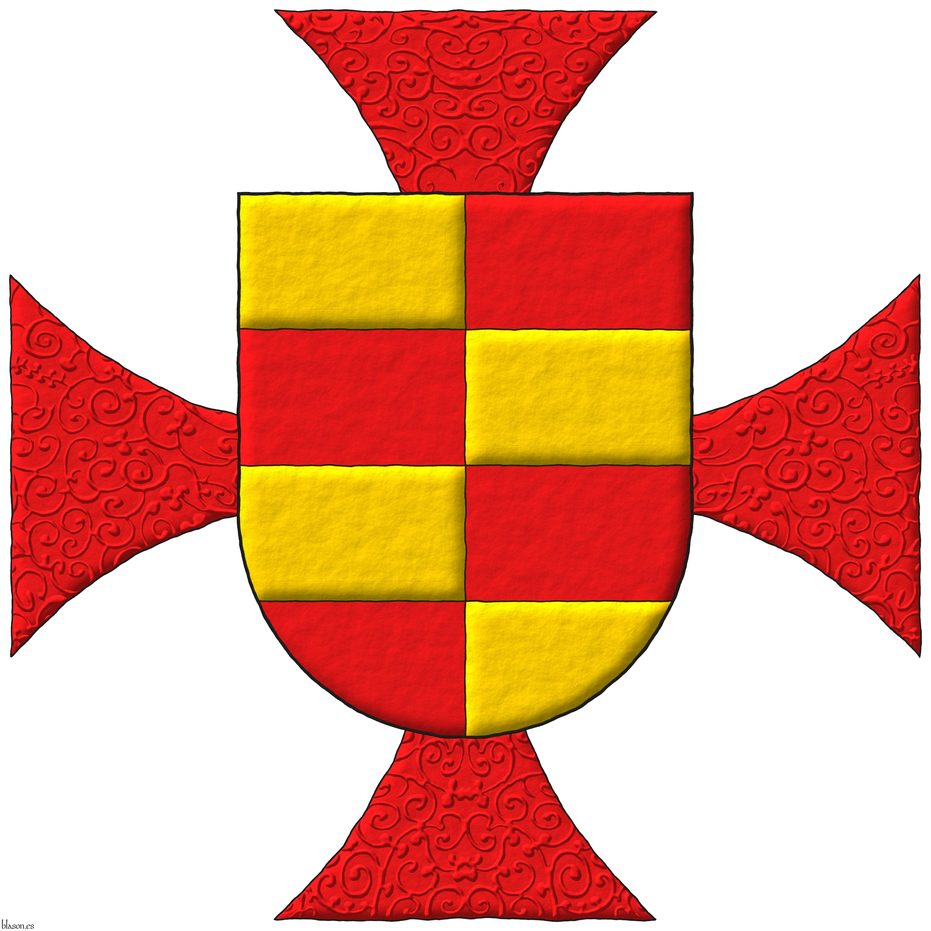
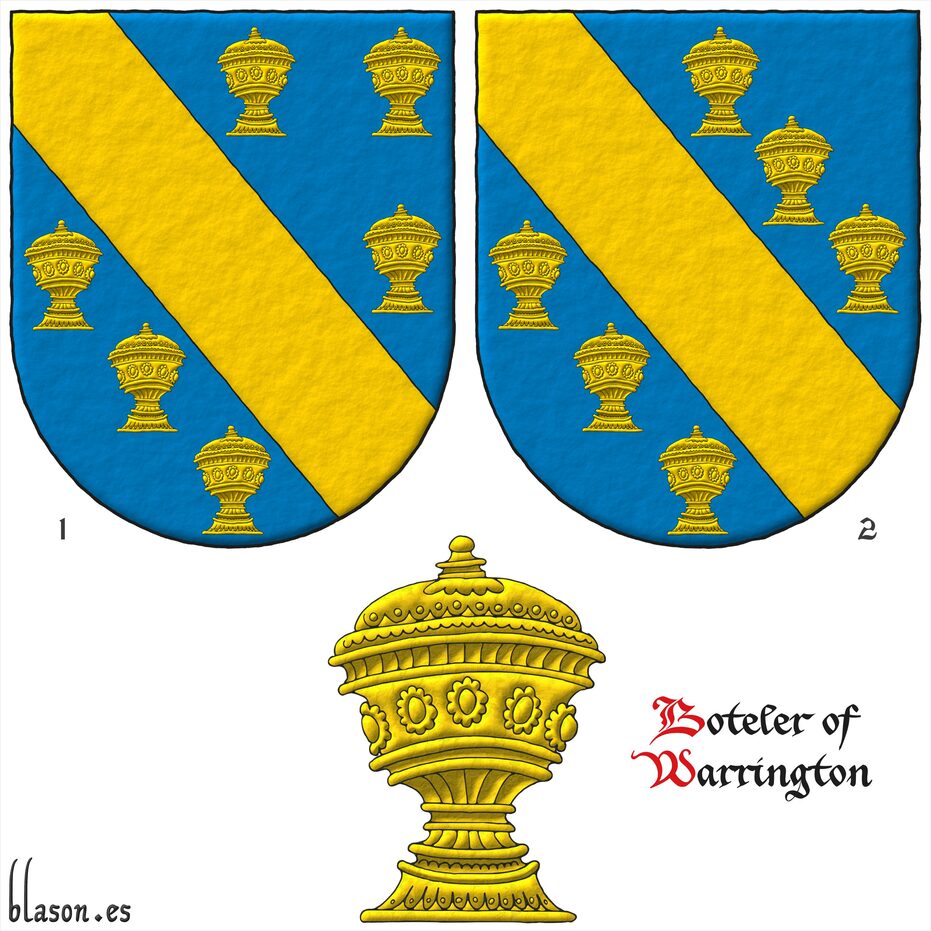
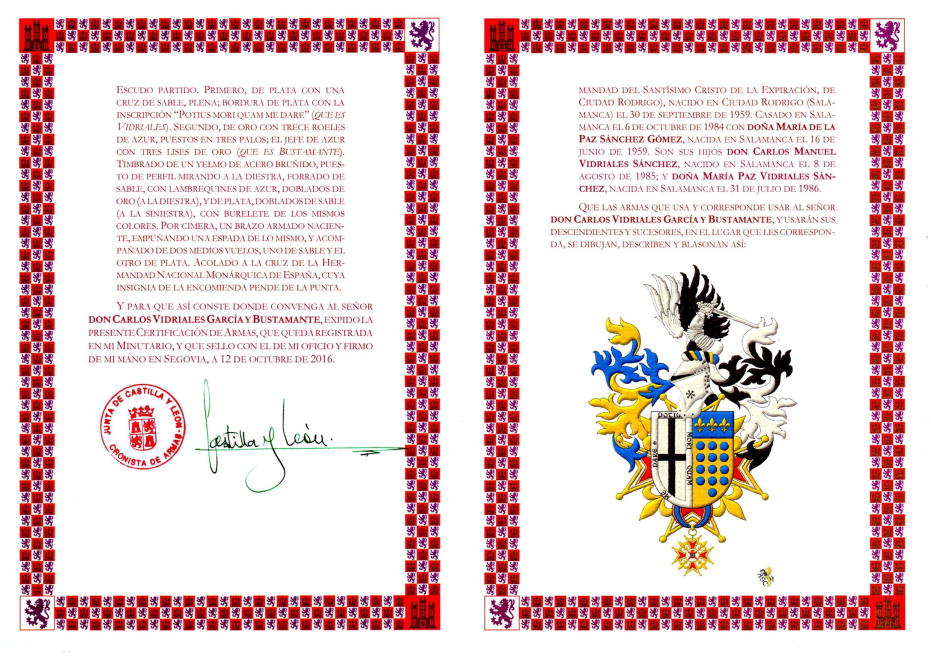
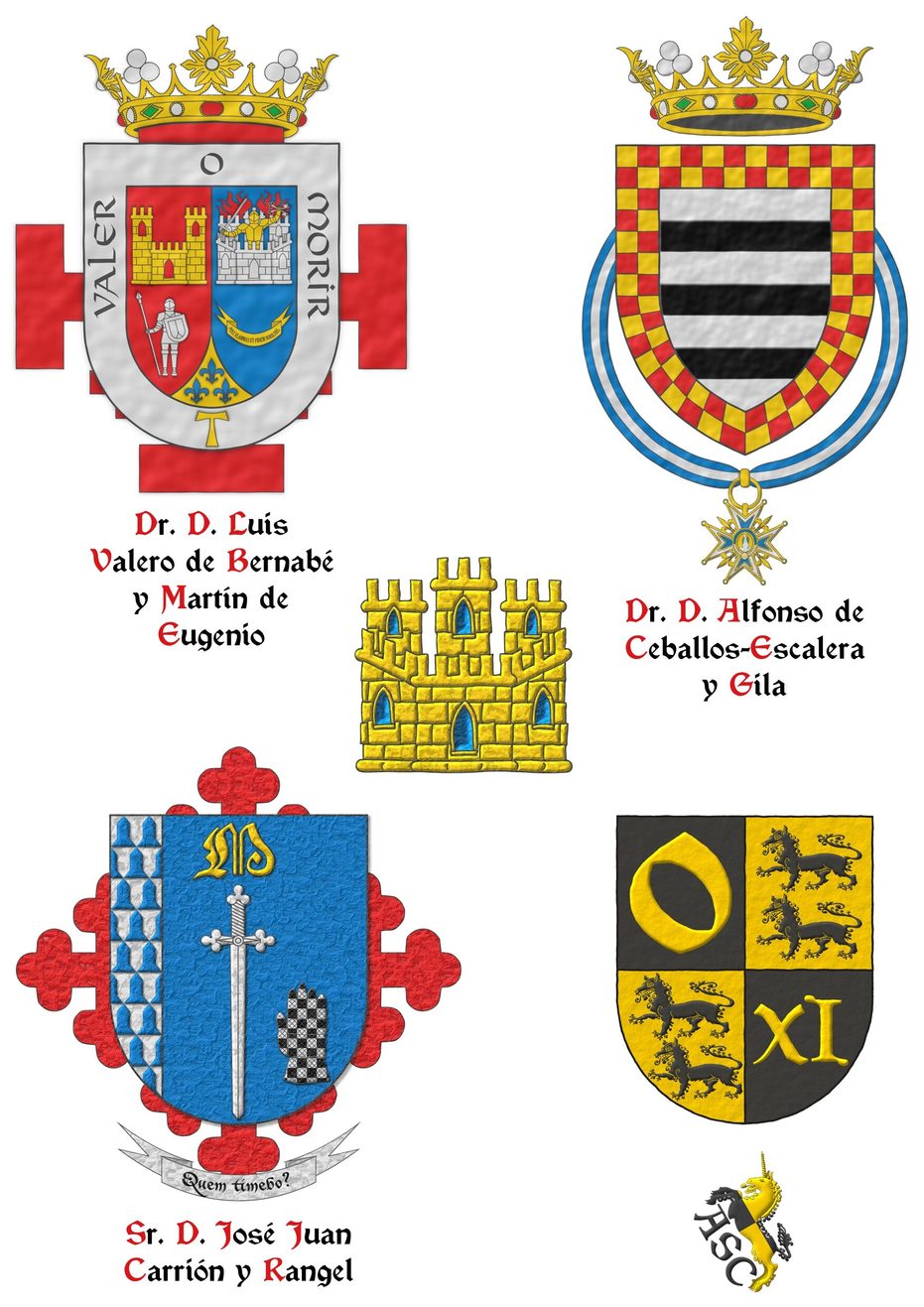
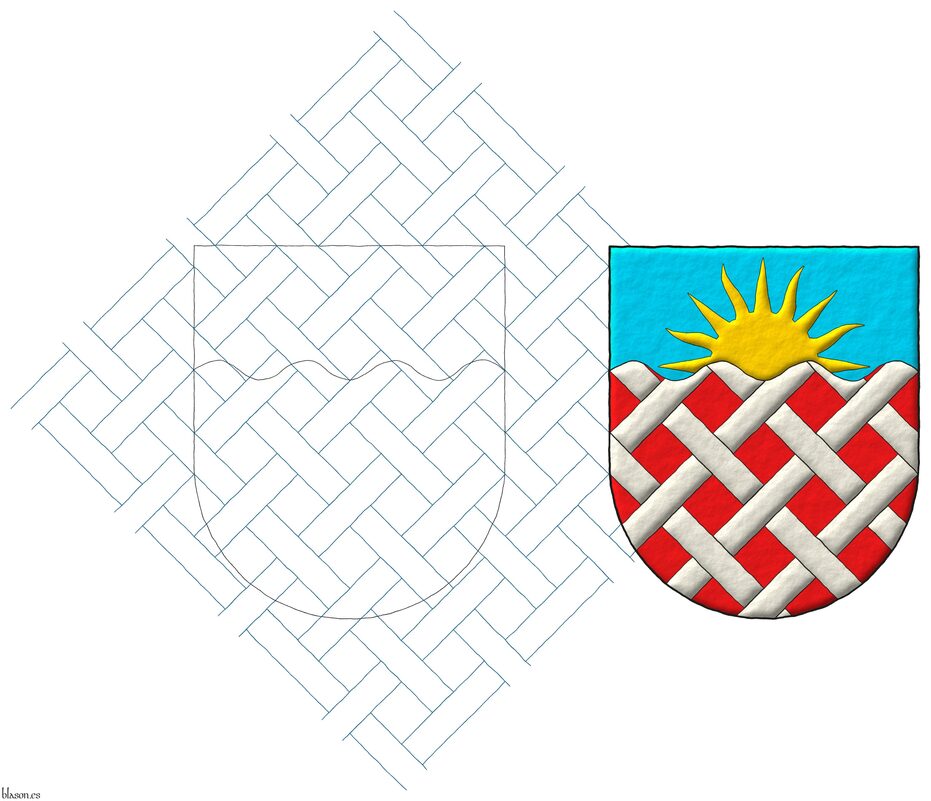
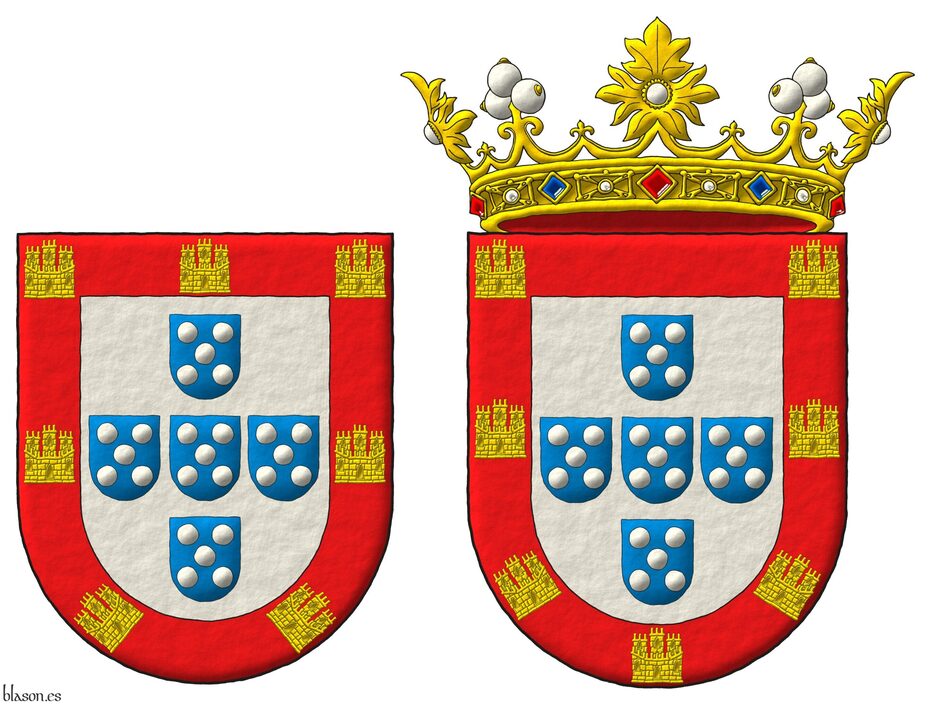
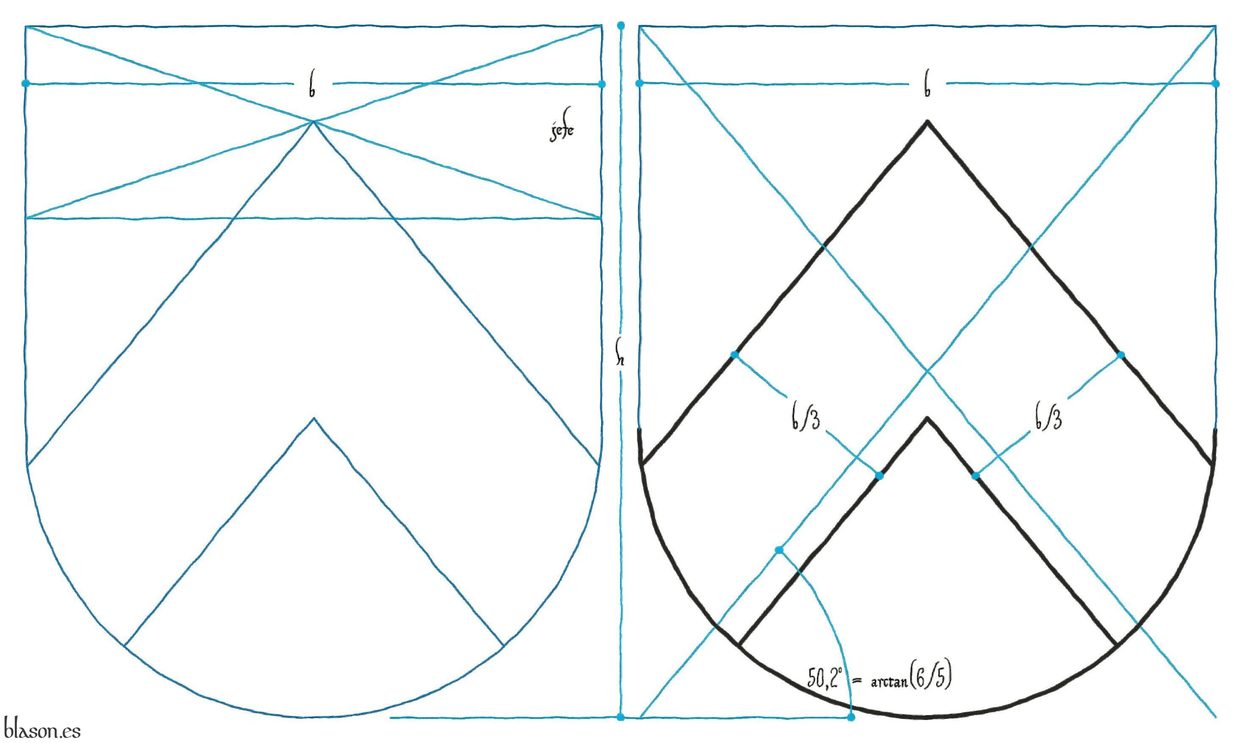
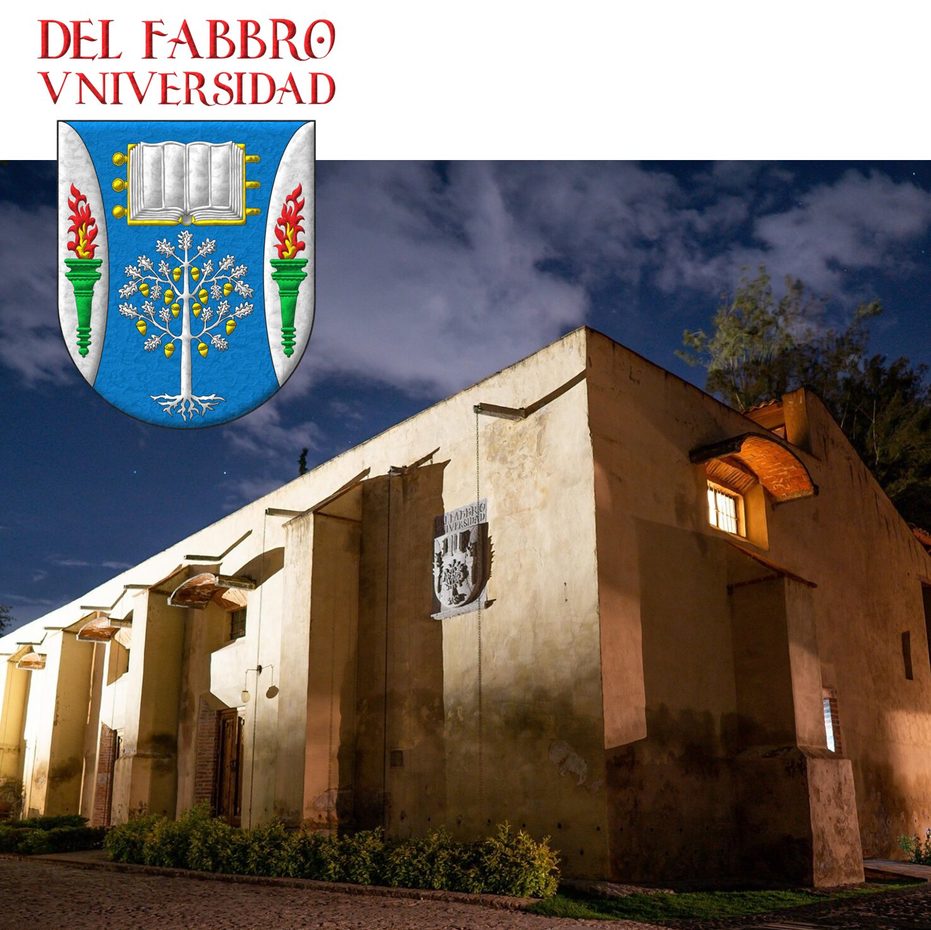
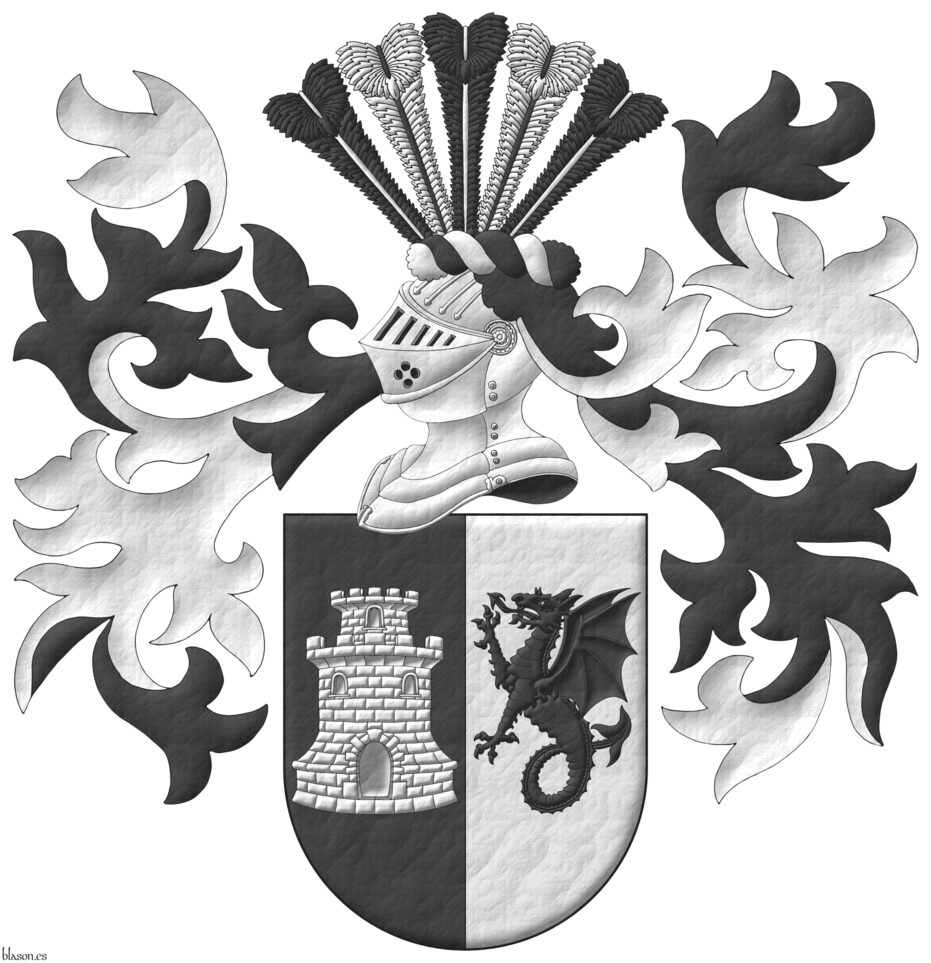
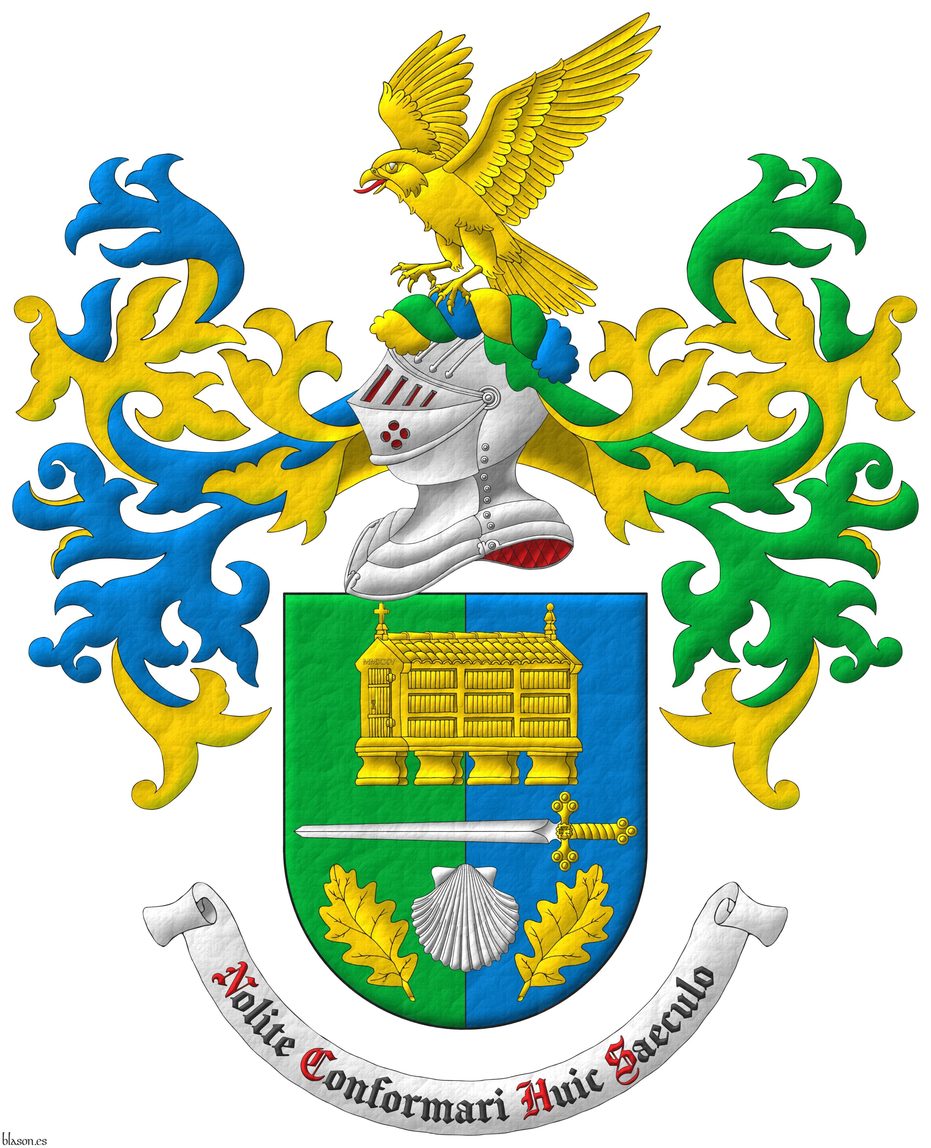
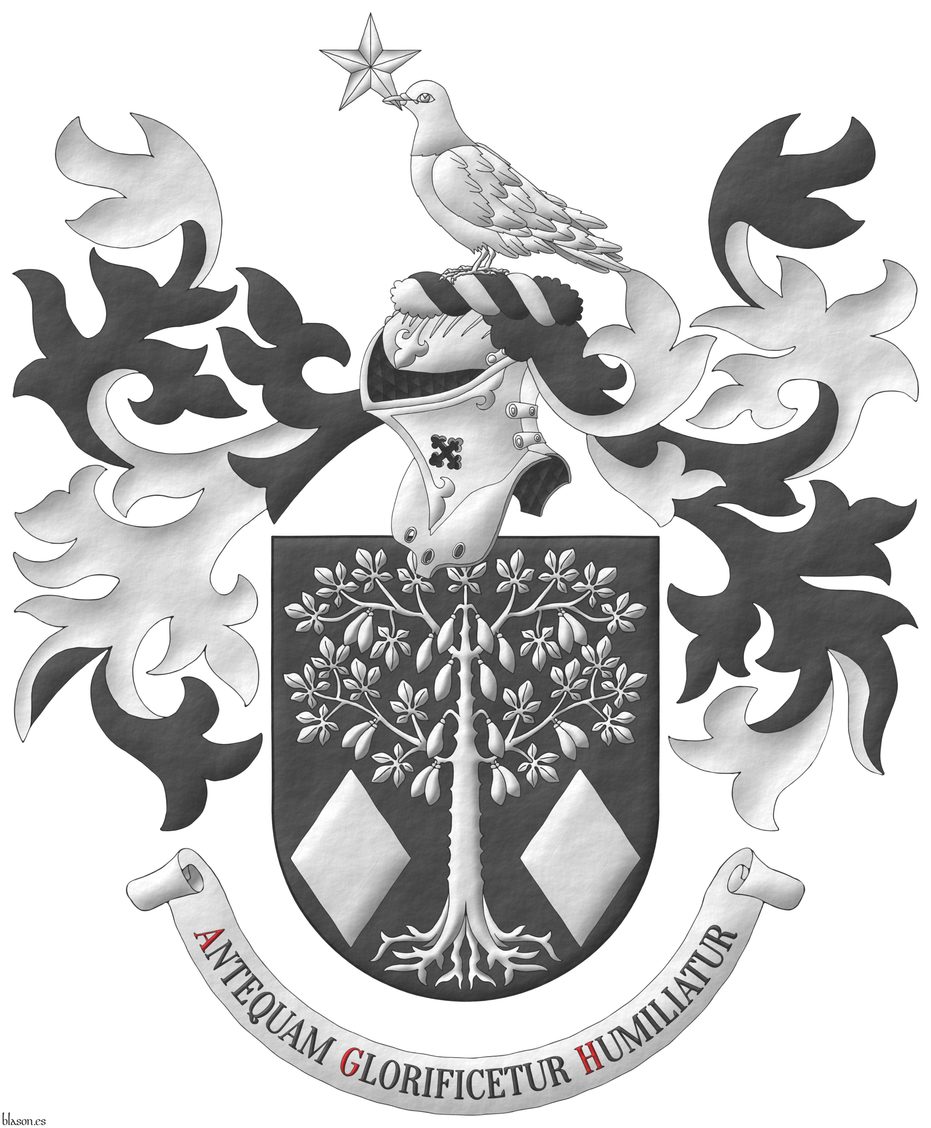
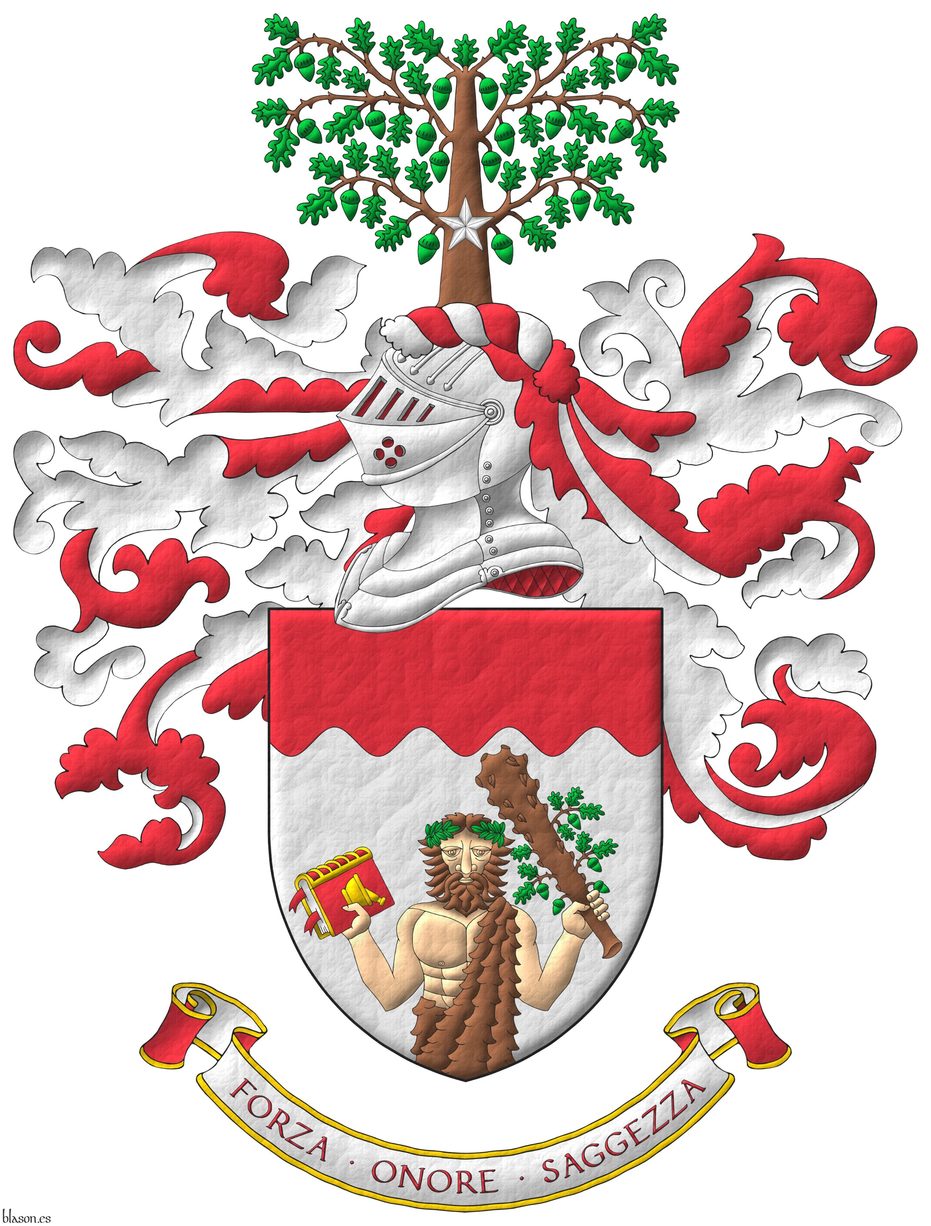
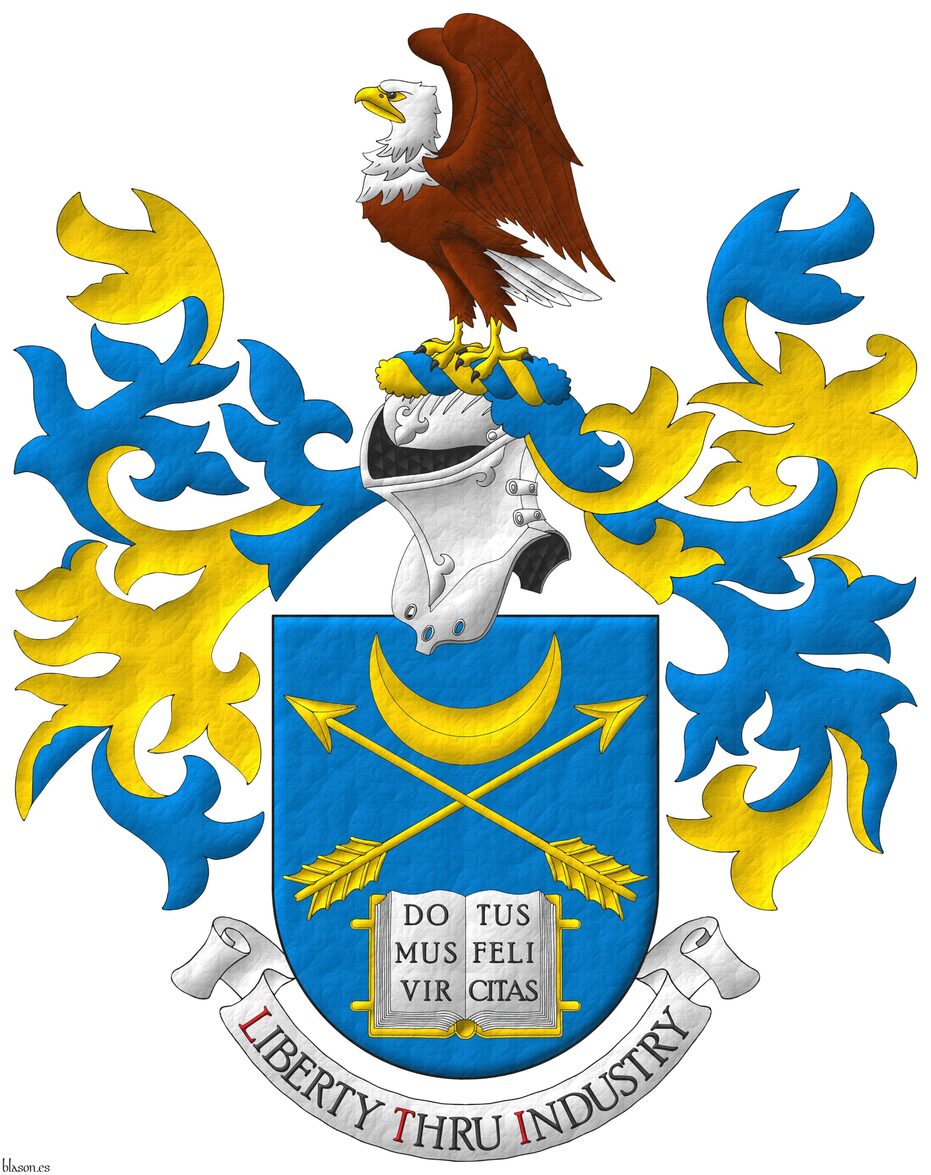
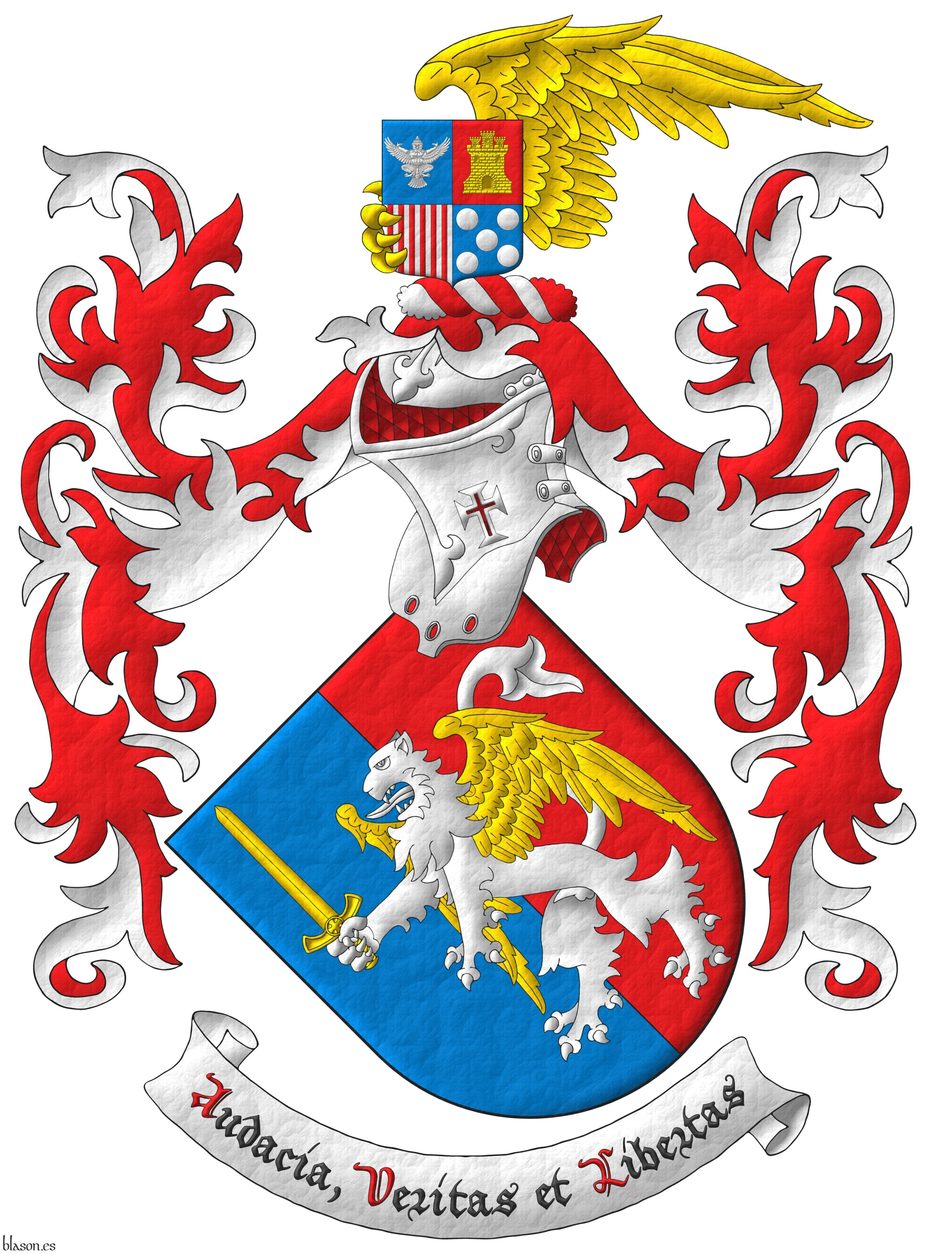
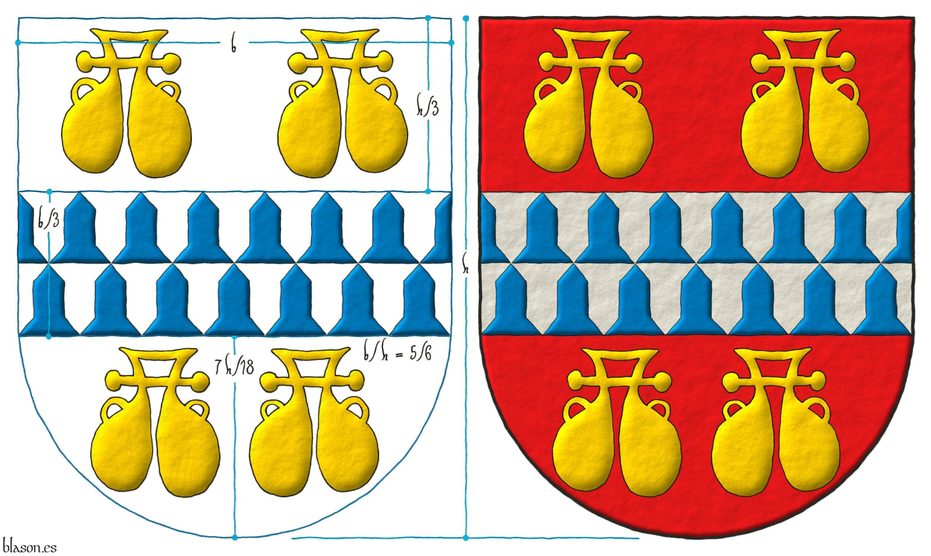
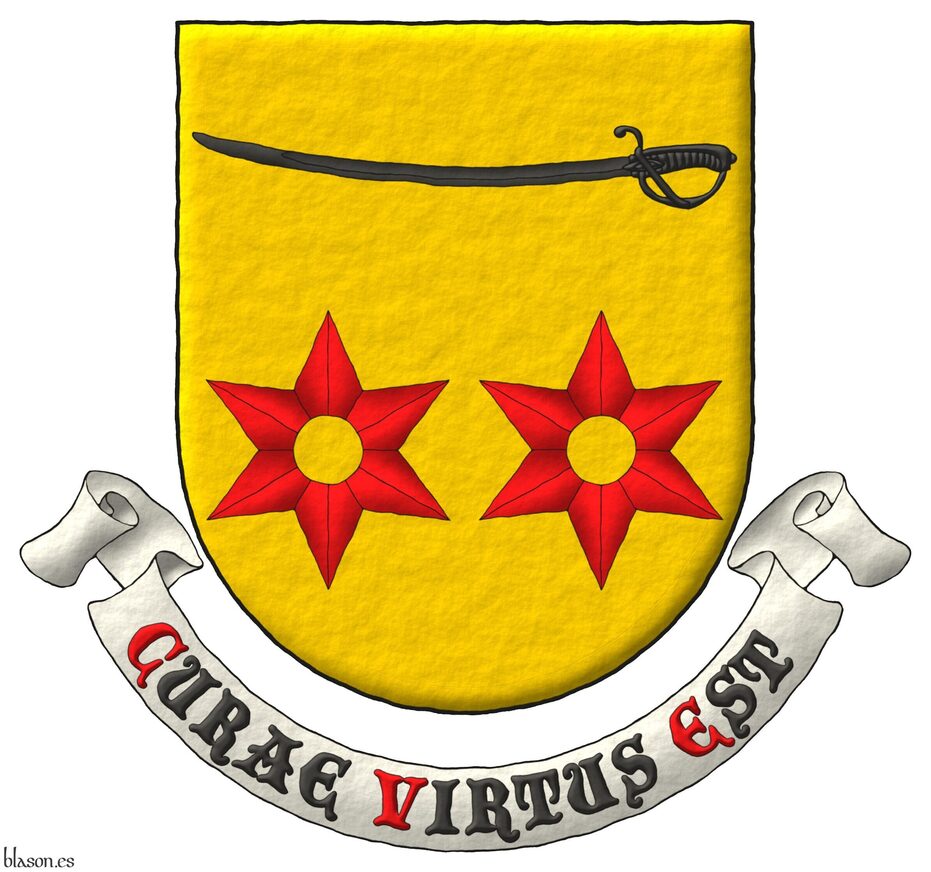
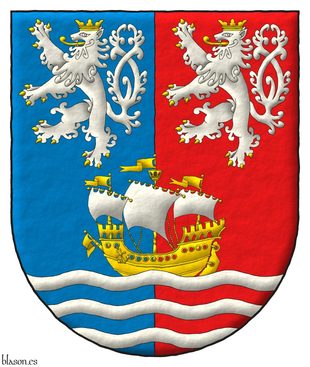
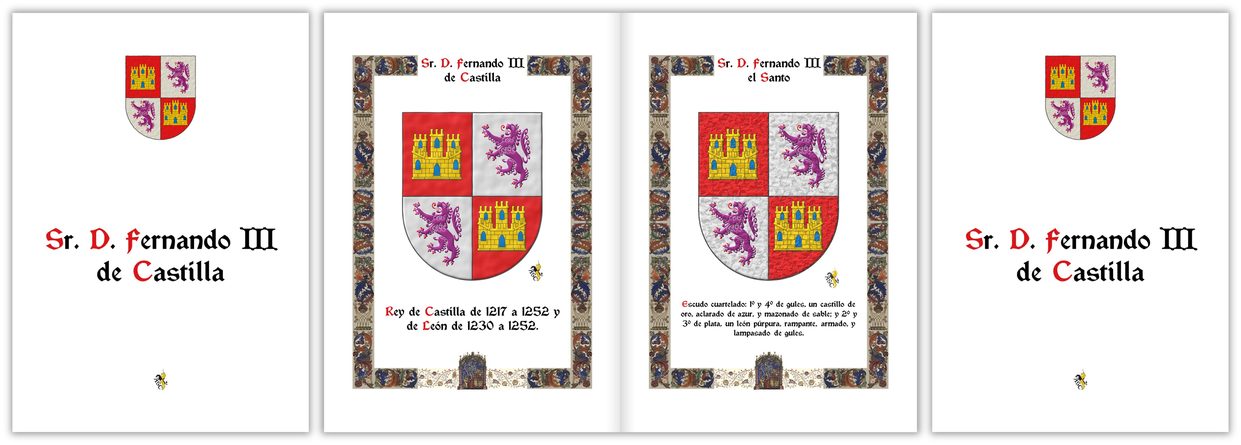
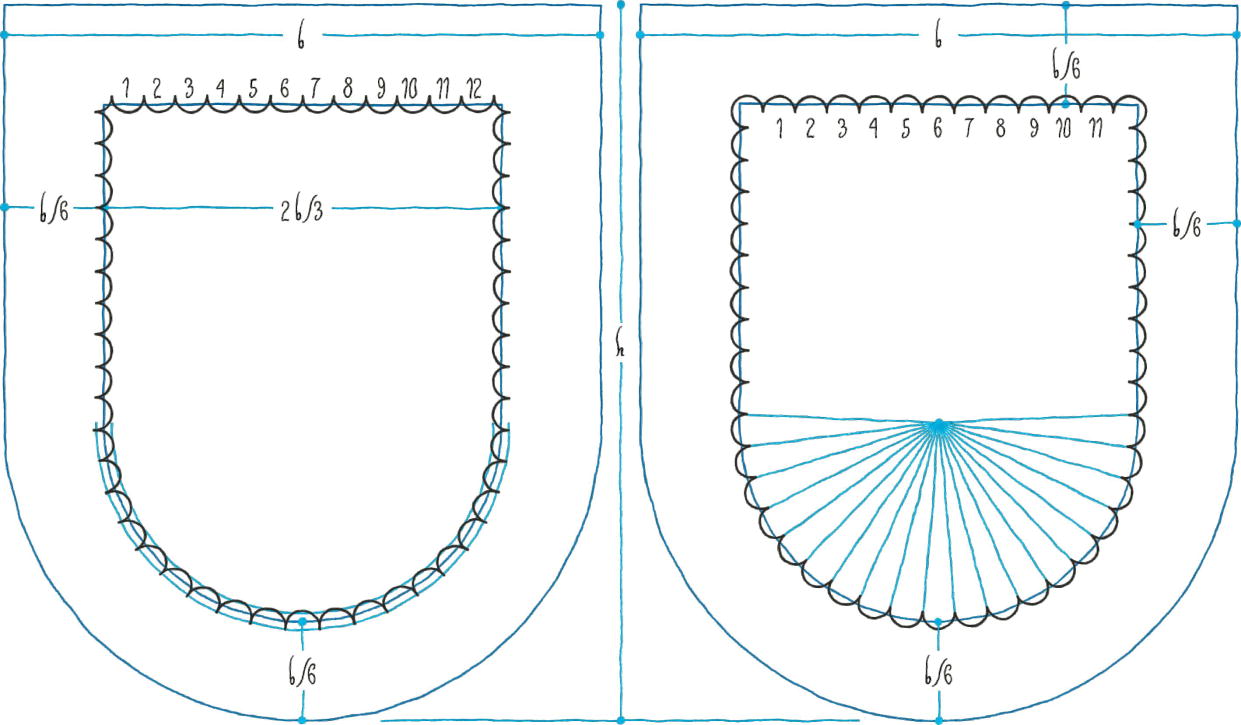

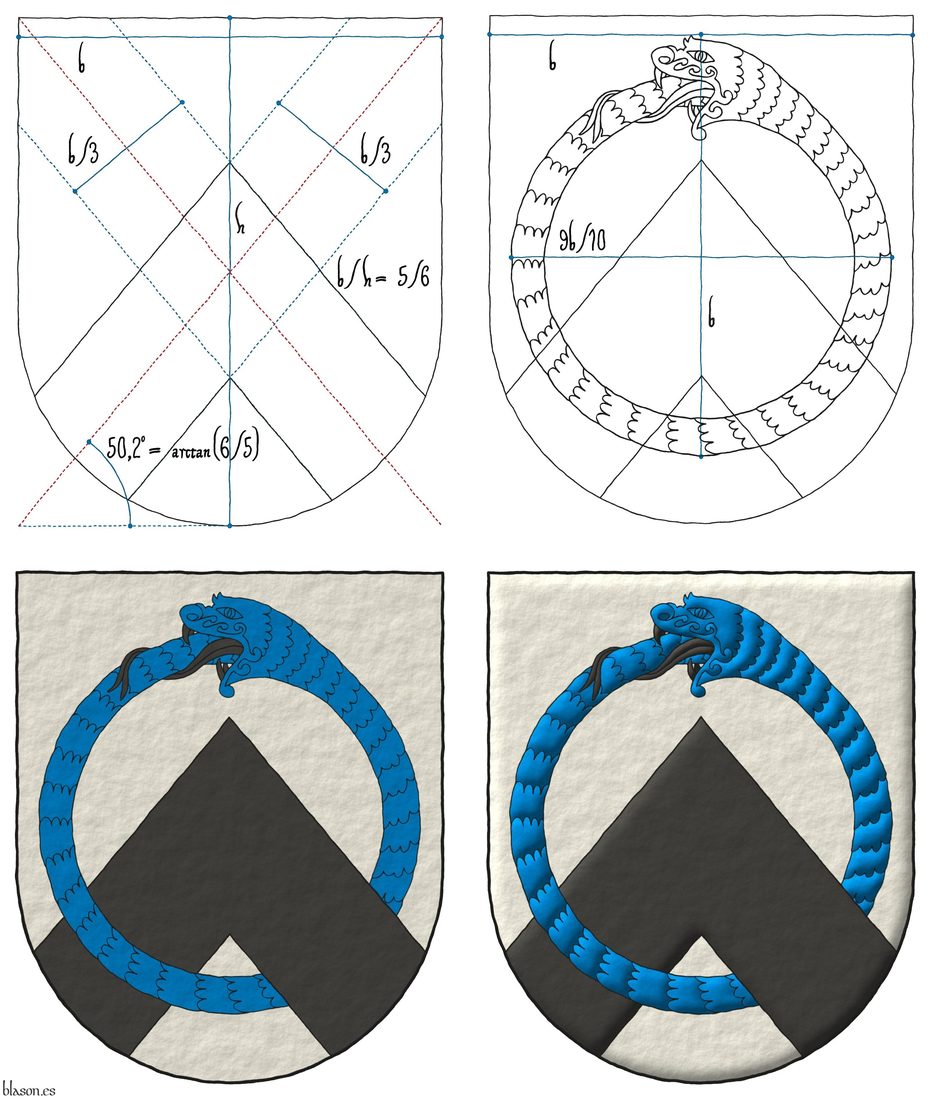
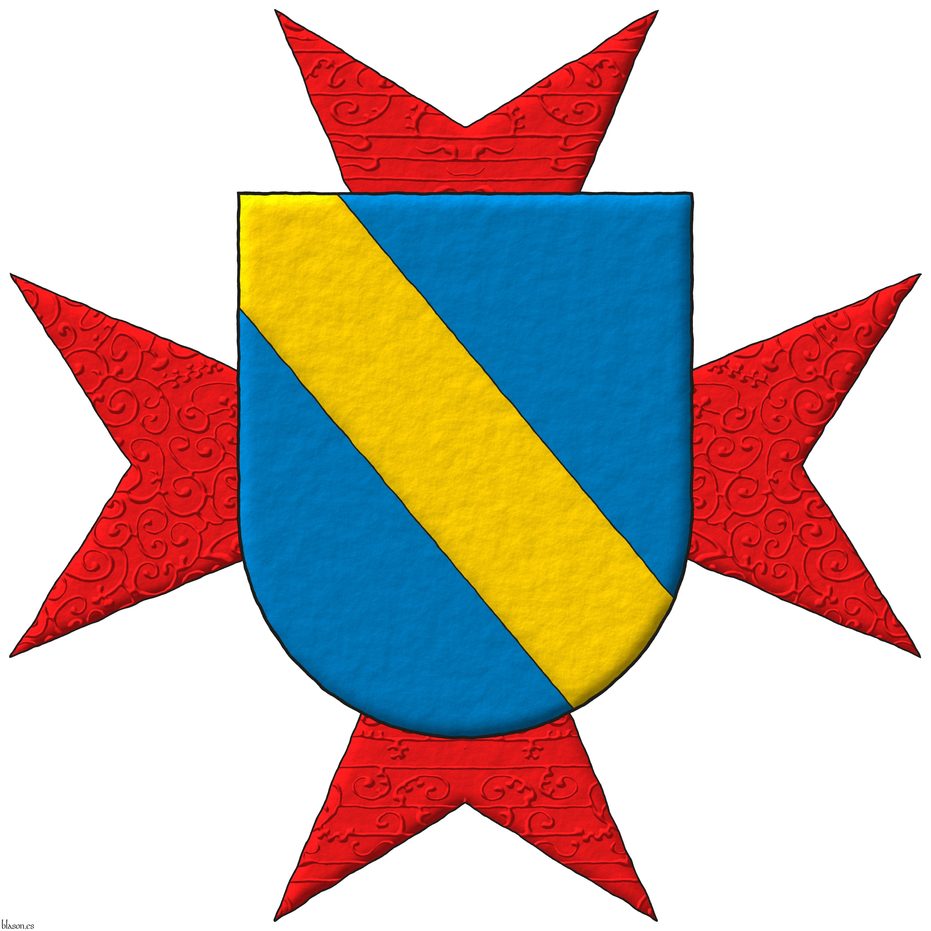
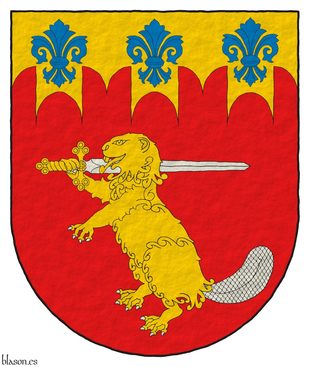
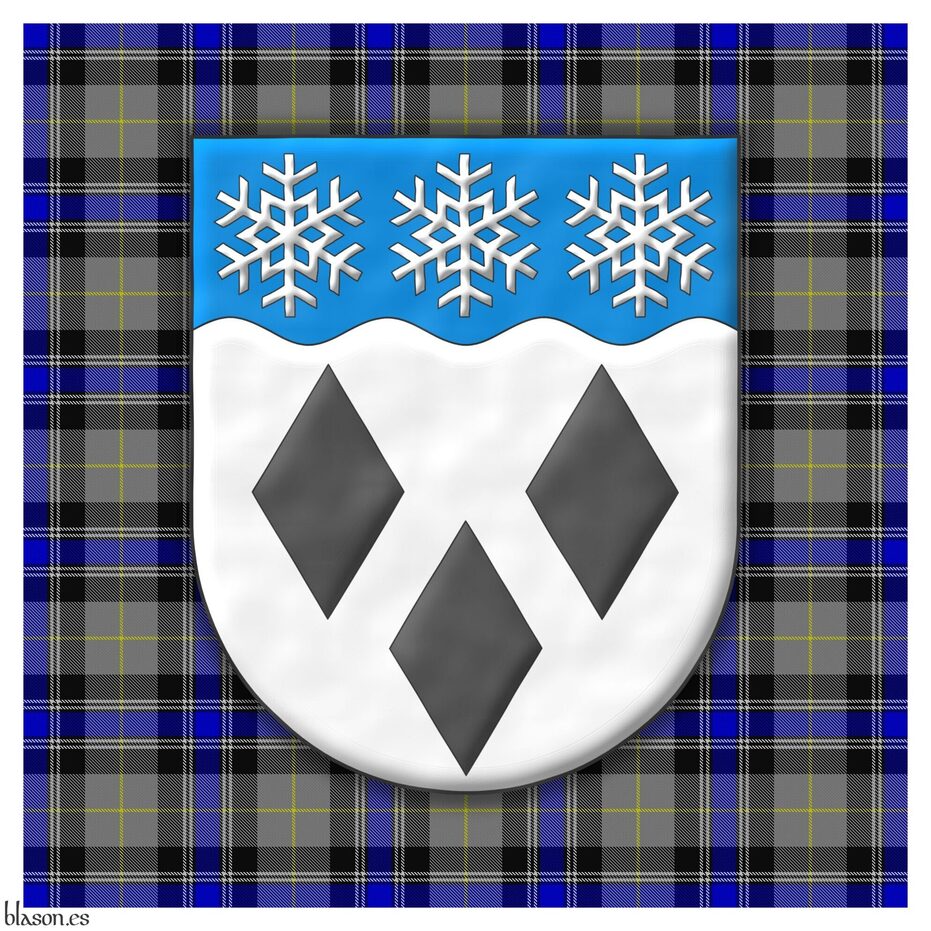
![Kingdom of Spain, schema 2x2 Quarterly: 1 Gules, a castle triple-towered Or, port and windows Azure, masoned Sable [for Castile]; 2 Argent, a lion rampant Purpure, armed and langued Gules, crowned Or [for Leon]; 3 Or, four pallets Gules [for Aragon]; 4 Gules, a chain orlewise, crosswise, and saltirewise Or, charged in the fess point with an emerald Vert [for Navarre]; enté en point Argent, a pomegranate proper, seeded Gules, slipped and leaved Vert [for Granada]; an inescutcheon Azure, three fleurs de lis Or, 2 and 1, a bordure Gules [for Bourbon].](../escudo_armas/EspanaR.20.Esquema.2x2.jpg)
![Lineage Mark of Germany, collage [ Or, a fess chequey Gules and Argent ] · [ Or, a fess chequey Azure and Argent ] · [ Gules, a fess chequey Azure and Argent ] · [ Gules, a fess chequey Azure and Argent ] · [ Azure, a fess chequey Gules and Argent ].](../escudo_armas/MarkAlemania.19.Collage.English.Irisado.Avr20.jpg)
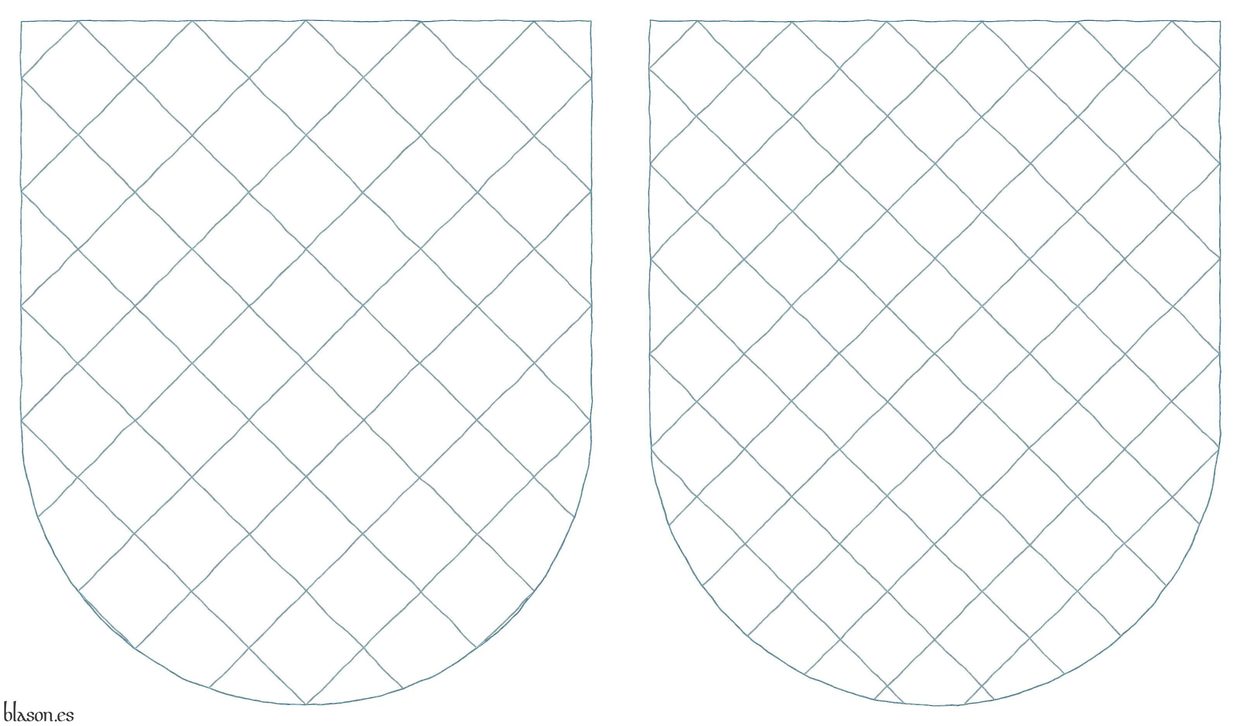
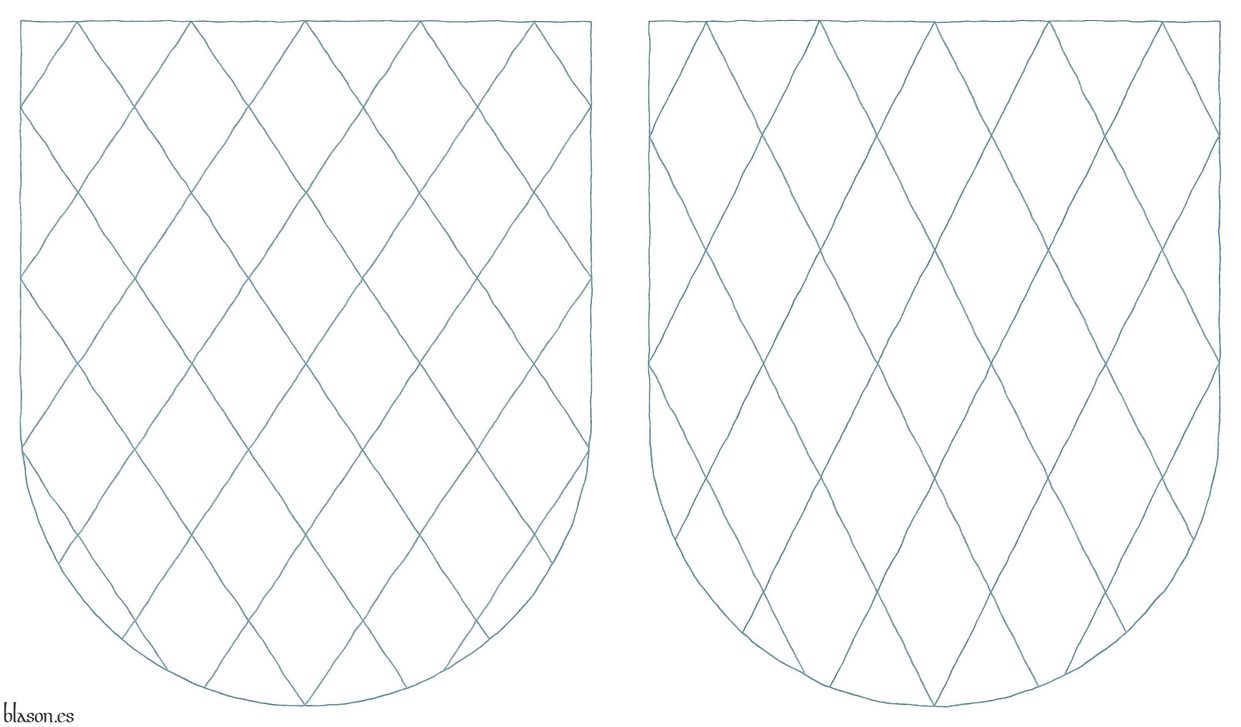
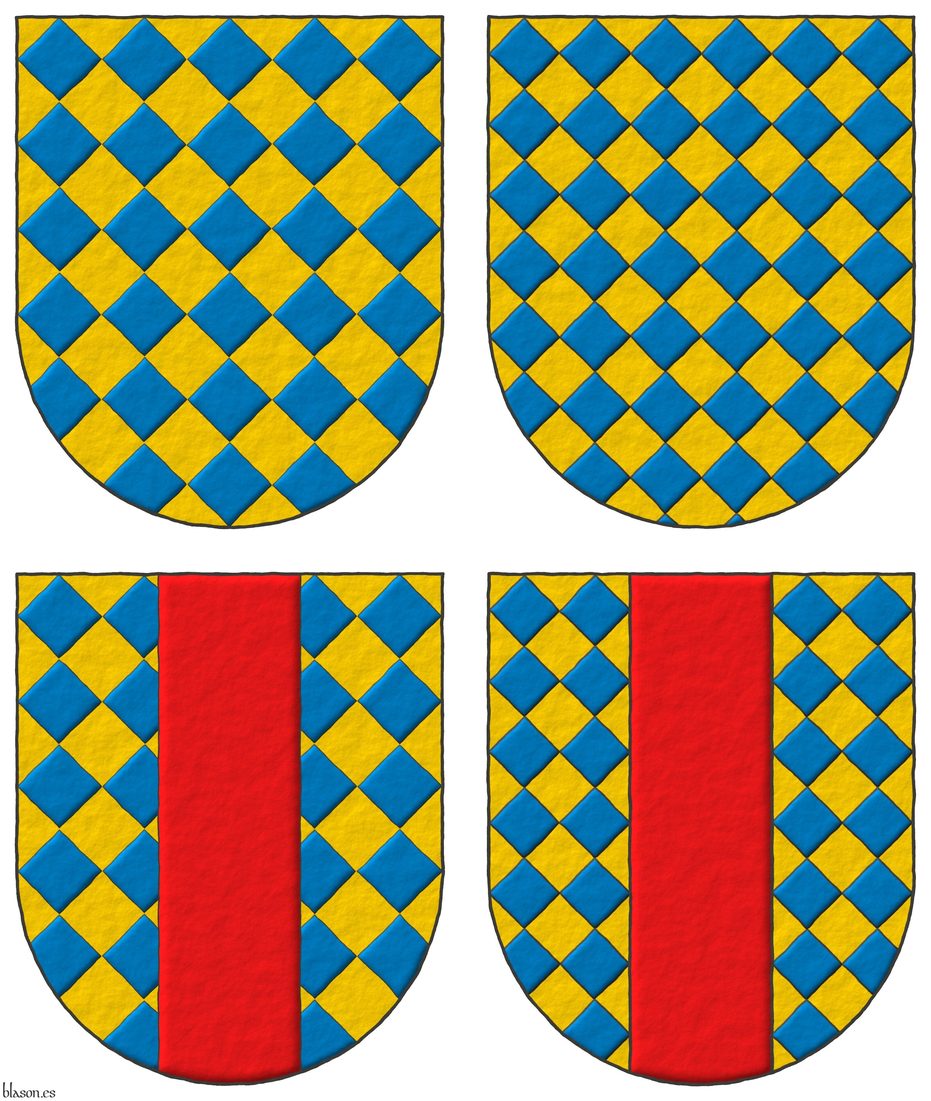
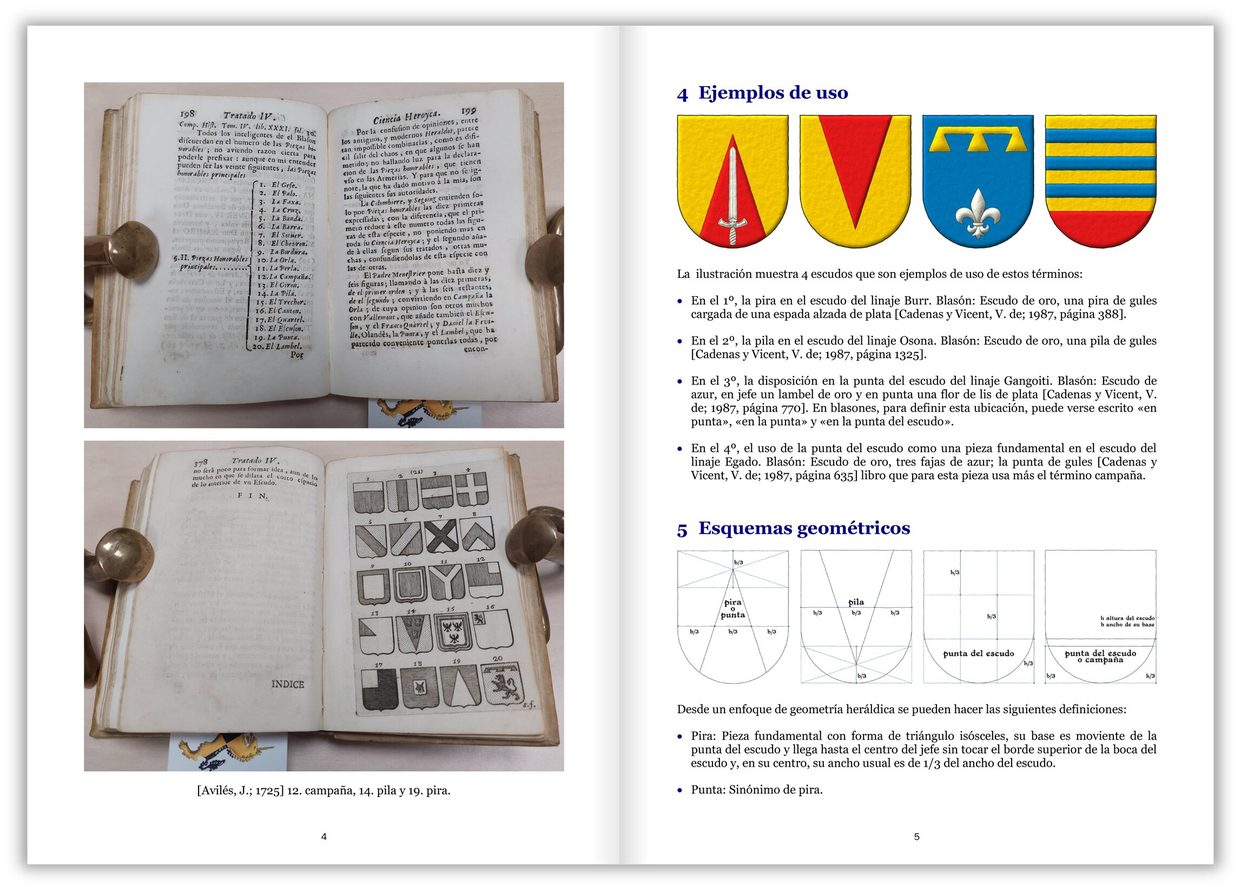



![Royal standard of Felipe VI of Spain Quarterly: 1 Gules, a castle triple-towered Or, port and windows Azure, masoned Sable [for Castile]; 2 Argent, a lion rampant Purpure, armed and langued Gules, crowned Or [for Leon]; 3 Or, four pallets Gules [for Aragon]; 4 Gules, a chain orlewise, crosswise, and saltirewise Or, charged in the fess point with an emerald Vert [for Navarre]; enté en point Argent, a pomegranate proper, seeded Gules, slipped and leaved Vert [for Granada]; an inescutcheon Azure, three fleurs de lis Or, 2 and 1, a bordure Gules [for Bourbon]. Crest: A closed royal crown. The shield is surrounded by the Golden Fleece. Behind the shield, a crimson square.](../escudo_armas/FelipeVI.34.Estandarte.N4a.800mm.jpg)
